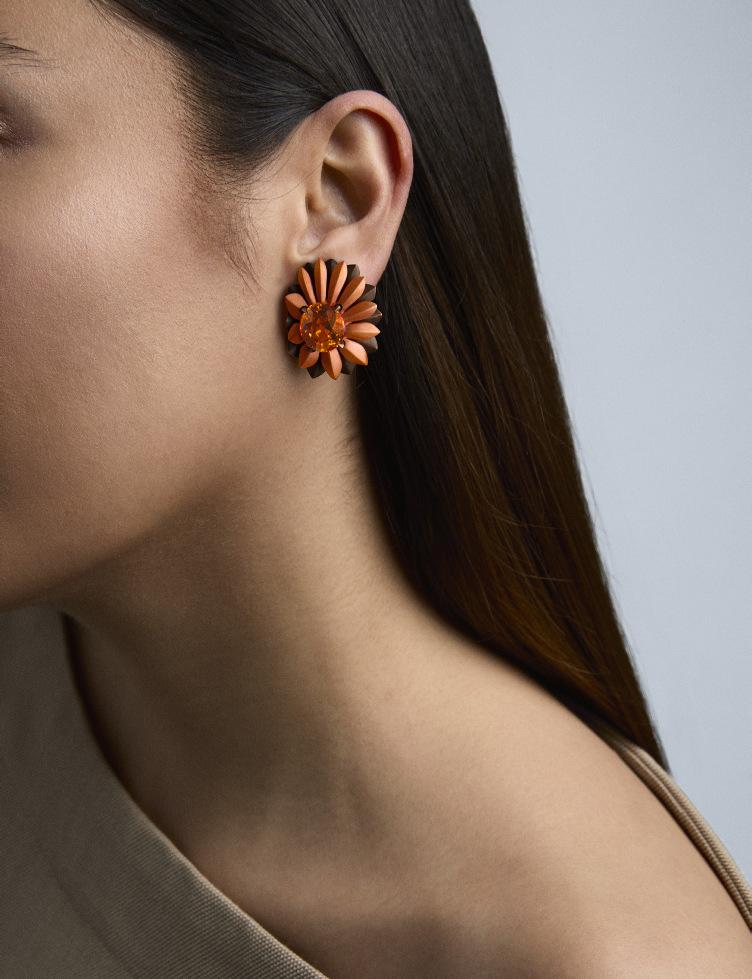

Magnificent Jewels
including The Collection of Lucille Coleman, Magnificent Mughal Jewels: Property from a Royal Collection, The Marie-Thérèse Pink Diamond, The Collection of Anne H. Bass and The Blue Belle Sapphire

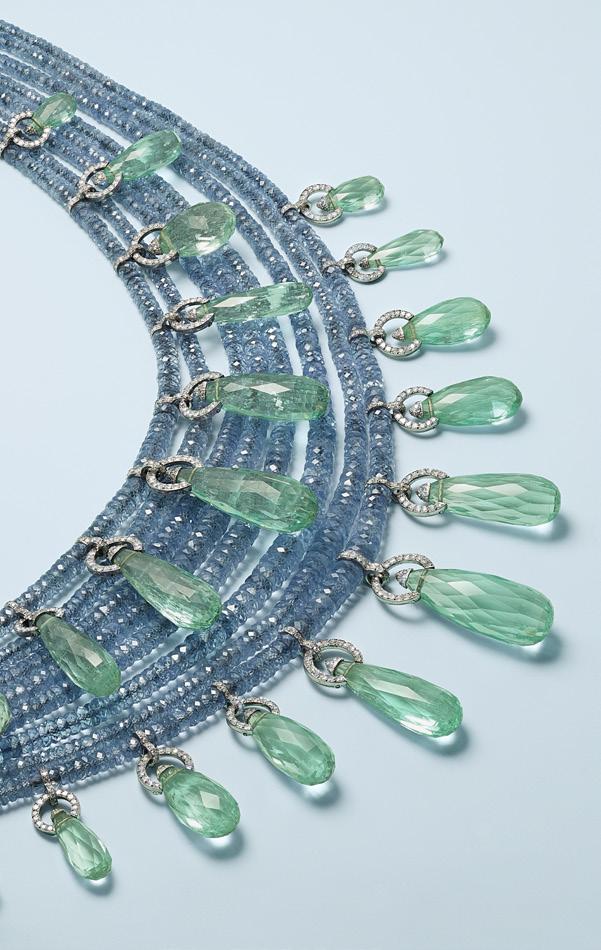

MAGNIFICENT JEWELS
The Collection of Lucille Coleman, Magnificent Mughal Jewels: Property from a Royal Collection, The Marie-Thérèse Pink Diamond, The Collection of Anne H. Bass and The Blue Belle Sapphire
AUCTION
Tuesday 17 June at 10.00am (Lots 1-140)
20 Rockefeller Plaza New York, NY 10020
EXHIBITION
Thursday 12 June 10.00am-5.00pm
Friday 13 June 10.00am-5.00pm
Saturday 14 June 10.00am-5.00pm
Sunday 15 June 10.00am-5.00pm
Monday 16 June 10.00am-5.00pm
AUCTIONEERS
François Curiel
Max Fawcett
Rahul Kadakia including
AUCTION CODE AND NUMBER
In sending absentee bids or making enquiries, this sale should be referred to as REGAL-23728
ABSENTEE AND TELEPHONE BIDS
Tel: +1 212 636 2437
AUTHENTICITY CERTIFICATES
As certain manufacturers may not issue certificates of authenticity, Christie’s has no obligation to furnish a buyer with a certificate of authenticity from the manufacturer, except where specifically noted in the catalogue. Unless Christie’s is satisfied that it should cancel the sale in accordance with the Limited Warranty provided in the Conditions of Sale, the failure of a manufacturer to issue a certificate will not constitute grounds for cancellation of the sale.
Please note that jewels are not necessarily illustrated at actual size, check dimensions carefully.
BUYER’S PREMIUM
In addition to the hammer price, the successful bidder agrees to pay us a buyer’s premium on the hammer price of each lot sold. On all lots we charge 26% of the hammer price up to and including US$1,000,000, 21.0% on that part of the hammer price over US$1,000,000 and up to and including US$6,000,000, and 15.0% of that part of the hammer price above US$6,000,000.
Throughout the catalogue, please note these abbreviations:
AGL: American Gemological Laboratories
GIA: Gemological Institute of America
SSEF: Swiss Gemological Institute
Please scan for complete auction information
WORLDWIDE JEWELLERY DEPARTMENT
INTERNATIONAL TEAM

FRANÇOIS CURIEL Chairman, Europe fcuriel@christies.com
+33 1 40 76 84 00

RAHUL KADAKIA International Head of Jewellery rkadakia@christies.com +1 212 636 2310

VICKIE SEK Chairman, Jewellery, Asia vsek@christies.com +852 2978 9922
EUROPE, MIDDLE EAST, RUSSIA AND INDIA

HENRY BAILEY Head of Department, London hbailey@christies.com
+44 20 7389 2382

EMILIE GRIMONPREZ Senior Cataloguer, Paris egrimonprez@christies.com
+331 40 76 7217

MÉLANIE MATTHES
Junior Specialist, Geneva mmatthes@christies.com +41 22 319 17 94

KAREN AU YEUNG
Senior International Specialist, Hong Kong kau-yeung@christies.com
+852 2978 9921

ANGELA BERDEN Senior Specialist, Geneva aberden@christies.com
+41 22 319 17 82

ALTHÉA HANSHAW Specialist, Geneva ahanshaw@christie.com
+41 22 319 1764

KEITH PENTON Specialist, London kpenton@christies.com +44 20 7752 3281

NICOLA CHAN
Junior Specialist, Hong Kong nchan@christies.com +852 2978 9928

JULIEN BRUNIE International Head, Private sales, Jewellery jbrunie@christies.com +33 1 40 76 83 82

LUKAS BIEHLER Senior Specialist, Geneva lbiehler@christies.com
+41 22 319 17 47

ARABELLA HISCOX Specialist, London ahiscox@christies.com
+44 20 7752 3208

FREDERIK SCHWARZ Consultant, Berlin fschwarz@ christiespartners.com +49 175 524 4379

RONNY HSU Head of Sale, Hong Kong rhsu@christies.com +852 2978 9979

MAX FAWCETT Head of Jewellery, EMEA mfawcett@christies.com +41 22 319 17 38

LEO CRIACO Head of Department, Milan lcriaco@christies.com
+39 02 303 28 335

VITTORIA LANZA Junior Specialist, Geneva vlanza@christies.com
+41 22 319 17 68

SOPHIE STEVENS Head of Department, Middle East sstevens@christies.com +44 20 7389 2455

DOMINIQUE LAU Junior Specialist, Hong Kong dlau@christies.com +852 2978 5375

VIOLAINE D’ASTORG Head of Department, Paris vdastorg@christies.com
+33 1 40 76 85 81

BAOMING LI Specialist, Paris baomingli@christies.com
+33 1 40 76 72 59

MICHAELA SUHL Associate Specialist, London msuhl@christies.com
+44 20 7389 2860

CAROLINE LIANG Senior Specialist, Shanghai cliang@christies.com +86 212 226 1520

BELINDA YUEN
Associate Specialist, Hong Kong byuen@christies.com +852 2978 6718
ASIA PACIFIC
SPECIALISTS AND SERVICES FOR THIS AUCTION
AMERICAS

JACQUELINE DISANTE
Head of Sale, New York jdisante@christies.com
+1 212 636 2313

JIMIN KIM
Junior Specialist, New York jiminkim@christies.com
+1 212 636 2307

ALEXANDER EBLEN
Senior Specialist, New York aeblen@christies.com
+1 212 636 2303

AMANDA MILLER
Junior Specialist, New York amiller@christies.com +1 212 636 2317
GLOBAL MANAGING DIRECTOR
Emmanuel Danan edanan@christies.com
Tel: +33 1 40768350
REGIONAL MANAGING DIRECTOR
Kimberly Miller
kimberlymiller@christies.com
Tel: +1 212 636 2306
BUSINESS MANAGER
Sharon Sun
ssun@christies.com
Tel: +1 212 636 2314

LAUREN FRIEDLANDER
Junior Specialist, New York lfriedlander@christies.com
+1 212 636 2318

CLAIBOURNE POINDEXTER
Senior Specialist, New York cpoindexter@christies.com +1 212 636 2316

LISA HUBBARD
Senior Advisor, Los Angeles lhubbard@christiespartners.com +1 310 385 2624

KELSEY KALAW
Associate Specialist, New York kkalaw@christies.com
+1 212 636 2319

WALPER Specialist, Los Angeles ewalper@christies.com +1 310 385 2665
SALE COORDINATORS
Caroline Curtis ccurtis@christies.com
Tel: +1 212 636 2315
Molly Morris
mollymorris@christies.com
Tel: +1 212 636 2311
Diana Situ
dsitu@christies.com
Tel: +1 212 636 2304
ABSENTEE & TELEPHONE BIDS
Tel: +1 212 636 2437
bidsUS@christies.com
SHIPPING
Matthew Sherbine
MSherbine@christies.com
Tel: +1 212 636 2312
Fax: +1 212 636 2301
POST-SALE SERVICES
Rebecca Herr
Tel: +1 212 636 2179
Post-Sale Coordinator
Pam Perlowitz
Tel: +1 212 636 2385
Post-Sale Coordinator
Payment, Shipping and Collection
Tel: +1 212 636 2650
Fax: +1 212 636 4939
Email: PostSaleUS@christies.com
ELEANOR

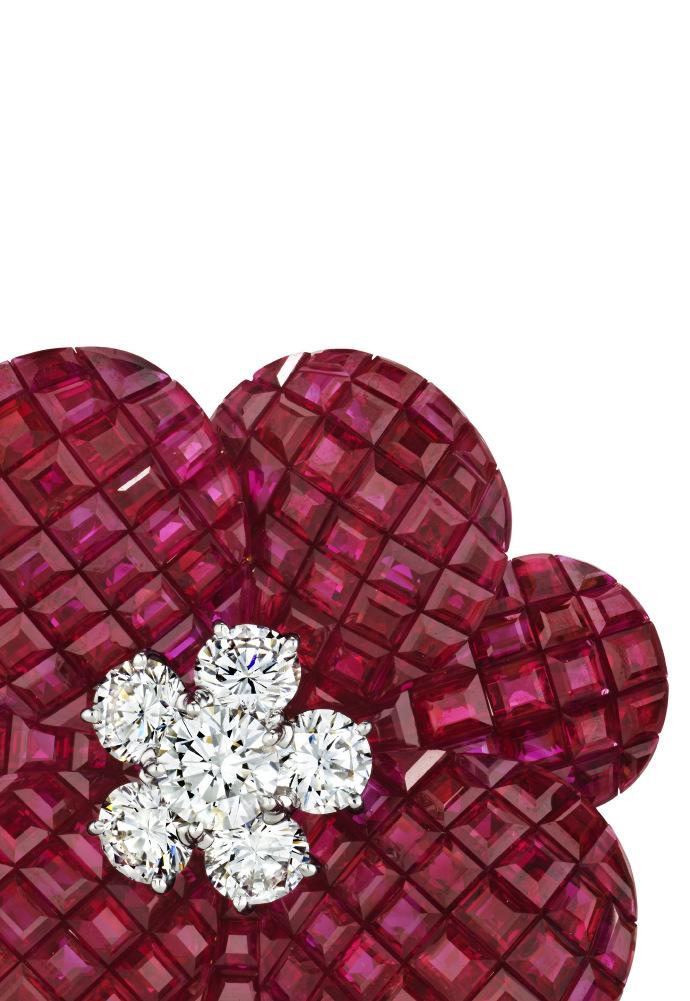

Lucille Coleman, celebrating her 40th wedding anniversary with her husband Milton (not pictured), wearing Lots 27 and 28 in 2003 at La Côte Basque
Courtesy of Fred Marcus Studio
A woman of glamour and generosity, Lucille Coleman was a true icon of elegance.
A revered New York philanthropist, Lucille was warmly regarded by all who knew her as profoundly generous and kind spirited. Alongside her husband of 45 years, Lucille championed the causes and communities most important to her.
Born in Poland in 1930, Lucille developed resilience at an early age. As Hitler’s power expanded across Europe, Lucille’s mother, Rose Gordon, urged the family to leave Warsaw and seek refuge from the Nazi regime. Leaving behind status and financial stability, the family was forced to begin again. New York City provided Lucille’s family the new start they needed and proved to be the place where her father, Samson Gordon, would amass a fortune in the real estate industry. Lucille’s set of ethics, grounded in hard work and community, instilled in her by her parents, would inspire a life dedicated to giving back to the city that shaped her.
Lucille’s beloved husband, Milton Coleman, grew up across town in Harlem. The couple’s love began in true New York fashion—meeting by chance while out to lunch with friends at the iconic Hotel des Artistes.
Her husband recalled fondly his infatuation from “the moment when I first laid eyes on her.” Over their many decades together, the couple traveled widely across Asia and Europe. They were described by those who knew them as deeply in love and happiest in each other’s company. Alongside her husband, Lucille cared deeply about the causes she supported.
New York Presbyterian benefited greatly from the Colemans' generosity. “The primary reason we donated to the Hospital is because we love our doctors there. But also, it makes us feel good to give,” the couple said.
The Lucille and Milton Coleman Tower, a residential complex with over 20 floors, was named in their honor and continues to house hospital physicians and staff. The Colemans were also highly involved with their synagogue and several Jewish causes. Their late rabbi referred to them as “a quiet, gentle, and unassuming couple… dedicated to the greatest values of communal responsibility and institutional loyalty.”
In addition to philanthropy, Lucille built an impressive collection of jewelry. She had an eye for quality, as demonstrated through each piece carefully selected for her exquisite jewelry collection. Comprised primarily of jewels by Van Cleef & Arpels, Lucille’s carefully collected assemblage of jewels is nothing short of exceptional. With a particular emphasis on iconic designs by the renowned French house, including one of the most important groupings of ‘Mystery-Set’ jewels ever offered for auction, the magnificent jewels of Lucille Coleman present an opportunity for collectors to acquire pieces from a true arbiter of style and grace.
In addition to her jewelry collection, Lucille had a sense of sophistication and classicism when collecting art, furniture and sculptures.
Of the Colemans' collection of fine art, Christie’s is pleased to feature a whimsical sculpture by the beloved Colombian artist, Fernando Botero, in our much-anticipated fall sale of Post-War and Contemporary art—a true testament to Lucille’s keen eye for quality across all categories. Works from The Estate of Lucille Coleman will be presented at DOYLE in New York through a series of sales to showcase her collection’s range. Highlights will be offered in a dedicated single-owner auction, with additional works featured in category-specific sales—including Important Paintings and Asian Works of Art. The auctions will begin in September 2025 and continue through December.
As an enduring tribute to how Lucille Coleman lived her life, the proceeds from her estate are offered with the intent to benefit charitable causes in New York, continuing her legacy and philanthropic spirit in the city she loved most.

A Tribute to Mrs. Coleman
“Classic taste with a twist” is how Lucille Coleman always used to describe herself.
Iconic Van Cleef & Arpels Mystery Set pieces are a must for every important jewelry collection, but rarely are they exclusively collected like in this wonderful ensemble. Mrs. Coleman never enjoyed wearing bracelets or necklaces except for her signature Van Cleef & Arpels Alhambra long sautoir which she had in every color and material. She did not want jewelry to overpower her but considered the use of it just to finish a look, and mystery set pieces precisely fulfilled this purpose.
Amongst the many pieces I helped her acquire was a very charming flag brooch from 1955 which was one of the last pieces she purchased. The piece is in sapphire with an M in ruby for “Milton,” the name of her beloved husband. The brooch was originally a special order, with the M representing the name of the owner’s yacht. I was always very careful with the pieces I selected for her as I knew her taste so well. I was sure she would love this small flag as it was an exquisite piece – and I was right.
I met Mrs. Coleman just before the Sybil Harrington sale in 1999 when I was working at Christie’s in New York. I had seen the Harrington jewels in our office, but they were still in Christie’s safe, and the sale not yet announced. Upon our first meeting, Mrs. Coleman described her taste, and I knew immediately that she would enjoy several pieces from the Harrington collection. I ran to the safe and selected some brooches and ear clips for her to try. She loved them and told me she wanted them. When Mrs. Coleman wanted something, the price was never a limitation; and when I was phone bidding with her I just kept my hand up (which ultimately became a joke in the auction room). Even when she won the pieces she wanted, she worried that she was not the successful bidder and asked me to keep bidding! My interactions with her over the Sybil Harrington jewels initiated a great friendship, which continued for over 20 years as I helped her build this collection.
Mrs. Coleman witnessed the history of the 20th century. She was born in Poland to a wealthy family who lost everything during the German invasion. Her father, always very optimistic, did not want to leave, and it was her mother who pushed the family to settle in the United States after an epic journey through Russia and Japan. Very quickly her father rebuilt the family fortune in real estate in New York. They moved to Park Avenue and started vacationing at the Carlton in Cannes, where she faithfully stayed until near the end of her life. She was one of their oldest clients and was always welcomed like a queen. She loved her parents, and when she got married she settled on Park Avenue as well, just two blocks south of them. It was her mother who introduced her to Van Cleef & Arpels; after which Mrs. Coleman started making her first purchases – from the New York store as well as Palm Beach where she once owned an apartment.
Mrs. Coleman was a true New Yorker who made me love the city. She knew every corner and preferred walking everywhere. She could take you for dinner at a very fancy restaurant one week and to a diner on the Lower East Side the next. I never knew what to expect. She was always surrounded by a group of faithful lifelong friends with whom she celebrated holidays and vacationed.
This collection is a tribute to Mrs. Coleman, her life and her taste. As sad as it can be to see it dispersed, most pieces came from other prestigious collections and will now move on to their next phase of life as witness of the inalienable style and quality of Van Cleef & Arpels jewelry.
Nicolas Luchsinger CEO Buccellati






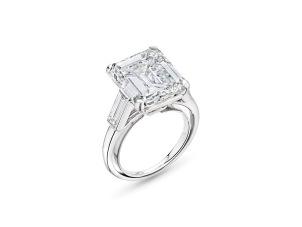
DIAMOND RING
Emerald-cut diamond of 6.71 carats, baguette-cut diamonds, platinum
GIA, 2025, report no. 6237580246: 6.71 carats, H color, VS1 clarity
Size/Dimensions: measures as US ring size 5æ, however, due to sizer fits as US ring size 4Ω
Gross Weight: 6.6 grams
$60,000-80,000
(two views)
LEARN MORE
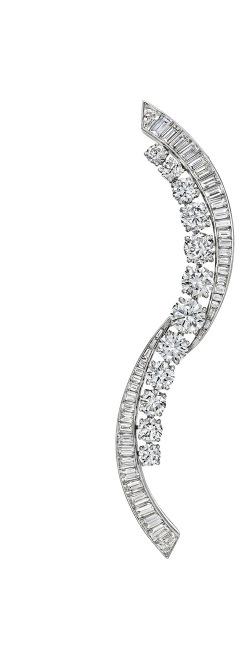
VAN CLEEF & ARPELS PAIR OF DIAMOND 'FLAME' BROOCHES
Round, baguette and tapered baguette-cut diamonds, platinum and 18k white gold (French marks), circa 1950, signed Van Cleef & Arpels, numbered
Size/Dimensions: each 7.9 x 1.9 cm (3¿ x æ in)
Gross Weight: 26.6 grams
$30,000-50,000
LITERATURE:
Cf. É. Possémé, Van Cleef & Arpels: When Elegance Meets Art, Paris, Les Arts Décoratifs, 2018, p. 89
Cf. É. Possémé, Van Cleef & Arpels: The Art of High Jewelry, Paris, Les Arts Décoratifs, 2012, p. 89
Cf. S. Coffin, Set in Style: The Jewelry of Van Cleef & Arpels, New York, Cooper-Hewitt, National Design Museum, 2011, p. 265
Cf. M. Petit, Van Cleef & Arpels: Reflections of Eternity, Paris, Éditions Cercle D'Art, 2006, p. 124 - 125
Cf. L. Couvreur-Schiffer, F. Falleul, M. Lary, Van Cleef & Arpels, Paris, Palais Galliéra, Diffusion Paris-Musées, 1992, p. 154, pl. 241

First released in 1934, Van Cleef & Arpels’ ‘Flamme’ (‘Flame’) brooch is an often referenced early example of the house’s now signature transformable jewelry. Motivated by the economic conditions of the time, designers utilized modernism’s simplified forms to develop jewels that would suit a variety of wear. Frequently worn as a pair, the ‘Flame’ brooches’ addition would elevate clothing, hats, hair and, after later style evolutions, necklaces.
Perhaps the best example of the ‘Flame’ brooches’ transformable nature can be found in the styles of Jacqueline Kennedy. The First Lady wore her brooches repeatedly, either adorning her multi-strand pearl necklace, pinned to jacket lapels or dresses, and, most famously, accenting her coiffure during a dinner given by President and Madame de Gaulle at Versailles on June 1, 1961.
The popularity of the flame motif continued throughout the 20th century with multiple variations produced, some released under the model name ‘Haricot’. A success in modern design principles, it is the sleek line, monochrome color composition and interesting textural contrast between the round and baguette diamonds that ensure these brooches’ lasting presence in style.





LEARN MORE






VAN CLEEF & ARPELS DIAMOND AND GOLD EVENING BAG
Designed as an evening bag with a fitted mirror, round, old and single-cut diamonds, 18k yellow gold (French mark) and platinum, circa 1955, signed Van Cleef & Arpels, maker’s mark, numbered
Size/Dimensions: bag 17.1 x 9.5 x 5.0 cm (6æ x 3æ x 2 in); chain overall length 112.3 cm (44º in); drop length 54.6 cm (21Ω in)
Gross Weight: 498.2 grams
$30,000-50,000
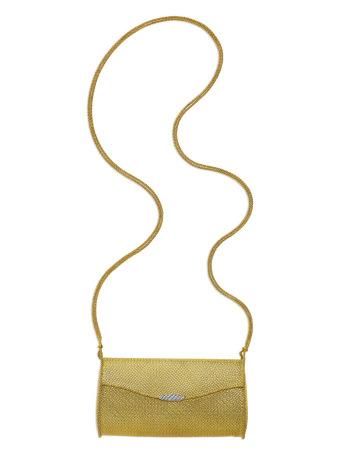
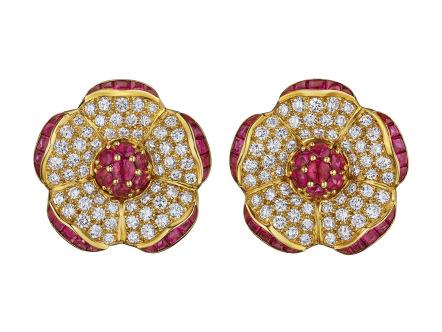
4
LEARN MORE
VAN CLEEF & ARPELS RUBY AND DIAMOND FLOWER EARRINGS
Designed as flowers, round cabochon and buff-top rubies, round diamonds, 18k yellow gold (French mark), signed VCA, maker's mark (Société Hamard Vitau (Abysse))
Size/Dimensions: 2.9 x 2.9 cm (1¿ x 1¿ in)
Gross Weight: 32.2 grams
$20,000-30,000
LITERATURE:
Christie's, New York, 19 October 1999, Sale 9206, Lot 664











VAN CLEEF & ARPELS RUBY AND DIAMOND CLIP-BROOCH
Oval ruby cabochons, round diamonds, 18k yellow gold (French marks), circa 1950, signed Van Cleef & Arpels, numbered
Size/Dimensions: 5.7 x 5.4 cm (2º x 2¿ in)
Gross Weight: 41.1 grams
$20,000-30,000


VAN CLEEF & ARPELS CULTURED PEARL, DIAMOND AND COLORED DIAMOND EARRINGS
Button-shaped cultured pearls measuring approximately 14.75 – 14.65 mm, round diamonds and yellow diamonds, yellow gold, signed VCA NY, numbered
Size/Dimensions: 2.5 cm (1 in)
Gross Weight: 34.1 grams
$20,000-30,000
PROVENANCE:
Christie’s, New York, 19 October 2005, Sale 1564, Lot 120
Please note that the yellow diamonds have not been tested for natural color.
VAN CLEEF & ARPELS DIAMOND ‘SIRIUS’ BROOCH
Round diamonds, 18k yellow gold (French mark), signed Van Cleef & Arpels, maker’s marks (Successeurs d’Ehret), numbered
Size/Dimensions: 4.7 x 4.4 cm (1√ x 1æ in)
Gross Weight: 28.5 grams
$20,000-30,000
PROVENANCE:
Christie’s, Geneva, 19 November 2003, Sale 1312, Lot 192











VAN CLEEF & ARPELS DIAMOND AND COLORED DIAMOND EARRINGS
Round diamonds and yellow diamonds, 18k white gold (French marks), signed VCA NY, numbered
Size/Dimensions: 2.8 x 2.5 cm (1¿ x 1 in)
Gross Weight: 18.7 grams
$20,000-30,000
PROVENANCE: Christie's, New York, 13 and 14 June 2002, Sale 1087, Lot 353
Please note that the yellow diamonds have not been tested for natural color.
LEARN MORE

VAN CLEEF & ARPELS COLORED DIAMOND, ONYX AND EMERALD 'LEOPARD' BROOCH
Round yellow diamonds, carved, onyx plaques, round emeralds, 18k yellow gold (French mark), signed Van Cleef & Arpels, maker’s mark (Péry & Fils), numbered
Size/Dimensions: 7.6 x 4.4 cm (3 x 1æ in)
Gross Weight: 32.3 grams
$30,000-50,000
Please note that the yellow diamonds have not been tested for natural color.






Lucille Coleman wearing Lot 9






10
VAN CLEEF & ARPELS EMERALD AND DIAMOND FLOWER EARRINGS
Oval-shaped emeralds, round diamonds, 18k yellow gold (French marks), signed V.C.A, maker's mark, numbered
Size/Dimensions: 2.8 cm (1¿ in)
Gross Weight: 23.7 grams
$40,000-60,000

11
VAN CLEEF & ARPELS EMERALD AND DIAMOND FLOWER BROOCH
Round and old-cut diamonds, pear-shaped emeralds, 18k yellow gold (French mark), signed Van Cleef et Arpels, maker's mark, numbered
Size/Dimensions: 4.7 x 5.7 cm (1√ x 2º in)
Gross Weight: 28.1 grams
$60,000-80,000
PROVENANCE: Christie's, New York, 19 October 1999, Sale 9206, Lot 666

Lucille Coleman wearing Lots 10 and 11 in 1999 at her friend’s 100th birthday celebration
LEARN MORE
LEARN MORE

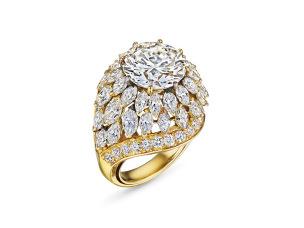
(two views)
DIAMOND RING MOUNTED BY VAN CLEEF & ARPELS
Round brilliant-cut of 5.10 carats, marquise and round diamonds, 18k yellow gold (French mark), signed Monture V.C.A., maker's mark (Successeurs d’Ehret), numbered
GIA, 2025, report no. 1232585118: 5.10 carats, K color, VVS2 clarity
Size/Dimensions: measures as US ring size 6, however, due to sizer fits as US ring size 5
Gross Weight: 14.4 grams
$20,000-30,000











VAN CLEEF & ARPELS TURQUOISE, SAPPHIRE AND DIAMOND BRACELET
Oval turquoise and sapphire cabochons, round diamonds, 18k yellow gold (French marks), circa 1965, signed Van Cleef & Arpels, numbered
Size/Dimensions: 19.1 x 1.9 cm (7Ω x æ in)
Gross Weight: 74.1 grams
$60,000-80,000





VAN CLEEF & ARPELS TURQUOISE, SAPPHIRE AND DIAMOND BROOCH
Round and oval turquoise cabochons, round sapphires and diamonds, 18k yellow gold (French mark), white gold, circa 1965, signed Van Cleef & Arpels, numbered
Size/Dimensions: 4.4 cm (1æ in)
Gross Weight: 34.0 grams
$30,000-50,000 15
VAN CLEEF & ARPELS TURQUOISE AND DIAMOND EARRINGS
Oval turquoise cabochons, round diamonds, 18k yellow gold (French marks), circa 1965, signed Van Cleef & Arpels, maker's mark, numbered
Size/Dimensions: 3.0 x 2.2 cm (1¿ x √ in)
Gross Weight: 20.0 grams
$15,000-20,000









16
VAN CLEEF & ARPELS RUBY AND DIAMOND 'CAMELLIA' BROOCH
Oval-shaped rubies, round diamonds, platinum, signed Van Cleef & Arpels, N.Y., numbered
Size/Dimensions: 5.7 x 5.4 cm (2º x 2¿ in)
Gross Weight: 41.1 grams
$100,000-150,000
PROVENANCE:
Christie's, New York, 10 April 2001, Sale 9738, Lot 71
LITERATURE:
Cf. D. Bennett and D. Mascetti, Understanding Jewellery, Suffolk, Antique Collectors' Club Ltd., 1989, p. 431
Cf. N. Foulkes, Van Cleef and Arpels: Alhambra, Paris, Éditions Xavier Barral, 2018, p. 65
17
VAN CLEEF & ARPELS RUBY AND DIAMOND 'CAMELLIA' EARRINGS
Oval-shaped and round rubies, round diamonds, platinum, signed Van Cleef & Arpels, N.Y., numbered
Size/Dimensions: 3.5 x 3.2 cm (1¡ x 1º in)
Gross Weight: 27.2 grams
$60,000-80,000
PROVENANCE:
Christie's, New York, 10 April 2001, Sale 9738, Lot 72
LITERATURE:
Cf. S. Coffin, Set in Style: The Jewelry of Van Cleef & Arpels, New York, Cooper-Hewitt, National Design Museum, 2011, p. 108

Lucille Coleman wearing Lots 16 and 17 Courtesy of Fred Marcus Studio
LEARN MORE
LEARN MORE
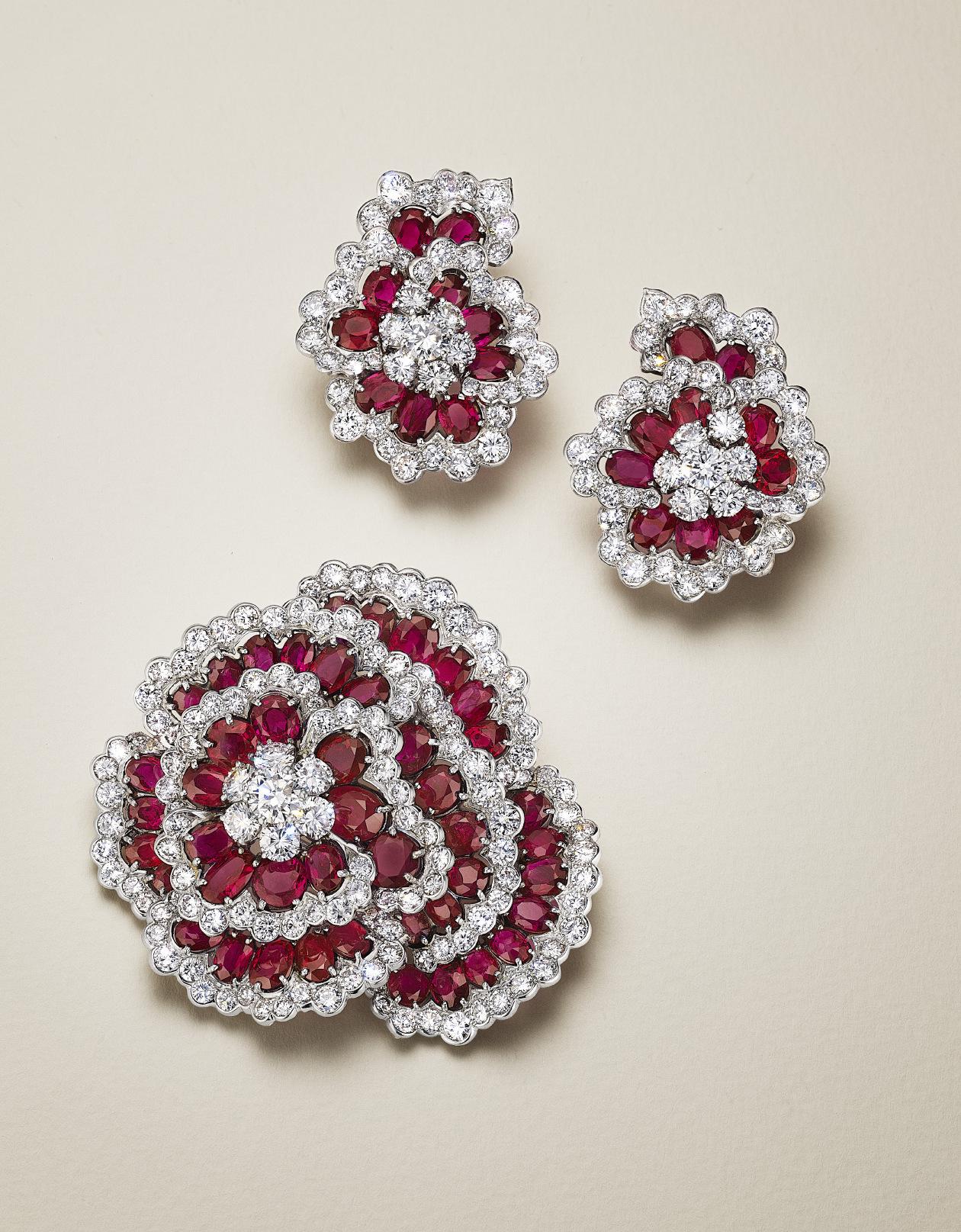







(two views)
AN IMPORTANT VAN CLEEF & ARPELS DIAMOND RING
Emerald-cut diamond of 24.99 carats, trapezoid-shaped diamonds, platinum, signed Van Cleef & Arpels, maker's mark, numbered
GIA, 2025, report no. 1232576801: 24.99 carats, F color, VVS1 clarity
Size/Dimensions: measures as US ring size 6, however, due to sizer fits as US ring size 4Ω
Gross Weight: 16.4 grams
$800,000-1,200,000
PROVENANCE:
Christie's, New York, 15 October 2003, Sale 1283, Lot 432 (diamond only)
LEARN MORE
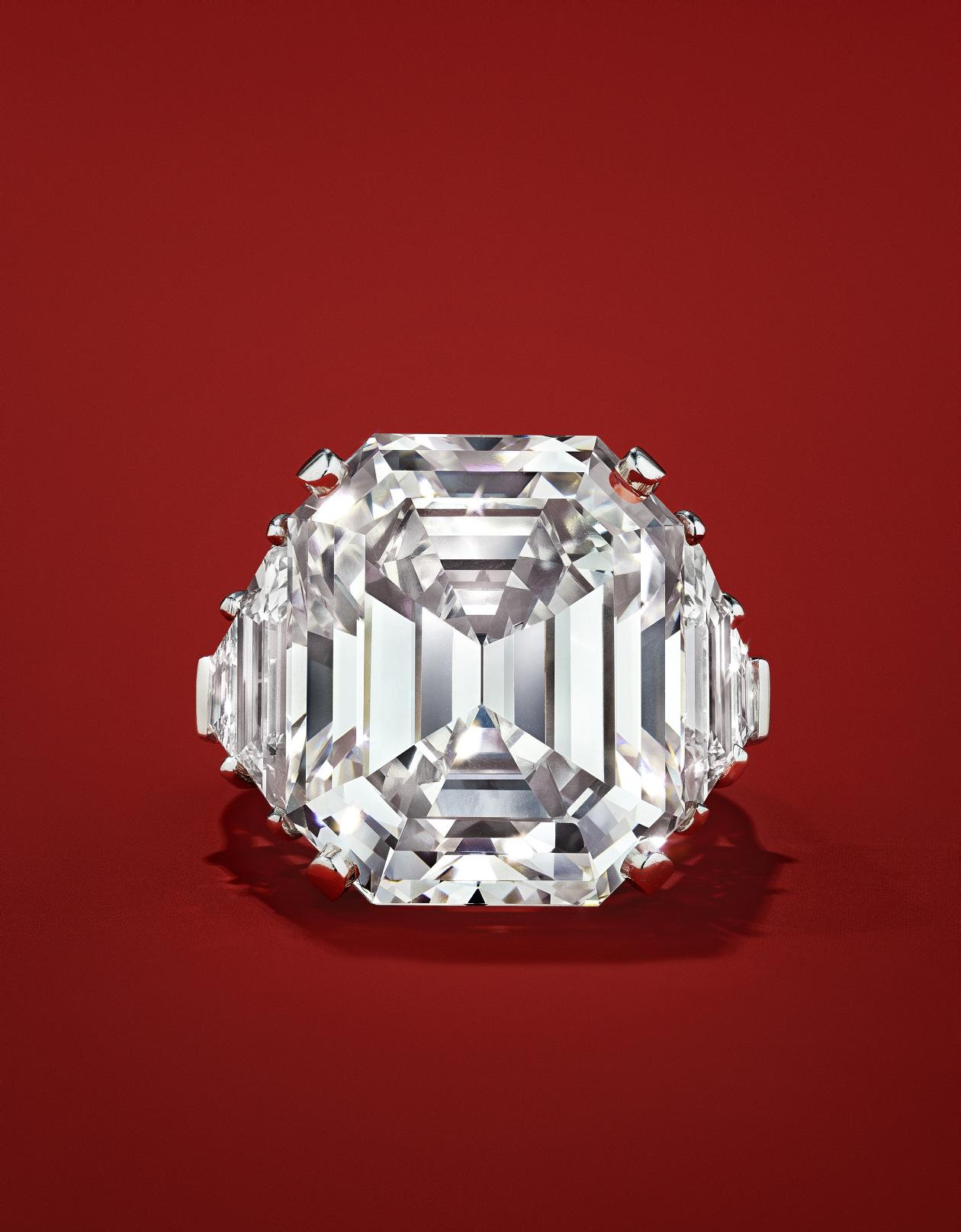
Van Cleef & Arpels
‘Mystery-Set’ Jewels
Unmistakable to the eye, exceptionally crafted by design, the ‘Mystery-set’ or ‘Serti Mysterieux’ is a delicate and precise technique of which only few jewelers have mastered. A testament to this skill, only pieces crafted by the best Van Cleef & Arpels jewelers earn the title ‘Mystery-set’. Often imitated, this unique style of setting colored stones was patented in the 1930s by Van Cleef & Arpels.
Thoughtfully designed, the ‘Mystery-set’ setting uses a series of lattices, often in gold or platinum, rather than using traditional prongs or a claw-style setting. These lattices form a net, visible only from the reverse of the jewel, which carefully holds each gemstone in place. Richly saturated rubies, sapphires and delicate emeralds are cut with the utmost precision - each stone faceted with a special groove below the girdle, allowing them to slide gently along the lattice and sit snugly to one another. Taking on average over 1,200 hours to complete a singular ‘Mystery-set’ jewel, the resulting creation is combination of color, beauty and prowess.
The Collection of Lucille Coleman, featuring one of the most important collections of ‘Mystery-set’ jewelry, was thoughtfully curated over Coleman’s storied lifetime. A true collector in every sense, the collection includes nine jewels which highlight this iconic setting style with exceptional scale and gemstone quality. These classic floral and leaf motifs, and a bespoke sapphire flag brooch bearing the initial ‘M’ in rubies, is certain to catch the eye of all Van Cleef & Arpels collectors and enthusiasts alike.
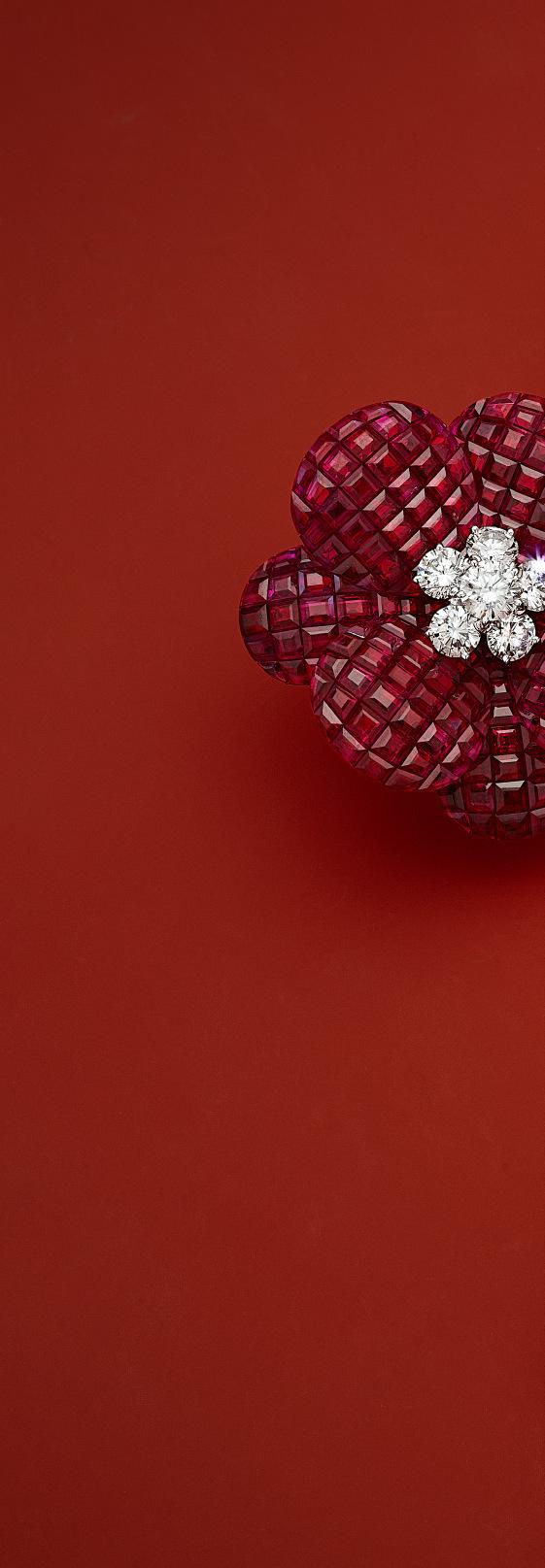






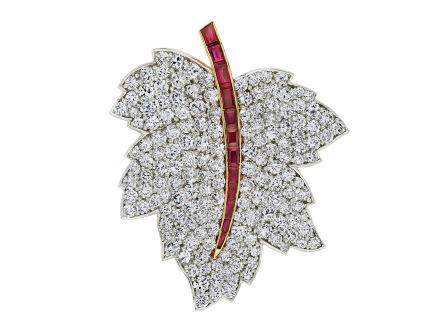
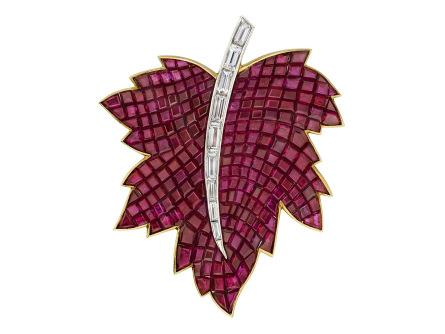
19
VAN CLEEF & ARPELS DIAMOND AND RUBY LEAF BROOCH
Round and old-cut diamonds, baguette and tapered baguette-cut rubies, platinum, yellow and white gold, circa 1965, signed Van Cleef & Arpels N.Y, numbered
Size/Dimensions: 4.2 x 5.0 cm (16 x 2 in)
Gross Weight: 22.1 grams
$40,000-60,000
PROVENANCE:
Herbert and Nell Singer
Sotheby's, New York, 24 April 2007, Sale N08306, Lot 345
20
VAN CLEEF & ARPELS RUBY AND DIAMOND 'MYSTERY-SET' LEAF BROOCH
Calibré-cut rubies, baguette-cut diamonds, yellow and white gold, circa 1965, signed VCA NY, numbered
Size/Dimensions: 5.0 x 4.4 cm (2 x 1æ in)
Gross Weight: 16.8 grams
$60,000-80,000
PROVENANCE:
Herbert and Nell Singer
Sotheby's, New York, 24 April 2007, Sale N08306, Lot 344
LITERATURE:
Cf. D. Bennett and D. Mascetti, Understanding Jewellery, Suffolk, Antique Collectors' Club Ltd., 1989, p. 370
LEARN MORE
LEARN MORE






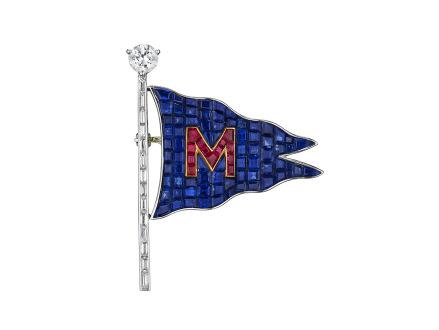
VAN CLEEF & ARPELS SAPPHIRE, RUBY AND DIAMOND 'MYSTERY-SET' FLAG BROOCH
Designed as a flag depicting the letter 'M,' calibré-cut sapphires and rubies, round and baguette-cut diamonds, platinum and yellow gold, circa 1955, signed Van Cleef & Arpels, N.Y., S.O.
Size/Dimensions: 4.2 x 3.2 cm (1¬ x 1º in)
Gross Weight: 10.8 grams
$15,000-20,000
The ruby-set ‘M’ on the brooch is for Milton, Mrs. Coleman’s beloved husband of 45 years.
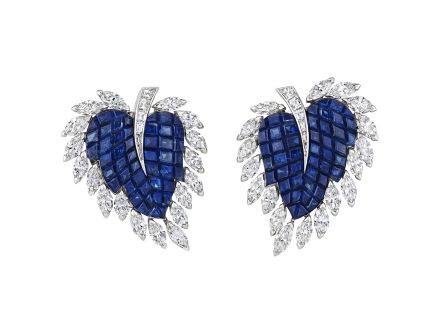
VAN CLEEF & ARPELS SAPPHIRE AND DIAMOND 'MYSTERY-SET' EARRINGS
Designed as leaves, calibré cut sapphires, marquise-shaped and tapered baguette-cut diamonds, platinum and 18k white gold (French marks), circa 1965, signed Van Cleef & Arpels, maker's mark, numbered, may be worn as clips
Size/Dimensions: 2.9 x 2.5 cm (1¿ x 1 in)
Gross Weight: 22.6 grams
$60,000-80,000
PROVENANCE: Christie's, New York, 15 April 2003, Sale 1217, Lot 346











A FINE VAN CLEEF & ARPELS RUBY AND DIAMOND 'MYSTERY-SET DEUX FEUILLES' CLIP-BROOCH
Designed as two leaves, calibré-cut rubies, round and baguette-cut diamonds, platinum and 18k white gold (French marks), circa 1965, signed VCA, numbered
Size/Dimensions: 9.5 x 4.4 cm (3æ x 1æ in)
Gross Weight: 34.9 grams
$200,000-300,000
PROVENANCE:
Sotheby's, Geneva, 14 May 2003, Sale GE0303, Lot 259 (featured on the catalogue's cover)
LITERATURE:
É. Possémé, Van Cleef & Arpels: When Elegance Meets Art, Paris, Les Arts Décoratifs, 2018, p. 119
É. Possémé, Van Cleef & Arpels: The Art of High Jewelry, Paris, Les Arts Décoratifs, 2012, p. 119
S. Coffin, Set in Style: The Jewelry of Van Cleef & Arpels, New York, Cooper-Hewitt, National Design Museum, 2011, p. 131
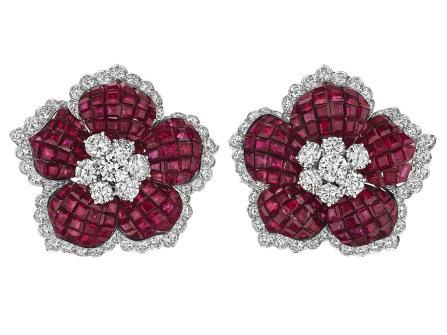
VAN CLEEF & ARPELS RUBY AND DIAMOND
‘MYSTERY-SET’ FLOWER EARRINGS
Designed as flower heads, calibré-cut rubies, round diamonds, platinum, signed VCA, NY, numbered
Size/Dimensions: 3.8 x 3.8 cm (1Ω x 1Ω in)
Gross Weight: 42.8 grams
$150,000-200,000
LITERATURE:
Cf. S. Raulet, Van Cleef & Arpels, Paris, Éditions du Regard, 1986, p. 240





LEARN MORE
A Focus on Philanthropy
Lots 25 and 26 from Mrs. Coleman’s collection were purchased at Christie’s in October 1999 by Lucille from the collection of Sybil B. Harrington.
Having grown up in Amarillo, Texas, Sybil Harrington (née Buckingham) cultivated an enduring passion for the arts. From a young age, she was captivated by music and dance – an affection that ultimately led her to the grandeur of opera. She was especially fascinated by the Metropolitan Opera’s early radio broadcasts, which ignited a profound appreciation for the company and its artistry.
Just as Mrs. Coleman gave to initiatives and institutions that she was passionate about, Mrs. Harrington was dedicated to the Metropolitan Opera. Her many contributions to the institution eventually totaled approximately $30 million. In recognition of her unparalleled generosity, the Metropolitan Opera named its main auditorium the Sybil B. Harrington Auditorium in 1987.
Her philanthropic spirit extended far beyond the arts. In 1951, she and her husband, Donald Harrington, a prominent figure in Texas’ booming oil and gas industry, established the Don and Sybil Harrington Foundation. Through this foundation, Sybil supported a broad range of civic and charitable causes over four decades. Her philanthropic legacy includes support for organizations such as the Boy Scouts of America, the Harrington Arthritis Research Foundation in Phoenix, and the Deafness Research Foundation in New York.
In 1999, a selection from her jewelry collection was offered at Christie’s, showcasing pieces from some of the most prominent jewelry houses of the 20th century. Among them were exquisite examples of Van Cleef & Arpels’ ‘Mystery-set’ designs, which she particularly treasured. Lots 25 and 26 are exceptional examples, and she frequently wore them together.
Lucille Coleman, like Sybil Harrington, was a women of innate elegance and unwavering generosity, leaving her own legacy of philanthropy and style that shines as brightly as her jewelry collection. Lucille’s refined taste and discerning eye are reflected throughout her jewels, and it is only fitting that she acquired Lots 25 and 26 for her extraordinary collection.

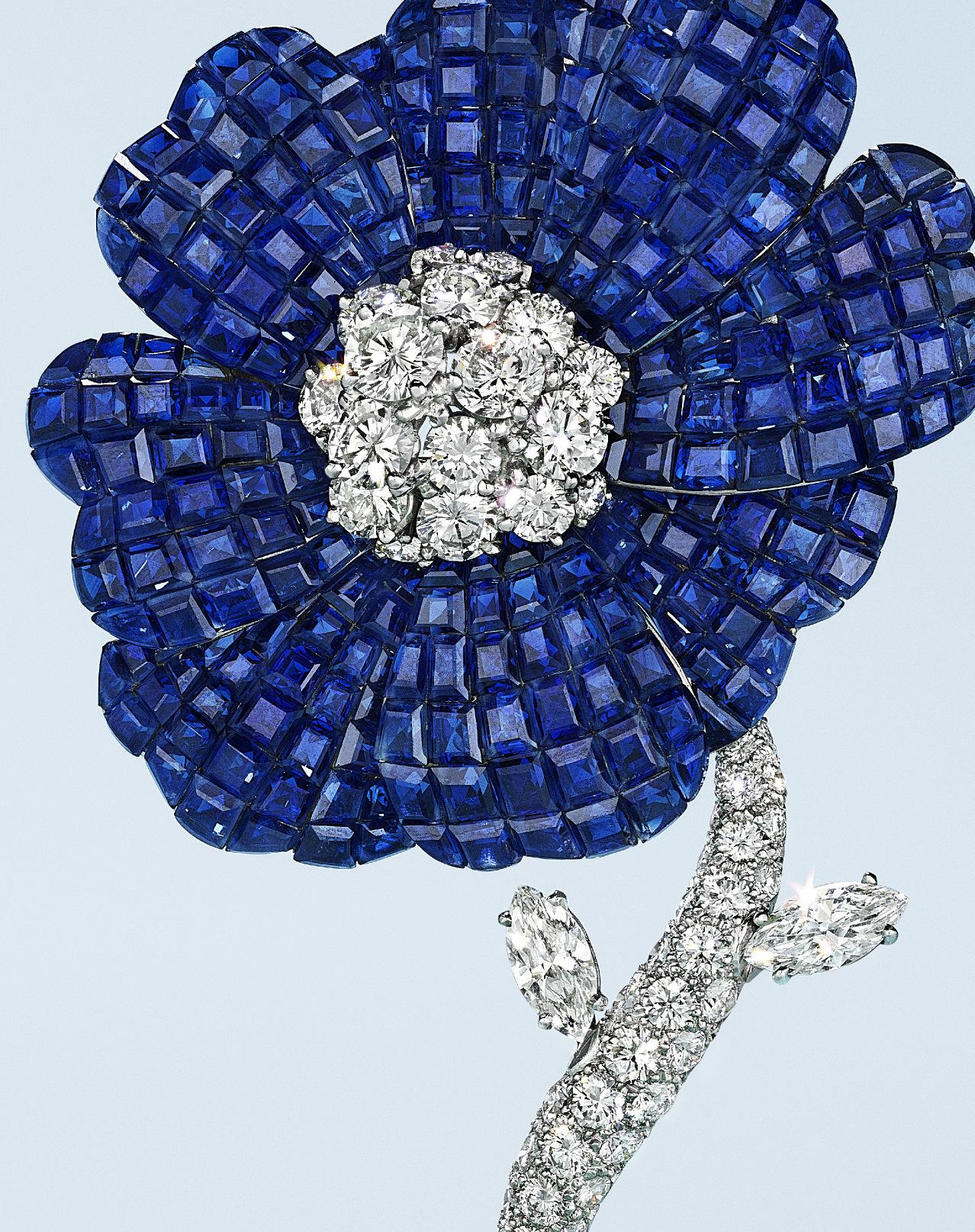






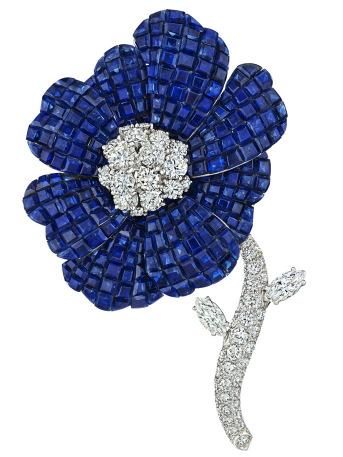
AN ELEGANT VAN CLEEF & ARPELS SAPPHIRE AND DIAMOND 'MYSTERY-SET PAVOT' BROOCH
Designed as a flower, calibré-cut sapphires, round and marquise-cut diamonds, platinum, circa 1965, signed Van Cleef & Arpels, N.Y., numbered, stem detachable
Size/Dimensions: 7.6 x 5.3 cm (3 x 2¿ in)
Gross Weight: 40.0 grams
$200,000-300,000
PROVENANCE:
Sybil Harrington (1908 - 1999)
Christie's, New York, 19 October 1999, Sale 9304, Lot 837
LITERATURE:
Cf. S. Raulet, Van Cleef & Arpels, Paris, Éditions du Regard, 1986, p. 208
Cf. N. Foulkes, Van Cleef and Arpels: Alhambra, Paris, Éditions Xavier Barral, 2018, p. 36
Cf. F. Falluel, L. Schiffer, Palais Galliera, Van Cleef & Arpels, Paris-Musées, 1992, p. 163 (shown without stem attachment)
LEARN MORE
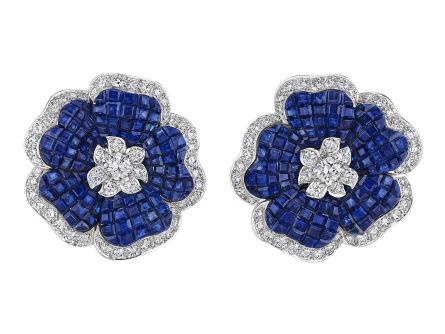
VAN CLEEF & ARPELS SAPPHIRE AND DIAMOND 'MYSTERY-SET' FLOWER EARRINGS
Designed as flower heads, calibré-cut sapphires, round diamonds, platinum, signed Van Cleef & Arpels, N.Y., numbered
Size/Dimensions: 3.2 x 3.2 cm (1º x 1º in)
Gross Weight: 47.0 grams
$100,000-150,000
PROVENANCE:
Sybil B. Harrington (1908-1998)
Christie's, New York, 19 October 1999, Sale 9304, Lot 836
LITERATURE:
Cf. S. Raulet, Van Cleef & Arpels, Paris, Éditions du Regard, 1986, p. 240





LEARN MORE





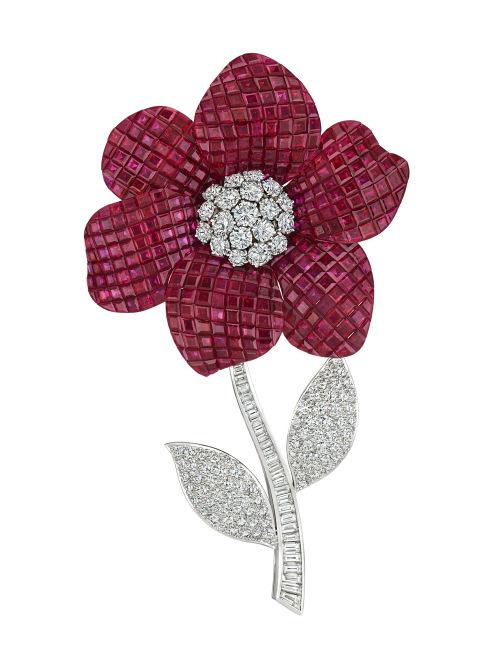

(shown without stem attachment)
AN EXTRAORDINARY VAN CLEEF & ARPELS RUBY AND DIAMOND 'MYSTERY-SET' BROOCH
Designed as a flower, calibré-cut rubies, round and baguette-cut diamonds, 18k yellow gold (French mark) and platinum, signed Van Cleef & Arpels (flower), Van Cleef & Arpels, NY (stem), maker's mark, each element numbered, stem detachable
Size/Dimensions: 10.6 x 5.3 x 0.3 cm (4 x 2 x ¿ in)
Gross Weight: 57.8 grams
$400,000-600,000
LITERATURE:
Cf. É. Possémé, Van Cleef & Arpels: When Elegance Meets Art, Paris, Musées Des Arts Décoratifs, 2018, p. 116

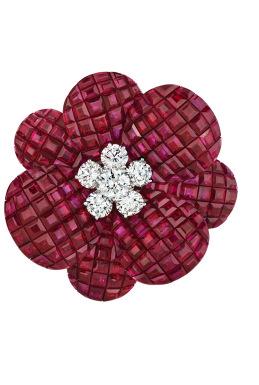
A PAIR OF EXCEPTIONAL VAN CLEEF & ARPELS
RUBY AND DIAMOND 'MYSTERY-SET' EARRINGS
Designed as flower heads, calibré-cut rubies, round diamonds, 18k yellow gold and platinum (French marks), signed V.C.A., N.Y., maker's marks, numbered
Size/Dimensions: 3.5 x 3.5 cm (1¡ x 1¡ in)
Gross Weight: 40.3 grams
$200,000-300,000
LITERATURE:
Cf. S. Raulet, Van Cleef & Arpels, Paris, Éditions du Regard, 1986, p. 208
Cf. F. Falluel, L. Schiffer, Palais Galliera, Van Cleef & Arpels, Paris-Musées, 1992, p. 162






Lucille Coleman, celebrating her 40th wedding anniversary with her husband Milton (not pictured), wearing Lots 27 and 28 in 2003 at La Côte Basque Courtesy of Fred Marcus Studio
LEARN MORE


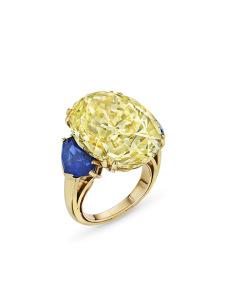
(two views)
AN IMPORTANT CHAUMET COLORED DIAMOND AND SAPPHIRE RING
Fancy intense yellow oval brilliant-cut diamond of 21.20 carats, triangular fancy-cut sapphires, 18k yellow gold (French mark, partially obscured), signed Chaumet, New York
GIA, 2025, report no. 2233547477: 21.20 carats, Fancy Intense Yellow, natural color, VVS2 clarity, Not Potential/Improvable
Size/Dimensions: measures as US ring size 4Ω, however, due to sizer fits as US ring size 4
Gross Weight: 11.3 grams
$500,000-700,000





The Palmette Motif
Palmette designs were prominent in Belle Époque jewelry reflecting the era’s focus on classical beauty, elegance, and fine craftsmanship. Inspired by ancient Greek and Roman art, the palmette motif symbolized vitality and timeless beauty. Its graceful, symmetrical shape suited the delicate and feminine aesthetic that defined Belle Époque fashion as seen in the central element of Lot 30.
As platinum became popular, jewelers could create intricate, lacy settings that showcased palmette designs with diamonds, enhancing their sparkle and lightness. The motif also paired well with other common elements like garlands, ribbons, and laurel wreaths.
Ultimately, the palmette embodied both historical reverence and modern luxury, making it a perfect fit for the refined tastes of the Belle Époque elite and as such was embraced by top jewelry houses, including Boucheron, Cartier and Chaumet.
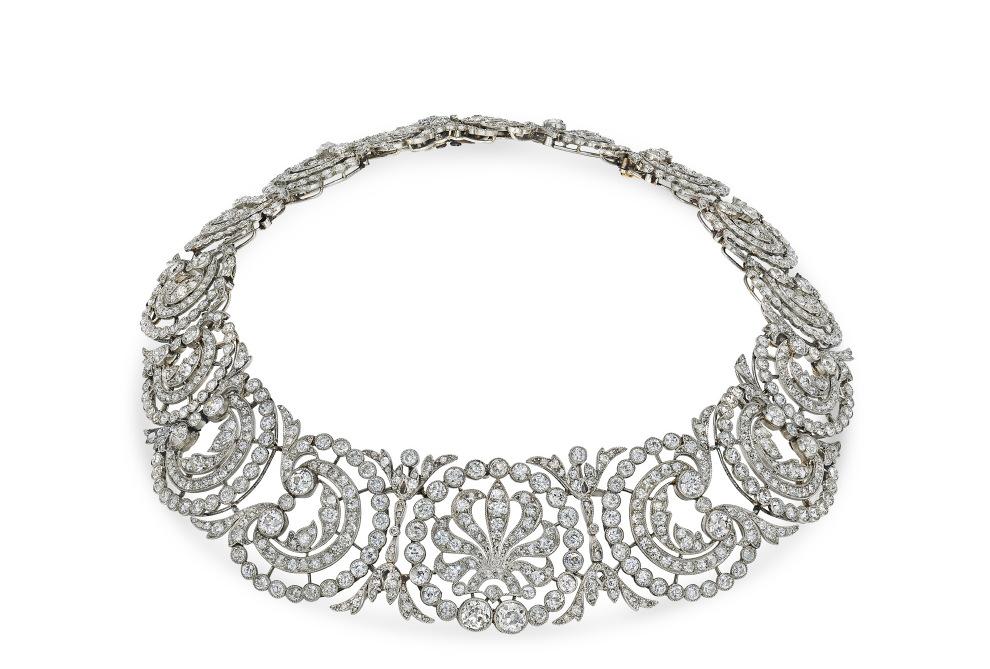
BELLE ÉPOQUE DIAMOND CHOKER NECKLACE
Old, single and rose-cut diamonds, platinum, circa 1910
Size/Dimensions: 35.6 cm (14 in)
Gross Weight: 100.9 grams
$30,000-50,000
Cartier Aquamarines and the Art Deco Movement
The Art Deco period was marked by a celebration of geometric patterns and adventurous use of color. These elements, combined with a prominent use of platinum, provided a sharp contrast from the sinuous and organic style of the proceeding Art Nouveau era. In the 1930s, Cartier used bright, variously-sized aquamarines to create some of their most noteworthy and intricate designs. The use of aquamarines became the primary focus, with or without diamond accents, and limited use of platinum.
Along with interest in earrings, rings and bracelets, the London branch received twenty-seven requests for aquamarine and diamond tiaras in 1937 alone. Many of these tiaras were worn to the coronation of King George VI that same year.
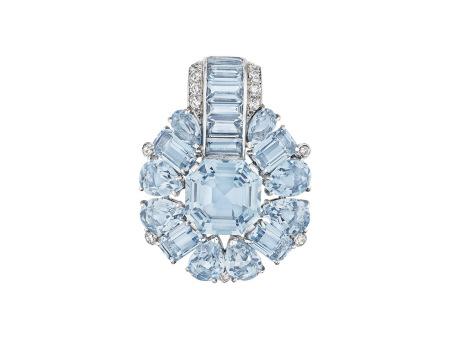
CARTIER ART DECO AQUAMARINE AND DIAMOND CLIP-BROOCH
Square, rectangular and pear-shaped aquamarine, round diamonds, platinum (French marks), circa 1935, signed Cartier, Paris, maker's mark (Jacques Cartier), numbered
Size/Dimensions: 3.8 x 3.2 cm (1Ω x 1º in)
Gross Weight: 21.4 grams
$20,000-30,000
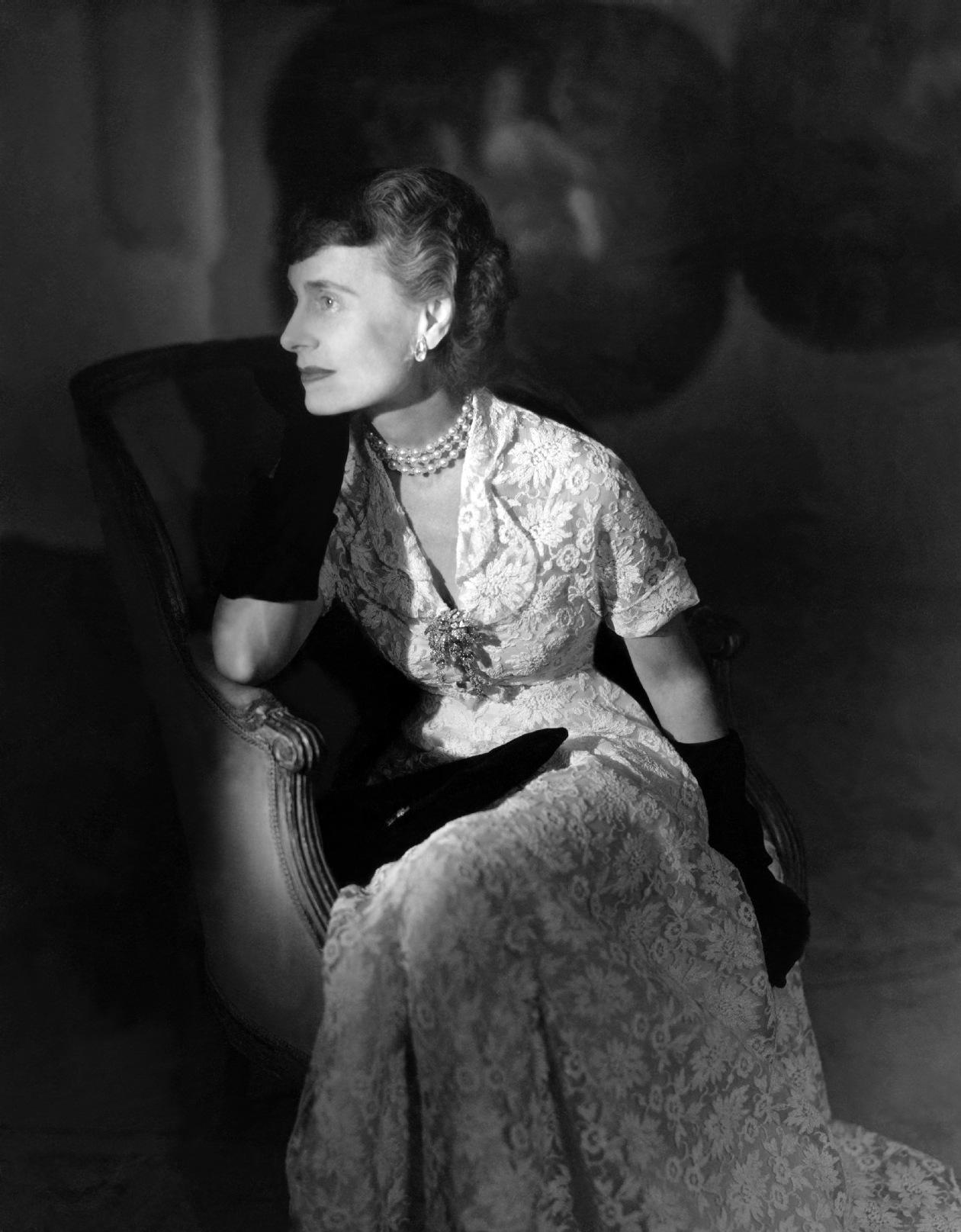
Margaret Thompson Biddle
A collector of fine art and objects with an incredible eye for jewelry, the elegantly sophisticated Margaret Thompson Biddle was the daughter of notable copper miner and financier, William Boyce Thompson.
Her father, William Boyce Thompson was born and raised around mining in Helena, Montana, so it was no surprise that he went on to make a name for himself in the copper mining industry. After retiring from the New York Stock Exchange around 1915, Thompson’s interests returned back to mining with his founding of the Newmont Mining Corporation.
William and his family were avid supporters of philanthropies and charitable efforts around the world, so much so he was awarded the honorary title of Colonel by the American Red Cross. In addition to the several companies he owned, he founded the Boyce Thompson Institute in New York in the 1920s. The institute focuses on scientific plant research with the ultimate goal of improving human welfare.
Margaret caught the eye of prominent Philadelphian Anthony Drexel Biddle Jr, and in 1931 they were married. That same year he was appointed the Minister to Norway by President Roosevelt, and then Ambassador to Poland 1937. This led Margaret, their children, and him all over the world. After fleeing Poland in 1939, they landed in England for one of Anthony’s commissions. In this position, he worked with the governments-in-exile of Czechoslovakia, Luxembourg, the Netherlands, Poland, Norway, Yugoslavia, Belgium, and Greece. Biddle held numerous ambassador positions in the years that followed.
Relocating to France after their separation at the end of WWII, Margaret spent time between her home on the French Riviera and a hôtel particulier on the notable Boulevard Saint-Germain in Paris. Here she was known to be quite the hostess and socialite. At one of her lavish soirees one might have found The Eisenhowers, The Duke and Duchess of Windsor, and any notable French creative of the time.
Christie’s has had the incredible opportunity to share with collectors spectacular jewels from Margaret’s collection, including an elegant Diamond ‘Palm-Tree’ Brooch mounted by Cartier which sold for just over one million dollars in 2022. Most recently, a charming pear-shaped diamond of 11.98 carats also brought over one million dollars in 2024.
Once again, Christie’s has the privilege of unveiling three more jewels from Margaret’s collection including an emerald and diamond pendant clasp and pair of emeralds drops, each of Colombian origin, along with an impressive old-cut diamond of over 13.00 carats.
Opposite: Margaret Thompson Biddle, Horst P. Horst, Vogue © Condé Nast
Credit: Horst P. Horst, Vogue © Condé Nast
from the Collection of Margaret Thompson Biddle
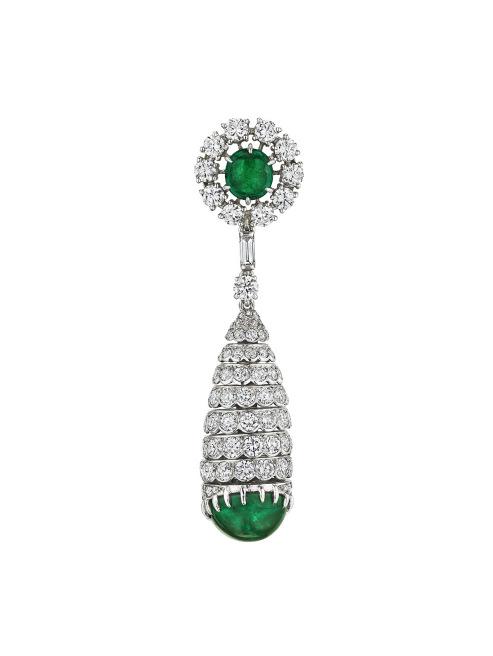
EMERALD AND DIAMOND PENDANT-CLASP
Round and oval cabochon-cut emeralds, round, single and baguette-cut diamonds, 18k white gold and platinum (French marks), circa 1950
AGL, 2025, report no. 1146029: Colombia, minor clarity enhancement, traditional type
Size/Dimensions: 7.6 cm (3 in)
Gross Weight: 27.9 grams
$50,000-70,000

PAIR OF EMERALD AND DIAMOND PENDANT EARRING DROPS
Drop-shaped drilled bead-shaped emeralds, old and single-cut diamonds, platinum, circa 1950
AGL, 2025, report no. 1146030 A and B: Colombia, minor clarity enhancement, traditional type
Size/Dimensions: 3.1 cm (1º in)
Gross Weight: 11.0 grams
$30,000-50,000
from the Collection of Margaret Thompson Biddle


DIAMOND RING
Circular brilliant-cut diamond of 13.27 carats, single-cut diamonds, platinum, circa 1950
GIA, 2025, report no. 2235509530: 13.27 carats, H color, SI1 clarity
Size/Dimensions: US ring size 6Ω
Gross Weight: 8.1 grams
$150,000-200,000
(two views)
LEARN MORE

Jewelry Designs of the 1970s
Transitioning from the understated elegance of previous decades, the 1970s ushered in a new era of bold, expressive jewelry design, driven by a cultural shift towards heightened individuality and self-expression. Among the various trends that emerged during this period was the revival of Art Deco influences, notably through the reintroduction of vibrant semi-precious stones like coral, lapis lazuli and turquoise. These colorful gemstones were frequently arranged in geometric patterns, moving away from the monochromatic, often all-diamond jewels that had previously dominated the market. At the same time, yellow gold became a near-exclusive metal of choice, marking its first widespread use in high jewelry – a noteworthy departure from tradition.
The present lot by Cartier serves as a prime example of iconic designs that capture the bold spirit of the 1970s. The vivid orange hues of meticulously arranged coral plaques complement faceted white diamonds and sleek yellow metal, evoking the sense of colorful aesthetics.

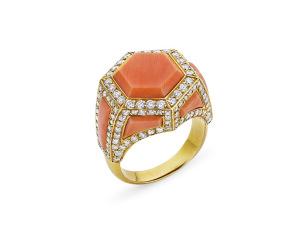

CARTIER SUITE OF CORAL AND DIAMOND JEWELRY
Variously-shaped coral plaques, round diamonds, 18k yellow gold (bracelet and ring each with French mark), circa 1970, bracelet and earrings each signed Cartier, Paris, bracelet and ring each with maker's mark (Société Anonyme Cartier), bracelet and earrings each numbered, one red Cartier case
Size/Dimensions: cuff bracelet continuous inner circumference 15.8 cm (6º in), inner diameter 5.5 cm (2¿ in); earrings 2.1 x 2.1 cm (æ x æ in); US ring size 6æ
Gross Weight: 100.6 grams
$80,000-120,000
LEARN MORE


Cartier ‘Panthère’ Jewelry
For over a century, the panther has endured as a timeless and iconic motif for the house of Cartier. It was not until 1914 when Louis Cartier requested an invitation for his jewelry exhibition and commissioned artist George Barbier to create what soon pioneered an integral part of the maison. The elegant invitation displayed Lady With a Panther, a woman in a white gown, draped with pearls and a black panther resting at her feet. This illustration was the initial moment clients of the French house saw the now iconic cat. In that same year, the spotted pattern was featured on a lady's wristwatch created by diamonds and onyx mimicking the big cat’s fur. The exotic creature took Paris by storm – a sign of elegance and fierce femininity.
In 1933, style icon Jeanne Toussaint was appointed as Artistic Director of High Jewelry and would soon make the panther an integral part of the maison’s identity. Louis Cartier fondly nicknamed Toussaint ’La Panthère’ for her long panther fur coat, fierce determination and intellect. In a time where it was rare to find women in such prominent roles in the industry, Toussaint quickly proved why she deserved this position.
Jeanne Toussaint was born in Belgium and moved to Paris at the height of the Belle Époque. Her style and charisma made her a fixture in society circles as Louis Cartier quickly recognized her creative talent. He invited Toussaint to join the maison around 1918, first starting in leather goods, then promoting her to head of the silver department before handing her the creative reins of the house in 1933.
With a vision to bring the poised panther design to life, Touissant and her creative team would visit the Vincennes Zoo to study the anatomy of the animal to perfect the silhouette as a jewel. In 1948, at the request of the Duke of Windsor, the first three-dimensional Cartier ‘Panthère’ jewel was created for his wife, the Duchess of Windsor, with a second extraordinary panther piece purchased the following year.
Nearly a decade later, Prince Sadruddin Aga Khan would commission the maison to create a suite of jewelry for his first wife Nina Dyer which included the first double headed panther bangle executed with diamonds, sapphires, and emeralds. Other icons drawn to the feline-themed jewel include María Félix, Daisy Fellowes and Barbara Hutton.
Today, the panther continues to amaze as an indelible symbol of Cartier savoir-faire, iconic historical provenance, and fierce femininity. Through abstract or figurative design, Cartier continues to capture the attention of enthusiasts and collectors with these remarkable panther designs.

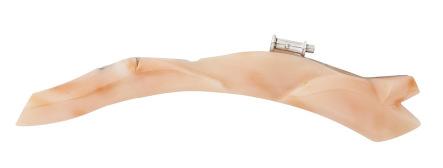
(interchangeable brooch fitting)
CARTIER MULTI-GEM AND DIAMOND 'PANTHÈRE'
CLIP-BROOCH
Designed as a panther resting on a branch, carved coral, variously-shaped onyx plaques, pear-shaped emeralds, round diamonds, platinum and 18k white gold (French marks), signed Cartier, brooch with maker's marks (Jean-Claude Janot), brooch and coral branch each numbered, coral branch detachable, accompanied by an interchangeable brooch fitting of a carved angel skin coral branch of 18k white gold (French mark) with maker's mark (Jean-Claude Janot), eye-visible chip and break to angel skin coral, one red Cartier case, one red Cartier plastic case
Size/Dimensions: 7.3 x 4.1 cm (2√ x 1¬ in)
Gross Weight: 72.2 grams
$100,000-150,000
LITERATURE:
Cf. P. Rainero, G. Solana, J. Varela, The Art of Cartier, Museo Thyssen-Bornemisza Madrid, 2012, p. 296

CARTIER ONYX, EMERALD AND DIAMOND 'PANTHÈRE' BROOCH
Designed as a hanging panther, variously-shaped onyx plaques, pear-shaped emeralds, round diamonds, platinum and 18k white gold (French marks), circa 1970, signed Cartier, Paris, maker's marks (Société de Fabrication de Haute Joaillerie), numbered, red Cartier case
Size/Dimensions: 7.9 x 5.4 cm (3¿ x 2¿ in)
Gross Weight: 80.2 grams
$250,000-350,000
LITERATURE:
Cf. N. Coleno, Amazing Cartier, Jewelry Design Since 1937, Paris, Flammarion, 2009, p. 59
Cf. F. Cologni, E. Nussbaum, Platinum by Cartier: Triumphs of the Jeweler's Art, New York, Harry N. Abrams, Inc., 1995, p. 224
Cf. D. Bennett and D. Mascetti, Understanding Jewellery, Suffolk, Antique Collectors' Club Ltd., 1989, p. 455
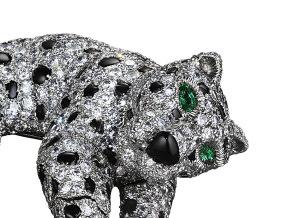







AN ELEGANT CARTIER DIAMOND RING
Cut-cornered rectangular step-cut diamond of 13.60 carats, baguette-cut diamonds, platinum (French mark), circa 1935, signed Cartier, maker's mark (Société Anonyme Cartier)
GIA, 2025, report no. 1172422938: 13.60 carats, D color, VVS1 clarity, potentially Internally Flawless, Type IIa
Size/Dimensions: measures as US ring size 4æ due to sizing beads
Gross Weight: 8.1 grams
$700,000-1,000,000
(two views)
LEARN MORE


India and Cartier
The intimate relationship between Cartier and India began in 1911. Jacques Cartier traveled to India for the very first time to attend the Coronation of George V and Queen Mary of Teck at the Delhi Durbar. During this weeklong celebration, whereas they were crowned Emperor and Empress of India, nearly every ruling Maharaja of India was present.
It was here where Indian tradition made a mark on Jacques but also where he captivated the attention of the Maharajas and Maharanis in attendance. Sharing western designs from the Maison in Paris, he developed lasting relationships with new clients and suppliers. Most importantly, he brought back to Paris innovative inspiration that would result in one of the most important eras not just for Cartier but for the history of jewelry design.
Fascinated by French design, it was not long before Indian royalty began to commission Cartier to breathe new life into their family jewels, creating new pieces from old materials and building a collaborative bridge between East and West.
Jacques began to import unique gemstones from India to France in order to craft bespoke pieces to fulfil these commissions and in turn, European interest and intrigue in Indian culture became increasingly popular. The international jet set were enamored by these designs and commissioned jewels of their own that included Indian elements enhancing otherwise western jewels.
Jacques kept a journal of his travels to and from India, noting moments of inspiration and admiration of the richly diverse part of the world. Carved and cabochon-shaped precious stones, natural pearls and enamel enhanced jewels that notably were of larger scale and more opulent in design than the diamond-set Art Deco jewels of the era.
Designed as a Jabot pin, Lot 39 is an incredible example of French design with Indian influence. Originating in France and wildly popular in the 1920s and 1930s, the jabot pin-brooch features an ornamented motif at either end. By design, only the bejeweled ends are visible, allowing the fabric to be seen in between. In the 17th century, jabot pins were primarily used to secure the piece of fabric on the front of men’s shirts. At this same time in history, Indian rulers were wearing this style of jewel to keep opulent garments in place or precisely secure their turban. Through the use of natural pearls, carved rubies and cabochon emeralds, in tandem with the sharply shaped baguettecut diamonds and geometric polished platinum – this Cartier Art Deco Jabot-Brooch is a perfect marriage of East and West.
Featuring carved and cabochon emeralds, table and old-cut diamonds and opaque enamel work, Lot 40 is inspired by traditional Indian turban ornaments. Called ‘sarpechs’ or ‘jighas’, these traditional pieces were worn by Indian rulers on the front of their turbans. Ornate and often with openwork design, historical imagery shows Indian sarpechs and jighas with colorful enameled surfaces, charming portrait and table-cut diamonds, along with vibrant carved gemstones. These thoughtful creations were said to be worn by only the highest-ranking Indian rulers.
This fascinating Cartier brooch is intended to be worn on the shoulder, while the accompanying detachable seed pearl tassel moves with the wearer ever so gracefully. The use of opaque black enamel, old and table-cut diamonds, along with geometric nods cement this shoulder brooch firmly in the Art Deco period. A standout out lot in the groundbreaking 2019 Christie's sale, Maharajas & Mughal Magnificence, this Cartier Art Deco Multi-Gem Shoulder Brooch is the perfect culmination of the inspiration Jacques Cartier took from India.
Filled with history, these two magnificent brooches from the same Exceptional Private Collection are some of the most excellent examples of the lasting dialogue between Cartier and India.

India and Cartier: Property from an Exceptional Private Collector Lots 39-40

CARTIER ART DECO RUBY, EMERALD, DIAMOND AND NATURAL PEARL JABOT-BROOCH
Round cabochon-shaped and carved rubies, round cabochon-shaped emeralds, old, single and baguette-cut diamonds, button-shaped natural pearl, circa 1930, platinum, signed Cartier, numbered
GIA, 2020, report no. 6213087110: Natural Pearl, freshwater, no indications of treatment
Size/Dimensions: 6.0 x 6.0 cm (2¡ x 2¡ in)
Gross Weight: 34.5 grams
$50,000-70,000
PROVENANCE:
Christie's, New York, 8 December 2020, Sale 18991, Lot 147


CARTIER ART DECO MULTI-GEM AND DIAMOND SHOULDER BROOCH
Oval and round emerald cabochons, carved, buff-top and square-shaped emeralds, round ruby cabochons, table and old-cut and diamonds, black enamel, platinum and yellow gold, circa 1924, unsigned, areas of deficiency to the enamel and chips to the emeralds; accompanied by detachable tassel of later addition recreated from original records by Cartier workshops, seed pearls and onyx beads, square-shaped emeralds, round cabochon emeralds and rubies, black enamel, round diamonds, 18k white gold (French mark), signed Cartier, maker's mark, numbered, accompanied by a black silk cord, red Cartier case
Cartier, 2010: Certificate of Authenticity (brooch)
Cartier, 2012: Certificate of Authenticity (brooch and tassel)
Size/Dimensions: 15.3 cm (6 in), without detachable tassel 6.3 x 3.1 cm (2Ω x 1º in)
Gross Weight: 67.5 grams
$100,000-150,000
PROVENANCE:
Sotheby's, New York, 9 December 2010, Sale N08687, Lot 464
Christie's, New York, 19 June 2019, Maharajas & Mughal Magnificence, Sale 17464, Lot 225
EXHIBITED:
Metropolitan Museum of Art, New York 2014, pp. 104-5
Victoria and Albert Museum, London 2015, p. 137, no. 80
The Miho Museum, Koka 2016, p. 185, no. 146
Grand Palais, Paris 2017, p. 302, no. 224
The Doge’s Palace, Venice 2017, p. 315, no. 216
The Palace Museum, Beijing 2018, p. 329, no. 220
de Young Legion of Honor, San Francisco 2018, p. 139, no. 70
LITERATURE:
Jaffer 2013, p. 320, no. 111

For the Mughals the colour green was a symbol of paradise, it signified eternity and immortality.
The wealth of the Mughal courts made India the center of the gem trade in the world, and their obsession with jewels was legendary. Emeralds were particularly coveted by the Mughals because of their colour, lustre and size. The highly skilled craftsmen in their courts carved these gems inspired by the gardens that the Mughals surrounded themselves with.
My first encounter with a carved Mughal Emerald was at the age of 17 at my father’s jewellery shop. It was a Mughal Emerald button of exceptional quality and it left such a lasting impression on me… the shape, the form, the aesthetic, the depth of colour and the delicacy of the carving. The fact that this was a button for a man’s jacket left me speechless, and indicates the opulence of jewels worn during the Mughal period. Since then I have always admired and coveted these rare Mughal treasures.
The three lots of Mughal Indian jewels coming for sale at Christie’s in June are exceptional examples of Mughal era gems. The size, the quality and the history renders them exceptionally rare and truly a collector’s dream.
Viren Bhagat
Bhagat today is widely recognized as one of the most inventive contemporary jewelers of our time. Based in Mumbai, Bhagat works with a strictly limited but opulent palette of gemstones, tirelessly travelling the world in search of the rare and important material needed to manufacture their intricate and exquisite creations. Each unique jewel is made by hand with fewer than 60 produced annually.
Now in its fourth and fifth generations, Bhagat is run by Viren along with his two sons, Varun and Jay. Their works have been exhibited globally at the Kremlin State Museum in Moscow, the Metropolitan Museum of Art in New York and the Victoria and Albert Museum in London. In 2025, Bhagat opened its first international boutique in the Mayfair neighborhood of London, providing an extended access to its international clientele.

History of Mughal Carved Emeralds
Carved emeralds held great significance for Indian royalty, particularly during the Mughal dynasty and thereafter, due to deeply rooted cultural and aesthetic traditions.
Fine large emeralds were unknown until their discovery in Colombia by the Spanish Conquistadors during the 16th and 17th centuries. They were extremely popular in all three of the great Islamic empires of the time: Ottoman Turks, the Safavid Persians and Mughal Indians; so much so that none appear to have been retained at the time in Europe.
Emeralds were brought to India by Spanish and Portegese merchants as trade goods during the Mughal dynasty. They were highly prized for many reasons, specifically their rich green color – a color in Islam that represents paradise, life and renewal.
Used as beads or as part of artifacts, these stones were often large in size but, by nature, internally flawed, making them unsuitable for traditional faceting. Rather than discarding imperfect areas, artisans skillfully carved intricate designs into the stones, transforming each emerald into a unique artistic creation that maximized its visual and symbolic value.
By the 17th century, master carvers in Jaipur produced refined and intricate emerald carvings with floral motifs that derived from architecture of the time. With great precision they carved each stone to bring out the full color and beauty of the stone.
Mughal rulers had a strong appreciation for intricate craftsmanship and detailed ornamentation. Gemstone carvings of floral patterns, religious motifs, and inscriptions resonated with the region’s artistic sensibilities and symbolic language. Additionally, many carved emeralds bore Islamic inscriptions, such as verses from the Quran, or Hindu imagery, reflecting the religious beliefs of the maharajas and adding a sacred dimension to the jewelry. This spiritual layer elevated the gemstones beyond decoration, filling them with personal and devotional significance.
Like important spinels, some emeralds were inscribed with names of their owners as they were handed down from generation to generation signifying their power, authority and wealth. Set in turbans, necklaces, bazubands or ceremonial daggers, these stones were not only luxurious but also distinct, enhancing a ruler’s prestige through rarity and artistic uniqueness while offering protection.
Opposite: Shah Jahan on a Terrace, Holding a Pendant Set With His Portrait, 1627-1628, by Chitarman (active circa 1627-1670) Courtesy of The Metropolitan Museum of Art
Exceptional Emeralds Sold at Auction
Previously sold at Christie’s
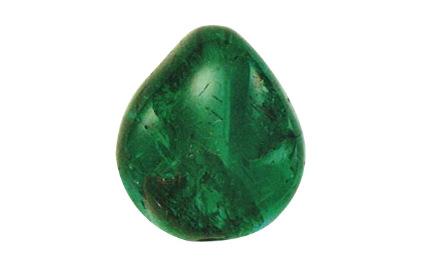
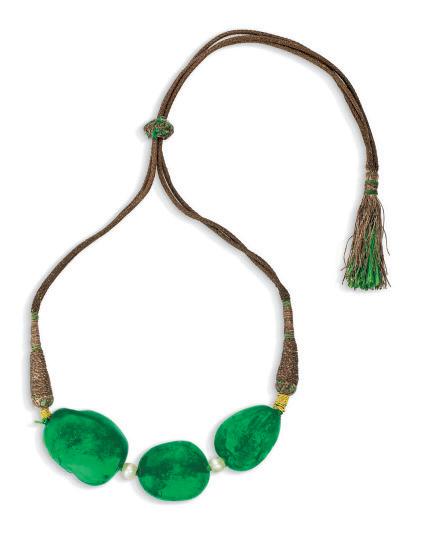
AN EMERALD BEAD MID 17TH CENTURY
Christie’s, New York, Maharajas & Mughal Magnificence, 2019
Estimate: USD 150,000-250,000
Sold: USD 350,000
ANTIQUE EMERALD BEAD AND PEARL BAZUBAND LATE 19TH CENTURY
Christie’s, Geneva, 2019
Estimate: USD 150,000-250,000
Sold: USD 375,000
Exceptional Carved Emeralds Sold at Auction
Previously sold at Christie’s

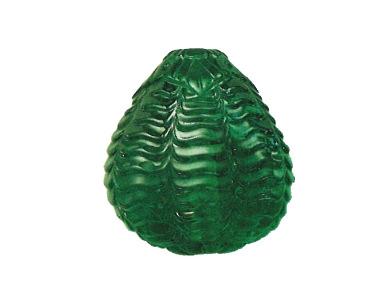
A CARVED EMERALD BEAD MID TO LATE 17TH CENTURY
Christie’s, New York, Maharajas & Mughal Magnificence, 2019
Estimate: USD 700,000-1,200,000
Sold: USD 1,035,000
A MUGHAL CARVED EMERALD PENDANT NECKLACE EARLY TO MID 17TH CENTURY
Christie’s, London, 1999
Estimate: USD 970,000-1,300,000
Sold: USD 1,091,475

CARVED EMERALD DROP EAR PENDANTS EMERALDS EARLY 17TH CENTURY, EARRINGS CIRCA 1900
Christie’s, London, 1997
Estimate: USD 160,000 - 240,000
Sold: USD 447,653
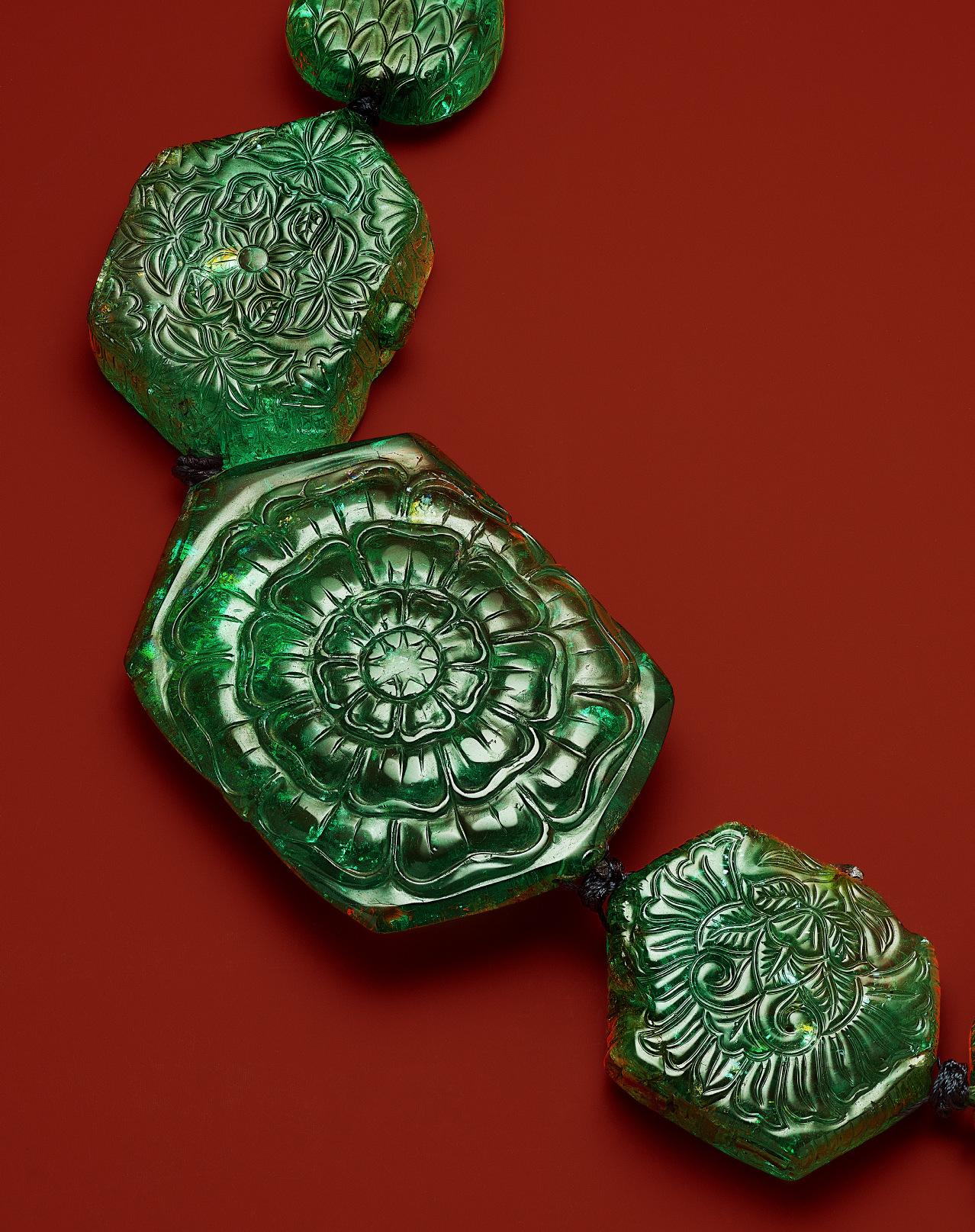

A Mughal Carved Emerald Necklace
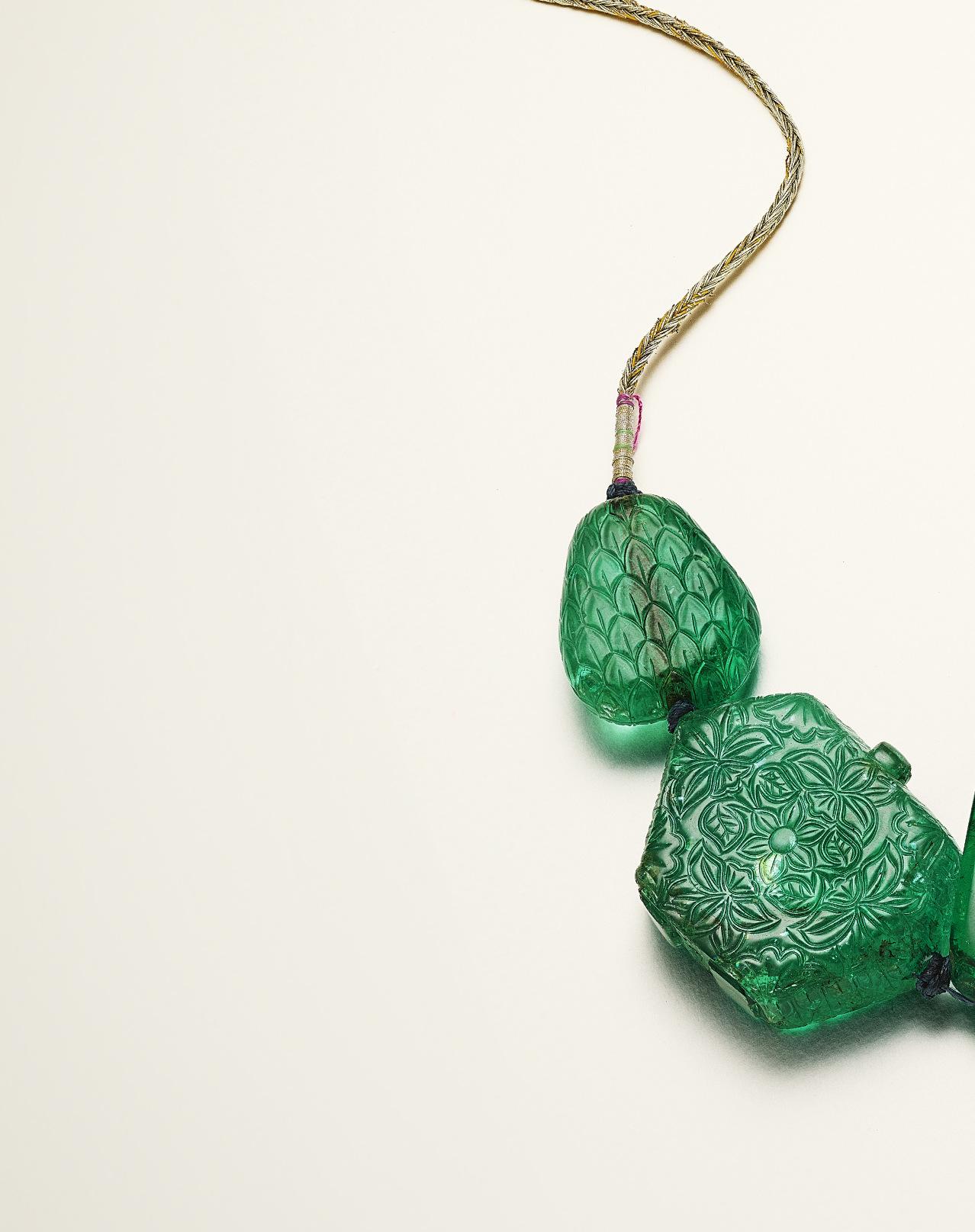
“...this emerald strand containing carved Colombian emeralds of such size can be considered very rare and exceptional.”
– Swiss Gemmological Institute regarding report no. 126237

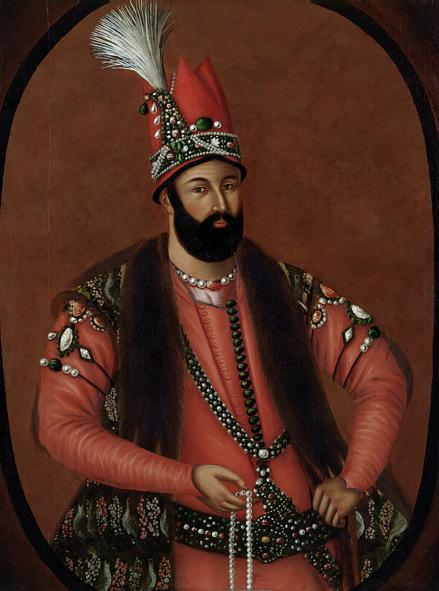
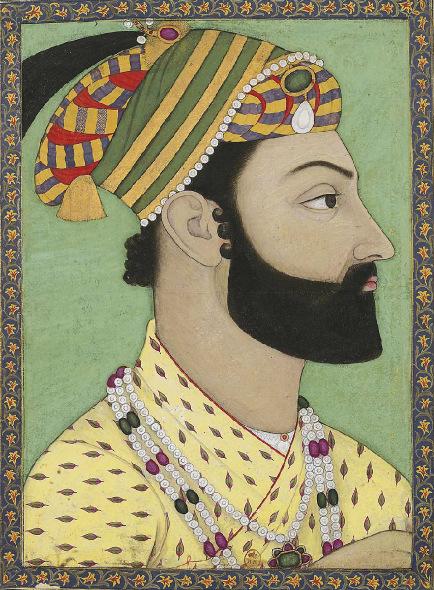
Nadir Shah of Persia, circa 1740 Courtesy of the British Library
Ahmad Shah Durrani, circa 1757 Courtesy of the Bibliothèque nationale de France
Nader Shah and Ahmad Shah Durrani
Born into the nomadic lifestyle of the Afshar tribe in the late 17th century, Nader Shah rose above his humble beginnings. After the premature death of his father, Nader was forced to make his own way in the world and sought advancement through his skill as a military tactician. As the Persian Safavid dynasty crumbled in the early 18th century, chaos erupted in the region and warring factions clamored for power. Nader built up his own army in response and in the spring of 1730 he launched his first campaign, regaining much of the Persian territory lost to the Ottomans and Afghan tribes. With the Safavids in a weakened position without his support, Nader collected powerful statesmen to promote his ultimate rise to become Shah of Persia in 1736, establishing the Afsharid dynasty.
Nader’s political and military ambitions led to campaigns across the Ottoman Empire, present-day Afghanistan, and into Mughal India. Over the course of his reign, Nader Shah acquired an impressive collection of precious gems and jewels with origin of ownership varying from gifts from foreign leaders to plunder from successful war campaigns. After conquering Kandahar, Kabul, Delhi and several other principalities, Nader Shah returned to Persia with some of his most prized accolades including the Samarian spinel, the Daria-i-Noor and Koh-i-Noor diamonds and the infamous Peacock Throne. These crown jewels would become synonymous with Nader’s sovereign strength over the region.
The present series of emeralds (Lot 41) centers upon an impressively sized 470 carat emerald with a carving of floral motif. The design emulates the popular architectural styles of 17th century Mughal India, masterfully carved to best bring out the full color and beauty of the stone. Its impressive size and precise craftsmanship, along with it’s ideal rich Colombian color, would have made it an ideal prize for Nader Shah following his 1739 capture of Delhi and subsequent control over the Mughal royal treasury.
Nader Shah’s rule came to an abrupt end just as violent as its beginning. Revolts broke out in response to his increasingly cruel domestic policies, culminating with his assassination on 20 June 1747. In the aftermath of his death, the Afsharid Empire would splinter with various new principalities that would be established in its place.
Ahmad Shah Durrani, a trusted cavalry commander to one of Nader’s regiments during his invasion of Mughal India, seized the opportunity for power in the wake of Nader’s death. In the span of a few weeks Ahmad Shah rallied tribal leaders, was elected shah and symbolically changed his tribe’s name from Abdali to Durrani, thus establishing the Durrani Empire. Regarded by many to be the father of modern Afghanistan, Ahmad Shah adopted the title “Durr-i Durrān”, meaning “Pearl of Pearls”.
Ahmad Shah was a charismatic leader and seasoned warrior whose initial focus was on consolidating power within Afghanistan. He skillfully united various tribes, many of which were known for their independence and tribal loyalty rather than allegiance to a central authority. Through a mixture of diplomacy and tradition, he brought unity to a region that had long been fragmented. Unlike rulers who relied solely on fear tactics, Ahmad Shah governed through respect and mutual tribal bonds, earning the loyalty of diverse regions and communities. His leadership of the Durrani empire laid the foundation for the modern Afghan state. He is widely remembered as a unifier and national hero whose dynasty ruled Afghanistan well into the 19th century.
Legend tells of Nader Shah bequeathing generals and nobles jewels from his trove in exchange for their loyalty. It is possible that the 470 carat emerald was given to Ahmad Shah as such a reward. As both Nader Shah and the Mughal emperors used impressive stones as a display of opulence and power, Ahmad Shah utilized the tradition of stone inscription to record provenance of importance. The reverse of this emerald is inscribed ‘Ahmad Shah Durr-i Durran’, forever connecting an important man to this important gem.
A MUGHAL CARVED EMERALD NECKLACE
With three carved hexagonal and two carved pear-shaped emeralds of approximately 470.00, 294.00, 199.50, 108.50 and 106.50 carats, circa 1750, later added gold and magenta cords, largest emerald inscribed "Ahmad Shah Durr-i Durran" (Pearl of Pearls)
SSEF, 2022, report no. 126237: Colombia, indications of clarity modification, minor (C) to moderate (A, B, D, E) amount of oil in fissures at the time of testing, with appendix letter regarding this Exceptional Emerald Strand
Size/Dimensions: emerald panel 25.4 cm (10 in); cord 53.3 cm (21 in)
Gross Weight: 240.2 grams
$2,000,000-3,000,000
SHOULD YOU WISH TO BID ON THIS LOT, YOU WILL BE REQUIRED TO OBTAIN A HIGH VALUE PADDLE.

LEARN MORE



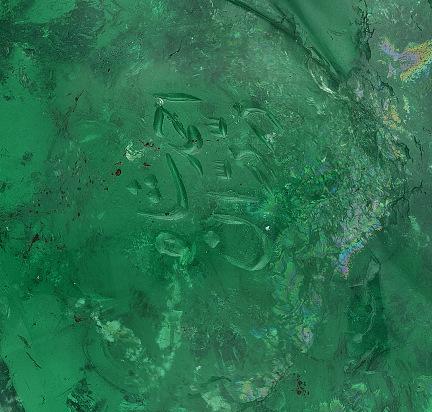

Ahmad Shah Durr-i Durran (Pearl of Pearls) (enlarged detail)
(reverse of center emerald of Lot 41)
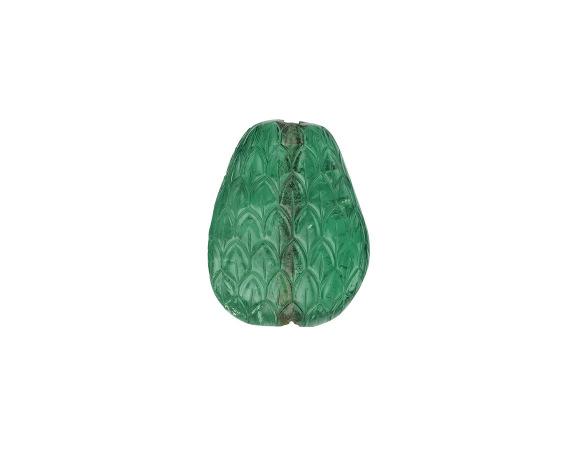




(illustrated unmounted, weights are approximate)
470.00 carats
294.00 carats
199.50 carats
106.50 carats
108.50 carats
A
Mughal Multi-Gem and Emerald Necklace


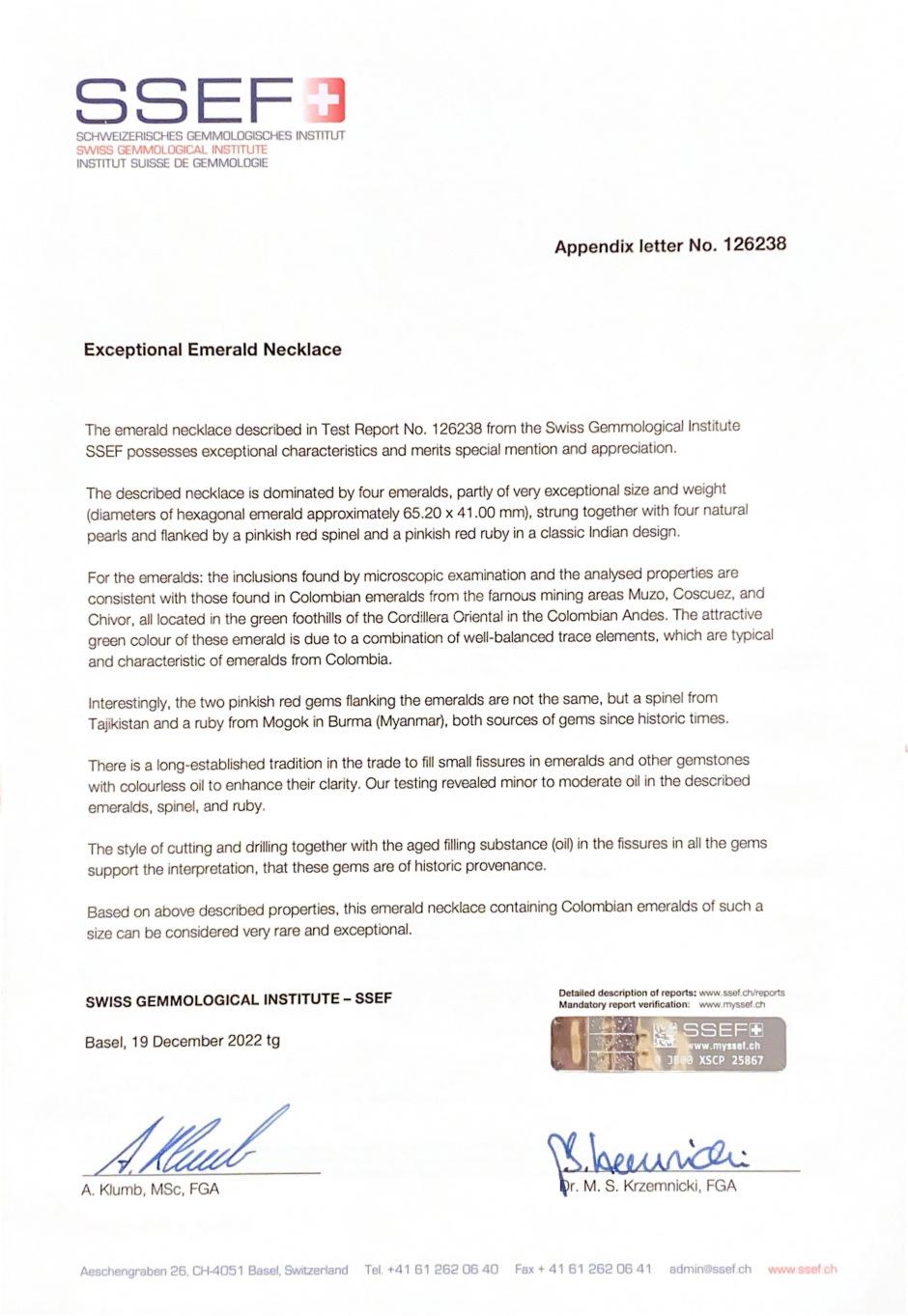

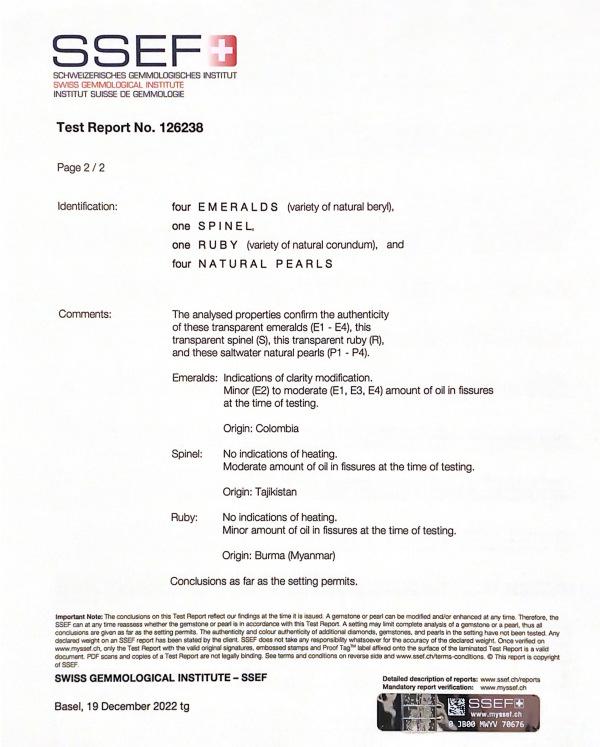
A MUGHAL MULTI-GEM AND EMERALD NECKLACE
Centering upon a hexagonal and drop-shaped emerald of approximately 297.00 carats total, two baroque-shaped emeralds, baroque drop-shaped spinel bead, baroque ruby bead, baroque natural pearls of 14.20 to 11.60 mm, circa 1750, gold, later added magenta and green cord
SSEF, 2022, report no. 126238: Emeralds: Colombia, indications of clarity modification, minor (E2) to moderate (E1, E3, E4) amount of oil in fissures at time of testing, Spinel: Tajikistan, no indications of heating, moderate amount of oil in fissures at the time of testing, Ruby: Burma, no indications of heating, minor amount of oil in fissures at the time of testing, Pearls: natural pearls, saltwater, with appendix letter regarding this Exceptional Emerald Strand
Size/Dimensions: spinel to ruby panel 22.8 cm (9 in); cord 53.3 cm (21 in)
Gross Weight: 163.2 grams
$2,000,000-3,000,000
SHOULD YOU WISH TO BID ON THIS LOT, YOU WILL BE REQUIRED TO OBTAIN A HIGH VALUE PADDLE.
Please note the emeralds strung on either side of the center panel weigh approximately 255.00 and 246.00 carats. Refer to diagram.
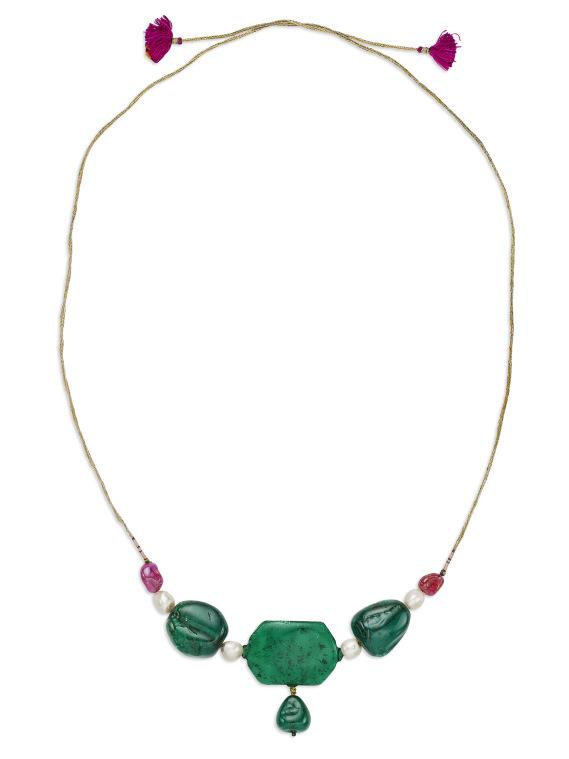
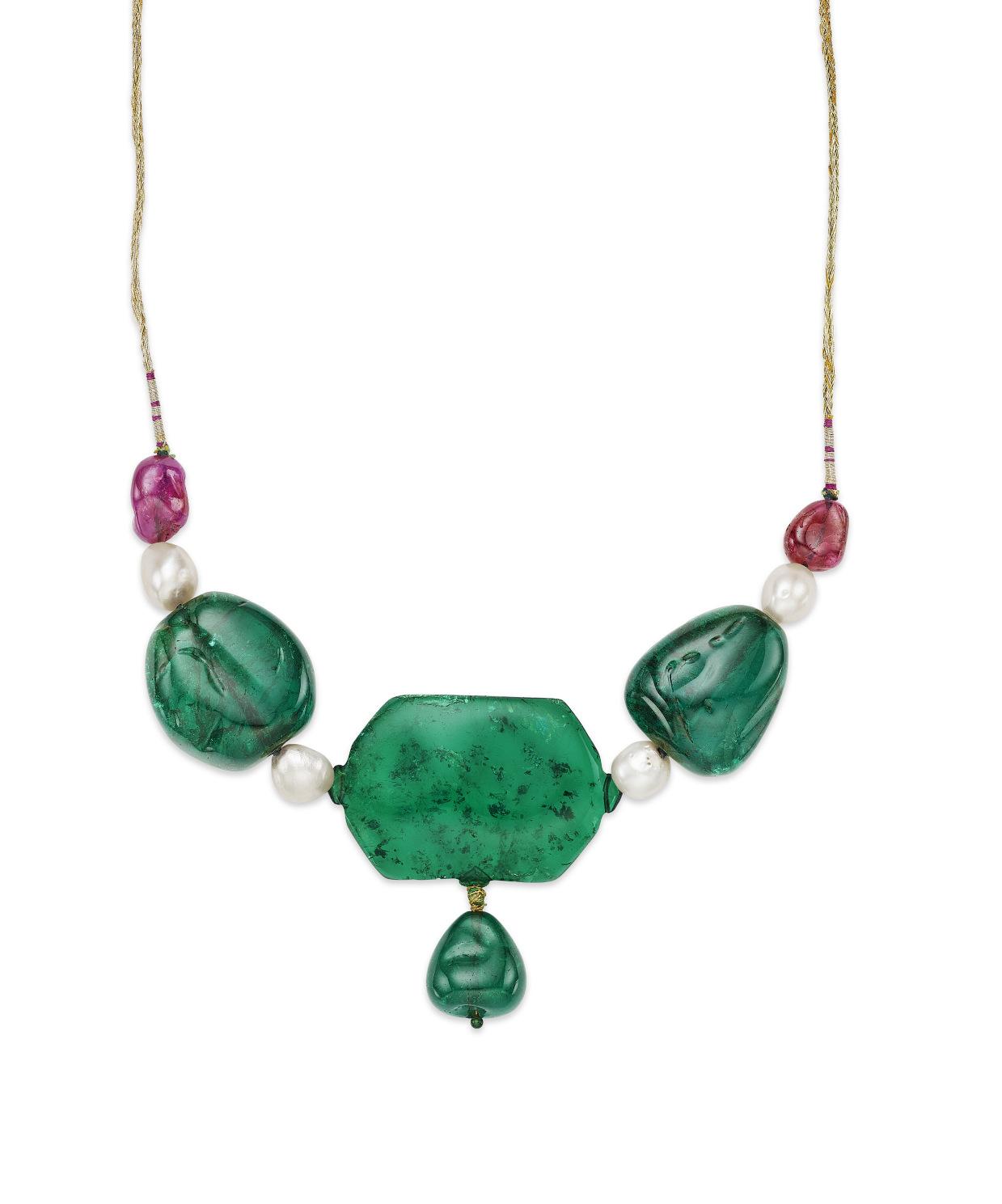
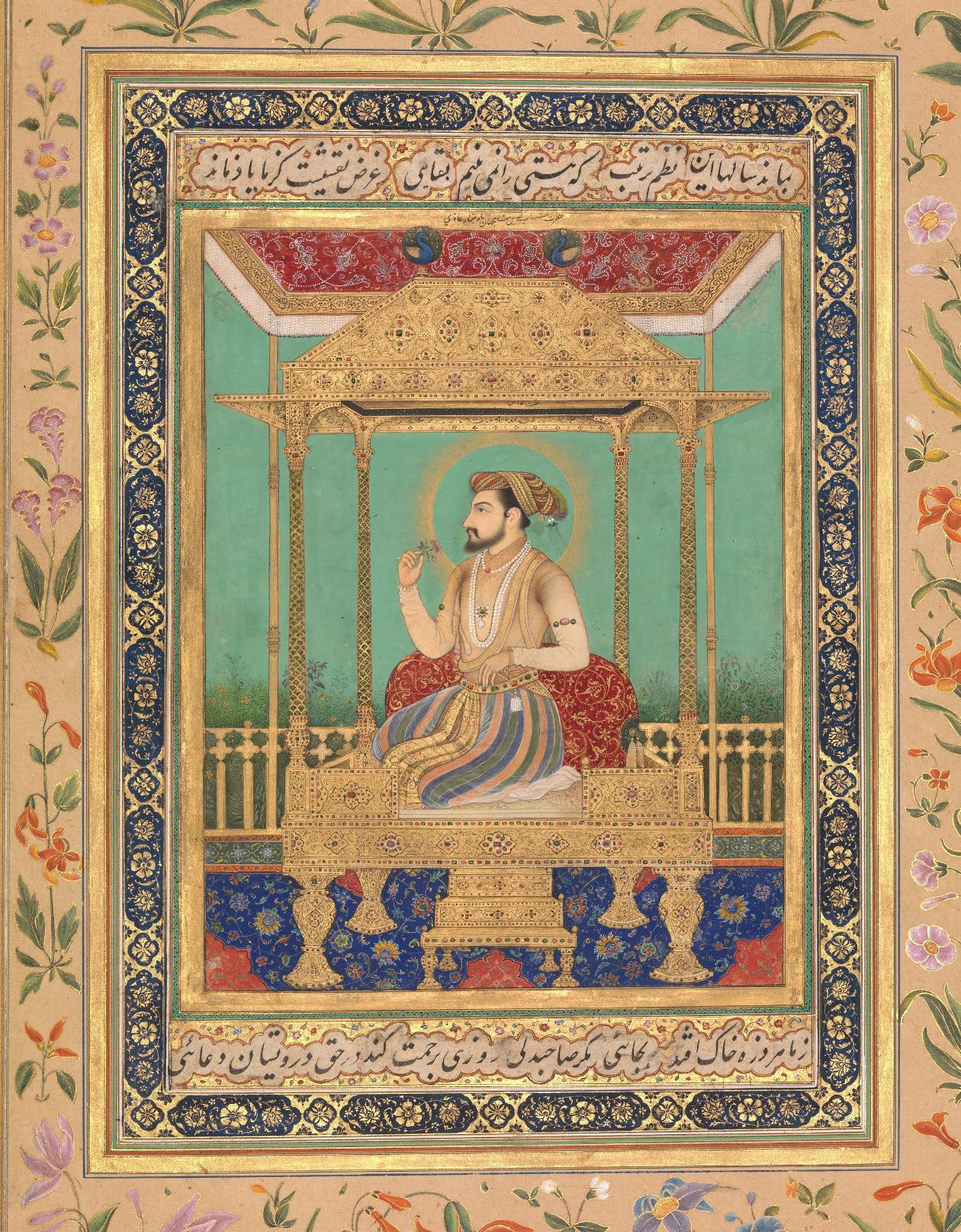
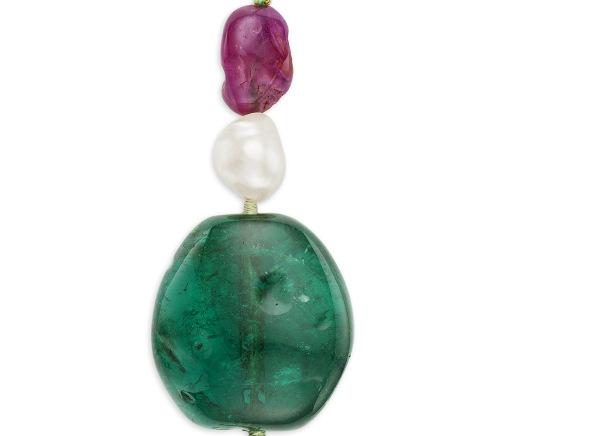
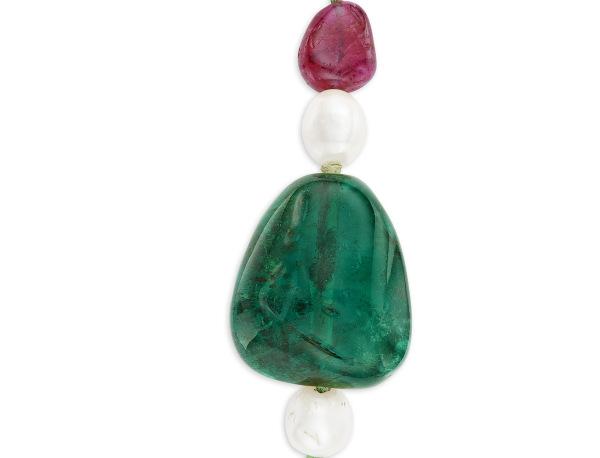

297.00 carats (both)
255.00 carats (segment above)
246.00 carats (segment above)
Opposite: Portrait of Shah Jahan on the Peacock Throne, 19th century
Courtesy of The Metropolitan Museum of Art
(illustrated unmounted, weights are approximate)


A Mughal Three Strand Spinel and Natural Pearl Necklace
Exceptional Spinels Sold at Auction
Previously sold at Christie’s

Estimate: USD 1,651,191-2,733,006
Sold: USD 5,214,348
AN IMPERIAL MUGHAL SPINEL NECKLACE
Christie’s, Geneva, 2011
Exceptional Spinels Sold at Auction Previously sold at Christie’s

Estimate: USD 1,000,000-2,000,000
Sold: USD 3,015,000
AN ANTIQUE IMPERIAL SPINEL, PEARL AND EMERALD NECKLACE
Christie’s, New York, Maharajas & Mughal Magnificence, 2019
Upper Strand
Jahangir Shah (son) of Akbar Shah, 1022
Second inscription: Second Lord of the Auspicious Conjunction, 1045 / 8



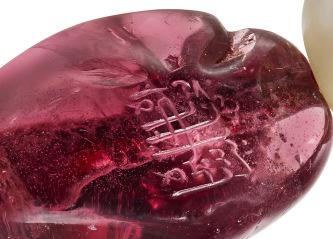
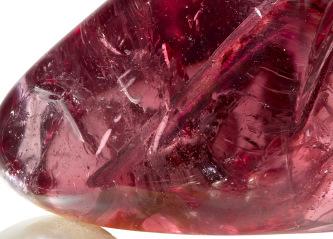
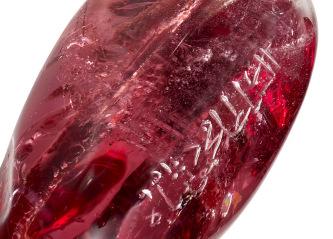

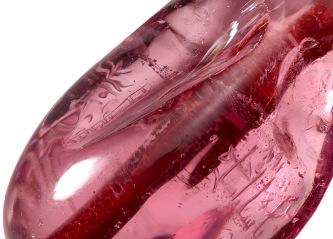

Second

Middle Strand
Babur Shah Badshah, 891
Jahangir Shah (son) of Akbar Shah, 1017
Unclear inscription
The Sultan Mahmud Shah, 951(*)
Jahangir Shah (son) of Akbar Shah
Lower Strand
Jahangir Shah (son) of Akbar Shah, 1017(*)
inscription: Second Lord of the Auspicious Conjunction
The Sultan Muhammad Tuqhluq
Devanagari inscription
Magnificent Mughal Inscribed Spinels
Uncut and devoid of a complex setting, large gems were highly prized by the Mughals. They were inscribed to establish ownership and handed down from generation to generation.
For centuries rulers of the Mughal empire venerated precious stones of the highest caliber. Portrayed in historical Mughal imagery, Emperors adorned themselves with countless strands of pearl necklaces that featured richly saturated spinels and emeralds. Not only was the desire to ornament because these rulers had a true appreciation for jewelry rooted in tradition, but they deliberately chose magnificent jewelry set with top quality gemstones as a means of showcasing their status and power.
With no expense spared, special officials were commissioned to search for these spectacular-colored stones. Often inscribed with the name and titles of the rulers of the time, only those with the best color, clarity and size were chosen to carefully record history. The Timurids, ancestors of the Mughals, had begun the tradition of inscribing titles and names on stones of such outstanding quality, and large spinel beads were certainly their favorite. As much as these gems were a symbol of the opulence and dignity of the empire, they were also treasured as protective talismans.
Inscribing a gemstone with an emperor's name with lineage and dates was a mark of appreciation for the exceptional beauty of the stone, and bestowed on it respect and imperial dignity. In some examples where more than one inscription is noted, it is suggested that the stone was passed down through generations.
One famous example of a historical spinel is the Carew Spinel, which is housed in the Victoria and Albert Museum. Prized for its color and history, the Carew Spinel is inscribed with the names of Jahangir, Shah Jahan and Alamgir, also known as the former Mughal Prince Aurangezb. These spinels originated from the Badakhshan mine, in the 'Pamir' region located between Afghanistan and Tajikistan. This province gave its derived name to spinels, described as “Balas Rubies” for decades. Later in the 19th century it would be determined that spinels and rubies are chemically two different gems, but for hundreds of years, any red stone was described as a ruby. Another famous historical inscribed spinel is the “Timur Ruby” which is indeed a spinel. Residing in England like the Carew Spinel, the Timur Ruby is part of the illustrious Royal Collection of HM Queen Elizabeth II of England.
This three-strand spinel and pearl necklace is incredible example from the Mughal dynasty. 8 out of the 45 polished spinel beads feature names of important rulers including Babur Shah Badshah, Jahangir Shah, The Sultan Mahmud Shah, and The Sultan Muhammad Tuqhluq.
Equally as important as the ruler whose name was to be inscribed, was the position of the planets on the day the stone was set to be inscribed. Astrological factors correlated directly with this detailed practice, as these enchanting stones were believed to have spiritual and protective properties.
The Mughal Dynasty was founded by Babur in the 15th Century. He was a direct descendent of Timur, and Chagatai who was the second son of the notable Mongol ruler, Genghis Khan. Inscribed on one bead is his name “Babur Shah Badshah”. Known for his military strategies and autobiography, the Baburnama which details the events of his life, Babur laid the foundation for one of the most powerful empires in Indian history. The same bead shares another inscription written in Devanagari, which is a script used to write many languages of the time.
The third Mughal emperor, Akbar the Great (1542-1605), also collected highly coveted spinels, most notably wearing them directly on the skin for their protective qualities. His son, Emperor Jahangir (1569-1627), followed suit as a wonderful connoisseur of gems. Jahangir Shah, also known as Emperor Jahangir, is inscribed into history in a bead on the necklace as well. Carefully inscribed the bead reads “Jahangir Shah (son) of Akbar Shah” with the second inscription of the bead reading “Second lord of the Auspicious Conjunction”. He was the fourth ruler of the Mughal empire who reigned from 1605 to 1627. History notes he was patron of the arts, so it is no surprise that he followed his father as a wonderful connoisseur of gems. Emperor Jahangir’s reign is marked by advancements in the arts and governing styles versus military achievements. His name is also inscribed on a few other beads located on the necklace.
His deep appreciation and passion for collecting important gemstones was continued by his son, Shah Jahan (1592-1666). Shah Jahan is best known for constructing the monumental Taj Mahal at Agra, one of the most magnificent architectural wonders in the world.
Predecessors to those rulers above, “The Sultan Mahmud Shah” inscribed on one bead as well – this name possibly referring to Sultan Mahmud Shah III of Gujarat. He was a ruler of the Gujarate Sultanate in the early 16th Century. Nestled in the necklace sits a bead inscribed “The Sultan Muhammad Tuqhluq”. Likely this refers to the Sultan of Delhi Muhammad Tughluq, who was the ruler of the Delhi Sultanate in the 14th Century.
Found between the three strands of alternating pearls and spinel beads sits a rich cultural history, documented with the honor and prestige one can only expect from the Mughal empire. This necklace presents an exceedingly rare opportunity to acquire a jewel of such historical provenance directly offered from a royal collection.
Rulers Present in Lot 43’s Spinel Inscriptions
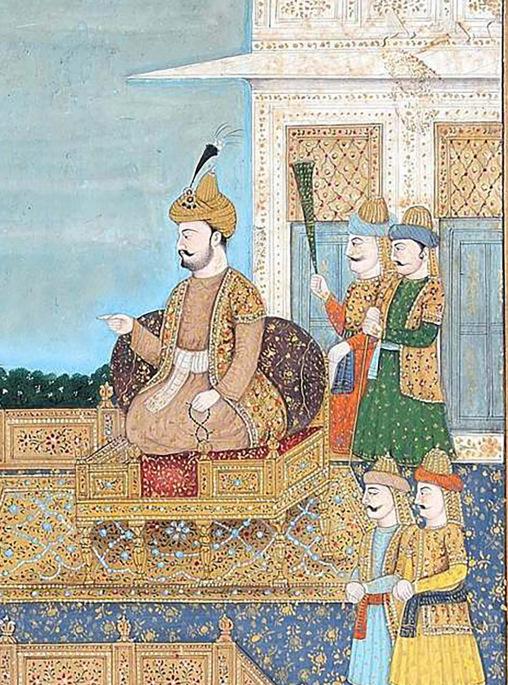

Muhammad bin Tughluq Sultan of Delhi (r. 725-752 A.H. / 1325-1351 A.D.)
Babur Shah Badshah First Mughal Emperor (r. 932-836 A.H. / 1526-1540 A.D.)
Painting depicting the court of Muhammad bin Tughluq, circa 19th century
Portrait of Mughal Emperor Babur, circa 1605-1615
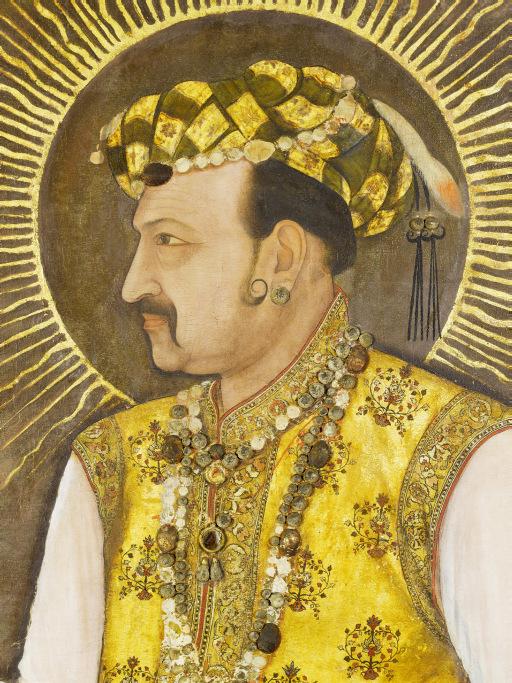
Jahangir Shah
Fourth Mughal Emperor (r. 1014-1037 A.H. / 1605-1627 A.D.)
Portrait of Jahangir Shah, 1617, by Abu al-Hasan
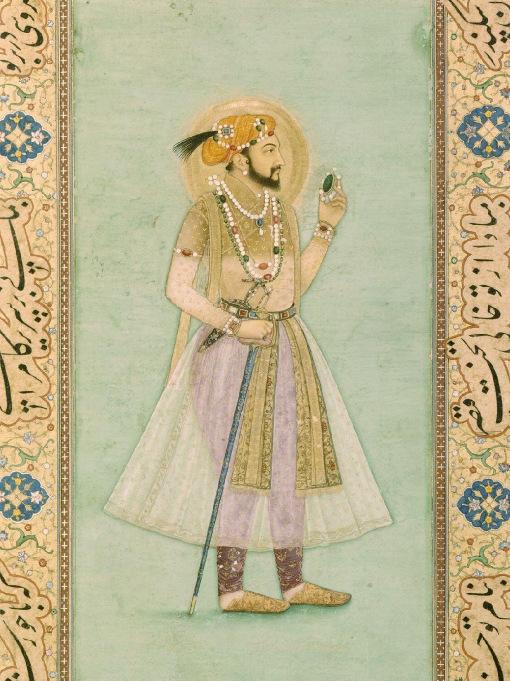
Shah Jahan
Fifth Mughal Emperor (r. 1037-1068 A.H. / 1628-1658)
Shah Jahan holding an emerald, 1628 - 1629, by Mohammad Abed


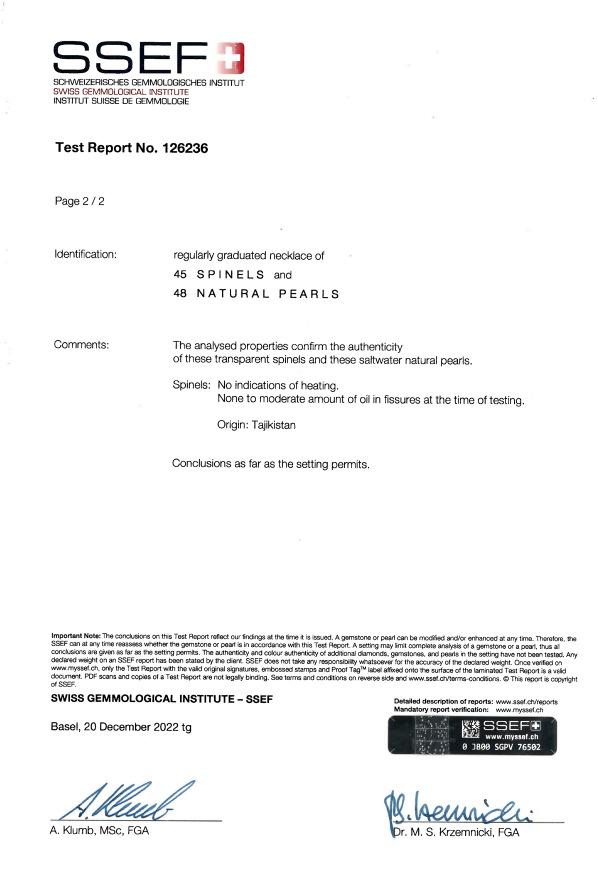

SHOULD YOU WISH TO BID ON THIS LOT, YOU WILL BE REQUIRED TO OBTAIN A HIGH VALUE PADDLE.
Please note the spinels weigh approximately a total of 2,000.00 - 2,500.00 carats.
Please note (*) indicates a not entirely clear date in the inscription.
LEARN MORE
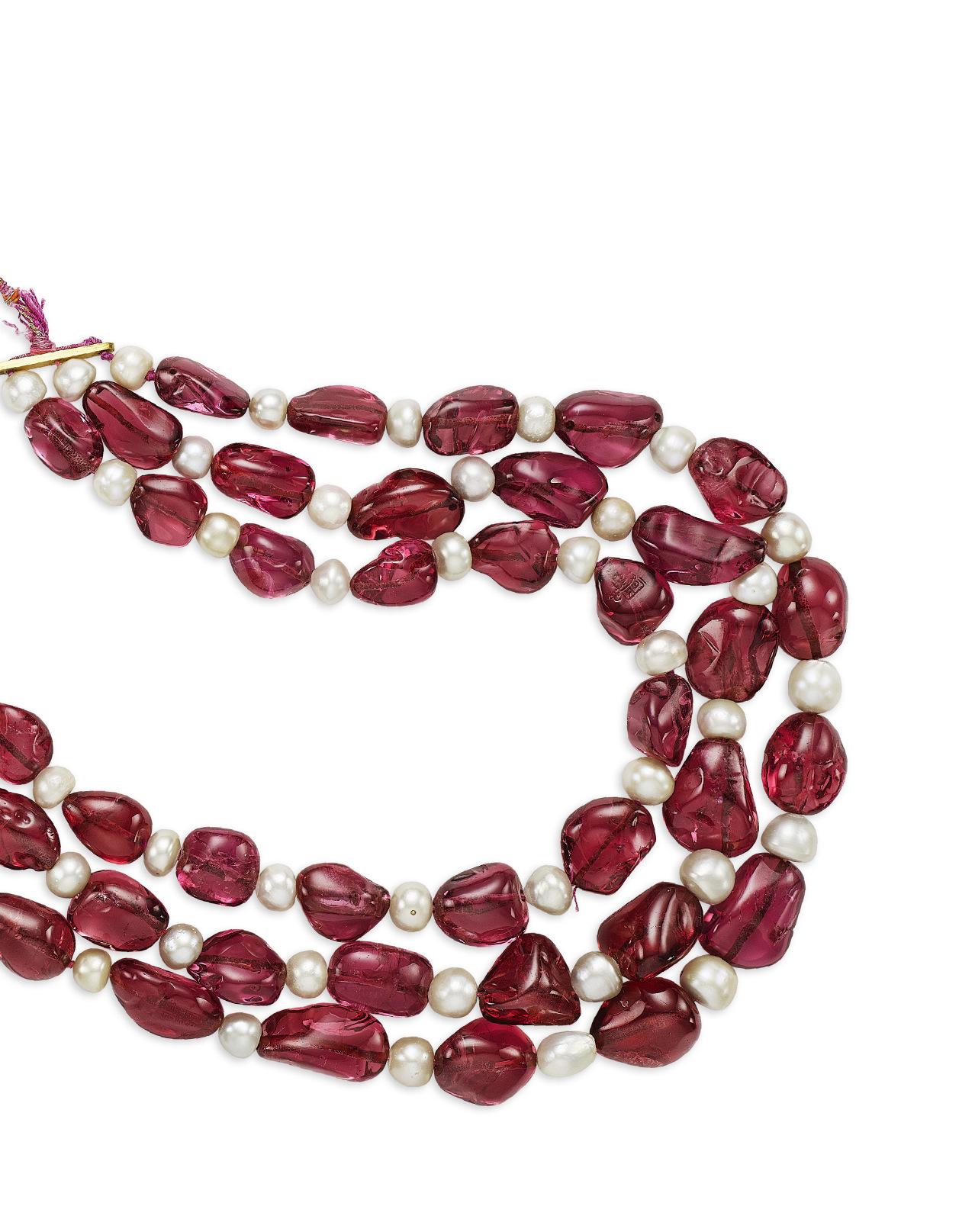

The Marie-Thérèse Pink Diamond
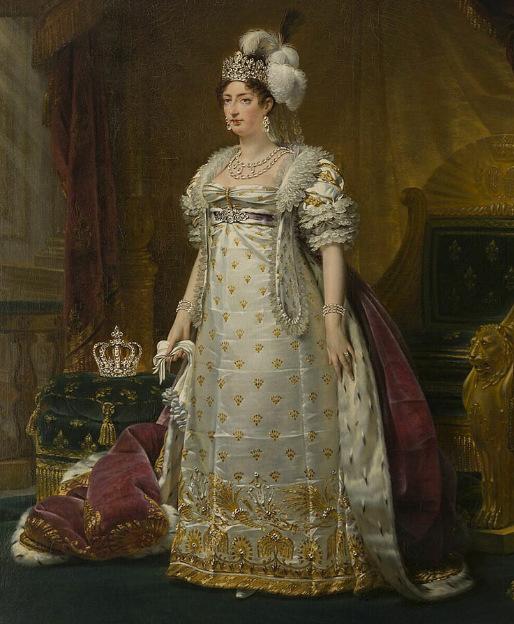
Marie Antoinette, the last queen of France before the French Revolution, remains as one of the most notable figures of 18th century European royalty. Among the many symbols of her lavish lifestyle, her collection of jewels has captured the fascination of historians, collectors, and admirers for centuries. These gems were not only adornments, but emblems of her status and aesthetic taste.
Born an Austrian archduchess in 1755, Marie Antoinette married Louis-Auguste, the future Louis XVI of France at the age of fourteen to reinforce the alliance between Austria and France. Plunged into the opulent world of the French court at Versailles, she became queen in
1774 and quickly gained a reputation for extravagance. Her love for fashion, design and jewelry was both a reflection of courtly traditions and a personal indulgence. As queen, she had access to the crown jewels of France, but she also commissioned new pieces to suit her own taste, crafted by the best Parisian jewelers.
Marie Antoinette had an exceptional eye for beauty and fascination with rare stones. Her collection was filled with pearls, diamonds, and colored gemstones from around the world; each one carefully chosen not just for its value, but for its elegance, and uniqueness. These pieces showcased not only her wealth but also the artistic excellence of the time.
Just before her dramatic escape attempt from Paris, the infamous Flight to Varennes, Queen Marie Antoinette gathered her most precious jewels and entrusted them not to a guard or noble, but to her trusted coiffeur, hoping that one day, she would be reunited…but history had other plans.
Following the fall of the monarchy and the tragic demise of the royal family, the jewels were entrusted to their sole surviving heir, Duchess Marie-Thérèse d’Angoulême. With no heirs of her own, she passed the legacy to her niece, Duchess Marie-Thérèse de Chambord. And then, years later, a note in a will revealed the diamond’s owner: Queen Marie Theresa of Bavaria with the jewel described as “a pink solitaire diamond from Aunt Chambord.”
The kite-shaped fancy purple pink diamond weighing 10.38 carats dates back to the mid-18th century, and should most likely also be of Golconda origin, one of the most prized origins in the world revered for their outstanding gemological qualities. While an exact record has not yet been found, this 10.38 carat diamond may have been part of Marie Antoinette’s original inventory before passing through the hands of her direct descendants.
Currently mounted in an elegant setting fit for a queen by Parisian jeweler, JAR, The Marie-Thérèse Pink Diamond is also accompanied by a velvet case revealing a hairpin mounting bearing a faded Austrian Imperial Warrant, likely commissioned by Duchess Marie-Thérèse de Chambord in 1868. This lot is not merely a jewel, but a tangible treasure from royal history.
Above: Marie-Thérèse Charlotte de France, Duchesse d’Angoulême, 1816 - 1817, by Antoine-Jean Gros (1771 - 1835)

The enduring fascination with Marie Antoinette lies not only in the opulence and spectacle of her reign, nor solely in the dramatic arc of her rise and tragic fall, but also in the persistent enigma that surrounds her legacy.
Central to this mystique is the lore of her possessions – specifically her jewels. Archival records, including those dating back to the 17th-century gem merchant Jean-Baptiste Tavernier, are often difficult to decipher having been written in an era predating the modern standardization of gemstone classification and such descriptions render the task of definitively tracing the provenance of these stones a complex and often speculative endeavor.
This veil of uncertainty only deepens the allure, transforming historical inquiry into a tantalizing pursuit through the shadows of the past.
We are honored to have further perspective of this historic diamond from the research of Vincent Meylan, renowned author and historian:
Marie-Antoinette’s jewelry collection was sent in March 1791 to Brussels to Count Mercy d’Argentau (1727-1794) who had been her mentor as Austrian ambassador to the court of Versailles. The destiny of the jewels and the list of the jewels are described in the presentation of the diamond bracelets sold at Christie’s in Geneva in 2021.
Marie Antoinette’s jewels were indeed given to her daughter when she was freed from the Temple Prison and sent to Austria at the end of 1795. She spent three years in Vienna and then, she went to Mittau in Kurland, now Latvia, to marry her cousin, the Duke of Angoulême (1775-1844) and came back to France in 1814 or 1815 after the fall of Napoléon.
As first lady from 1815 to 1830, she was accustomed to wearing the crown jewels and most frequently, a magnificent diamond tiara.
In 1824, she asked permission, from her uncle, King Louis XVIII (1755-1824), to keep the crown diamonds and tiara in her private collection. As this was state property, it was impossible for the Duchess to retain the items.
Thereafter, King Louis XVIII, decided to buy 333,000 francs of diamonds from Bapst to replace the crown diamonds on the frame of the tiara for his niece. This list of 200 diamonds is detailed in the invoice from Bapst (Bibliothèque Nationale Paris). The largest diamond (13.70/32 carats) was valued at 50,000 francs. The second largest (10.24/32 carats) was valued as 30,000 francs and it is very
Queen Marie Antoinette of France and Two of Her Children Walking in the Park of Trianon, 1785, by Adolf Ulrik Wertmüller (1751-1811)
Marie Antoinette with two of her children, Marie-Thérèse Charlotte and the Dauphin Louis Joseph
likely that this diamond is the same as the 10.38 carat stone. The difference of carat weight between old and new carats is always taken into consideration when reviewing historical documents, hence the possible discrepancy.
The crown diamonds were returned to the treasury and the diamonds purchased by Louis XVIII were set in the tiara frame for Duchess d’Angoulême (1778-1851) to keep in her personal collection.
When the Duchess d’Angoulême died in exile, her jewels were divided in three lots:
• One third (the bracelets) to her niece the Duchess of Parma (1814-1847)
• One third (the tiara) to her nephew the Count de Chambord (1820-1883)
• One third (necklace and earrings) to the Countess de Chambord (1817-1886)
In 1883, when the Count de Chambord passed away, he left to his wife the Chateau de Frohsdorf and the “diamond tiara he had received as his third of the Duchess d’Angoulême diamond collection”. The will is in the Vienna archives and the tiara is mentioned. It should be noted that the Countess de Chambord already aquired a large jewelry collection from her parents, the Duke and Duchess of Modena as well.
In 1886, when the Countess de Chambord died she left her diamond necklace and earrings (from the Duchess d’Angoulême and Queen Marie Antoinette) to her niece the Duchess de Madrid. The Marie Antoinette provenance for these two pieces is mentioned in the will.
Then she explains in the same will that she had decided to dismount the diamond tiara left to her by her husband, to use the stones as wedding presents to three of her nephews and nieces. The Queen of Bavaria received three diamond rivières and two large diamonds. One of them, given by the Count de Chambord to his wife, could be the 10.24/32 carat diamond from the Duchess d’Angoulême tiara.
The diamond mounted a hair pin is likely the one left to the Queen of Bavaria by her Aunt Chambord. It was sold by descendants of the Queen of Bavaria in Geneva in November 1996. The Marie Antoinette provenance is mentioned as a “family tradition” but that stone is more than likely the second largest from the tiara given by King Louis XVIII in 1824 to his niece, the Duchess d’Angoulême.
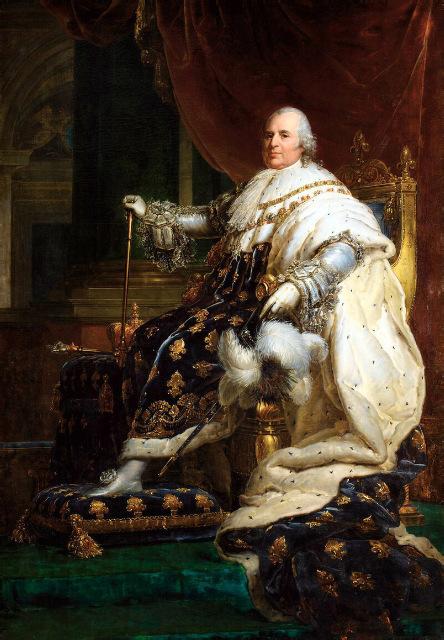
Coronation portrait of Louis XVIII, 1814, by François Gérard (1770-1837)
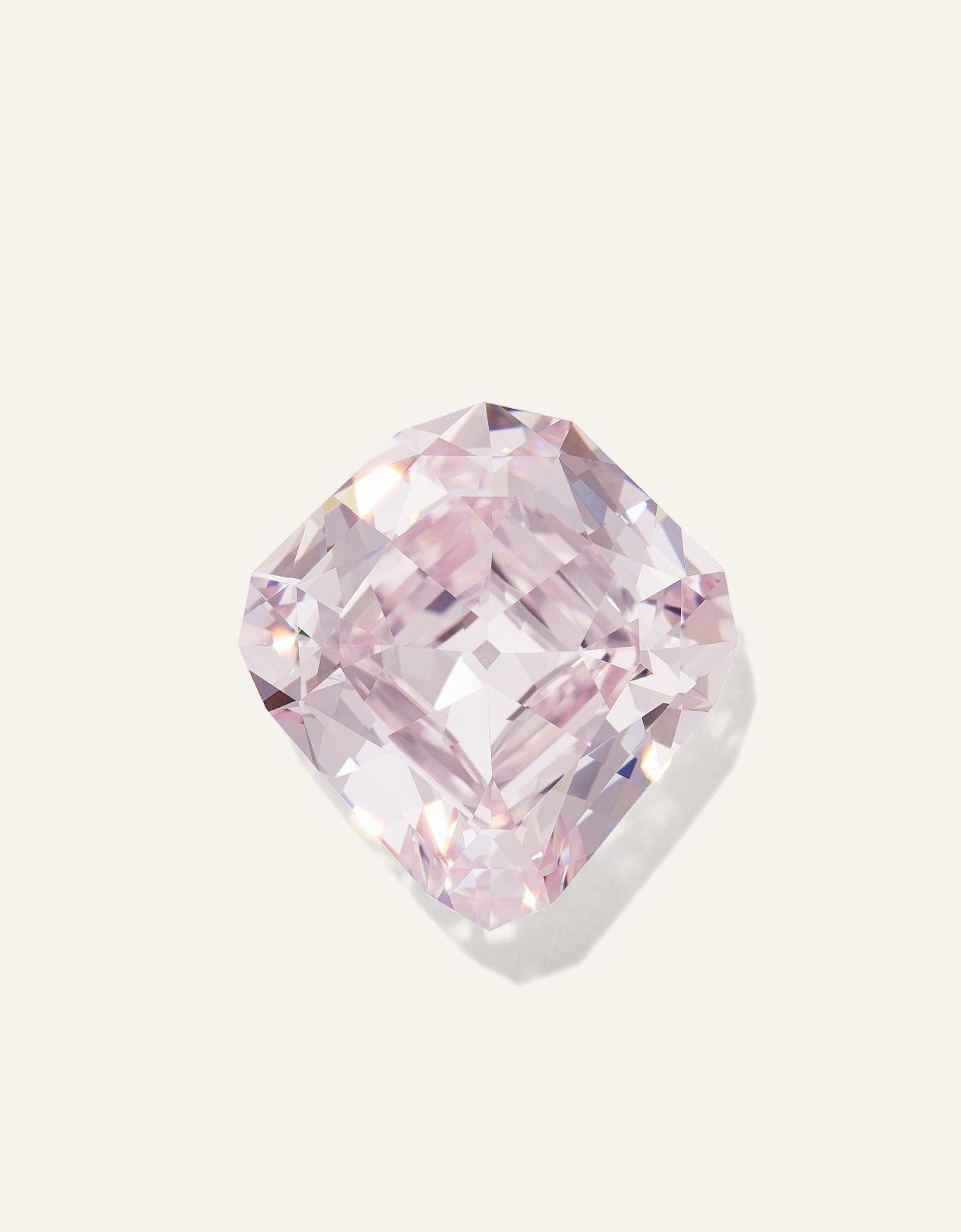
(illustrated in hairpin setting)
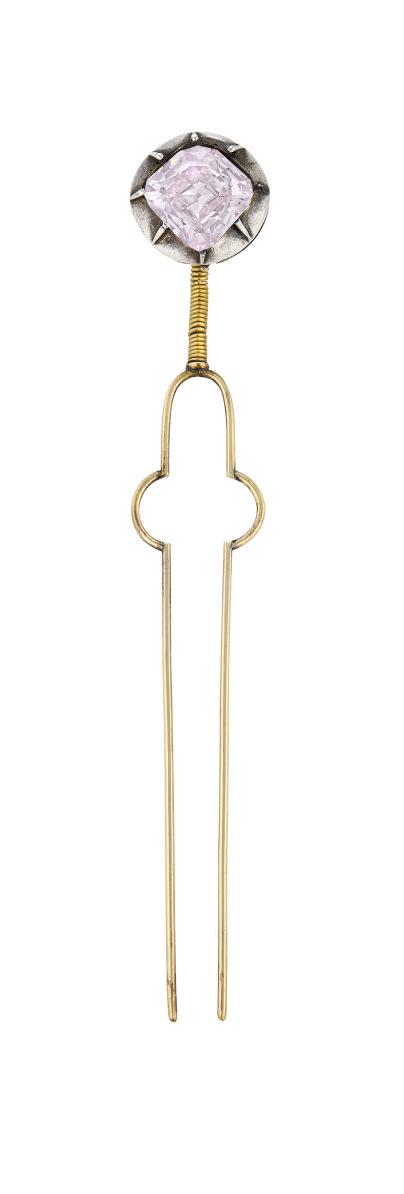
The purple-pink color in diamonds is caused primarily by distortions in the diamond’s crystal lattice that occur during its formation under extreme pressure deep within the Earth. When additional factors such as trace amounts of hydrogen or boron are present, a purplish tone can emerge, creating the rare and highly prized purple-pink coloration.
With limited sources of fancy purple-pink diamonds available to collectors, these diamonds remain exceptionally scarce and valuable.



A HISTORIC JAR COLORED DIAMOND RING
Fancy purple-pink modified kite brilliant-cut diamond of 10.38 carats, round diamonds, blackened platinum, unsigned, pink JAR case, accompanied by a gold and silver hairpin, circa likely 1868, pink JAR ring case and fitted purple hairpin case
GIA, 2025, report no. 10064909: 10.38 carats, Fancy Purple-Pink, natural color, SI1 clarity
Size/Dimensions: US ring size 5º; hairpin 12.7 cm (5 in)
Gross Weight: 15.5 grams
$3,000,000-5,000,000
PROVENANCE:
Queen Marie Antoinette of France, Archduchess of Austria (1755-1793), by repute
Duchess Marie-Thérèse d’Angoulême (1778-1851), later Countess de Marnes, her daughter
Duchess Marie-Thérèse de Chambord, Archduchess of Austria (1817-1886), her niece
Queen Maria Theresa of Bavaria, Archduchess of Austria-Este (1849-1919), her niece
Thence by descent
Sotheby's, Geneva, 20 November 1996, Sale GE0195, Lot 535
SHOULD YOU WISH TO BID ON THIS LOT, YOU WILL BE REQUIRED TO OBTAIN A HIGH VALUE PADDLE.

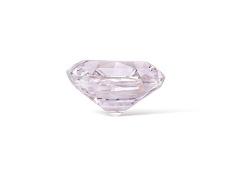
unmounted)
(three views)
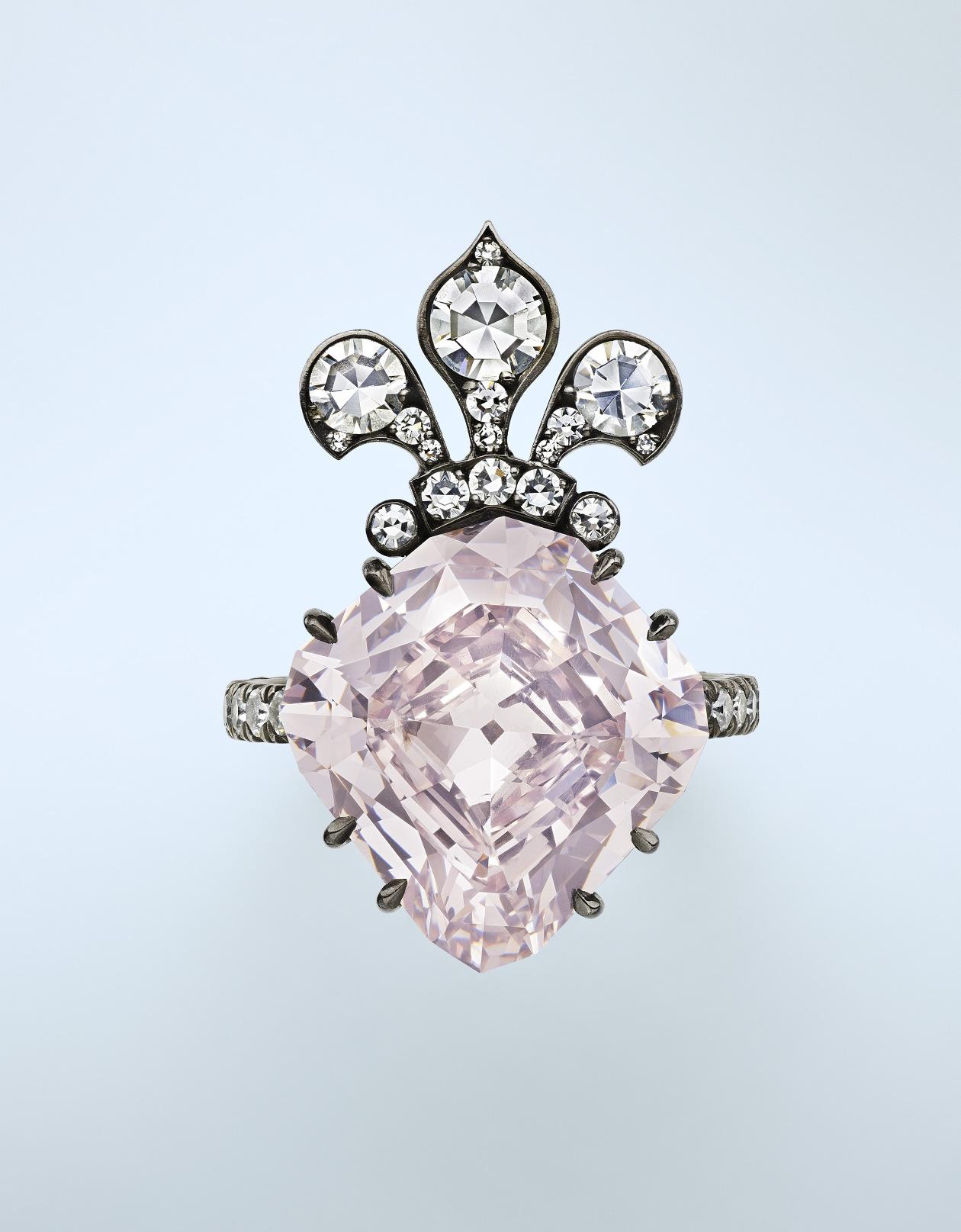
Van Cleef & Arpels ‘Hawaii’ Jewelry
Drawing inspiration from the lush tropical landscapes of the Pacific, the ‘Hawaii’ collection by Van Cleef & Arpels is often described as one of the most iconic creations of the Maison. Introduced in 1938 and later presented at the New York World’s Fair in 1939, the collection is characterized by delicate clusters of vibrant floral motifs accented by colorful rubies, sapphires and diamonds. The red, blue and white hues of the blossoms were reminiscent of the Allied flags, serving as a visual metaphor for harmony and resilience during the post-war era. The collection gained increasing popularity after World War II, largely regarded as an emblem of ‘freedom-at-last.’
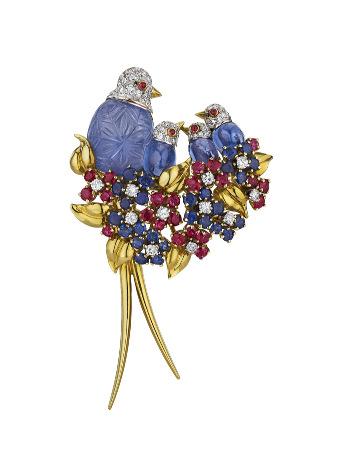
In addition to the floral motifs, some of the ‘Hawaii’ jewels incorporated the lovebird motif – a theme that emerged in Van Cleef & Arpels’ design in 1944 as a symbol of fidelity in love and devotion. Lovebirds of varying numbers, ranging from a pair to a brood of four, were presented along with tri-colored flowers in brooches and clips, altogether suggesting the ideas of enduring companionship and unity. Examples that appeared after 1945, such as the clip-brooch of Lot 45, often utilized cabochon gemstones to illustrate abstracted silhouettes of the bodies of birds – a choice of material that was rarely made until then.
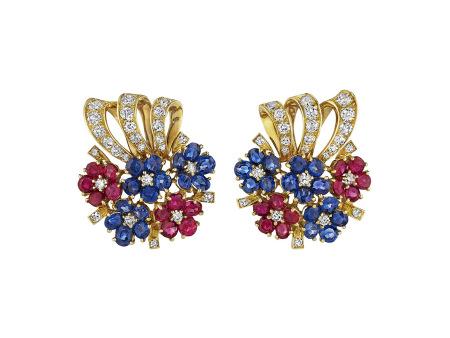
VAN CLEEF & ARPELS SET OF RUBY, SAPPHIRE AND DIAMOND 'HAWAII' JEWELRY
Round ruby cabochons, carved sapphire cabochon and oval sapphire cabochons, round rubies and sapphires, round, old and single-cut diamonds, yellow gold and platinum, circa 1950, each signed Van Cleef & Arpels, N.Y., each numbered
Size/Dimensions: clip-brooch 5.6 x 3.8 cm (2º x 1Ω in); earrings 2.7 x 2.3 cm (1 x √ in)
Gross Weight: 36.8 grams
$30,000-50,000
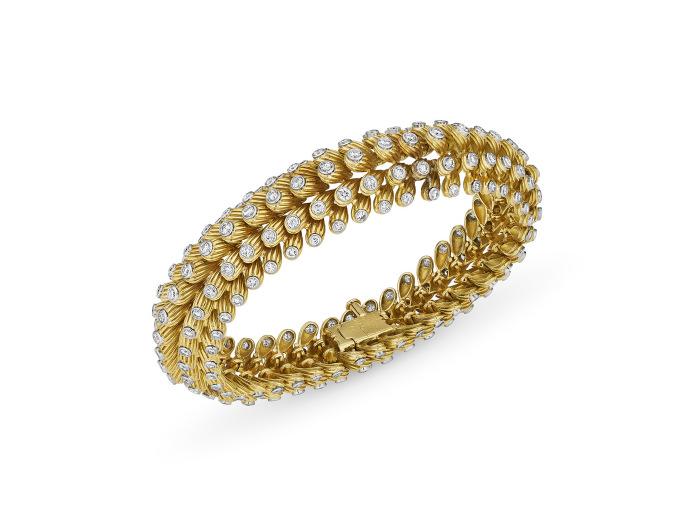
Round diamonds, fluted 18k yellow gold and platinum (French marks, partially indistinct), circa 1950, signed V.C.A, New York, Made in France, numbered
Size/Dimensions: 17.8 x 1.6 cm (7 x ¬ in)
Gross Weight: 74.5 grams
$40,000-60,000
VAN CLEEF & ARPELS DIAMOND BRACELET
LEARN MORE
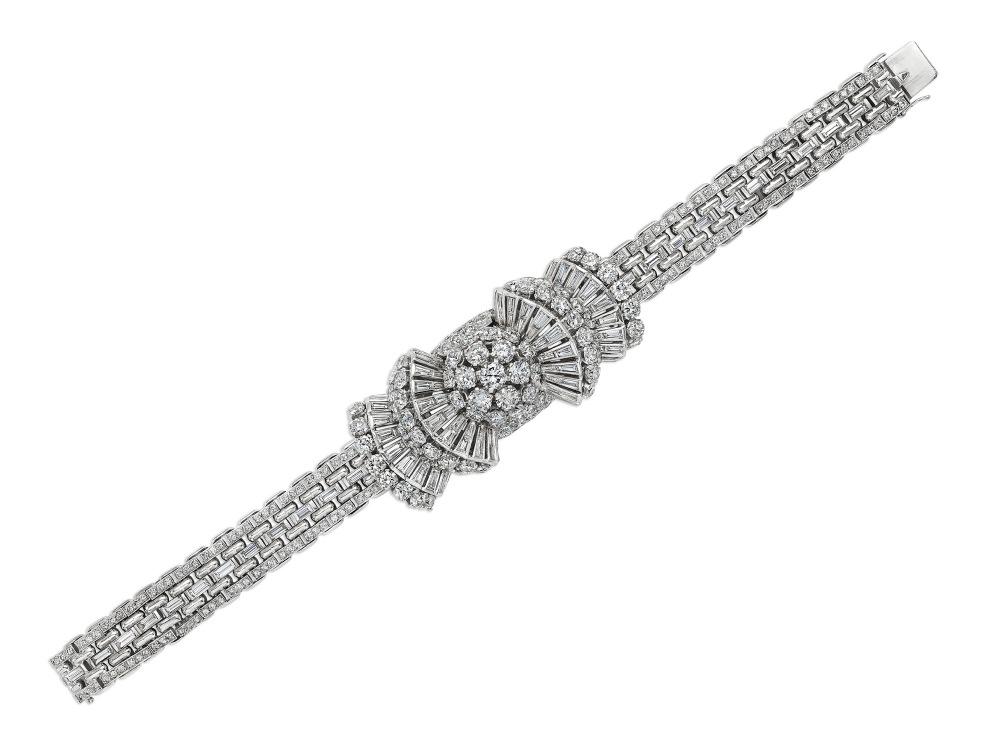

(concealed dial)
BULGARI DIAMOND BRACELET-WATCH
The center opening to reveal a circular watch, manual-winding movement, round, baguette and tapered-baguette diamonds, round rubies, platinum and white gold, circa 1955, case signed Bulgari, numbered, movement and dial signed Movado, please note the movement is not in working order and a service is recommended
Size/Dimensions: case diameter 25.0 x 55.0 mm, bracelet length 17.7 cm (7 in)
Gross Weight: 90.8 grams $50,000-70,000
PROVENANCE: Christie's, New York, 9 April 1997, Sale 8618, Lot 356
LEARN MORE

VAN CLEEF & ARPELS DIAMOND BROOCH
Pear, marquise, baguette, tapered baguette and round diamonds, platinum, circa 1955, signed VCA, numbered, white Van Cleef & Arpels outer box, green Van Cleef & Arpels pouch
Size/Dimensions: 8.8 x 3.4 cm (3Ω x 1¡ in)
Gross Weight: 35.0 grams
$40,000-60,000 LEARN

Susan Hayward
Hollywood’s golden age dazzled with legends whose legacies still endure today. Among them was Susan Hayward (1917-1975), a remarkable actress renown for her portrayals of courageous women fighting to overcome adversity.
Hayward’s path to stardom began in 1937 when she traveled from Brooklyn to Hollywood to audition for the role of Scarlett O’Hara in Gone with the Wind (1939). Although she didn’t land the part due to her limited experience, her charisma caught the attention of talent agents. This moment marked the beginning of her 35-year career that would encompass 58 films, numerous accolades and a place in cinematic history.
Initially cast in uncredited roles, Hayward gradually developed her filmography until earning her first credited part in Girls on Probation (1938), alongside Ronald Reagan. From there, she appeared in a series of successful films such as Adam Had Four Sons (1941), Reap the Wild Wind (1942) and Deadline at Dawn (1946). In every role she took on, she never failed to highlight her unconventional acting style – gritty and emotionally raw.
Her success came to fruition with her Academy Award nomination for Smash-Up: The Story of a Woman (1947), where she portrayed a nightclub singer who spirals into alcoholism after sacrificing her career for her husband. She received another nomination for her leading role in My Foolish Heart (1949).
Such achievements paved the way for the 1950s – a decade that marked the peak of her career. In I’ll Cry Tomorrow (1955), she played troubled Broadway star Lillian Roth, delivering an iconic performance that won her Best Actress at the Cannes Film Festival and yet another Academy Award nomination. Her ultimate triumph came in I want to Live (1958), in which she portrayed Barbara Graham, a woman convicted of murder and executed in the gas chamber – a powerful role that finally earned her the long-overdue Oscar.
Outside the studio, Hayward maintained a refined and glamorous style. She was known for her love of jewelry, with a particular affinity for classic designs from the 1950s and 60s, exemplified by Lot 49, the Van Cleef & Arpels turquoise and diamond suite. The pieces in the suite combined vivid colors with timeless elegance, offering us a glimpse into the bygone era of Hollywood glamour. Hayward proudly showcased them at galas and high-profile public appearances, most famously wearing the pieces at an Emmy presentation at the Palladium and an event at the Century Plaza Ballroom, from the late 1960s into her later years. The necklace, in particular, could be transformed into a bracelet to add an additional element to the suite, demonstrating the versatility and craftsmanship of the design, representative of the era’s refined elegance.
Susan Hayward wearing lot 49, circa 1968-1969 © Gary Lewis / mptvimages.com

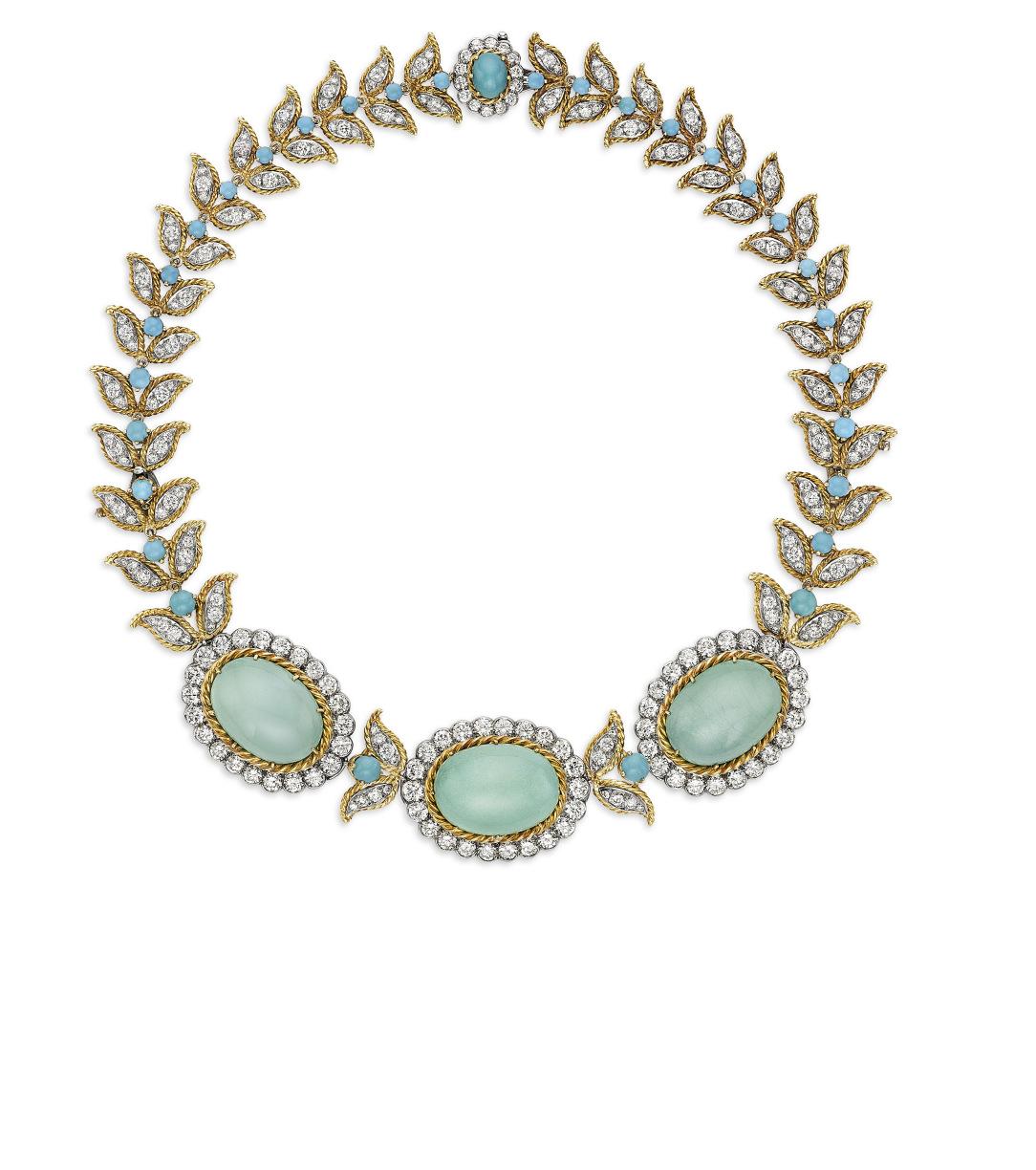
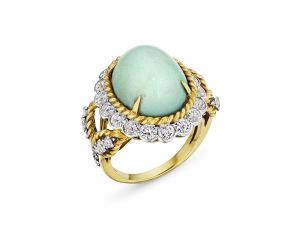
VAN CLEEF & ARPELS SUITE OF TURQUOISE AND DIAMOND JEWELRY
Oval and round turquoise cabochons, round diamonds, yellow and white gold (necklace), platinum and yellow gold (earrings and ring), circa 1960, necklace and earrings each signed Van Cleef & Arpels, N.Y., ring signature heavily obliterated, necklace and earrings each numbered, necklace detachable into three segments and may be worn as two bracelets
Van Cleef & Arpels, 1985: Copy of Insurance Valuation
Size/Dimensions: necklace 39.4 cm (15Ω in), longest segment 18.1 cm (7¿ in), remaining segments 21.0 cm (8º in); earrings 4.1 x 1.9 cm (1¬ x æ in); ring US size 8
Gross Weight: 126.3 grams
$100,000-150,000
PROVENANCE: Susan Hayward (1917-1975)
Sotheby's, New York, 17 and 18 October 1984, Sale 5222, Lot 146
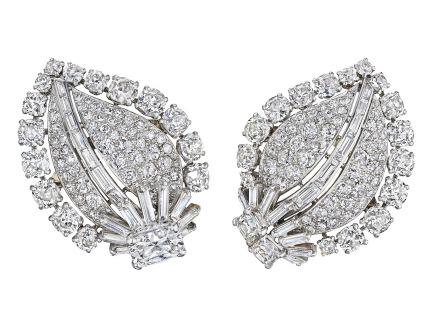
50
DIAMOND EARRINGS
Designed as leaves, round-cornered rectangular brilliant-cut diamond of 2.76 carats, old-cut, single, baguette, square and rectangular-shaped diamonds, platinum and white gold, please note these were likely later adapted to ear clips
GIA, 2025, report no. 2235587196: 2.76 carats, D color, SI2 clarity
Size/Dimensions: 3.1 x 3.8 cm (1º x 1Ω in)
Gross Weight: 35.6 grams
$20,000-30,000
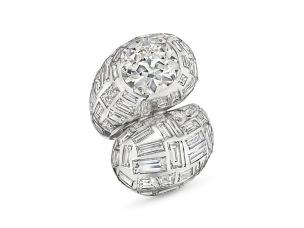

51
SUZANNE BELPERRON DIAMOND ‘TOI ET MOI’ RING
Circular brilliant-cut diamond of 3.58 carats, baguette, trapezoid and square-shaped diamonds, platinum (French mark)
GIA, 2025, report no. 2235548399: 3.58 carats, J color, SI2 clarity
Belperron, 2025: Certificate of Authenticity
Size/Dimensions: US ring size 4
Gross Weight: 18.0 grams
$30,000-50,000
LITERATURE:
Cf. S. Raulet, O. Baroin, Suzanne Belperron, Antique Collectors Club Ltd., 2011, p. 314
According to the Belperron certificate, this ring was manufactured circa 1932 - 1974.

SUZANNE BELPERRON DIAMOND 'WING' BROOCH
Old and single-cut diamonds, platinum and 18k white gold (French marks), maker's mark (Société Groëné et Darde)
Belperron, 2025: Certificate of Authenticity
Size/Dimensions: 6.7 x 3.2 cm (2¬ x 1º in)
Gross Weight: 31.8 grams
$50,000-70,000
According to the Belperron certificate, this brooch was manufactured circa 1932 - 1955.
LEARN MORE
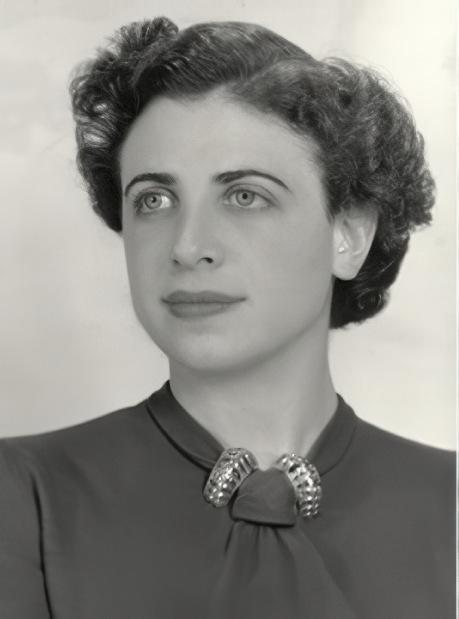
Madeleine Haas Russell
Born into a prominent San Francisco family, Madeleine Haas Russell (1915-1999) was orphaned at the age of 12 and raised by her aunt and uncle. The early loss of her parents left both Madeleine and her brother, William Haas, a substantial inheritance. Rather than retreating to the comforts of their upbringing, the siblings viewed their fortune as a means to serve others, in keeping with their family’s longstanding tradition of civic engagement and commitment to community.
A shared sense of purpose culminated in 1940 with the founding of Columbia Foundation – one of California’s earliest philanthropic institutions. At a time when family foundations were rare, with only two established in the West Coast prior, Madeleine and William made a deliberate decision to pioneer an organization that charted a new course for philanthropy. The foundation initially supported a wide-range of causes, from scientific research to civil liberties. After William passed away in 1943, Madeleine shifted focus to the intersection of philanthropy and public life, channeling the foundation’s resources towards progressive political causes including nuclear disarmament, educational access and civil rights.
Madeleine’s commitment to community engagement extended well beyond her work with the foundation. In recognition of her civic dedication, she was appointed by President John F. Kennedy to lead the State Department Reception Center in San Francisco, overseeing invited guests during their official visits to the United States – a role she held for seven years. To her, civic engagement was not separate from charitable work. Rather, it was a natural extension of it – another avenue of shaping a more just and inclusive society.
Since Madeleine’s passing in 1999, her legacy has continued to resonate across the cultural, political and civic landscapes she helped shape. Although Columbia Foundation closed in 2013, its more than seven decades of endless support to the world has maintained a lasting impact. Today, she is remembered not only for her pioneering role in progressive philanthropy but also for the intention she brought to every part of her life. Among the many things she cherished was jewelry, which she loved not merely as accessories, but as a form of personal expression. She was especially drawn to the works of Suzanne Belperron, whose avant-garde designs resonated deeply with the qualities Madeleine possessed herself.
Photograph of Madeleine Haas Russell wearing Lot 53, circa 1940, by Berenice Abbott, with permission from the family
Property from the Collection of Madeleine Haas Russell Lots 53-56


SUZANNE BELPERRON PAIR OF MULTI-GEM AND GOLD 'ROOF' CLIP-BROOCHES
Pear-shaped pink and green tourmalines, garnets, citrines, topazes and aquamarines, 18k yellow and rose gold (French mark), maker's marks (Société Groëné et Darde)
Belperron, 2025: Certificate of Authenticity
Size/Dimensions: each brooch 4.7 cm (1√ in)
Gross Weight: 46.8 grams
$40,000-60,000
According to the Belperron certificate, these clip-brooches were manufactured circa 1932 - 1940.
Property from the Collection of Madeleine Haas Russell
Lots 53-56
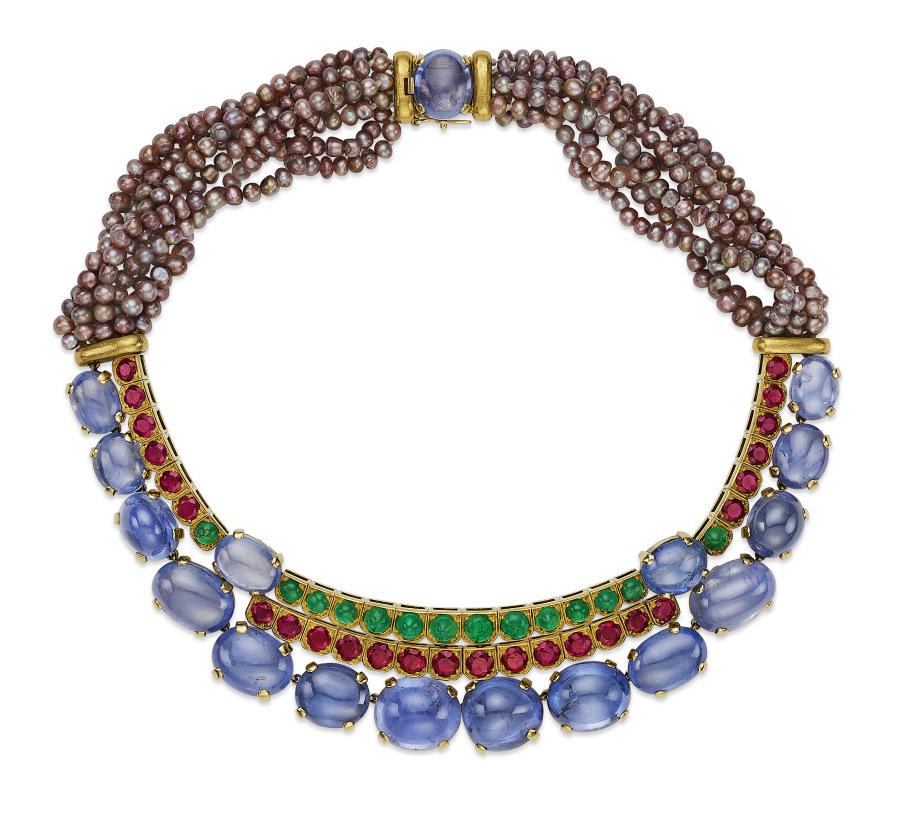
54
SUZANNE BELPERRON MULTI-GEM AND PEARL NECKLACE
Oval cabochon sapphires, round cabochon emeralds, round rubies, variously-shaped brown pearls, 18k yellow gold (French marks), circa 1965, maker's mark (Darde et Fils)
Belperron, 2025: Certificate of Authenticity
Size/Dimensions: 33.0 cm (13 in)
Gross Weight: 114.3 grams
$80,000-120,000
Please note that the pearls have not been tested for natural origin.
LEARN MORE


55
SUZANNE BELPERRON EMERALD ‘MÉLANGE’ EARRINGS
Square, rectangular, pear and round emeralds, 18k yellow gold (French marks), unsigned, drop element detachable
AGL, 2025, report no. 1147457 A and B: Colombia, clarity enhancement: minor, type: traditional
Belperron, 2025: Certificate of Authenticity
Size/Dimensions: 3.1 cm (1º in), without detachable drops 2.5 cm (1 in)
Gross Weight: 25.3 grams
$40,000-60,000
According to the Belperron certificate, these earrings were manufactured circa 1955 - 1969.
56
SUZANNE BELPERRON EMERALD ‘FLEURON’ BANGLE BRACELET
Rectangular emerald-cut emerald, rectangular-shaped emerald, 18k yellow gold (French mark), maker's mark (Darde et Fils)
AGL, 2025, report no. 1147459 (Largest emerald): Colombia, clarity enhancement: minor, type: traditional
Belperron, 2025: Certificate of Authenticity
Size/Dimensions: inner diameter 5.0 cm (2 in), inner circumference 14.4 cm (56 in)
Gross Weight: 23.4 grams
$30,000-50,000
According to the Belperron certificate, this bracelet was manufactured circa 1955 - 1969.
LEARN MORE
LEARN MORE


SUZANNE BELPERRON RUBY AND DIAMOND RING
Round rubies, single and old-cut diamonds, platinum (French mark), unsigned, partially indistinct maker's mark (Société Groene et Darde)
Copy of Olivier Baroin, 2016: Certificate of Authenticity
Size/Dimensions: US ring size 7æ
Gross Weight: 19.9 grams
$15,000-20,000
According to the Olivier Baroin certificate, this jewel was manufactured circa 1942 - 1955.
(two views)
LEARN MORE


SUZANNE BELPERRON EMERALD AND GOLD 'TURBAN' RING AND EMERALD AND GOLD EARRINGS
Comprising a pair of earrings and a ring, emerald tumble beads, 18k hammered yellow gold (French marks), each circa 1971, unsigned, each with maker's mark (Société Darde et Compagnie)
Olivier Baroin, 2014: Copy of Certificate of Authenticity (earrings) Olivier Baroin, 2014: Copy of Certificate of Authenticity (ring)
LITERATURE:
Cf. P. Corbett, W. Landrigan, N. Landrigan, Jewelry by Suzanne Belperron, Thames & Hudson, 2015, p. 15 (set), 126 (ring)
Cf. S. Raulet, O. Baroin, Suzanne Belperron, Antique Collectors Club Ltd., 2011, p. 273
Suzanne Belperron admired the rich, buttery glow of ancient Greek treasures crafted from pure gold. She meticulously hammered, chiseled, and hand-burnished to create the antique patina she prized. Property from an Important Private Collection Lots 57-64
Size/Dimensions: earrings 3.1 cm (1º in); US ring size 4
Gross Weight: 68.6 grams
$50,000-70,000

Elsa Schiaparelli wearing Lots 59 and 60 in 1941 at the home of John H. P. Gould
Jerome Zerbe Photographs and Papers. General Collection, Beinecke Rare Book and Manuscript Library, Yale University
Suzanne Belperron and Elsa Schiaparelli
In 1921, Suzanne Belperron (née Vuillerme) joined the prestigious jewelry house Boivin as a modelist-designer. During her decade-long tenure working under Jeanne Boivin, the widow of René Boivin, she produced some of the firm’s most remarkable jewels. Rejecting the rigid geometry of the dominant Art Deco style, Belperron’s designs embraced flowing, organic forms and bold, oversized stones, creating a dramatic, modern aesthetic.
In 1932, Belperron left Boivin to make a name for herself. Partnering with her longtime friend and pearl dealer Bernard Herz, she designed exclusively under his company, B. Herz. Maintaining an appointmentonly salon at 59 rue de Châteaudon, Belperron attracted a distinguished clientele that included notable figures such as Diana Vreeland. True to her confidence in her craftmanship, she famously stated, “My style is my signature,” and refused to sign her pieces, believing that her distinctive style spoke for itself.
One of Belperron’s most ardent enthusiasts was Elsa Schiaparelli (1890 – 1973), the avant-garde Italian-born fashion designer renowned for her eccentric and surrealist designs. Since establishing her couture house in Paris and presenting her first collection in 1927, Schiaparelli gained a reputation as one of the most groundbreaking designers of her time, prized for her bold use of unconventional Surrealist patterns across a wide range of artistic forms – garments, jewelry and footwear.
Earning historical recognition as the first female fashion designer to be featured on the cover of Time magazine in 1934, Schiaparelli continued to produce works of art that were cherished by influential women who also engaged with Belperron’s creations, such as the Duchess of Windsor. Schiaparelli recognized the innovative spirit of Belperron’s work, and the two women shared a mutual passion for redefining artistic boundaries.
Schiaparelli acquired several pieces of Belperron jewelry, including some of her most iconic creations. Among them was the sapphire demi-parure (Lots 59 and 60), featuring vibrant sapphire cabochons, each with varying shades, intricately woven together within a flexible platinum and gray gold openwork design. Unlike many renowned jewelers who often sourced perfectly matched stones over extended periods of time for a single piece of jewelry, Belperron often used different shades of a single stone to create a unique arrangement, allowing the unique qualities of each stone to come alive.
Each sapphire in the bracelet and necklace was carefully placed to create a harmonious composition. The necklace, in particular, drapes around one’s neck like a bib, a motif that had existed in the Art Deco period but was reimagined by Belperron. While earlier bib designs often featured geometric, structured arrangements, Belperron’s creation invoked a sense fluidity through the use of round cabochons arranged in an organic pattern. Produced shortly after the inception of Belperron’s partnership with Herz, this necklace set an example for the modern bib motif that later became a prominent theme during mid-century.
Another exquisite piece originally from Schiaparelli’s collection is the diamond ‘Torsade’ bracelet (Lot 61), where sections of diamonds and platinum intertwine to form dynamic sculptural shapes. In 1933, Schiaparelli was featured in the Vogue magazine wearing this example, showcasing Belperron’s signature mastery of curves. This bracelet was produced in multiple variations, one of which was owned by Standard Oil heiress Millicent Rogers.
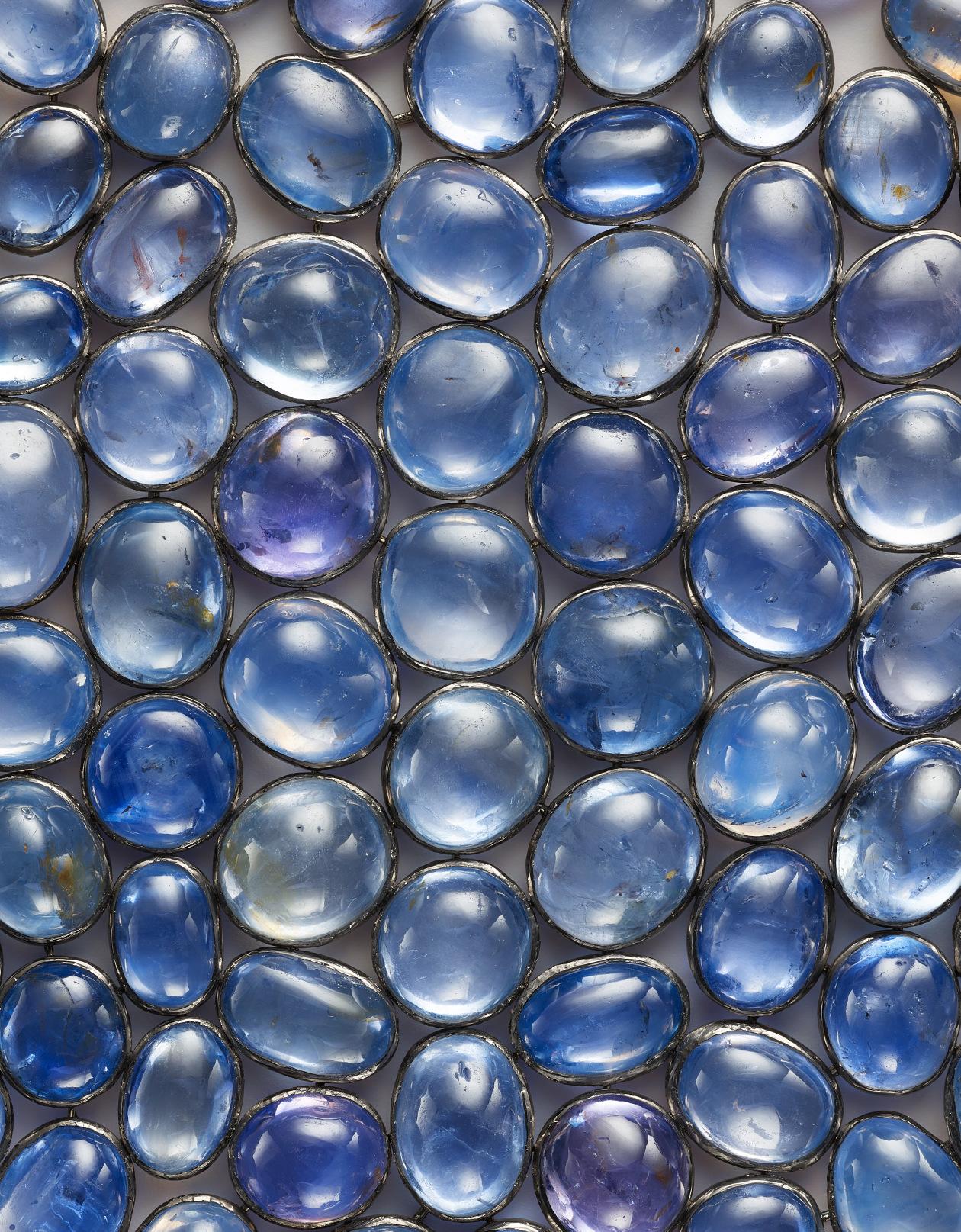
Property from an Important Private Collection
Lots 57-64
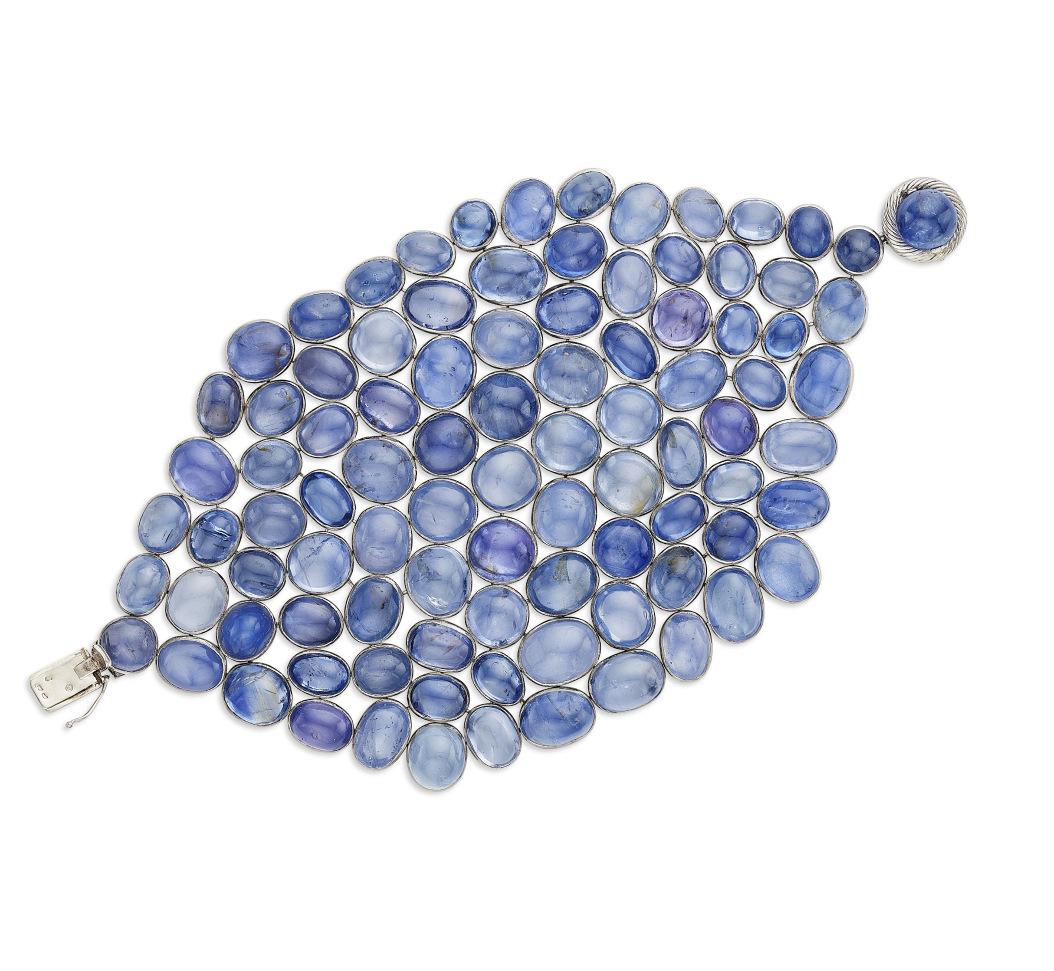
SUZANNE BELPERRON STAR SAPPHIRE AND SAPPHIRE BRACELET
Oval and round star sapphire and sapphire cabochons, 18k white gold (French marks), circa 1935, maker's marks (Groëné et Darde, partially indistinct)
Olivier Baroin, 2014: Copy of Certificate of Authenticity
Size/Dimensions: 16.8 x 8.9 cm (6¬ x 3Ω in)
Gross Weight: 163.7 grams
$120,000-220,000
PROVENANCE:
Elsa Schiaparelli (1890-1973)
Drouot, Paris, 17 December 2014, Lot 109
LITERATURE: P. Corbett, W. Landrigan, N. Landrigan, Jewelry by Suzanne Belperron, London, Thames & Hudson, 2015, p. 151, 154-157
Property from an Important Private Collection Lots 57-64

SUZANNE BELPERRON STAR SAPPHIRE AND SAPPHIRE 'PLASTRON' NECKLACE
Of bib design, oval and round star sapphire and sapphire cabochons, 18k white gold (French import mark), circa 1935, unsigned
Olivier Baroin, 2014: Copy of Certificate of Authenticity
Size/Dimensions: 33.0 x 4.4 cm (13 x 1æ in)
Gross Weight: 135.6 grams
$250,000-350,000
PROVENANCE: Elsa Schiaparelli (1890-1973)
Drouot, Paris, 17 December 2014, Lot 109
LITERATURE:
P. Corbett, W. Landrigan, N. Landrigan, Jewelry by Suzanne Belperron, London, Thames & Hudson, 2015, p. 154-157
LEARN MORE

Property from an Important Private Collection
Lots 57-64

A collection of Madame Schiaparelli’s jewelry by Suzanne Belperron including Lot 61, featured in Vogue 1933 Horst P. Horst/Conde Nast Collection/Getty Images
Property from an Important Private Collection
Lots 57-64
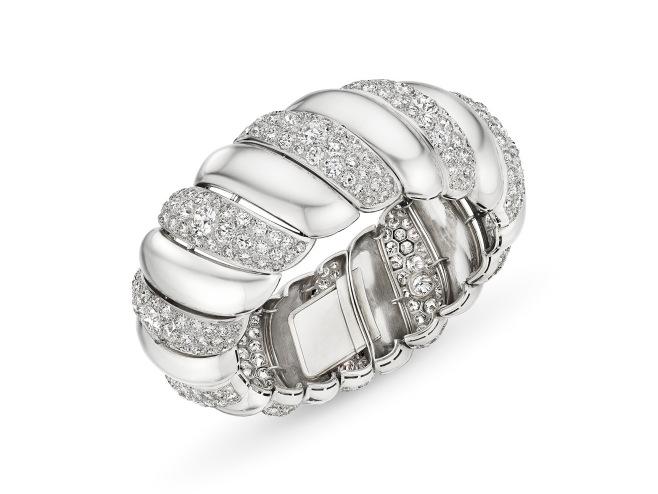
SUZANNE BELPERRON DIAMOND 'TORSADE' BRACELET
Old, round and single-cut diamonds, platinum and 18k white gold (French marks), circa 1932, unsigned
Francoise Cailles, 2007: Copy of Evaluation
Size/Dimensions: inner continuous circumference 15.9 cm (6º cm)
Gross Weight: 95.8 grams
$100,000-150,000
PROVENANCE:
Elsa Schiaparelli (1890 - 1973)
Christie's, Geneva, 16 May 2007, Sale 1347, Lot 261
LITERATURE:
S. Raulet, O. Baroin, Suzanne Belperron, Antique Collectors Club Ltd., Woodbridge, Suffolk, UK, 2011, p. 64 - 65
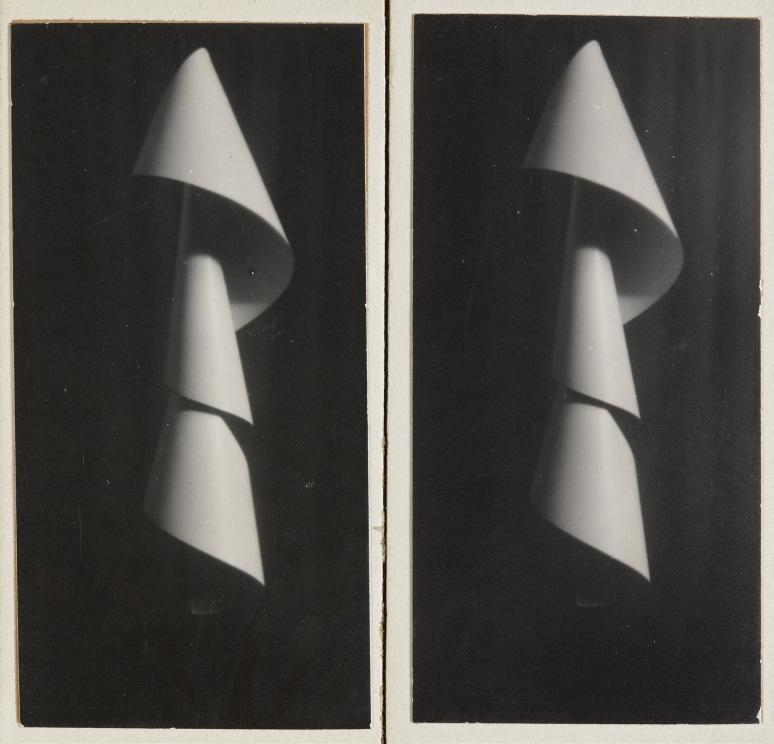
Man Ray Jewelry
Man Ray, an American prominent surrealist artist, collaborated with the Italian firm Gem Montebello to produce jewelry in the 1960’s. Each design produced was executed in editions of twelve, as inscribed on Lot 62. A highly-respected photographer, Man Ray incorporated his jewelry creations and socialites into shoots with celebrities including Catherine Deneuve, who wore his spiraling 'Pendantif-Pendant', a larger version of these ‘Les Boucles’ earrings, in a 1966 shoot. The form of these earrings evokes Man Ray's earlier works Lampshade (Abat-Jour) from 1919 and Lampshade, années from 1940-1950.
Lampshade, années, (1940-1950), by Man Ray © 2025 Man Ray Trust / Artists Rights Society (ARS), New York / ADAGP, Paris
Lots 57-64

Size/Dimensions: 8.2 cm (3º in)
Gross Weight: 20.1 grams
$20,000-30,000
PROVENANCE:
Christie's, New York, 5 May 2010, Sale 2313, Lot 428 Property from an Important Private Collection
MAN RAY GOLD 'LES BOUCLES' PENDANT EARRINGS
18k yellow gold, circa 1973, signed Man Ray, maker's mark (Gem Montebello), numbered
LEARN MORE
Conch Pearls
A true organic beauty, conch pearls are the product of an entirely natural formation with no human intervention. The pearls are harvested from the Aliger gigas, or Queen conch, a mollusk found in the warm waters spanning from Bermuda to the Yucatán Peninsula. An estimated one in 10,000 Queen conch must be harvested before a single pearl is found, and only one in ten is said to be gem-quality, making the conch pearl a coveted yet difficult to obtain gem.
Precisely how the conch pearl forms within its shell remains a mystery due to the swirling curves of the Queen conch, but its formation is believed to be similar to that of other naturally occurring pearls. The accepted theory is that irritant enters the shell, around which concentric layers of fibrous crystals build up, eventually forming a calcareous concentration of aragonite, calcite and water that we call conch pearl. Just as culturing operations for oyster pearls developed to meet the public’s desire for pearl jewelry, several biological researchers have made attempts at developing a culturing process for the conch pearl. No successful effort has been recorded, thus maintaining the conch pearl’s exclusive status in jewelry.
While still referred to as a pearl, the conch pearl differs from oyster pearls with its absence of nacre, the composite material that provides oyster pearls with their iridescent luster. Instead, the finest conch pearls display a porcelaneous surface with a unique ‘flame’ characteristic that leaves the pearl with a mesmerizing shimmer. Flame’s distinctive waving chatoyancy is the result of calcite microcrystalline fibers arranged in concentric layers just below the conch pearl’s surface. All conch pearls display flame under magnification but only a valued few, like those in Lot 66, Van Cleef & Arpels Set of Conch Pearl, Diamond and Gold Jewelry, benefit from the flame being eye-visible.
A conch pearl’s color matches that of its host shell’s color, which changes over the course of the mollusk’s life. They can be found in various hues of white, beige, yellow, orange, brown, pink and red, the latter two being the most highly prized. A full color range of conch pearls is on display in Lot 63, Conch Pearl and Diamond Bead Longchain Necklace.
Lot 63 displays another sought-after trait – a perfectly spherical shape. Most conch pearls are oval-shaped, which adds to their organic allure, but the scarcity of round conch pearls makes them exceptionally desirable. Conch pearls’ often irregular forms lent themselves to the naturalistic motifs of the Art Nouveau and Edwardian periods. After a wane in popularity, they returned to use in the 1980s as Harry Winston and Mikimoto acquired collections of conch pearls for use in their jewels. The subsequent growth of interest in natural pearls, coupled with conch pearls’ entirely unique nature and limited supply make conch pearl jewelry increasingly popular to collectors’ who savor the hunt for rarity.
CONCH PEARL AND DIAMOND BEAD LONGCHAIN NECKLACE
Near-round and oval conch pearls ranging from 10.50 to 3.78 x 3.48 mm, faceted diamond beads, platinum
GIA, 2025, report no. 6237580276: Natural saltwater pearls, Aliger gigas (conch), no indications of treatment
Size/Dimensions: 123.1 cm (48Ω in)
Gross Weight: 66.4 grams
$80,000-120,000
LEARN MORE
Lots 57-64
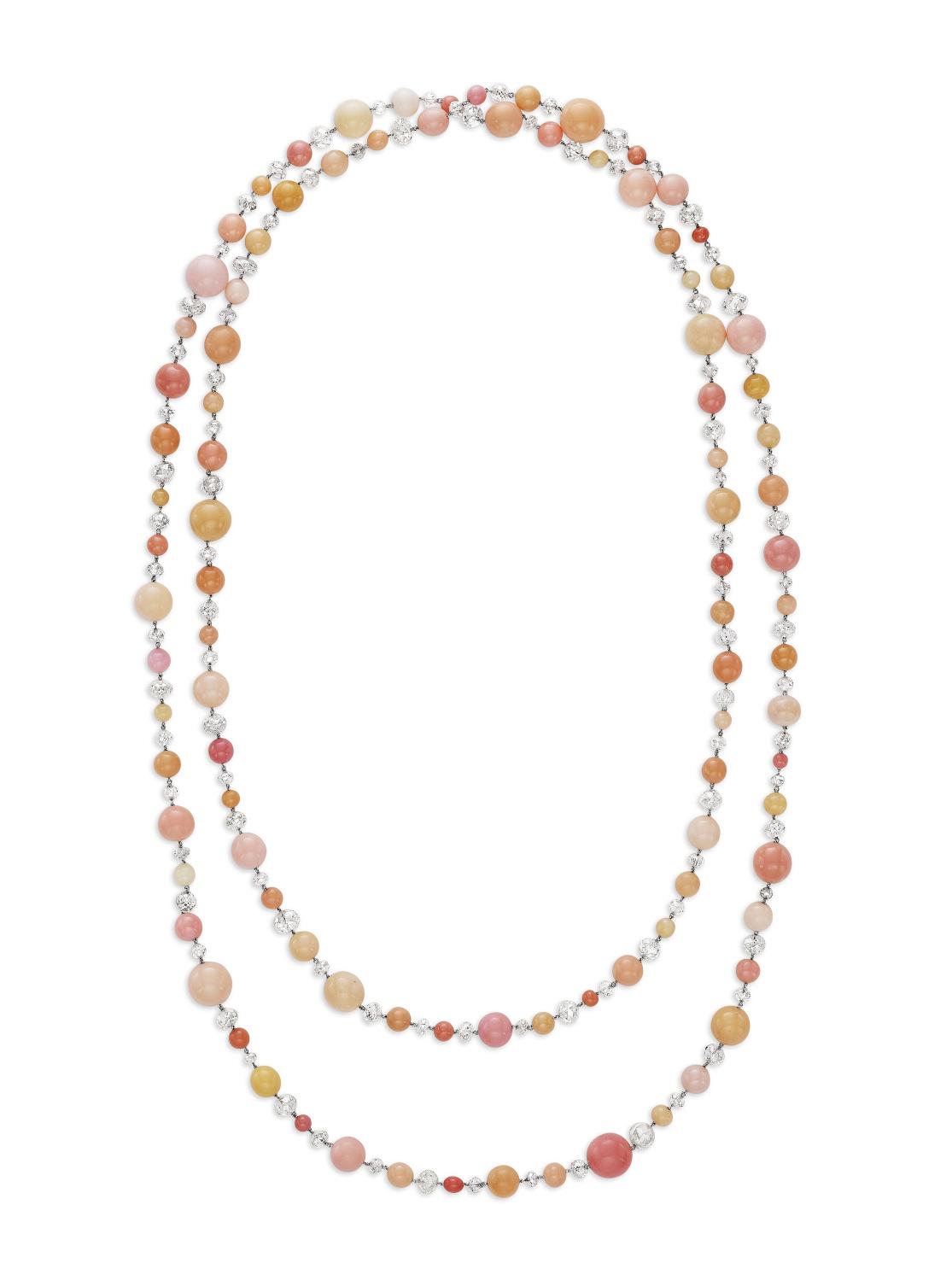
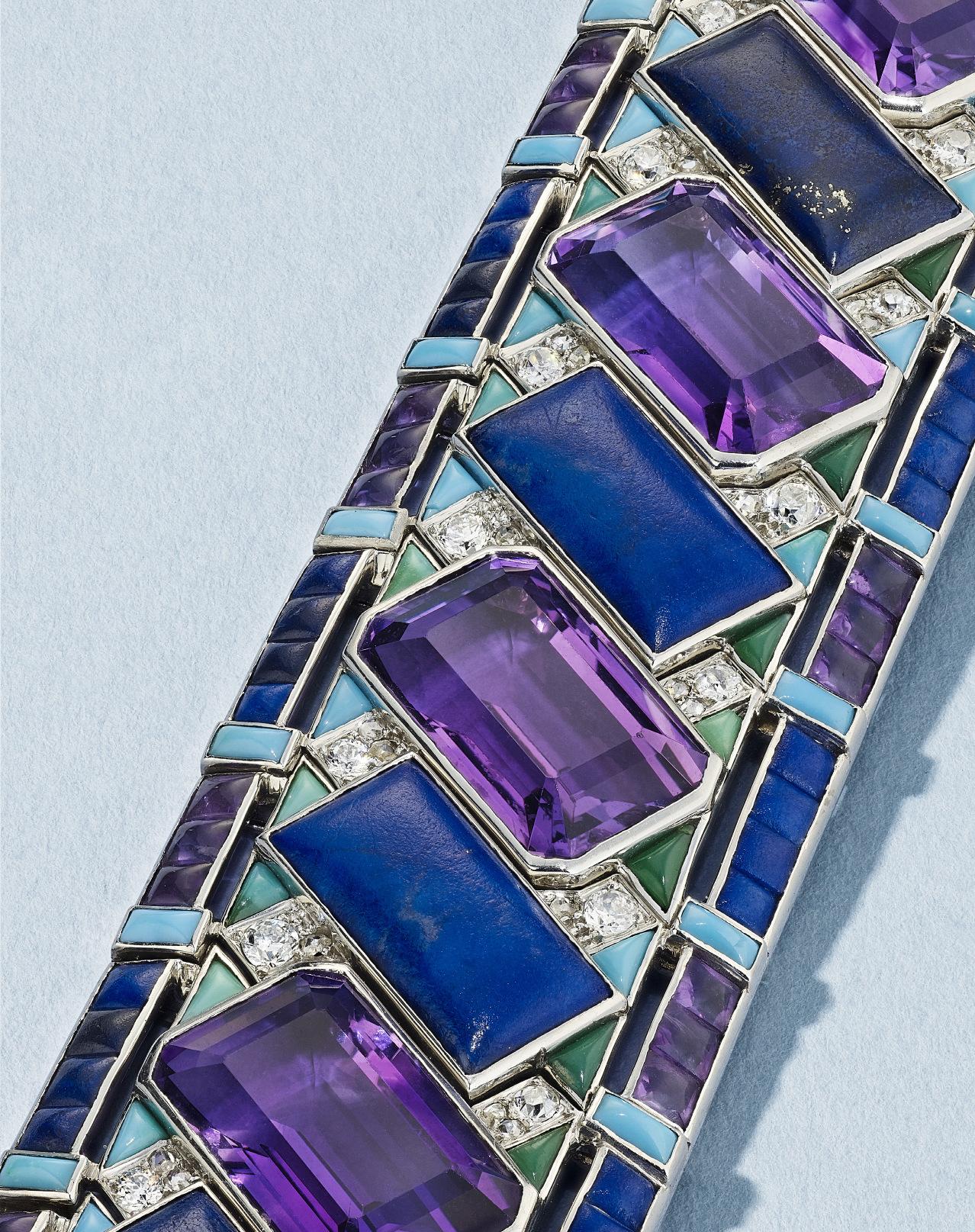

Cartier and the Art Deco Movement
The visual embodiment of modernist principles, the Art Deco movement celebrated the triumph of technology and the sleek, liberating forms of the machine age, its emphasis on structure responding to a widespread rejection of the seemingly excessive ornamentation of Art Nouveau. Art Deco designs, in contrast, were not necessarily simpler but rather more linear and streamlined, favoring the androgynous silhouettes that dominated the new vogue. Innovation abounded as artists and architects developed new relationships between form and function, experimenting with texture, dimension and unorthodox combinations of stones.
The Art Deco era is considered by many experts to be the golden era for Cartier. It employed the finest designers and craftsmen, and with royalty, film stars and business tycoons among its clientele, there were few limits to its creative ambitions. Color, ingenuity and attention to detail are at the forefront of Cartier jewelry from the era resulting in an everlasting interest from collectors still captivated by the jewels’ timelessness.
A rare jewel, this Cartier bracelet exemplifies several themes seen throughout the movement with its sharp geometric design, focusing on line and volume. The era’s fascination with Persian styles is reflected in the use of lapis lazuli and turquoise, an abstraction of the trend favoring the material rather than the motif. The analogous color combination of purple, blue and green is contrasted with differences in opacity; amethysts and diamonds interact with light while the lapis lazuli and turquoise serve as a solid color palette. This bracelet is a strong representation of Art Deco’s unprecedented level of creativity, resulting in a jewel that to this day remains iconic, refreshing and wearable.

Property from an Important Private Collection
Lots 57-64
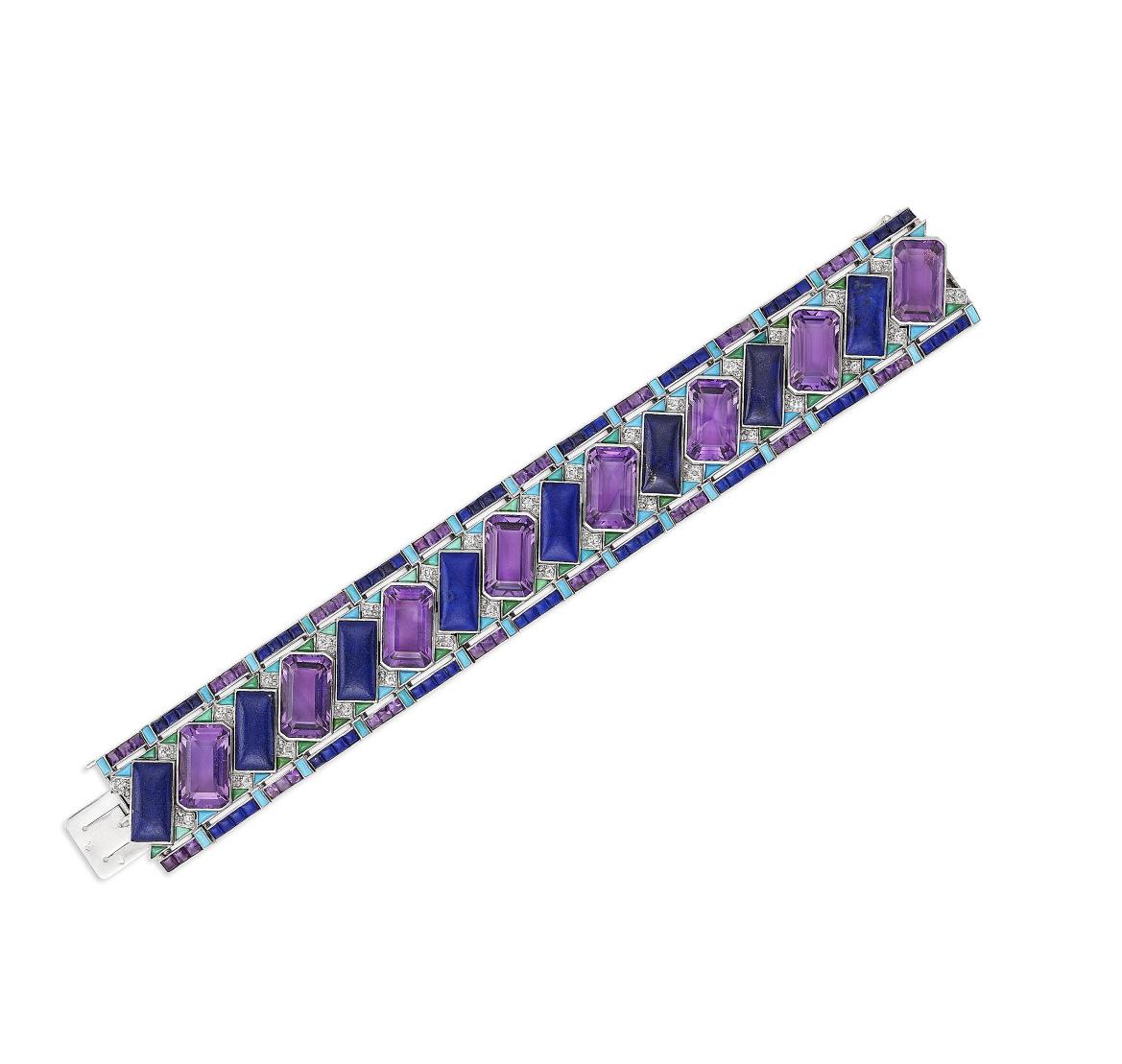
A RARE CARTIER ART DECO MULTI-GEM AND DIAMOND BRACELET
Emerald and buff-top amethysts, variously-shaped buff-top lapis lazuli and turquoise, old, rose and single-cut diamonds, platinum (French mark), circa 1930, signed Cartier, Made in France, maker's mark (Gustave Renault)
Size/Dimensions: 17.8 x 2.5 cm (7 x 1 in)
Gross Weight: 88.2 grams
$200,000-300,000
PROVENANCE: Thierry de Maigret Commissaire Priseur, Paris, 29 May 2013, Sale Bijoux - Montres - Argenterie, Lot 220





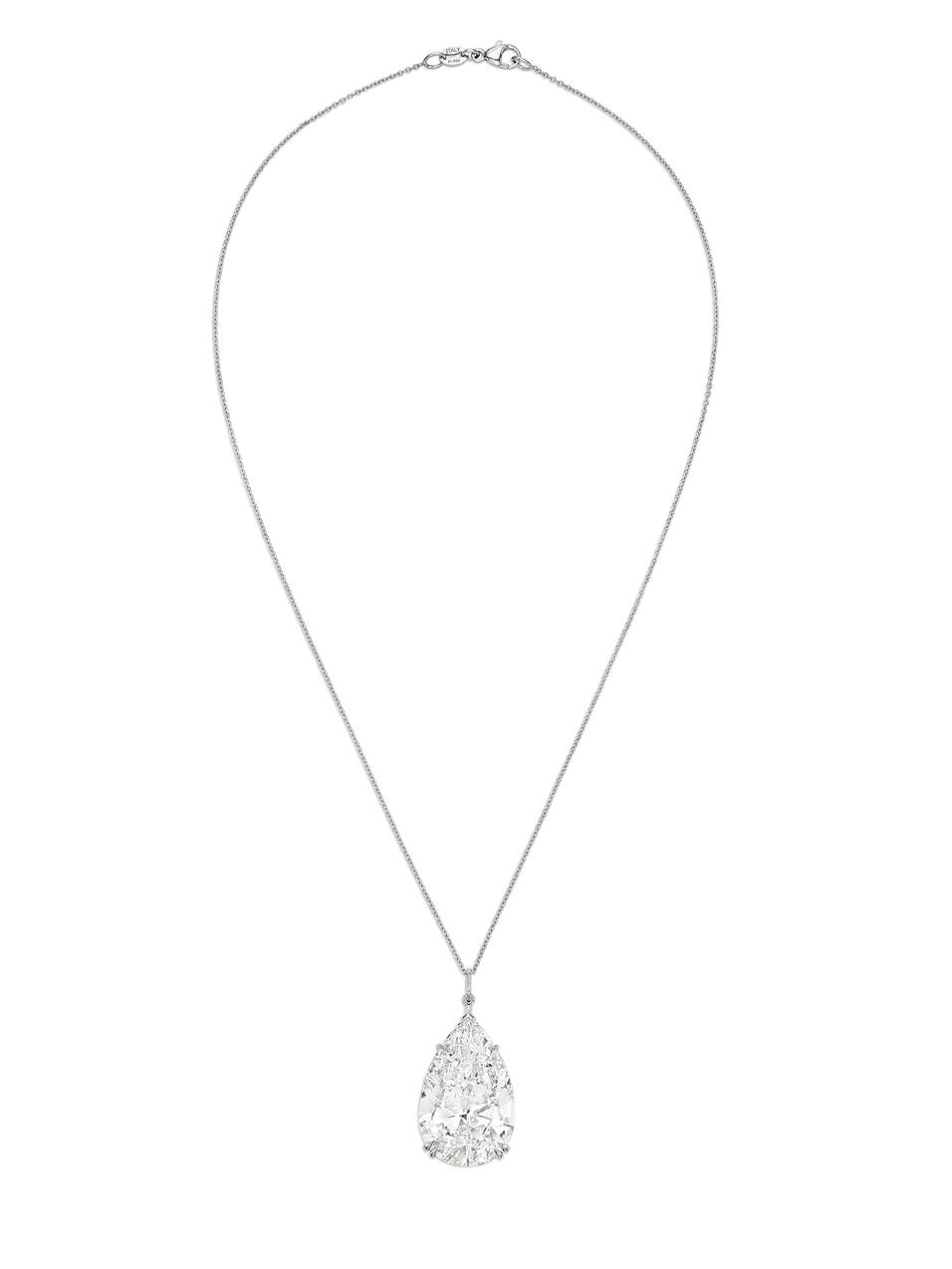
A SUPERB DIAMOND PENDANT NECKLACE
Pear brilliant-cut diamond of 25.45 carats, platinum
GIA, 2025, report no. 5202970330: 25.45 carats, D color, Flawless, excellent polish and symmetry, Type IIa
Size/Dimensions: neckchain 40.6 cm (16 in)
Gross Weight: 14.0 grams
$1,500,000-2,000,000
SHOULD YOU WISH TO BID ON THIS LOT, YOU WILL BE REQUIRED TO OBTAIN A HIGH VALUE PADDLE.

A Private Collection of Van Cleef & Arpels Jewelry
Lots 66-82
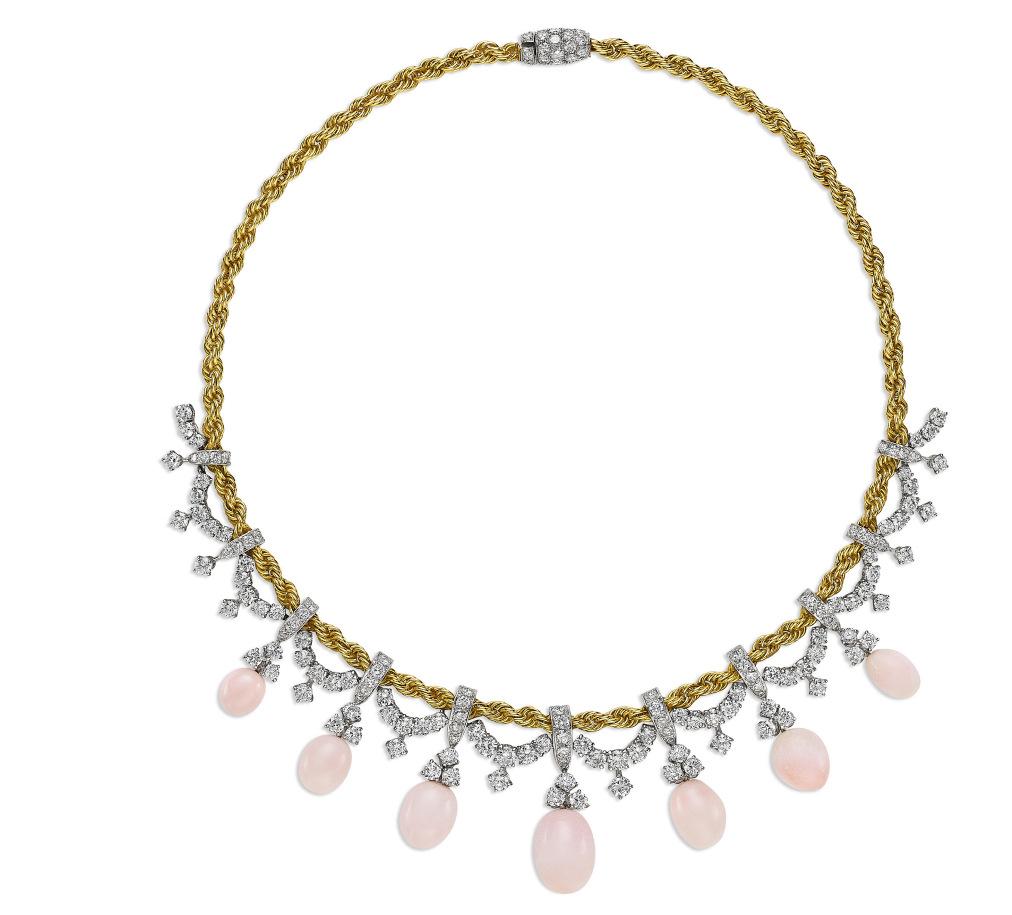

VAN CLEEF & ARPELS SET OF CONCH PEARL, DIAMOND AND GOLD JEWELRY
Oval and drop-shaped conch pearls ranging from 10.41 x 10.05 to 7.18 x 6.55 mm, round diamonds, necklace with 14k yellow gold and platinum, earrings with yellow gold and platinum, each circa 1950, each signed Van Cleef & Arpels, N.Y., each with maker’s mark, navy Van Cleef & Arpels necklace pouch
GIA, 2025, report no. 1232581509: Natural saltwater pearls, Aliger gigas (conch), no indications of treatment
Size/Dimensions: necklace 36.8 cm (14Ω in); earrings 4.7 x 1.9 cm (1√ x æ in)
Gross Weight: 73.8 grams
$50,000-70,000
A Private Collection of Van Cleef & Arpels Jewelry Lots 66-82
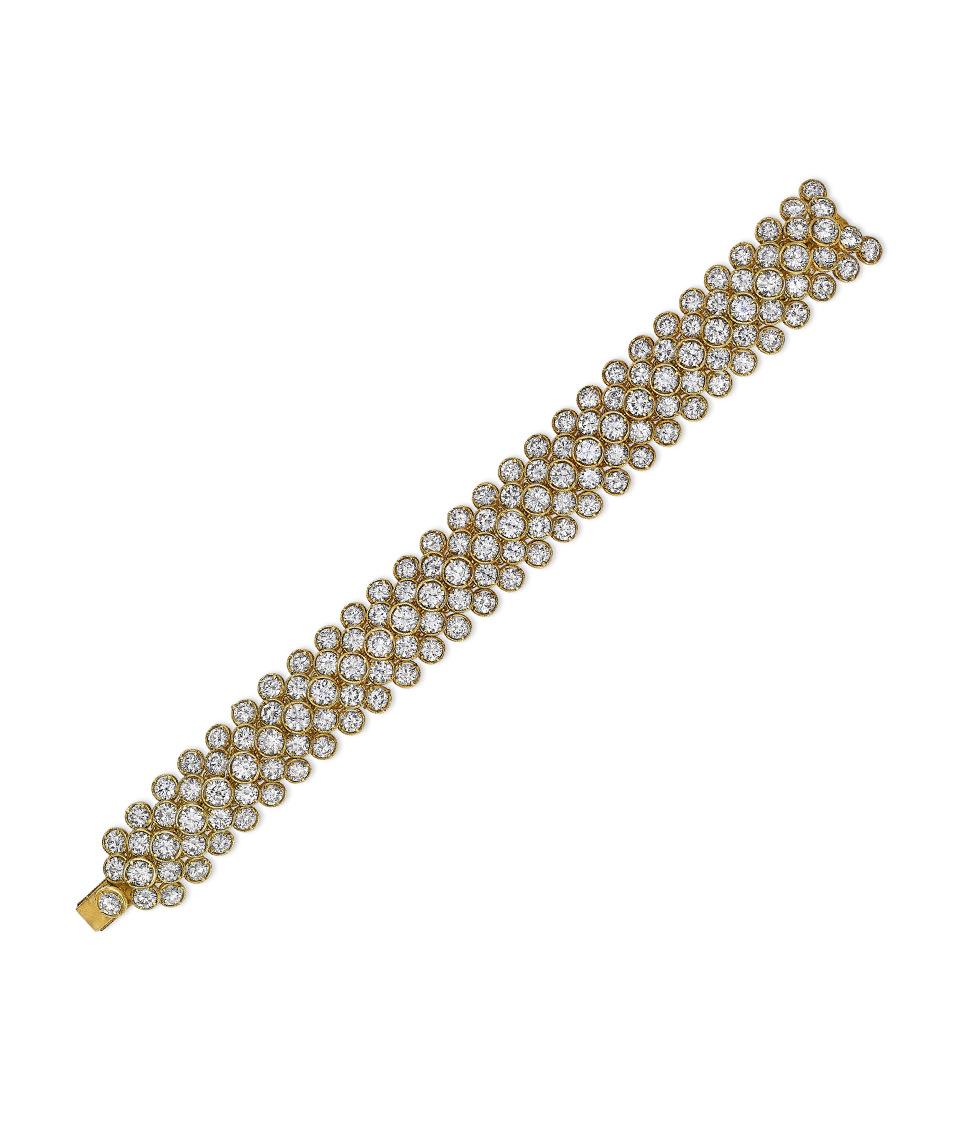
Size/Dimensions: 17.1 x 1.8 cm (6æ x æ in)
Gross Weight: 45.4 grams
$50,000-70,000
VAN CLEEF & ARPELS DIAMOND BRACELET
Round diamonds, 18k yellow gold (French mark), signed Van Cleef & Arpels, maker's mark, numbered, black Van Cleef & Arpels case
A Private Collection of Van Cleef & Arpels Jewelry Lots 66-82
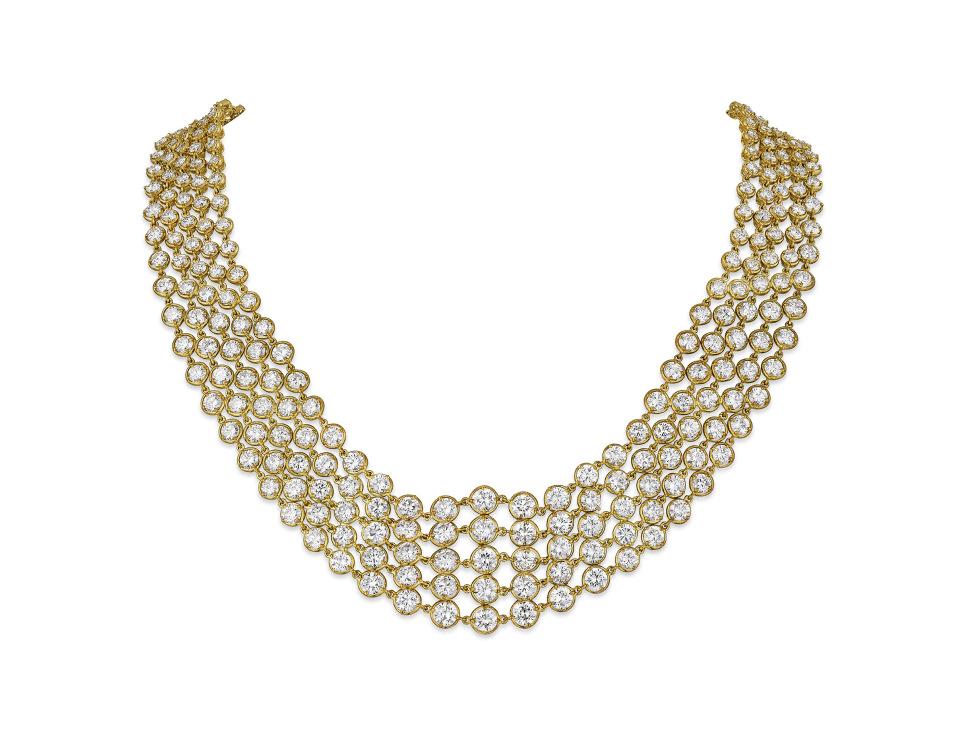

Size/Dimensions: 35.6 cm (14 in)
Gross Weight: 55.5 grams
$50,000-70,000
VAN CLEEF & ARPELS DIAMOND 'RESILLE PALMYRE' NECKLACE
Round diamonds, 18k yellow gold (French mark), signed Van Cleef & Arpels, maker's mark, numbered, brown Van Cleef & Arpels necklace case
LEARN MORE
A Private Collection of Van Cleef & Arpels Jewelry
Lots 66-82
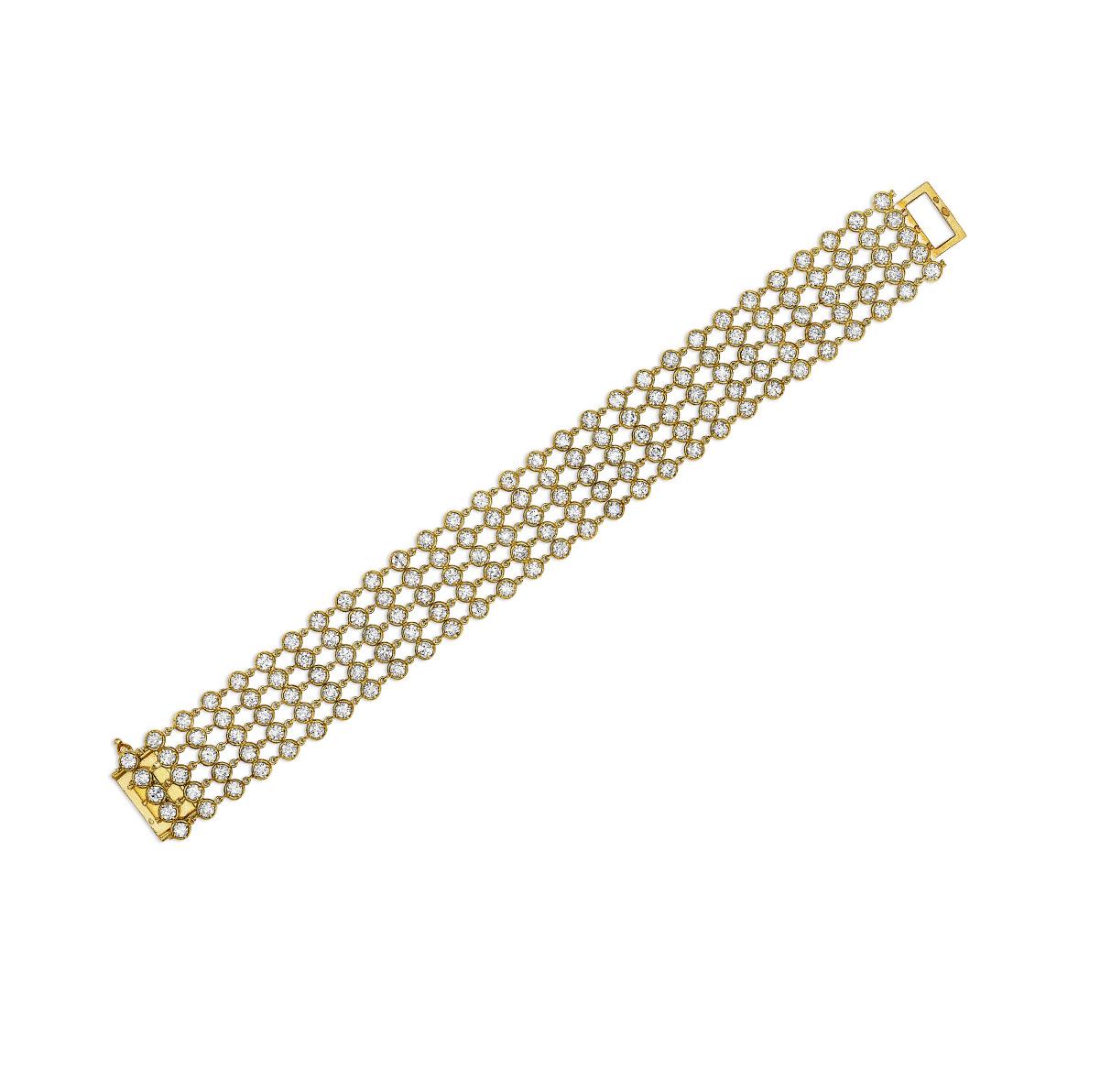
VAN CLEEF & ARPELS DIAMOND
'RESILLE PALMYRE' BRACELET
Round diamonds, 18k yellow gold (French marks), signed Van Cleef & Arpels, maker's mark, numbered, beige Van Cleef & Arpels case
Size/Dimensions: 18.0 x 1.9 (7 x æ in)
Gross Weight: 28.1 grams
$30,000-50,000
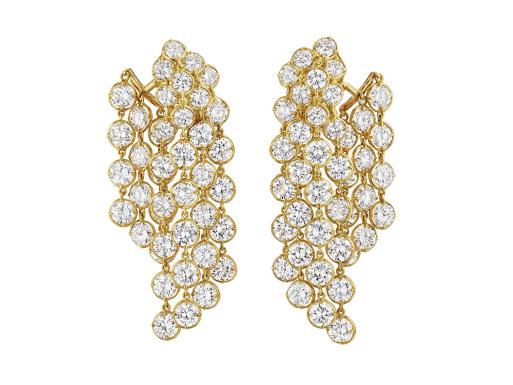
70
VAN CLEEF & ARPELS DIAMOND 'PALMYRE' EARRINGS
Round diamonds, 18k yellow gold (French marks), signed Van Cleef & Arpels, maker's marks, numbered
Size/Dimensions: 5.0 cm (2 in)
Gross Weight: 18.0 grams
$50,000-70,000
A Private Collection of Van Cleef & Arpels Jewelry Lots 66-82

VAN CLEEF & ARPELS DIAMOND 'FLEURETTES' PENDANT NECKLACE
Triangular, marquise and round diamonds, 18k yellow gold (French mark), signed V.C.A, numbered, please note the diamond pendant is detachable in two sections, beige Van Cleef & Arpels envelope pouch
Size/Dimensions: necklace 42.8 cm (16√ in), pendant 4.1 cm (1¬ in)
Gross Weight: 58.8 grams
$120,000-180,000
A Private Collection of Van Cleef & Arpels Jewelry Lots 66-82

72

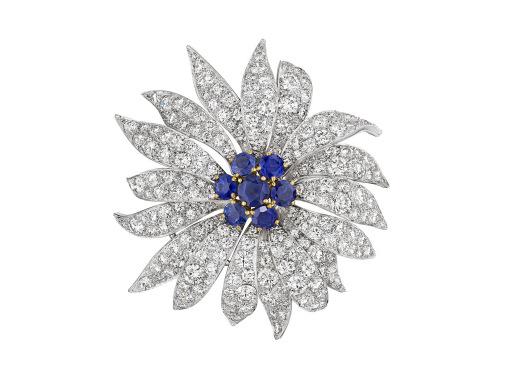
73
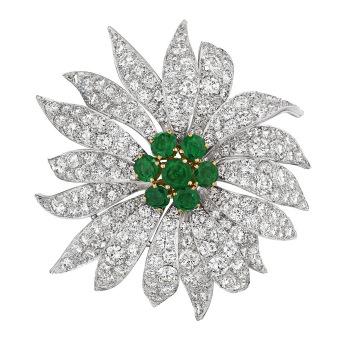
73 (shown with emerald element)
72
VAN CLEEF & ARPELS SET OF DIAMOND 'FLEURETTE' JEWELRY
Triangular, marquise and round diamonds, 18k yellow gold (each with French mark), each signed VCA, each numbered
Size/Dimensions: earrings 3.2 x 1.5 cm (1º x ¬ in); US ring size 4Ω
Gross Weight: 20.2 grams
$30,000-50,000
73
VAN CLEEF & ARPELS DIAMOND, SAPPHIRE AND EMERALD 'FLEUR' BROOCH
With interchangeable center elements of round sapphires and emeralds, round diamonds, platinum and 18k white gold (French marks), yellow gold, signed Van Cleef & Arpels, maker's mark (Ladislas Bergolz), numbered, grey Van Cleef & Arpels case
Size/Dimensions: 5.0 x 5.0 cm (2 x 2 in)
Gross Weight: 39.8 grams
$30,000-50,000
LITERATURE:
Cf. L. Couvreur-Schiffer, F. Falleul, M. Lary, Van Cleef & Arpels, Paris, Palais Galliéra, Diffusion Paris-Musées, 1992, p. 142, pl. 79 - 81
A Private Collection of Van Cleef & Arpels Jewelry
Lots 66-82

VAN CLEEF & ARPELS DIAMOND FLOWER BROOCH
Designed as a flower, marquise, round and baguette-cut diamonds, platinum and white gold, circa 1955, signed VCA, numbered, please note stem of the flower is designed to have flexibility of movement, black Van Cleef & Arpels case
Size/Dimensions: 12.0 cm (4æ in)
Gross Weight: 46.4 grams
$60,000-80,000
PROVENANCE:
Sotheby's, New York, 23 and 24 October 1991, Sale 6225, Lot 497
A Private Collection of Van Cleef & Arpels Jewelry
Lots 66-82

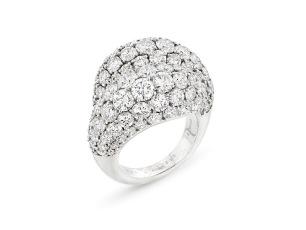
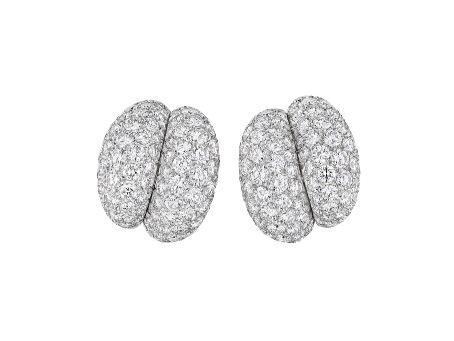
75
VAN CLEEF & ARPELS DIAMOND RING
Round diamonds, platinum (French mark), signed Van Cleef & Arpels, maker's mark, numbered
Size/Dimensions: US ring size 6
Gross Weight: 20.4 grams
$20,000-30,000
76
VAN CLEEF & ARPELS DIAMOND EARRINGS
Round diamonds, platinum and 18k white gold (French marks), signed Van Cleef & Arpels, maker’s mark, numbered
Size/Dimensions: 2.5 x 2.2 cm (1 x √ in)
Gross Weight: 29.9 grams
$40,000-60,000
A Private Collection of Van Cleef & Arpels Jewelry
Lots 66-82

VAN CLEEF & ARPELS DIAMOND 'VALENCIENNES' BRACELET
Round diamonds, 18k yellow gold (French mark), signed Van Cleef & Arpels, maker's mark, numbered
Size/Dimensions: 16.5 x 1.7 cm (6Ω x ¬ in)
Gross Weight: 50.7 grams
$60,000-80,000

78
VAN CLEEF & ARPELS DIAMOND 'DOUBLE COQUE VALENCIENNES' CLIP-BROOCH
Round diamonds, 18k yellow gold (French marks), signed Van Cleef & Arpels, signed Van Cleef & Arpels, numbered, navy Van Cleef & Arpels case
Size/Dimensions: 5.4 x 4.4 cm (2¿ x 1æ in)
Gross Weight: 20.6 grams
$20,000-30,000
LITERATURE:
Cf. L. Couvreur-Schiffer, F. Falleul, M. Lary, Van Cleef & Arpels, Paris, Palais Galliéra, Diffusion Paris-Musées, 1992, p. 158, pl. 292
A Private Collection of Van Cleef & Arpels Jewelry
Lots 66-82

LEARN MORE
VAN CLEEF & ARPELS DIAMOND 'VALENCIENNES' EARRINGS
Round diamonds, 18k yellow gold (French mark), signed Van Cleef & Arpels, maker's mark, numbered
Size/Dimensions: 5.4 x 3.2 cm (2¿ x 1º in)
Gross Weight: 28.4 grams
$50,000-70,000
LITERATURE:
Cf. L. Couvreur-Schiffer, F. Falleul, M. Lary, Van Cleef & Arpels, Paris, Palais Galliéra, Diffusion Paris-Musées, 1992, p. 158, pl. 294

A Private Collection of Van Cleef & Arpels Jewelry
Lots 66-82

A FINE VAN CLEEF & ARPELS DIAMOND NECKLACE
Pear-shaped and round diamonds, platinum and 18k white gold (French marks), signed Van Cleef & Arpels, makers mark (Successeurs d’Ehret), numbered, brown Van Cleef & Arpels envelope pouch
Size/Dimensions: 35.5 cm (14 in)
Gross Weight: 94.5 grams
$250,000-350,000
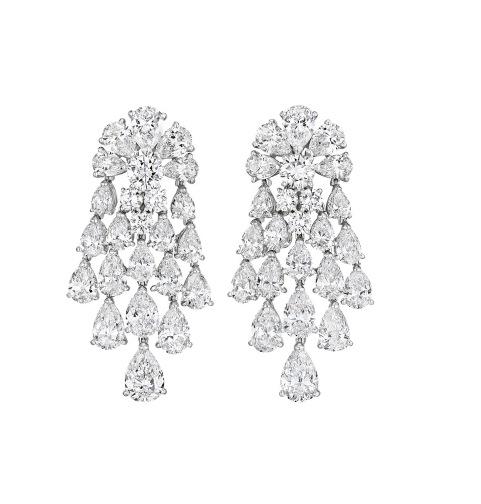
A PAIR OF STYLISH VAN CLEEF & ARPELS DIAMOND ‘SATURNE’ EARRINGS
Pear-shaped and round diamonds, platinum and 18k white gold (French marks), signed Van Cleef & Arpels, makers mark (Successeurs d’Ehret), numbered
Size/Dimensions: 5.0 x 2.8 cm (2 x 1¿ in)
Gross Weight: 36.4 grams
$150,000-250,000
LEARN MORE

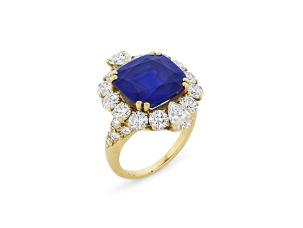
(two views)
A Private Collection of Van Cleef & Arpels Jewelry Lots 66-82 LEARN MORE
A RARE VAN CLEEF & ARPELS SAPPHIRE AND DIAMOND RING
Square cushion mixed-cut sapphire of 8.45 carats, round and pear-shaped diamonds, 18k yellow gold (French mark), signed Van Cleef & Arpels, numbered, maker's mark (Successeurs d’Ehret), navy Van Cleef & Arpels case
AGL, 2025, report no. 1147892: Kashmir, no gemological evidence of heat, clarity enhancement: none
SSEF, 2025, report no. 146230: 8.455 carats, Kashmir, no indications of heating
Size/Dimensions: US ring size 5Ω
Gross Weight: 8.6 grams
$400,000-600,000








(two views)
LEARN MORE
A MAGNIFICENT UNMOUNTED DIAMOND
Round brilliant-cut diamond of 66.74 carat
GIA, 2023, report no. 1182650191: 66.74 carats, D color, VVS1 clarity, excellent cut, polish and symmetry, Type IIa
$3,200,000-4,200,000
SHOULD YOU WISH TO BID ON THIS LOT, YOU WILL BE REQUIRED TO OBTAIN A HIGH VALUE PADDLE.
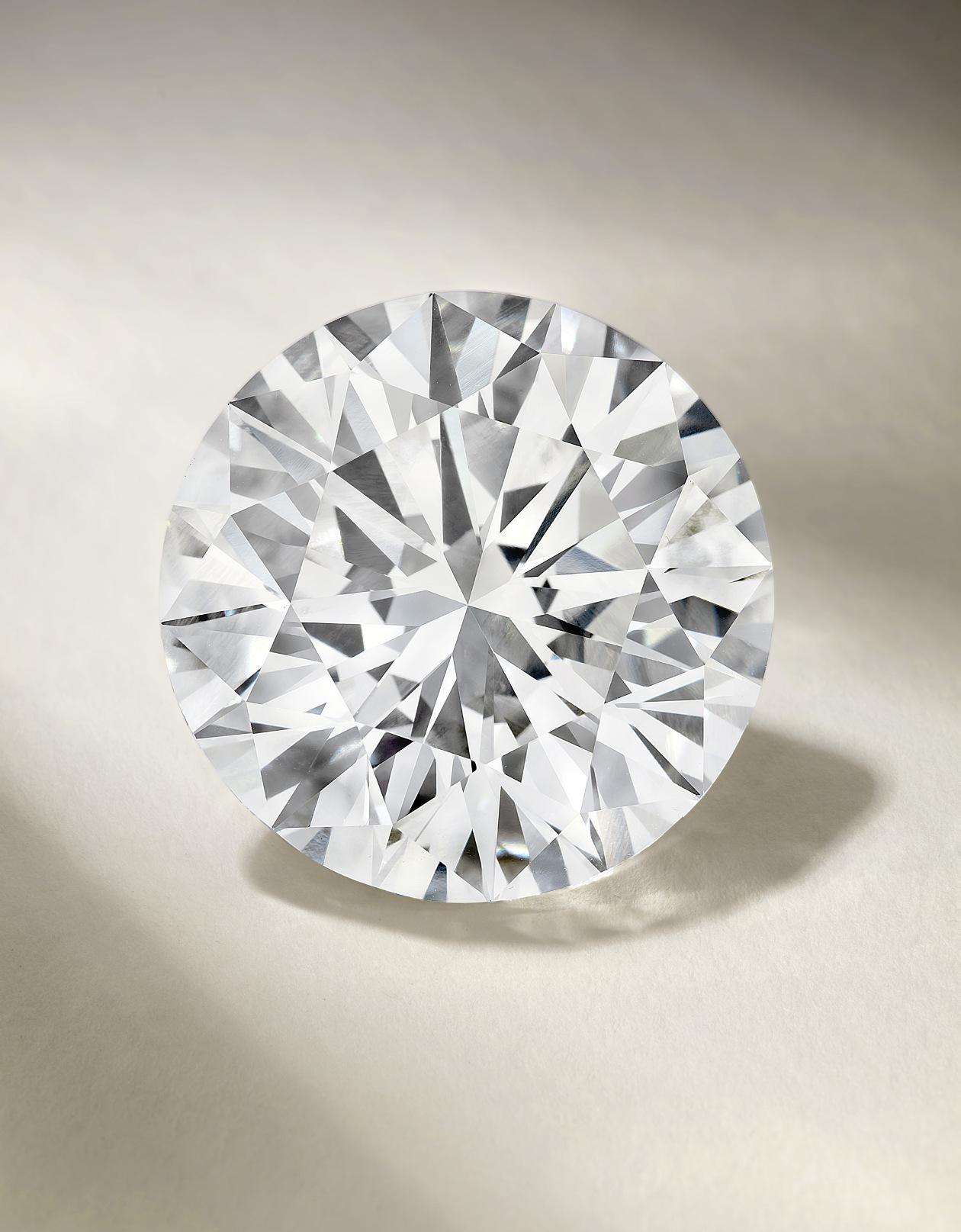

DIAMOND RIVIÈRE NECKLACE
Round brilliant-cut diamonds, round diamonds, platinum
GIA, 2024, report no. 2235425075: 5.12 carats, I color, VS2 clarity
GIA, 2024, report no. 1232424799: 3.62 carats, H color, SI2 clarity
GIA, 2024, report no. 5231424792: 3.51 carats, J color, SI1 clarity
GIA, 2024, report no. 1236424797: 3.02 carats, L color, SI1 clarity
GIA, 2024, report no. 5231424802: 2.94 carats, I color, SI2 clarity
Size/Dimensions: 38.1 cm (15 in)
Gross Weight: 60.7 grams
$100,000-150,000



86 (two views)
DIAMOND BYPASS BANGLE BRACELET
Rectangular, half-moon, baguette and tapered baguette-cut diamonds, platinum, circa 1950
Size/Dimensions: inner circumference 15.9 cm (6º in), inner diameter 5.4 cm (2¿ in)
Gross Weight: 99.7 grams
$70,000-100,000
COLORED DIAMOND AND DIAMOND RING
Fancy light yellow cut-cornered rectangular modified brilliant-cut diamond of 12.01 carats, emerald-cut diamonds, platinum and 18k yellow gold
GIA, 2025, report no. 14779154: 12.01 carats, Fancy Light Yellow, natural color, VVS2 clarity
Size/Dimensions: US ring size 6º
Gross Weight: 11.4 grams
$80,000-120,000
LEARN MORE
LEARN MORE

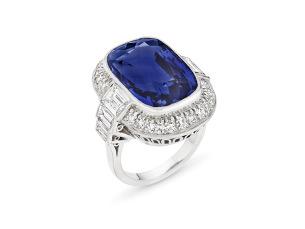
87 (two views)
TIFFANY & CO. SAPPHIRE AND DIAMOND RING
Cushion mixed-cut sapphire, baguette-shaped and single-cut diamonds, platinum, signed Tiffany & Co.
AGL, 2025, report no. 1147900: Ceylon, no gemological evidence of heat, no clarity enhancement
Size/Dimensions: US ring size 6Ω
Gross Weight: 18.6 grams
$80,000-120,000
LEARN MORE
Marion Rumsey Cartier
Born in New York in April of 1911, Marion Rumsey Cartier was the daughter of Pierre Cartier - one of the three legendary Cartier brothers that were the masterminds of one of the most important jewelry houses ever to date. Her mother, Elma Rumsey, was the daughter of Moses Rumsey, a wealthy industrialist from Saint Louis. Marion grew up on both sides of the Atlantic, with homes in Paris and New York, however her Saint Louis heritage was always of tremendous importance.
In April of 2001, Christie’s was honored to offer the Marion Rumsey Cartier Collection at Saint Louis University which benefited the university. Her legacy to the University included photographs, letters and paintings documenting her fascinating life. The preservation of these documents on both sides of her family are a showcase of social history in the twentieth century and give the observer a glimpse of the life of a wealthy family during a time of enormous change.
Previously offered in 2001, Cartier collectors and enthusiasts now have a wonderful opportunity to add to their collection a diamond steeped in Cartier family history.


88 (two views)
DIAMOND RING
Round brilliant-cut diamond of 8.21 carats, platinum
GIA, 2025, report no. 11201231: 8.21 carats, D color, VS1 clarity
Size/Dimension: US ring size 5
Gross Weight: 9.9 grams
$180,000-220,000
PROVENANCE:
Marion Rumsey Cartier (1911-1994)
Christie's, New York, 11 April 2001, Sale 9624, Lot 422 (diamond only)
LEARN MORE
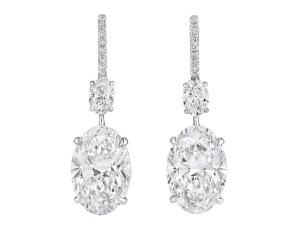
DIAMOND EARRINGS
Oval brilliant-cut diamonds of 7.07, 7.02, 0.52 and 0.51 carats, round diamonds, platinum
GIA, 2025, report no. 2231487179: 7.07 carats, D color, Flawless, excellent polish and symmetry, Type IIa
GIA, 2025, report no. 6237437096: 7.02 carats, D color, Flawless, excellent polish and symmetry, Type IIa
GIA, 2025, report no. 6512287865: 0.52 carat, D color, Internally Flawless, excellent polish and symmetry
GIA, 2025, report no. 6511327518: 0.51 carats, D color, Internally Flawless, excellent polish and symmetry
Size/Dimensions: 3.1 cm (1º in)
Gross Weight: 10.9 grams
$550,000-750,000
90 NO LOT


RUBY AND DIAMOND RING
Cushion mixed-cut ruby of 2.91 carats, tapered baguette and single-cut diamonds, platinum, circa 1950
AGL, 2025, report no. 1145986: 2.91 carats, Burma, no gemological evidence of heat, clarity enhancement: none Gübelin, 2025, report no. 25032015: 2.91 carats, Burma, no indications of heating, with Information Sheet on unheated rubies
Size/Dimensions: US ring size 5Ω
Gross Weight: 3.4 grams
$40,000-60,000
$200,000-300,000 91


92
DIAMOND RING
Oval brilliant-cut diamond of 10.11 carats, marquise-cut diamonds, platinum, circa 1960
GIA, 2025, report no. 8567013: 10.11 carats, F color, VS2 clarity
Size/Dimensions: measures as US ring size 3º, however, due to design fits as US ring size 4Ω
Gross Weight: 7.9 grams
92 (two views) (two views)
LEARN MORE
LEARN MORE
Important Jewels from a Distinguished American Collection Lots 93-96
Taffin
Drawn to the energetic pace of life in New York City after a childhood in northern France, James Taffin de Givenchy made the transatlantic move with the determination to find his own artistic identity. Through an early career at leading global auction houses and jewelry firms, Givenchy grew his appreciation for quality craftsmanship, design history and the importance of glamour in the every day. In 1996, Givenchy set forth with these guiding principles and established a high-jewelry salon of his own on Manhattan’s storied Madison Avenue. Focused on the use of unique and unexpected materials, such as steel, wood and ceramic, the houses’ designs are crafted to highlight the individuality of each stone, letting the material dictate the jewel’s eventual form.
The present series of rings (Lots 93 and 94) provide a sample of Taffin’s sense of lighthearted sophistication expressed through substantial gemstones brought to light with minimal styling and distinctive design. In Lot 93, a colorless, high clarity diamond converses with the varied color range of demantoid garnets, purple topazes and citrines. Lot 94 presents a richly-colored ruby in a modern presentation as surrounding diamonds snake around the wearer’s finger, the single-cut stones providing a pleasing glimmer. The rings encapsulate exactly what Taffin designs embody – the pairing of magic and charm found in the unusual, while maintaining the precision, artistry and character that inspires each coveted Taffin jewel.
TAFFIN MULTI-GEM AND DIAMOND RING
Cushion-shaped diamond of approximately 5.18 carats, round sapphires, demantoid garnets, purple topaz and citrines, rose gold, signed Taffin, numbered, brown Taffin case


Size/Dimensions: US ring size 5æ
Gross Weight: 8.5 grams
$120,000-180,000
PROVENANCE:
Christie's, Los Angeles, 6 March 2001, Sale 9698, Lot 311 (diamond only)
The diamond featured in this ring was originally purchased from Christie's Los Angeles in 2001. At that time, the diamond was accompanied by a Gübelin certificate stating that the stone was D color, Internally Flawless, together with a letter stating Type IIa classification. In order to preserve the current Taffin setting, this diamond has not been unmounted and sent for certification.
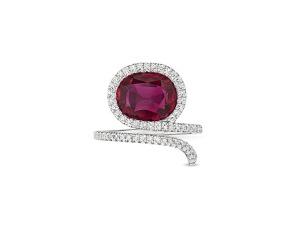
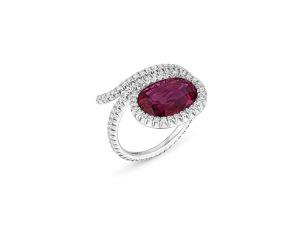
TAFFIN RUBY AND DIAMOND RING
Oval mixed-cut ruby, single-cut diamonds, platinum, signed Taffin, numbered, brown Taffin ring case
AGL, 2025, report no. 1147509: Thailand, no gemological evidence of heat
Size/Dimensions: measures as US ring size 5æ, however, due to design fits as US ring size 5Ω
Gross Weight: 5.4 grams
$50,000-70,000
(two views)
(two views)
LEARN MORE
LEARN MORE
Hemmerle
Coveted by discerning collectors and jewelry connoisseurs worldwide, Hemmerle was founded in 1893 by Joseph and Anton Hemmerle after they acquired an existing goldsmith in Munich, Germany. Originally crafting medals, orders, and jewels for German nobility and the Bavarian Royal Family, their craftsmanship achieved international acclaim in 1900 when the house was honored with a prize at the Exposition Universelle for a Bishop’s Cross set with gemstones and enamel. The cross is now a highlight of the permanent collection at the Metropolitan Museum of Art.
Continuously pushing the boundaries of high jewelry with unique metal choices paired with exceptionally exquisite gemstones and unexpected color combinations, Hemmerle’s one-of-a-kind designs are prized amongst the most respected collectors.
The present Diamond and Bombe Earrings (Lot 95) and Hardstone Cameo Pendant-Brooch Necklace (Lot 96), both fashioned from blackened silver and white gold, exemplify the house’s use of metal combinations that create texture, depth and dimension. The earrings extend outward with inversely-set diamonds while the juxtaposition of a muted green hardstone cameo within a faceted green emerald and tsavorite garnet surround highlights Hemmerle’s notorious ability to fascinate the eye. Their commitment to advancing contemporary jewelry design is readily apparent in their jewels and these two examples are no exception.

HEMMERLE DIAMOND BOMBÉ EARRINGS
Inversely-set diamonds, blackened silver and 18k white gold, signed Hemmerle, maker's mark
Size/Dimensions: 2.2 x 2.2 cm (√ x √ in)
Gross Weight: 24.4 grams
$30,000-50,000
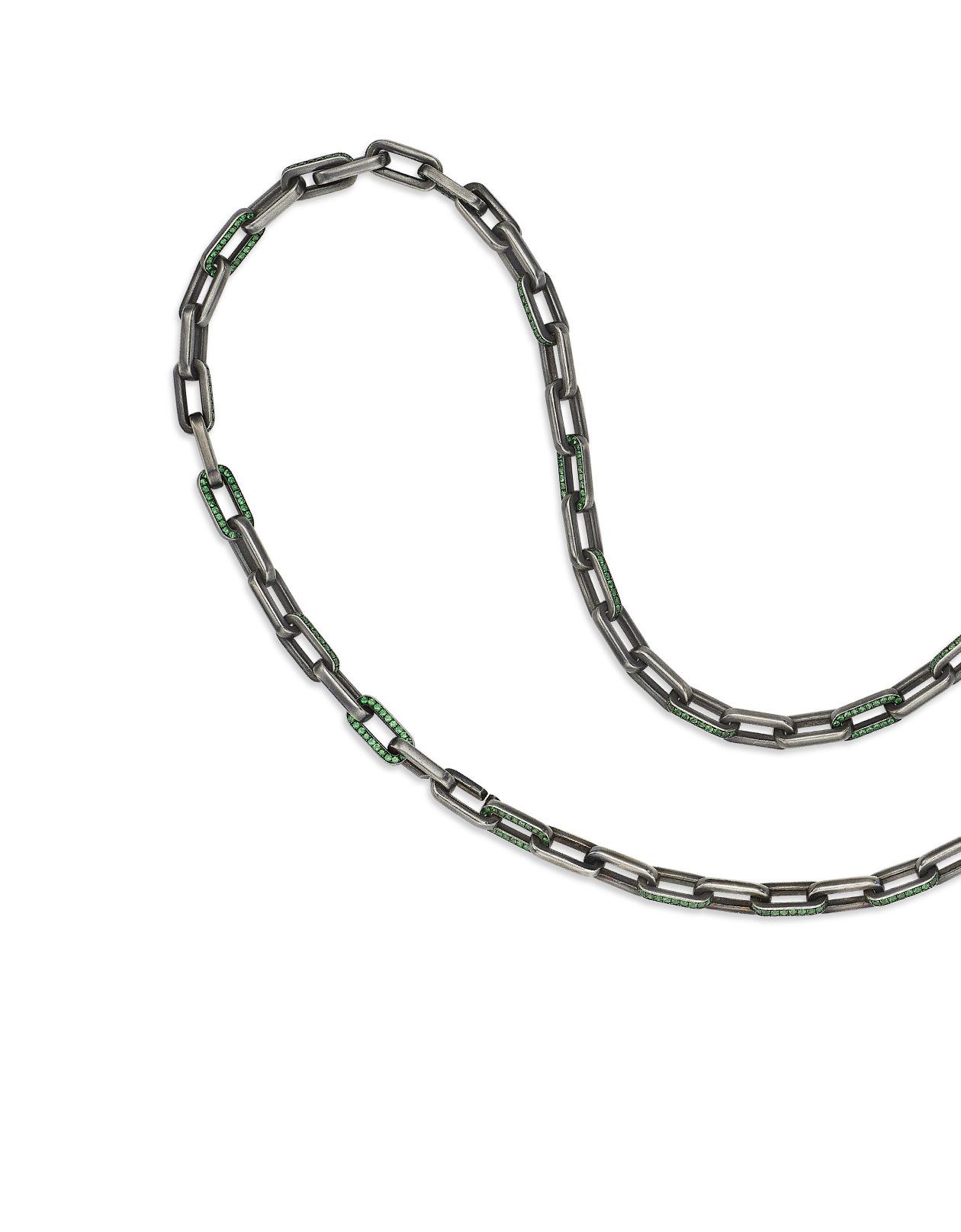
Important Jewels from a Distinguished American Collection
Lots 93-96
LEARN MORE








A PAIR OF IMPRESSIVE DIAMOND PENDANT EARRINGS
Pear brilliant-cut diamonds of 34.57 and 34.14 carats, round diamonds, platinum and 18k white gold
GIA, 2024, report no. 5232443940: 34.57 carats, M color VS1 clarity, excellent polish and symmetry
GIA, 2024, report no. 2231443318: 34.14 carats, L color, VS1 clarity, excellent polish and symmetry
Size/Dimensions: 4.4 cm (1æ in)
Gross Weight: 29.5 grams
$1,200,000-1,800,000
SHOULD YOU WISH TO BID ON THIS LOT, YOU WILL BE REQUIRED TO OBTAIN A HIGH VALUE PADDLE.
LEARN MORE
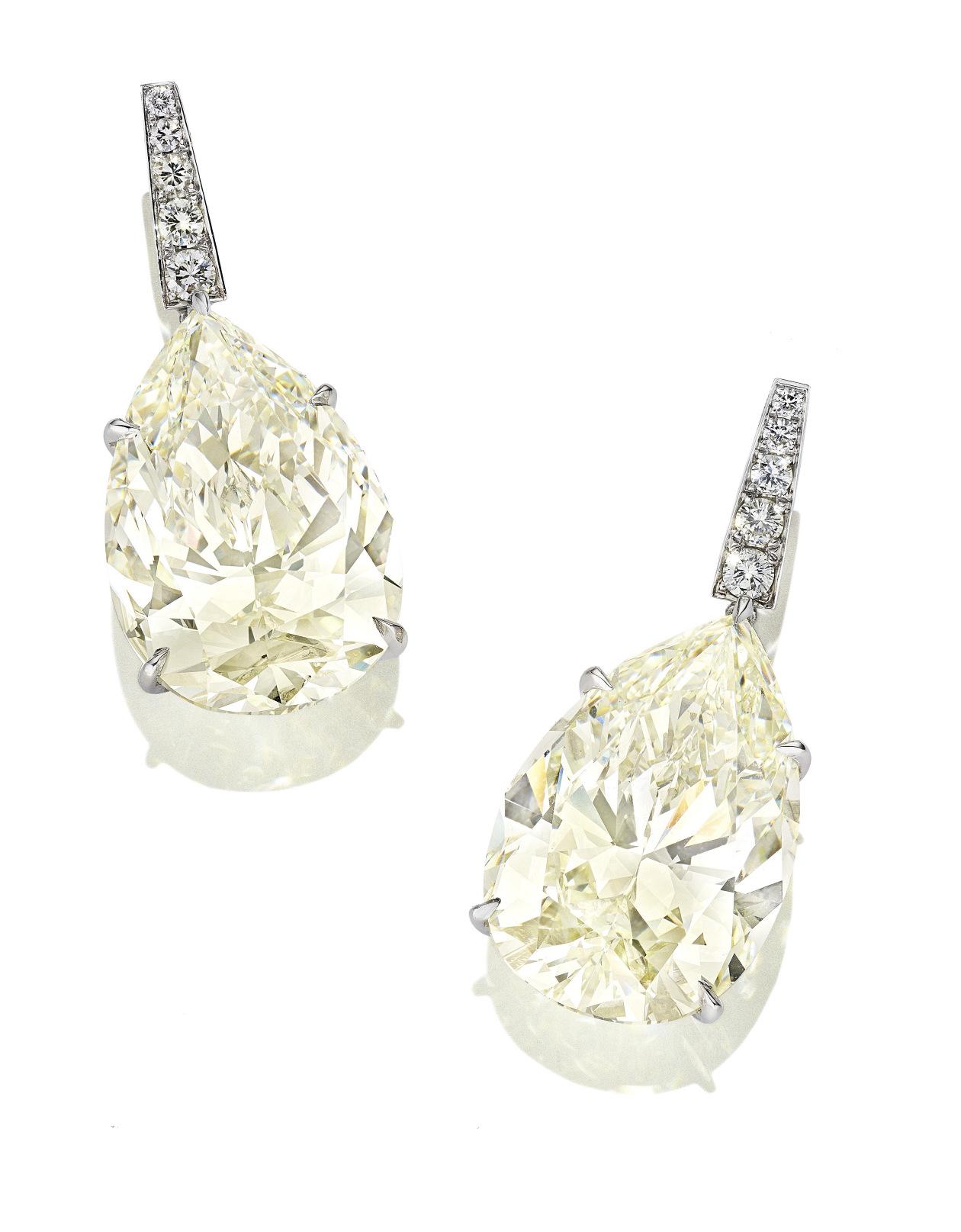
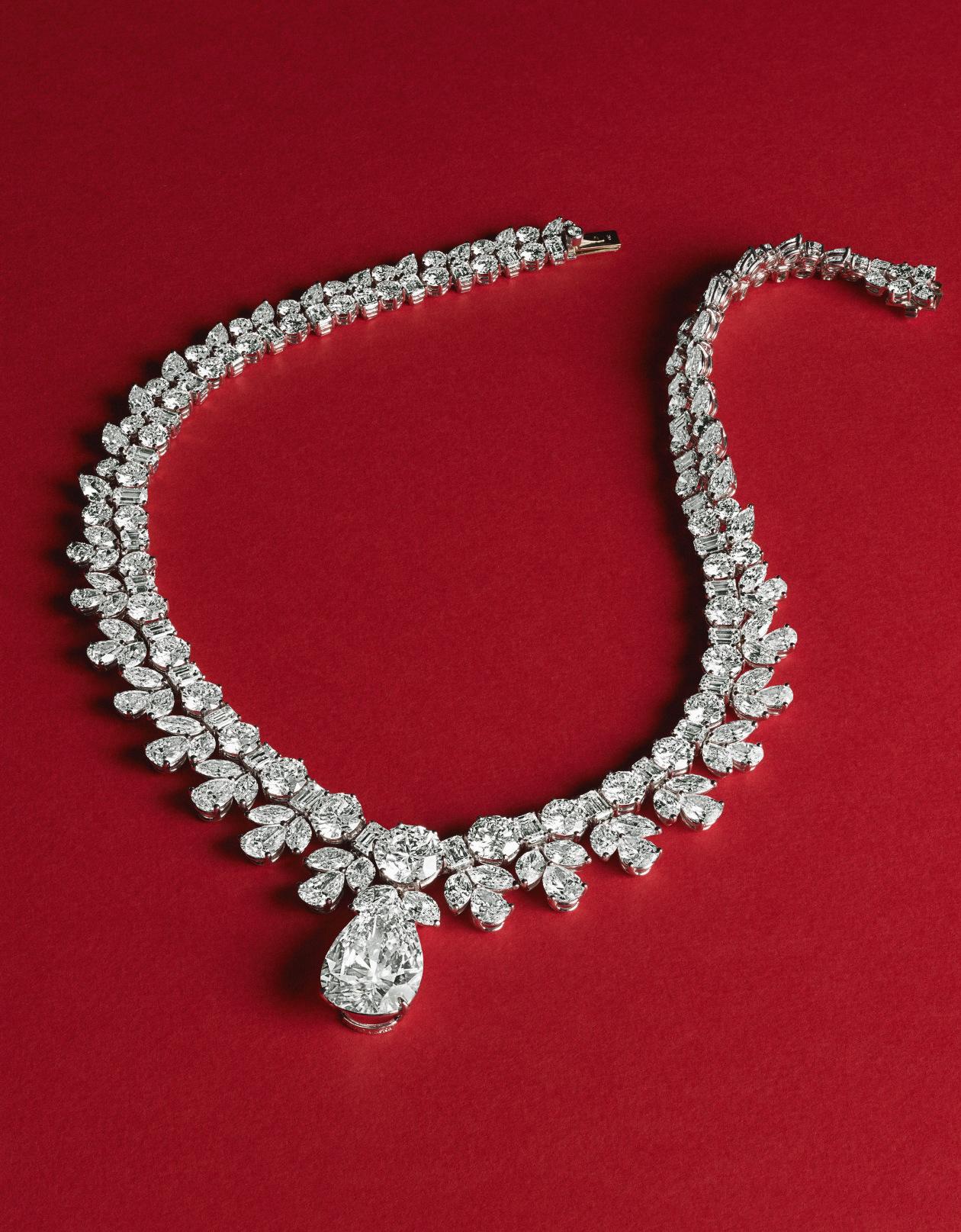
Important Jewels from a Distinguished Family Collection
Important Jewels from a Distinguished Family Collection Lots 98-111
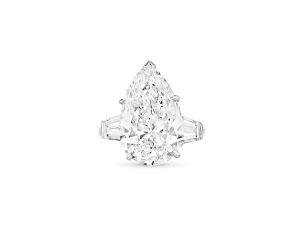

JACQUES TIMEY DIAMOND RING
Pear modified brilliant-cut diamond of 8.12 carats, tapered baguette-cut diamonds, maker's mark (Jacques Timey)
GIA, 2025, report no. 1232529429: 8.12 carats, D color, VVS1 clarity, potentially Internally Flawless, Type IIa
Size/Dimensions: US ring size 5æ
Gross Weight: 8.0 grams
$150,000-200,000
(two views)

Important Jewels from a Distinguished Family Collection Lots 98-111 (two views)
VAN CLEEF & ARPELS DIAMOND AND RUBY EARRINGS
Old mine brilliant-cut diamonds of 4.98 and 4.69 carats, round rubies and diamonds, yellow gold, circa 1970, signed Van Cleef & Arpels, N.Y., S.O., numbered
GIA, 2025, report no. 2231537336: 4.98 carats, L color, SI1 clarity GIA, 2025, report no. 1232537280: 4.69 carats, L color, VS2 clarity
Size/Dimensions: 2.8 x 2.8 cm (1¿ x 1¿ in)
Gross Weight: 30.6 grams
$40,000-60,000


100
100 DIAMOND RING
Emerald-cut diamond of 7.03 carats, tapered baguette-cut diamonds, platinum
GIA, 2025, report no. 6237529383: 7.03 carats, E color, VS1 clarity
Size/Dimensions: US ring size 5º
Gross Weight: 6.0 grams
$100,000-150,000
Important Jewels from a Distinguished Family Collection Lots 98-111

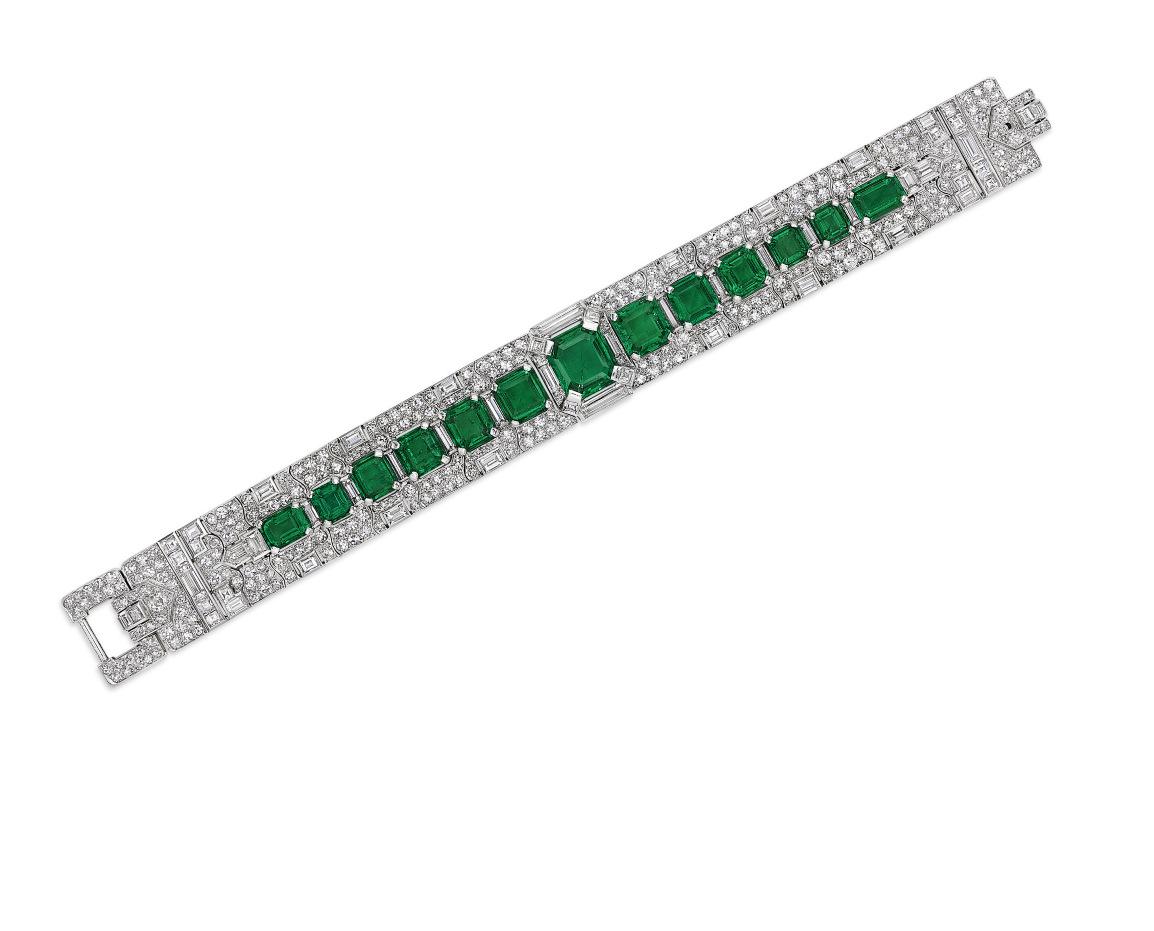
Size/Dimensions: 6.0 x 2.2 cm (2¡ x √ in)
Gross Weight: 16.6 grams
$80,000-120,000
PROVENANCE:
Christie’s, London, 8 December 1993, Sale 5099, Lot 285
Made in France (partially indistinct), maker's mark (Gustave Renault), numbered
AGL, 2025, report no. 1146971: Colombia, clarity enhancement: minor, type: traditional
Size/Dimensions: 18.4 x 1.9 cm (7º x æ in)
Gross Weight: 56.8 grams
$200,000-300,000
LEARN MORE
LEARN MORE

Important Jewels from a Distinguished Family Collection
Lots 98-111


103
CARTIER EMERALD AND DIAMOND RING
Rectangular emerald-cut emerald of 9.08 carats, oval and baguette-cut diamonds, platinum and yellow gold, signed Cartier, numbered
AGL, 2025, report no. 1147267: 9.08 carats, Colombia, minor clarity enhancement, traditional type
Size/Dimensions: measures as US ring size 4æ, however, due to sizer fits as US ring size 3æ
Gross Weight: 10.3 grams
$250,000-350,000

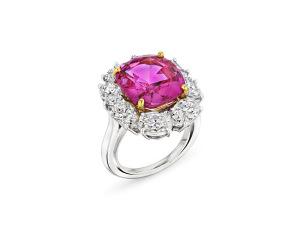
104
AN EXCEPTIONAL CARTIER COLORED SAPPHIRE AND DIAMOND RING
Cushion mixed-cut pink sapphire of 8.06 carats, oval-shaped diamonds, platinum and yellow gold, signed Cartier, numbered
SSEF, 2025, report no. 146231: 8.06 carats, Burma, no indications of heating AGL, 2025, report no. 1147268: 8.06 carats, Ceylon, no gemological evidence of heat, clarity enhancement: none
Size/Dimensions: measures as US ring size 5, however, due to sizer fits as US ring size 3Ω
Gross Weight: 10.0 grams
$150,000-200,000


105
CARTIER SAPPHIRE AND DIAMOND RING
Rectangular emerald-cut sapphire of 15.59 carats, triangular-shaped diamonds, platinum, signed Cartier, numbered
AGL, 2025, report no. 1147268: 15.59 carats, Burma, no gemological evidence of heat
Size/Dimensions: measures as US ring size 4Ω, however, due to sizer fits as US ring size 3Ω
Gross Weight: 9.1 grams
$100,000-150,000
(two views)
(two views) (two views)
LEARN MORE
LEARN MORE
LEARN MORE

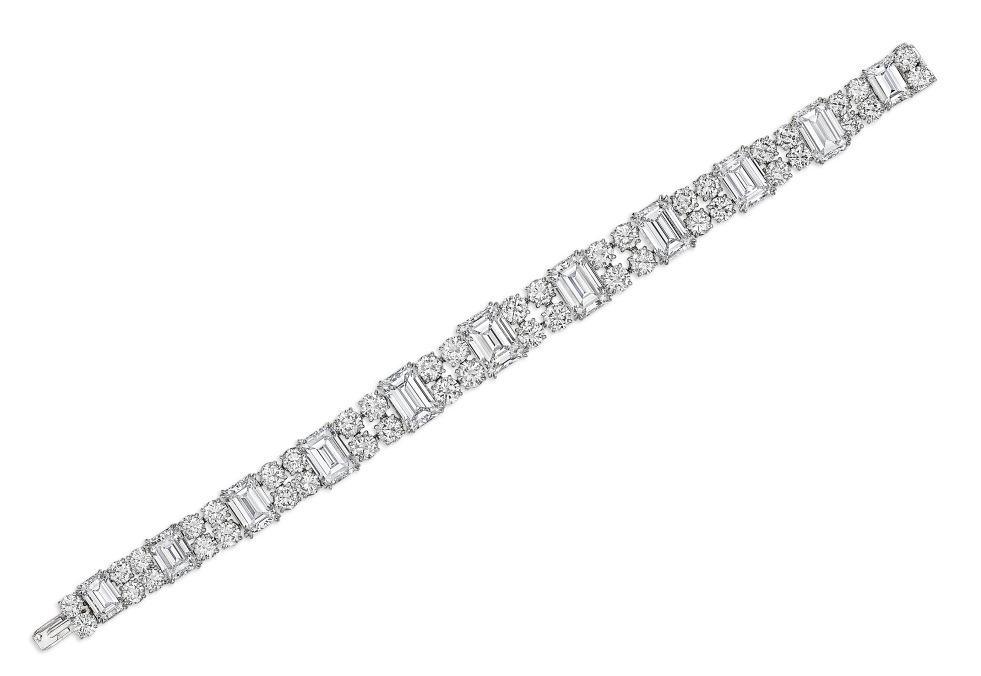
106
A SUPERB BOUCHERON DIAMOND BRACELET
Eleven emerald-cut diamonds ranging from 3.60 to 1.39 carats, round diamonds, platinum and 18k white gold (French marks), circa 1950, signed Boucheron Paris, maker’s mark (Atelier de Joaillerie Vendôme)
GIA, 2025, report no. 2235535551: 3.60 carats, D color, VS1 clarity
GIA, 2025, report no. 5231535477: 3.33 carats, D color, VVS1 clarity, potentially Internally Flawless
GIA, 2025, report no. 2235535328: 3.09 carats, D color, VVS1 clarity, potentially Internally Flawless
GIA, 2025, report no. 5231535553: 2.87 carats. D color, VVS2 clarity
GIA, 2025, report no. 1232535556: 2.81 carats, D color, VVS1 clarity
GIA, 2025, report no. 2235535493: 2.64 carats, D color, VVS2 clarity
GIA, 2025, report no. 5232535562: 2.40 carats, E color, VVS1 clarity, potentially Internally Flawless
GIA, 2025, report no. 6233535555: 2.32 carats, D color, VVS1 clarity, potentially Internally Flawless
GIA, 2025, report no. 6237535559: 2.06 carats, D color, VVS1 clarity
GIA, 2025, report no. 2231534923: 1.59 carats, D color, VVS1 clarity, potentially Internally Flawless
GIA, 2025, report no. 5231534925: 1.39 carats, D color, VVS2 clarity
Size/Dimensions: 17.7 x 0.9 cm (7 x ¡ in)
Gross Weight: 44.1 grams
$120,000-180,000
PROVENANCE:
Sotheby’s, New York, 16 April 1992, Sale 6287, Lot 432 Important Jewels from a Distinguished Family Collection Lots 98-111
LEARN MORE
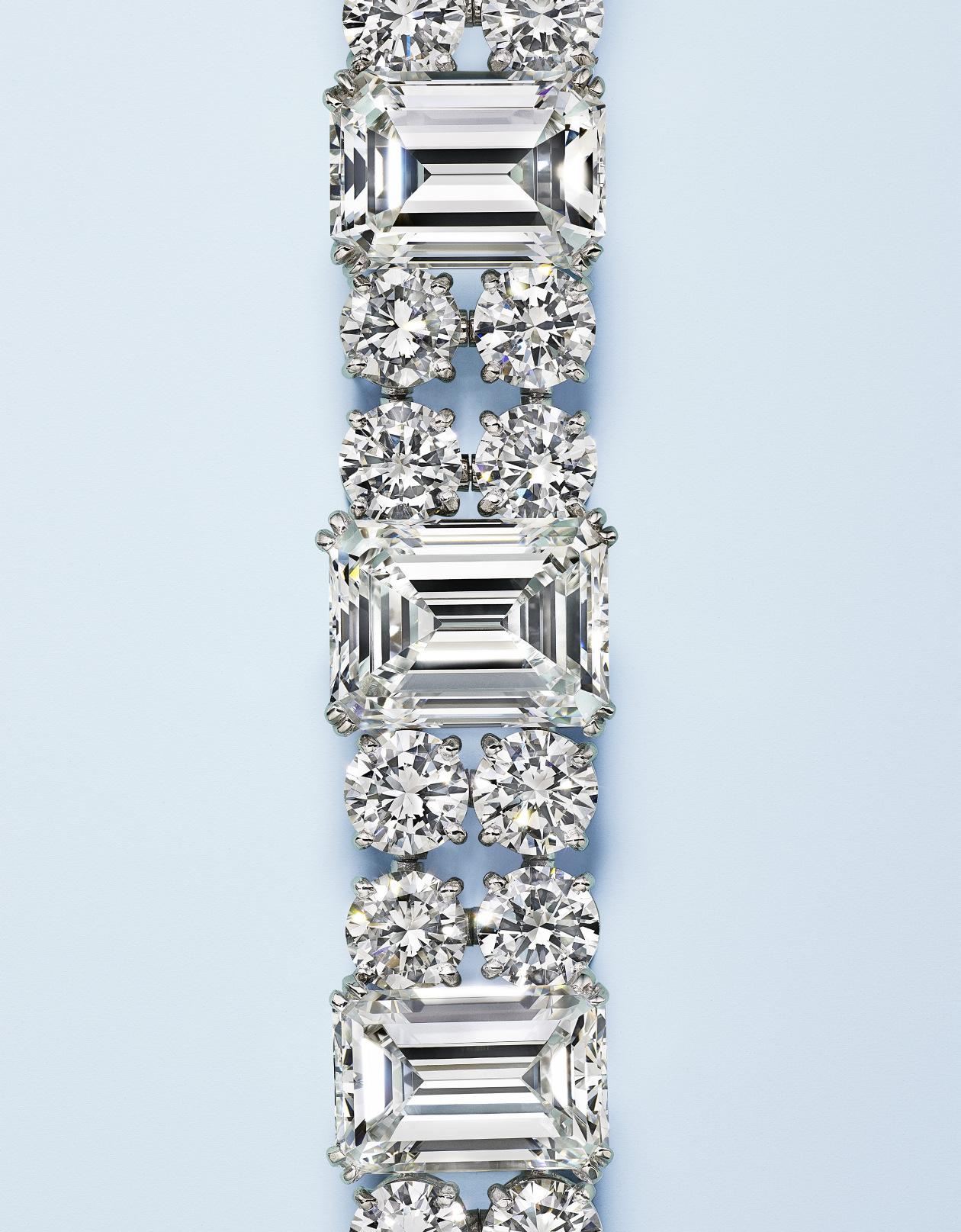



107
CARTIER DIAMOND RING
Cut-cornered rectangular step-cut diamond of 12.06 carats, triangular-cut diamonds, platinum, signed Cartier (partially indistinct), numbered
GIA, 2025, report no. 2235529031: 12.06 carats, D color, VVS1 clarity, potentially Internally Flawless
Size/Dimensions: US ring size 6
Gross Weight: 8.4 grams
$150,000-200,000
108
HARRY WINSTON EMERALD AND DIAMOND EARRINGS
Pear modified brilliant-cut emeralds of 9.70 and 9.50 carats, marquise-shaped diamonds, platinum and yellow gold, maker's mark, numbered
AGL, 2025, report no. 1147143 A and B: 9.70 and 9.50 carats, Colombia, minor clarity enhancement, modern type
Size/Dimensions: 2.4 x 1.6 cm (√ x ¬ in)
Gross Weight: 15.1 grams
$100,000-150,000
Important Jewels from a Distinguished Family Collection
Lots 98-111

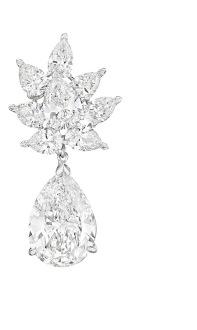
PETOCHI DIAMOND EARRINGS
Pear brilliant-cut diamonds of 7.96 and 7.89 carats, pear-cut diamonds, platinum and 18k white gold, signed G. Petochi, pendants detachable
GIA, 2025, report no. 2235557312: 7.96 carats, D color, VVS2 clarity, potentially Internally Flawless, Type IIa
GIA, 2025, report no. 5232557310: 7.89 carats, D color, VVS1 clarity, potentially Internally Flawless, Type IIa
Size/Dimensions: 3.8 x 1.2 cm (1Ω x Ω in), without pendants 1.9 x 1.5 cm (æ x ¬ in)
Gross Weight: 22.0 grams
$350,000-550,000
Important Jewels from a Distinguished Family Collection Lots 98-111


(two views)
A FINE COLORED DIAMOND RING
Light blue pear brilliant-cut diamond of 17.98 carats, platinum
GIA, 2025, report no. 5232529029: 17.98 carats, Light Blue, natural color, VVS2 clarity, potentially Internally Flawless, Type IIb
Size/Dimensions: measures as US ring size 4 however, due to sizer fits as US ring size 3Ω
Gross Weight: 8.7 grams
$1,000,000-1,500,000
PROVENANCE:
Sotheby's, New York, 15 - 16 April 1992, Sale 6287, Lot 431
SHOULD YOU WISH TO BID ON THIS LOT, YOU WILL BE REQUIRED TO OBTAIN A HIGH VALUE PADDLE.
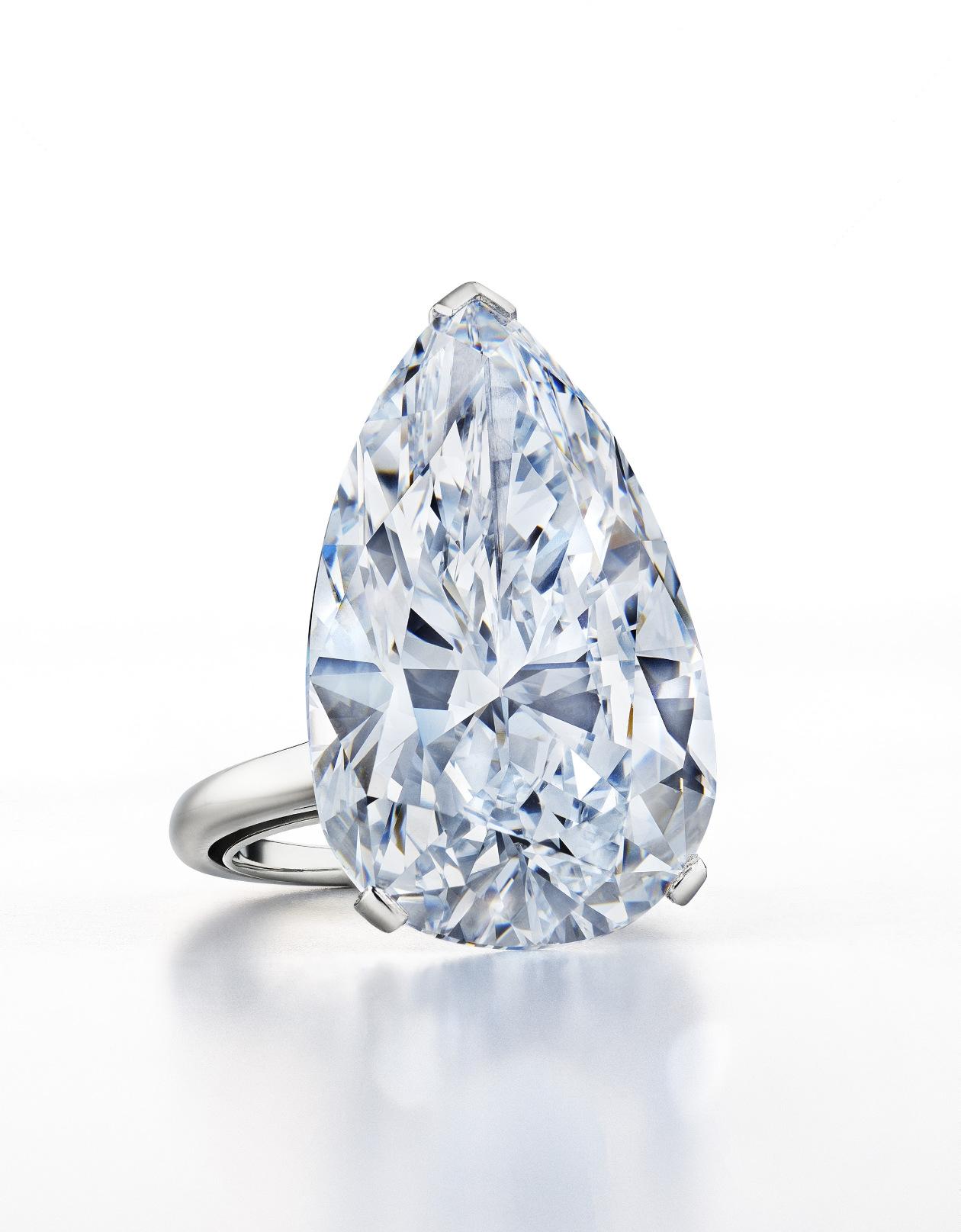
Important Jewels from a Distinguished Family Collection Lots 98-111
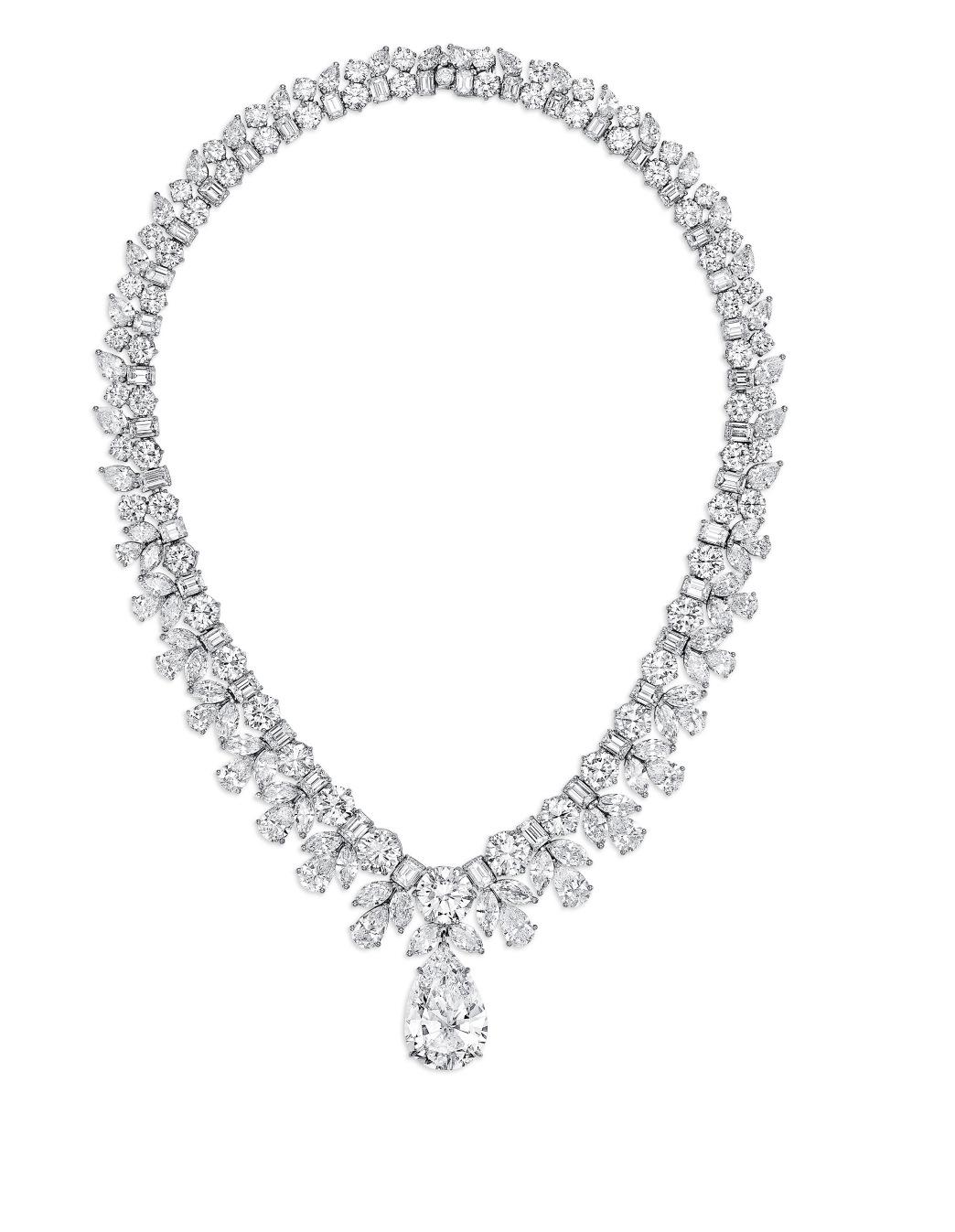
AN EXCEPTIONAL HARRY WINSTON DIAMOND PENDANT NECKLACE
Pear brilliant-cut diamond of 17.50 carats, round brilliant-cut diamond of 5.01 carats, round, pear, emerald and marquise-shaped diamonds, platinum and 18k white gold, signed Winston, maker’s mark (Jacques Timey)
GIA, 2025, report no. 2235529025: 17.50 carats (pear), D color, VVS1 clarity, potentially Internally Flawless, Type IIa GIA, 2025, report no. 6233530494: 5.01 carats (round), D color, SI1 clarity
Size/Dimensions: 40.6 cm (16 in)
Gross Weight: 116.8 grams
$1,200,000-1,800,000
SHOULD YOU WISH TO BID ON THIS LOT, YOU WILL BE REQUIRED TO OBTAIN A HIGH VALUE PADDLE.
LEARN MORE

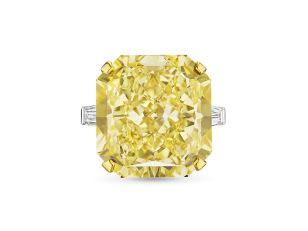
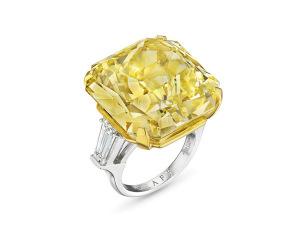
AN IMPRESSIVE GRAFF COLORED DIAMOND AND DIAMOND RING
Fancy intense yellow cut-cornered rectangular modified brilliant-cut of 43.59 carats, tapered baguette-cut diamonds, 18k yellow gold and platinum, signed Graff
GIA, 2025, report no. 5161367738: 43.59 carats, Fancy Intense Yellow, natural color, VS2 clarity
Size/Dimensions: US ring size 5º Gross Weight: 19.1 grams
$500,000-700,000
(two views)

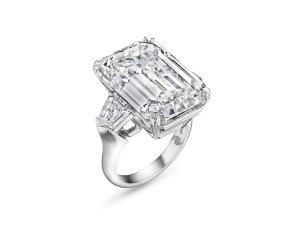
AN ELEGANT HARRY WINSTON DIAMOND RING
Emerald-cut diamond of 23.26 carats, shield-shaped diamonds, platinum, maker's mark
GIA, 2025, report no. 5171509207: 23.26 carats, D color, Internally Flawless, Type IIa
Size/Dimensions: US ring size 6
Gross Weight: 16.4 grams
$1,200,000-1,800,000
SHOULD YOU WISH TO BID ON THIS LOT, YOU WILL BE REQUIRED TO OBTAIN A HIGH VALUE PADDLE.
(two views)

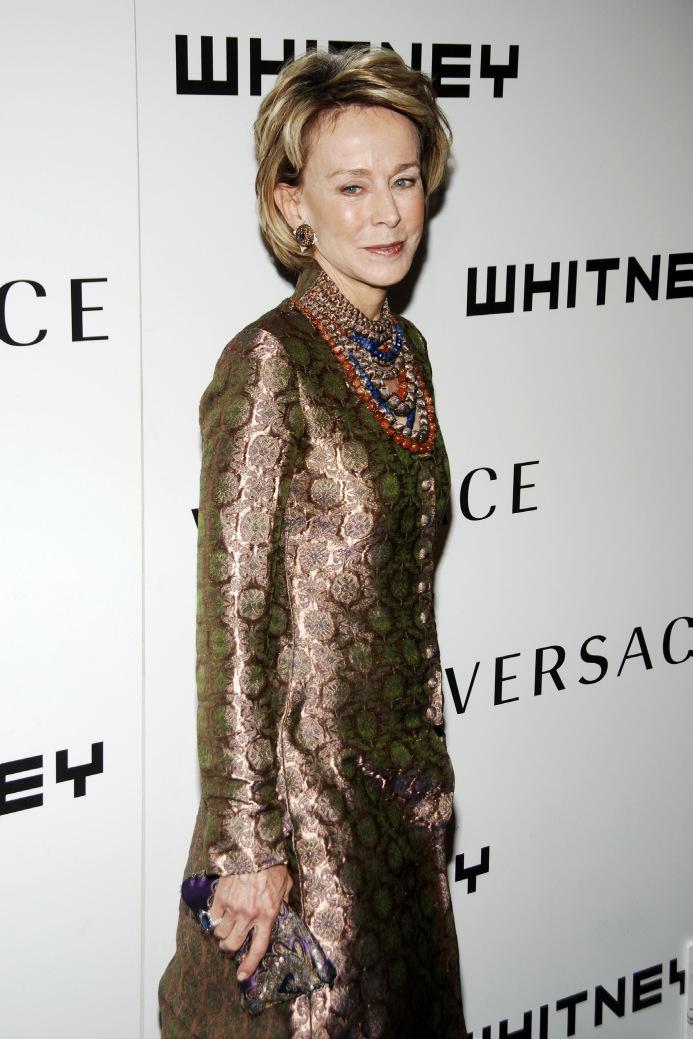
Anne Bass wearing Lots 134 and 135 at The Whitney Gala and Studio Party in 2009
Nick Hunt/PMC
A leading philanthropist, visionary collector and tireless patron of the arts, Anne Hendricks Bass (1941 – 2020) was widely admired for her refined eye, intellectual rigour and deep commitment to beauty in all its forms. She was one of New York’s most respected philanthropists supporting the New York Botanical Garden, the Museum of Modern Art and the New York Public Library for the Performing Arts. Additionally, her efforts to save Texas Ballet Theatre from bankruptcy and her 25-year tenure on the New York City Ballet board created a lasting impact on American arts.
During her lifetime, Mrs. Bass was celebrated not only for her philanthropic spirit and enduring commitment to the arts, but also for her refined taste, timeless elegance, and exceptional eye for beauty. Lots 114 to 139 showcase the fine collection of jewels assembled with discernment and passion over decades, and comes from Mrs. Bass’s personal collection. It represents one of the most impeccably curated private jewelry collections to appear on the market. The collection features the exceptional pieces of famed houses such as Van Cleef & Arpels, Bulgari and Cartier. Most notably, it features one of the finest private assemblages of jewels by the legendary Joel Arthur Rosenthal, widely known as JAR. Many of these exceptional works are featured in the landmark 2002 publication JAR Volume I, making this sale a rare opportunity to acquire creations of profound beauty and historical importance.
Mrs. Bass’ legacy and refined spirit endure, not only through her remarkable patronage of the arts but also through this extraordinary collection of jewelry.



VAN CLEEF & ARPELS RUBY AND DIAMOND BROOCH
Oval cabochon rubies, round diamonds, yellow and white gold, signed Van Cleef & Arpels N.Y, numbered
Size/Dimensions: 4.7 x 5.3 cm (1√ x 2¿ in)
Gross Weight: 90.8 grams
$15,000-20,000
115
VAN CLEEF & ARPELS RUBY AND DIAMOND RING
Oval ruby cabochon, calibré-cut, tapered baguette and round diamonds, yellow gold, signed Van Cleef & Arpels, numbered
Size/Dimensions: US ring size 6Ω
Gross Weight: 18.0 grams
$15,000-20,000
115 (two views)

VAN CLEEF & ARPELS CULTURED PEARL, RUBY AND DIAMOND CHOKER NECKLACE
Round cultured pearls of approximately 9.78 to 6.80 mm, near-round ruby beads, round diamonds, yellow gold, signed Van Cleef & Arpels
Size/Dimensions: 31.7 cm (12Ω in)
Gross Weight: 117.8 grams
$20,000-30,000

(detail)
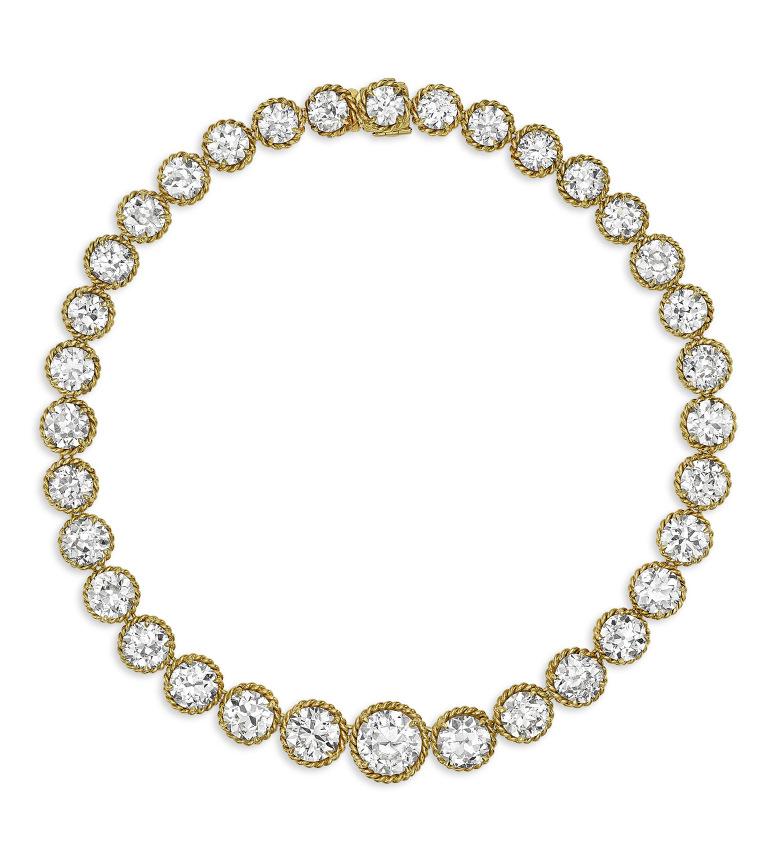

117
VAN CLEEF & ARPELS DIAMOND RIVIÈRE NECKLACE
Round and old-cut diamonds, yellow gold, signed VCA, NY
GIA, 2025, report no. 1232565628 (largest diamond): 4.65 carats, H color, SI1 clarity
GIA, 2025, report no. 1232565938: 3.05 carats, L color, SI1 clarity GIA, 2025, report no. 1236565826: 2.73 carats, J color, SI1 clarity
Size/Dimensions: 34.2 cm (13Ω in)
Gross Weight: 56.5 grams
$200,000-300,000
118
VAN CLEEF & ARPELS DIAMOND AND GOLD EARRINGS
Round brilliant-cut diamonds of 4.03 and 4.00 carats, tapered baguette-cut diamonds, yellow gold, signed Van Cleef & Arpels, numbered
GIA, 2025, report no. 5232551250: 4.03 carats, K color, VVS1 clarity, potentially Internally Flawless GIA, 2025, report no. 2231551249: 4.00 carats, J color, VVS2 clarity
Size/Dimensions: 2.2 cm (√ in)
Gross Weight: 19.5 grams
$50,000-70,000
LEARN MORE
LEARN MORE



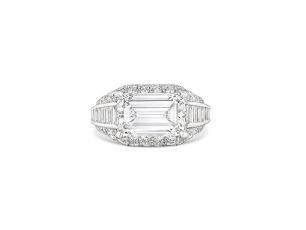
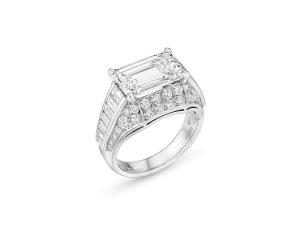
119
VAN CLEEF & ARPELS DIAMOND RING
Marquise brilliant-cut diamond of 3.58 carats, baguette, tapered baguette and round diamonds, yellow gold, signed Van Cleef & Arpels, numbered
GIA, 2025, report no. 6237557716: 3.58 carats, E color, SI1 clarity
Size/Dimensions: US ring size 6
Gross Weight: 11.6 grams
$20,000-30,000
120
BULGARI DIAMOND ‘TROMBINO’ RING
Emerald-cut diamond of 3.73 carats, baguette-cut and round diamonds, platinum, signed Bvlgari, maker’s mark
GIA, 2025, report no. 5232557720: 3.73 carats, D color, VVS2 clarity, potentially Internally Flawless
Size/Dimensions: US ring size 6
Gross Weight: 12.0 grams
$40,000-60,000
120 (two views)
(two views)
LEARN MORE
LEARN MORE
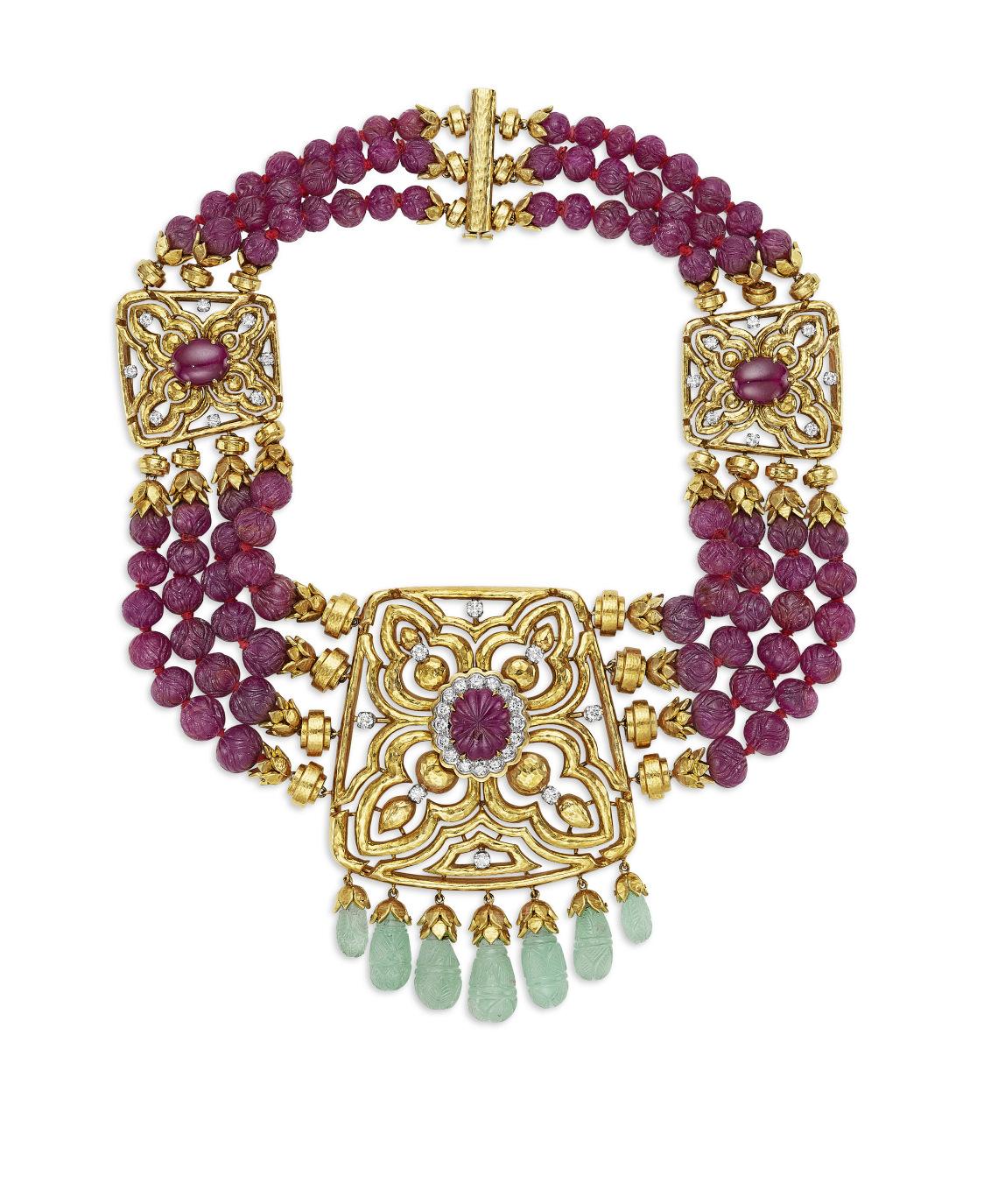
DAVID WEBB CARVED RUBY, CARVED EMERALD AND DIAMOND 'MOGHUL' NECKLACE
Carved ruby, carved ruby beads and oval ruby cabochons, carved emerald drops, round diamonds, hammered 18k yellow gold and platinum, circa 1981, signed Webb
Size/Dimensions: 33 cm (13 in), central motif drop length 8.3 cm (3º in)
Gross Weight: 285.3 grams
$30,000-50,000
LITERATURE:
R. Peltason, David Webb, The Quintessential American Jeweler, New York, Assouline, 2013, p. 270-271

LEARN MORE
DAVID WEBB CULTURED PEARL, DIAMOND, ONYX AND ENAMEL 'TWILIGHT' NECKLACE
Baroque cultured pearls, round diamonds, carved onyx rings, black enamel, 18k yellow gold and platinum, circa 1979, signed Webb
Size/Dimensions: longest length 71.7 cm (28º in), shortest length 37.4 cm (14æ in), tassel pendant 9.5 cm (3æ in)
Gross Weight: 322.88 grams
$20,000-30,000
LITERATURE:
Cf. R. Peltason, David Webb: The Quintessential American Jeweler, New York, Assouline, 2013, p. 113


BULGARI SAPPHIRE, DIAMOND AND CULTURED PEARL CHOKER NECKLACE
Oval-shaped sapphires, round diamonds, round cultured pearls, 18k yellow gold (French mark), signed Bvlgari, numbered, maker's mark
Size/Dimensions: inner circumference 35.5 cm (14 in)
Gross Weight: 311.6 grams
$20,000-30,000


VAN CLEEF & ARPELS SAPPHIRE AND DIAMOND NECKLACE
Oval mixed-cut sapphires, round diamonds, 18k yellow gold (French mark), signed V.C.A., Made in France, NY, numbered
AGL, 2025, report no. 1147576: Madagascar, no evidence of heat, clarity enhancement: none
Size/Dimensions: 35.6 cm (14 in)
Gross Weight: 84.2 grams
$200,000-300,000 125
VAN CLEEF & ARPELS SAPPHIRE AND DIAMOND EARRINGS
Oval modified mixed-cut sapphires of 15.97 and 15.12 carats, round diamonds, 14k yellow gold, signed Van Cleef & Arpels, N.Y., maker's mark, numbered
AGL, 2025, report no. 1147458 A and B: 15.97 and 15.12 carats, Ceylon, no gemological evidence of heat, clarity enhancement: none
Size/Dimensions: 3.3 x 2.7 cm (1º x 1 in)
Gross Weight: 29.5 grams
$60,000-80,000

Pear, marquise and round diamonds, platinum, signed Van Cleef & Arpels, N.Y., numbered
Size/Dimensions: 3.1 x 2.8 cm (1º x 1¿ in)
Gross Weight: 23.3 grams
$80,000-120,000
VAN CLEEF & ARPELS DIAMOND CLUSTER EARRINGS

Old and baguette-cut diamonds, platinum and 18k white gold (French marks), circa 1930, signed Cartier, numbered
Size/Dimensions: 17.1 x 2.5 cm (6æ x 1 in)
Gross Weight: 79.8 grams
$150,000-250,000
CARTIER ART DECO DIAMOND BRACELET
LEARN MORE
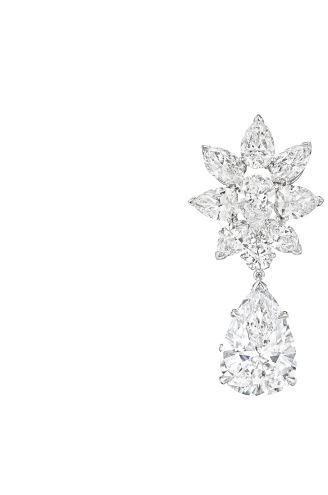

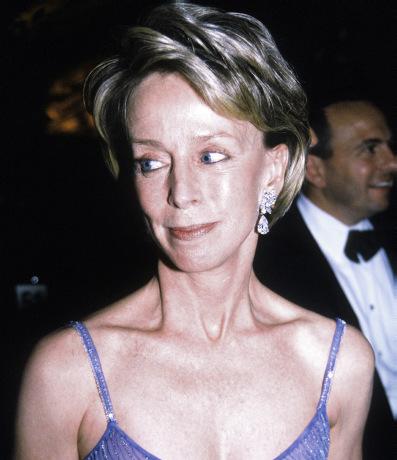
A PAIR OF SUPERB VAN CLEEF & ARPELS
DIAMOND PENDANT EARRINGS
Pear brilliant-cut diamonds of 11.93 and 11.83 carats, marquise, pear-shaped and round diamonds, platinum and white gold, signed Van Cleef & Arpels, N.Y., numbered
GIA, 2025, report no. 1236561951: 11.93 carats, D color, VS1 clarity, potentially Internally Flawless, Type IIa GIA, 2025, report no. 5231561946: 11.83 carats, D color, VVS2 clarity, potentially Internally Flawless, Type IIa
Size/Dimensions: 4.7 cm (1√ in); without pendants 2.5 cm (1 in)
Gross Weight: 29.4 grams
$1,200,000-1,800,000
SHOULD YOU WISH TO BID ON THIS LOT, YOU WILL BE REQUIRED TO OBTAIN A HIGH VALUE PADDLE.
Anne Bass wearing Lot 128 at an American Ballet Theatre formal event in 2000
Steve Eichner/Archive Photos/Getty Images
LEARN MORE
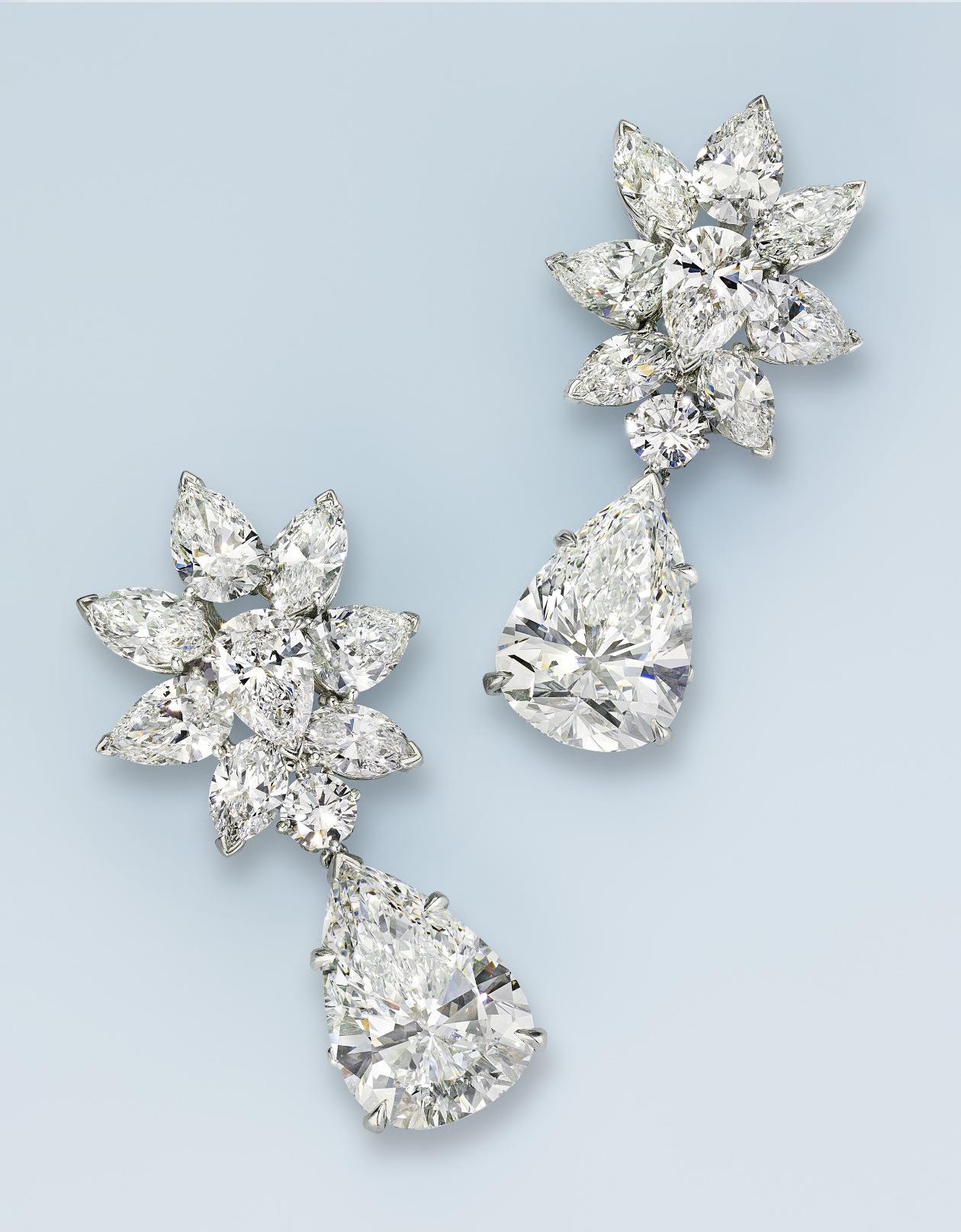
JAR
Three letters: JAR, short for Joel Arthur Rosenthal. Born in 1943 in New York, JAR has ascended to the pinnacle of the jewellery world, becoming one of the most influential artists of his era.
Despite his fame, Rosenthal remains an enigma, operating behind a veil of privacy - a forgotten word - rarely revealing more than necessary. His boutique, located at Place Vendôme in Paris, is equally elusive, marked only by a small sign bearing those three letters: JAR. Entry is by invitation.
Yet, despite—or perhaps because of—this aura of mystery, JAR is celebrated as one of the most important jewellery artists of his time. His creations, known for their sculptural beauty and meticulous craftsmanship, are coveted by collectors worldwide. Rosenthal’s ability to blend artistry with exclusivity has cemented his legacy in contemporary jewellery design.
After graduating from Harvard, Rosenthal moved to Paris and initially worked as a screenwriter and needlepoint artist, with his work in multi-colored yarns later influencing his distinctive jewellery designs. His journey took a brief detour to New York, where he worked as a salesman for Bulgari. However, Paris called him back, and in 1978, he opened his own shop.
JAR’s exclusivity extends beyond his creations. He has held only two public exhibitions: one in London in 2002 and another at The Metropolitan Museum of Art in New York in 2013. He is the only living jeweler to have had a solo exhibition at The Met.
Producing a mere 150 to 200 pieces each year, JAR’s jewellery is coveted by collectors. Each piece is a whispered secret between artist and buyer, forged for no one else. This rarity, combined with his unparalleled artistry, solidifies JAR’s status as a leading figure in the world of fine jewellery.
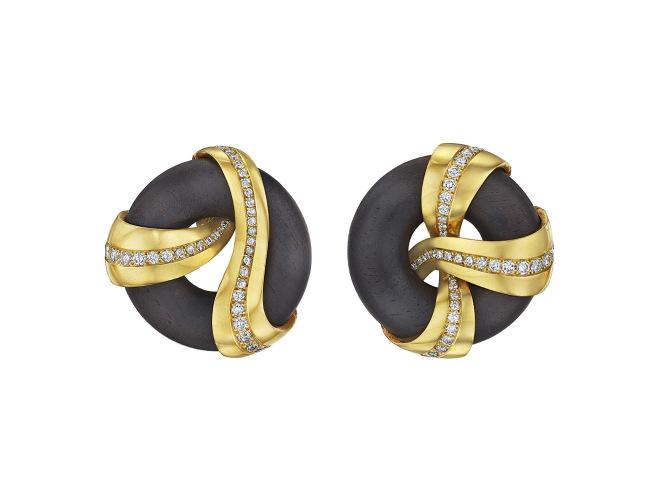
JAR WOOD AND DIAMOND EARRINGS
Wood hoops, round diamonds, 18k yellow gold (French marks), signed JAR, Paris, pink JAR pouch
Size/Dimensions: 3.5 x 3.5 cm (1¡ x 1¡ in)
Gross Weight: 54.7 grams
$20,000-30,000
LEARN MORE

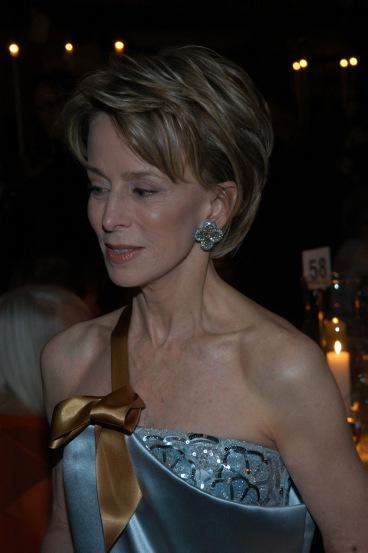
JAR COLORED DIAMOND AND DIAMOND 'VENETIAN GOTHIC' EARRINGS
Round brown diamonds and diamonds, 18k yellow gold (French marks) and blackened silver, signed JAR, Paris, fitted with pendant hooks for additional elements, pink JAR case
Size/Dimensions: 3.4 x 3.4 cm (1¡ x 1¡ in)
Gross Weight: 29.4 grams
$60,000-80,000
Please note that the colored diamonds have not been tested for natural color.
Anne Bass wearing Lot 130 at the 2005 NYCB Spring Gala WWD/Penske Media/Getty Images
LEARN MORE

JAR RUBY AND DIAMOND 'VENETIAN PORTICO' BROOCH
Round and oval ruby cabochons, oval-shaped rose-cut and round diamonds, yellow gold (French mark, partially indistinct) and silver, circa 1990, unsigned, pink JAR case
Size/Dimensions: 5.0 x 4.4 cm (2 x 1æ in)
Gross Weight: 20.5 grams
$50,000-70,000
EXHIBITED:
London, Somerset House, The Gilbert Collection Trust, Jewels by JAR Paris, 2 November 2002 - 26 January 2003
LITERATURE:
JAR Paris I, Paris, Art Books International, 2002, no. 39
LEARN MORE

A PAIR OF SENSATIONAL JAR DIAMOND, SAPPHIRE AND COLORED SAPPHIRE EARRINGS
Designed as vines, round diamonds, variously-shaped blue, yellow, pink, purple and green sapphires, 18k rose and yellow gold (French mark) and blackened silver, circa 1990, signed JAR Paris, pink JAR case
Size/Dimensions: 6.6 cm (2¬ in)
Gross Weight: 46.8 grams
$150,000-250,000
LITERATURE: JAR Paris I, Paris, Art Books International, 2002, no. 238
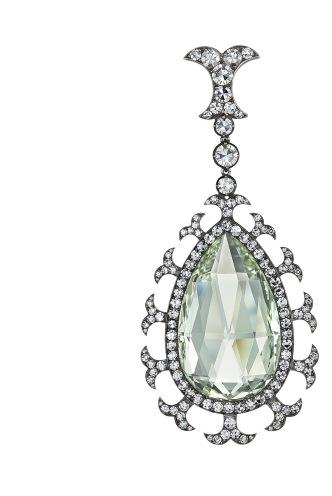
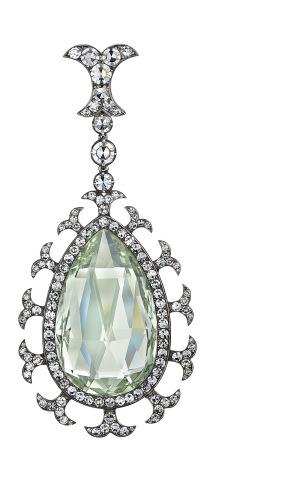
A PAIR OF ELEGANT JAR GREEN BERYL AND DIAMOND PENDANT EARRINGS
Green beryl briolette drops, round diamonds, blackened platinum and 18k yellow gold (French marks), signed JAR, Paris, pink JAR case
Size/Dimensions: 6.7 x 3.1 cm (2¬ x 1º in)
Gross Weight: 36.2 grams
$150,000-250,000

Anne Bass wearing Lot 133 at the 2007 NYCB Spring Gala Patrick McMullan/PMC
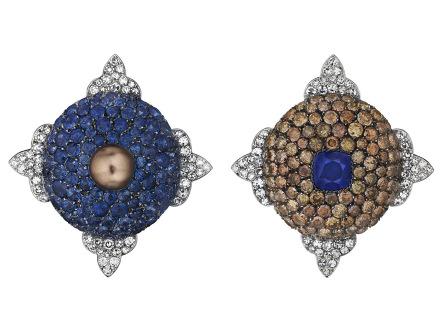
JAR NATURAL PEARL, SAPPHIRE, COLORED DIAMOND AND DIAMOND EARRINGS
Button-shaped orange brown natural pearl, cushion-shaped and round sapphires, brown colored diamonds, round diamonds, silver, platinum and 18k rose gold (French mark), circa 1991, signed JAR, Paris
GIA, 2025, report no. 5232557490: natural pearl, no indications of treatment
Size/Dimensions: 3.8 x 3.4 cm (1Ω x 1¡ in)
Gross Weight: 25.1 grams
$100,000-150,000
LITERATURE:
JAR Paris I, Paris, Art Books International, 2002, no. 288
Please note that the brown diamonds have not been tested for natural color.


135
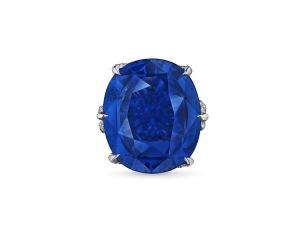


JAR SAPPHIRE AND
DIAMOND
'BRAID' RING
Oval modified mixed-cut sapphire of 23.92 carats, round diamonds, platinum, unsigned, Paris, pink JAR pouch
AGL, 2025, report no. 1147815: 23.92 carats, Ceylon, no gemological evidence of heat, clarity enhancement: none
Size/Dimensions: due to design fits approximately as US ring size 2
Gross Weight: 13.6 grams
$60,000-80,000
136
JAR DIAMOND 'SPIRALS' EARRINGS
Round diamonds, platinum, unsigned, clip backs initialed 'J', pink JAR case
Size/Dimensions: one earring 3.8 x 2.5 cm (1Ω x 1 in), second earring 3.5 x 3.2 cm (1¡ x 1º in)
Gross Weight: 34.7 grams
$40,000-60,000
LITERATURE:
Cf. JAR Paris I, Paris, Art Books International, 2002, no. 18
(two views)
LEARN MORE
LEARN MORE
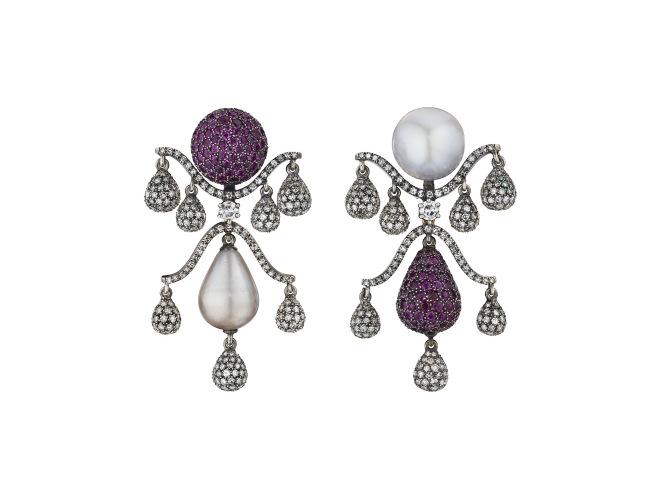
A PAIR OF MAGNIFICENT JAR NATURAL PEARL, RUBY AND DIAMOND EARRINGS
Drop and button-shaped natural pearls, round rubies and diamonds, silver and 18k yellow gold (French mark), circa 1990, signed JAR, Paris
GIA, 2025, report no. 6233552755: natural pearls, saltwater, no indications of treatment
Size/Dimensions: 4.4 x 2.2 cm (1æ x √ in)
Gross Weight: 36.2 grams
$100,000-150,000
LITERATURE:
JAR Paris I, Paris, Art Books International, 2002, no. 151
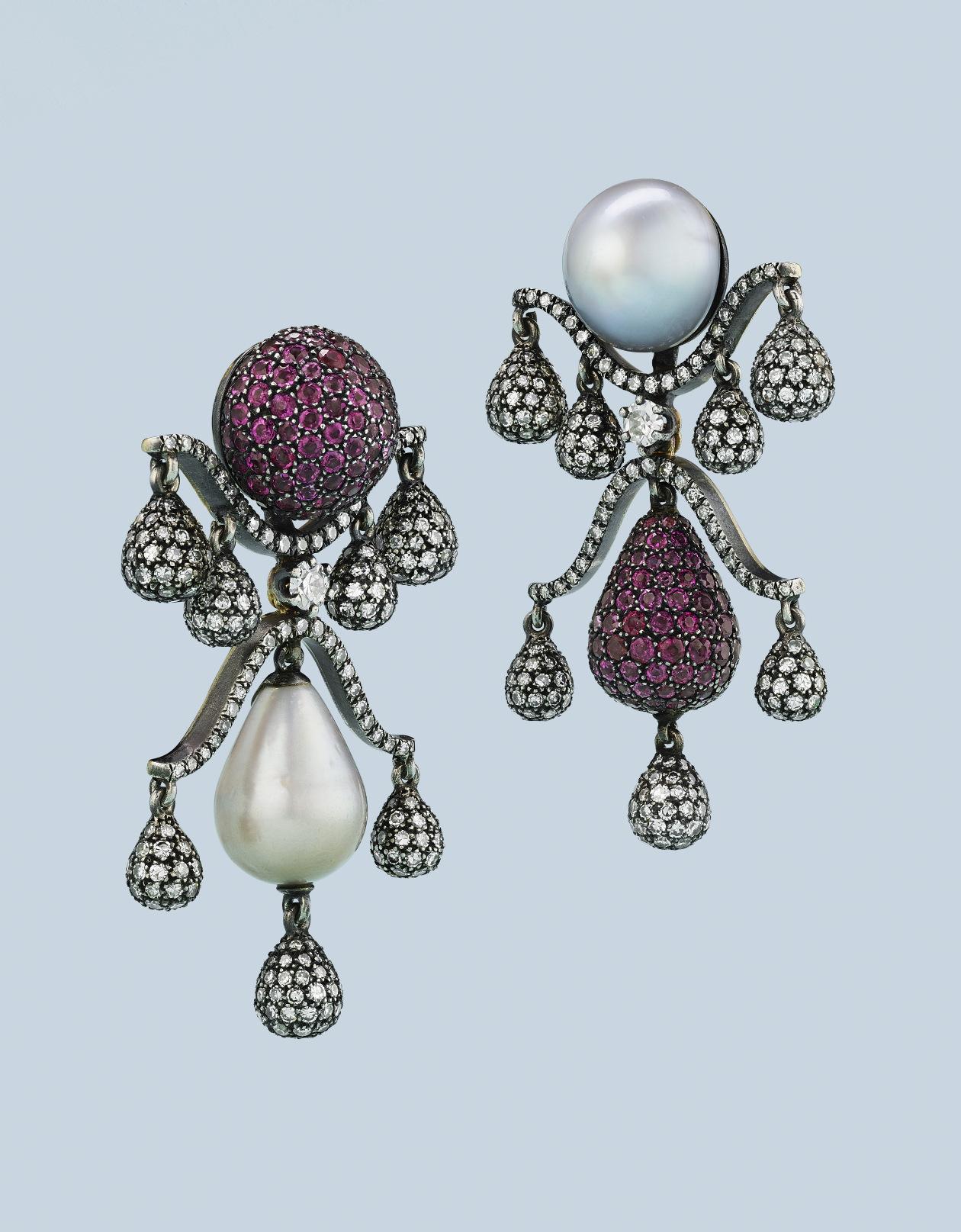


JAR SAPPHIRE, GREEN GARNET AND DIAMOND EARRINGS
Round sapphires, green garnets and diamonds, platinum and 18k yellow gold (French marks), signed JAR, Paris, pink JAR pouch
Size/Dimensions: 2.2 x 2.2 cm (√ x √ in)
Gross Weight: 15.5 grams
$40,000-60,000
Anne Bass wearing Lots 138 and 139 with André Leon Talley at the opening gala of The Martha Graham Dance Company held at The Plaza Hotel in 2004 Patrick McMullan/PMC
LEARN MORE

AN EXCEPTIONAL JAR SAPPHIRE, EMERALD AND DIAMOND NECKLACE
Drop briolette emeralds, faceted sapphire beads, round diamonds, platinum and 18k white gold (French marks), circa 1991, signed JAR, Paris, pink JAR case and envelope pouch
AGL, 2025, report no. 1147511: Twenty-two largest gemstones tested, emerald, clarity enhancement: insignificant to minor, type: traditional
Size/Dimensions: shortest strand 35.6 cm (14 in)
Gross Weight: 250.4 grams
$200,000-300,000
EXHIBITED:
London, Somerset House, The Gilbert Collection Trust, Jewels by JAR Paris, 2 November 2002 - 26 January 2003
LITERATURE:
JAR Paris I, Paris, Art Books International, 2002, no. 250
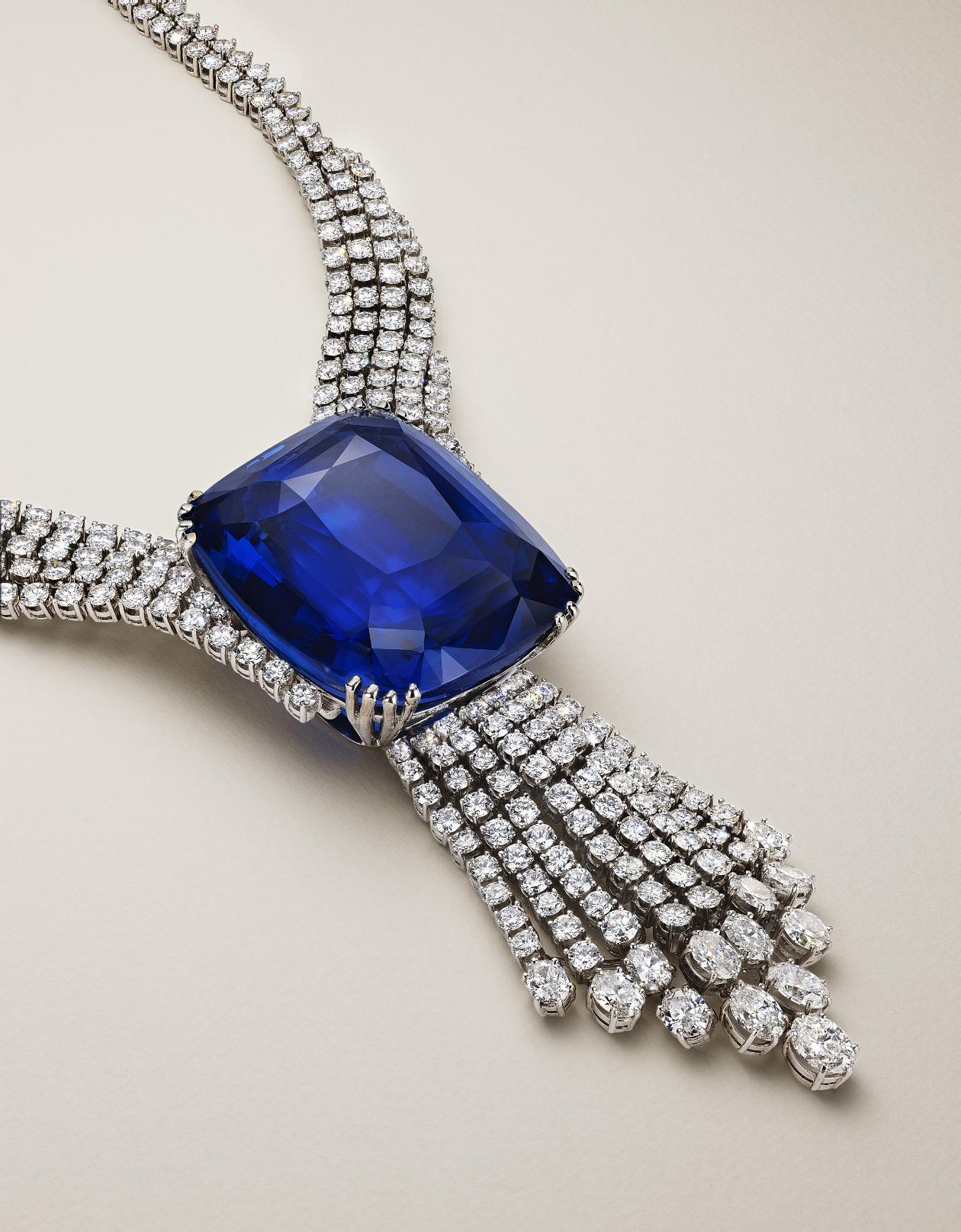
THE BLUE BELLE
A Superb Sapphire and Diamond Necklace
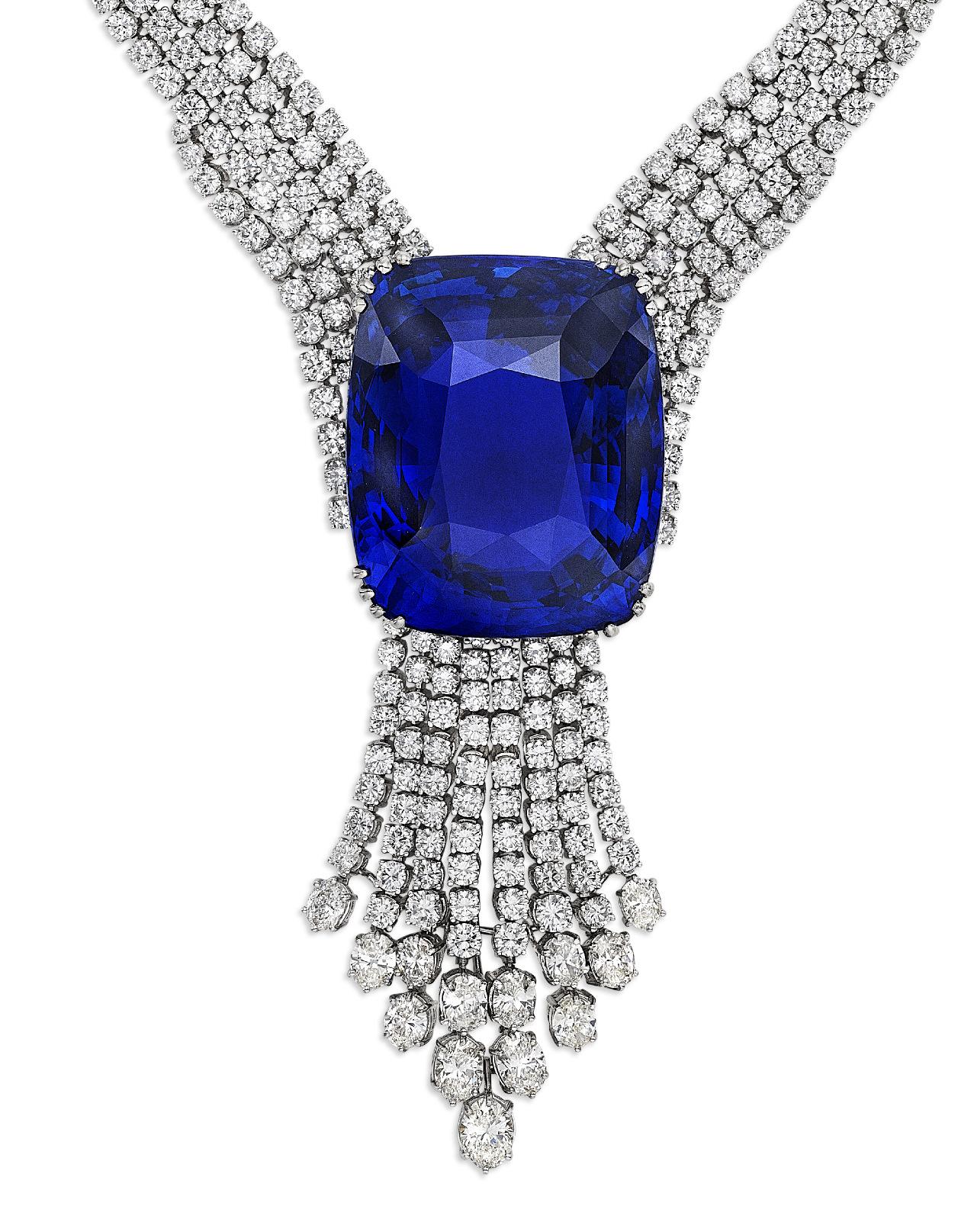

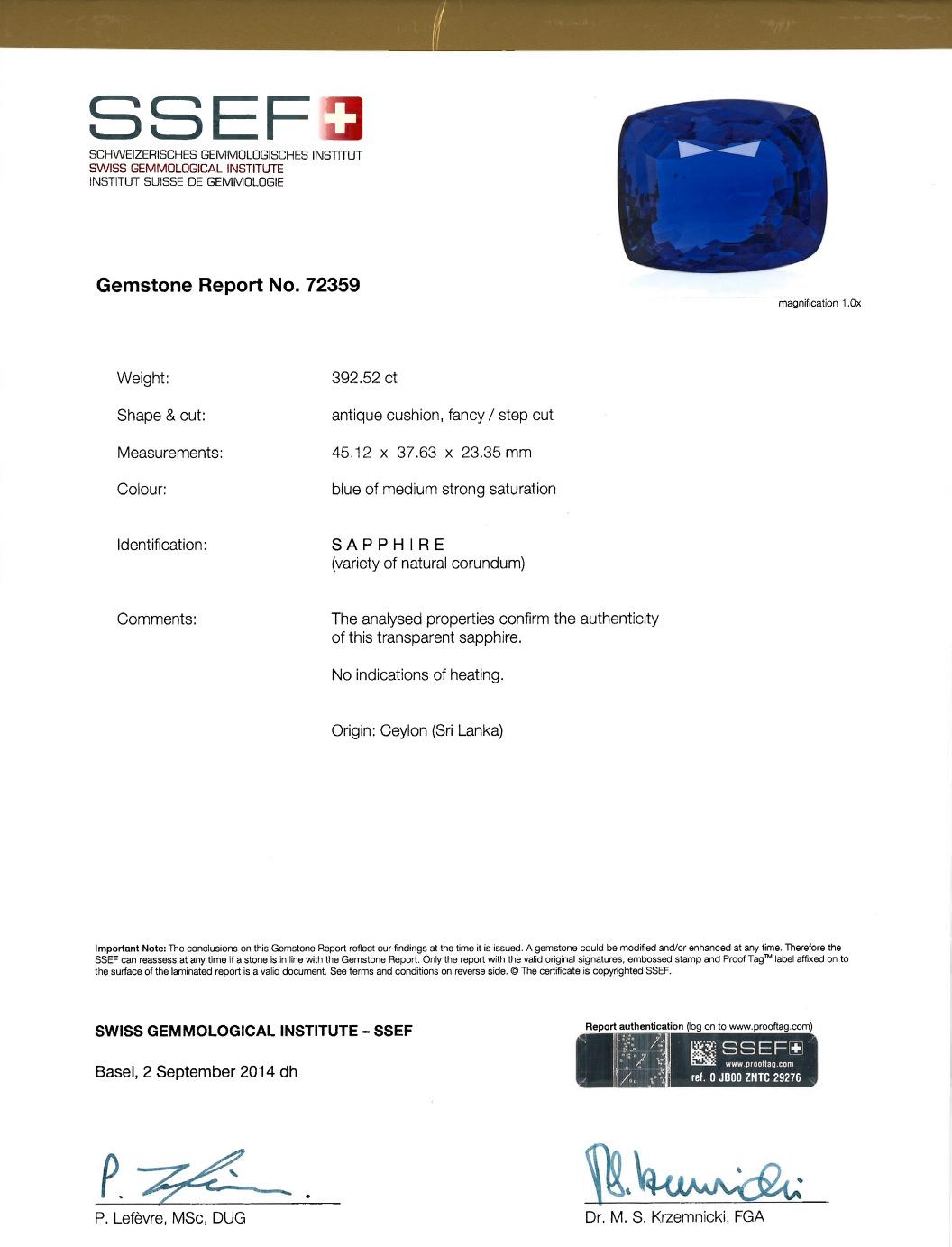


The Blue Belle stands out as one of the world’s rarest sapphires, both in size and quality. Sapphires over 100 carats are extremely rare, and few are known by name. Even among royal collections, examples of this caliber are scarce. The Iranian Crown Jewels list only three sapphires of note, the largest weighing 191.58 carats. The Kremlin’s Diamond Treasury holds a 250-carat cornflower blue sapphire from the former Russian royal regalia. Another, linked to Catherine the Great, weighs 337 carats. Yet despite these remarkable stones, the Blue Belle remains nearly unmatched at 392.52 carats.
From the very short list of faceted sapphires weighing over 350 carats, the Blue Belle has always remained a mystery. After the Blue Giant of the Orient (486.52 carats), the Queen of Romania's Sapphire (478.68 carats) and the Logan Sapphire (423 carats), this legendary sapphire has a lesser known history.
Uncovered in 1926 at Pelmadula, Ratnapura ('The City of Gems') in Ceylon, it is difficult to locate information regarding the exact weight or shape of the Blue Belle at the time of it’s discovery. It is often mentioned that it was 'valued at 50,000' in 1928, 'weighing approximately 400 carats after having been cut and polished'. It had a 'highly prized peacock blue color and excellent clarity' and was owned by the well-known gem and jewelry dealers Macan Markar in Colombo. The famous firm, established in 1860 by O. L. M. Macan Markar, had one of the most spectacular collections of gems which attracted the world’s most discerning collectors, including several members of the British Royal family including HM King Edward VII and HM King George V.
In 1937, the Blue Belle was sold to British motor magnate Lord Nuffield (1877-1963). The founder of Morris Motors Limited, he was also an important philanthropist and in the 1920s, he had made his first substantial public benefaction. In 1937, Lord Nuffield founded and endowed Nuffield College, Oxford and in 1943 he gave $10 million to form the Nuffield Foundation. The trust was designed to benefit medical research, hospitals and education. At the time of his death in 1963, he had given away more than $32 million to charitable institutions.
The reasons behind his purchase of the Blue Belle were mysterious. It was reported that the sapphire was to be presented to HM Queen Elizabeth the Queen Mother on her coronation day on 12 May 1937. Instead, the Blue Belle 'disappeared' into private hands and that its location was unknown for the next 35 years. According to records from the 1970s, the famous Swiss based gem-dealer Theodore Horovitz had the opportunity to examine the sapphire. His notes and drawings give precious additional information on the shape and weight of the gem.
Most recently in 2014, the Blue Belle was thrust into the spotlight at Christie's in Geneva. It was revealed as a necklace centering upon the spectacular sapphire and achieved an astounding price of $17.3 million.
Sapphires of this size, color and clarity are extremely rare. This magnificent specimen ranks as one of the most prestigious colored gems to have come to the market and Christie's is honored to once again present the Blue Belle to our extraordinary collectors.

The Blue Belle
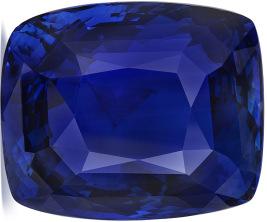
(illustrated unmounted)
A SUPERB SAPPHIRE AND DIAMOND NECKLACE
Cushion modified mixed-cut sapphire of 392.52 carats, round and oval-shaped diamonds, 18k white gold
AGL, 2025, report no. 1147856: 392.52 carats, Classic Ceylon, no gemological evidence of heat, clarity enhancement: none
Gübelin, 2014, report no. 1490018: 392.52 carats, Ceylon, no indications of heating, appendix letter
SSEF, 2014, report no. 72359: 392.52 carats, Ceylon, no indications of heating
Size/Dimensions: 44.4 cm (17Ω in)
Gross Weight: 234.5 grams
$8,000,000-12,000,000
PROVENANCE:
Christie's, Geneva, 11 November 2014, Sale 1405, Lot 348
SHOULD YOU WISH TO BID ON THIS LOT, YOU WILL BE REQUIRED TO OBTAIN A HIGH VALUE PADDLE.
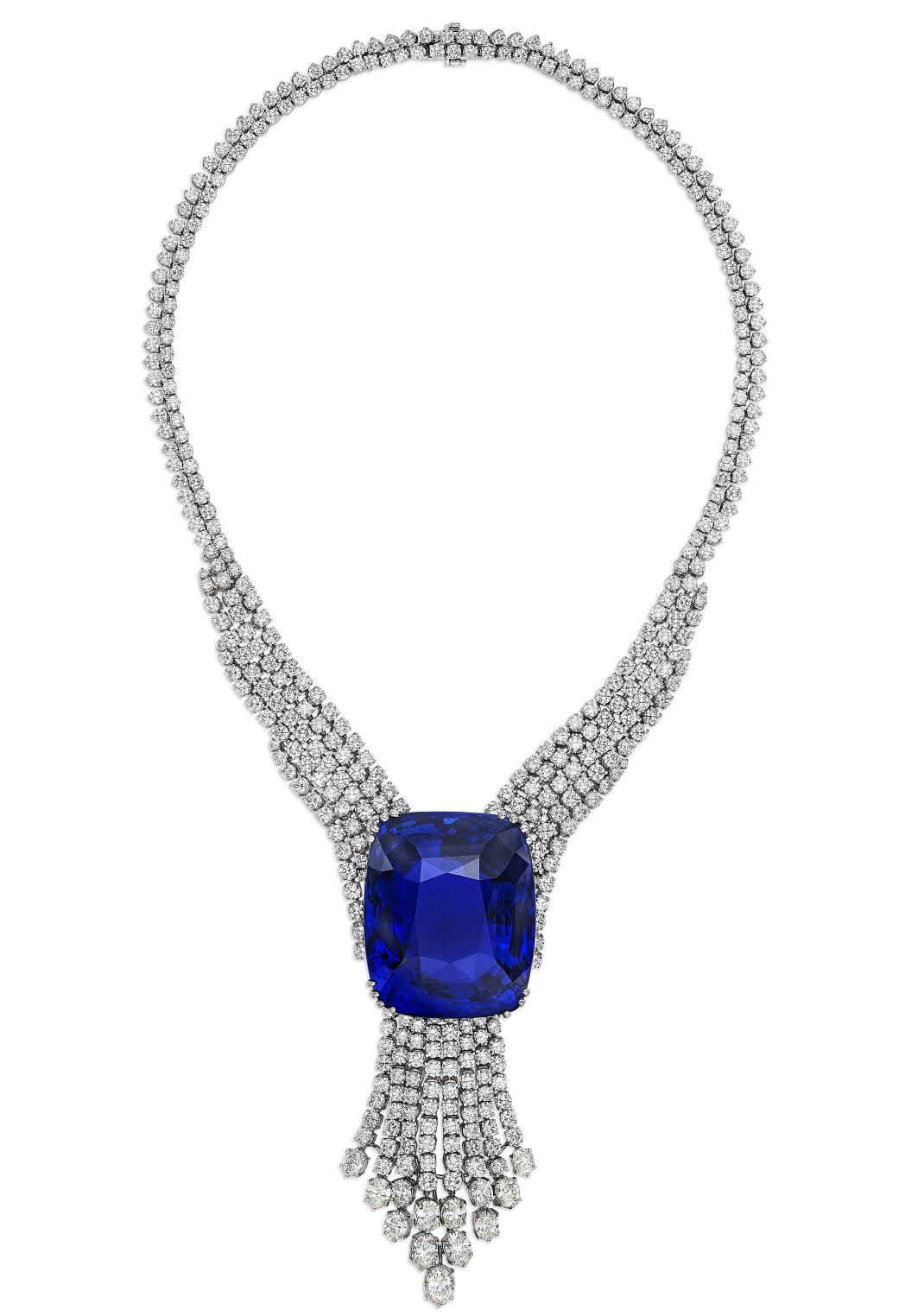
B
Belperron, S. 51, 52, 53, 54, 55, 56, 57, 58, 59, 60, 61
Boucheron 106 Bulgari 47, 120, 123
C Cartier 31, 35, 36, 37, 38, 39, 40, 64, 101, 102, 103, 104, 105, 107, 127
G Graff 112
H Hemmerle 95, 96
J JAR 44, 129, 130, 131, 132, 133, 134, 135, 136, 137, 138, 139
P Petochi 109
R Ray, M. 62
T Taffin 93, 94 Tiffany & Co. 87 Timey, J. 98
V Van Cleef & Arpels 2, 3, 4, 5, 6, 7, 8, 9, 10, 11, 12, 13, 14, 15, 16, 17, 18, 19, 20, 21, 22, 23, 24, 25, 26, 27, 28, 45, 46, 48, 49, 66, 67, 68, 69, 70, 71, 72, 73, 74, 75, 76, 77, 78, 79, 80, 81, 82, 99, 114, 115, 116, 117, 118, 119, 124, 125, 126, 128
W Webb, D. 121, 122 Winston, H. 108, 111, 113
COLOURLESS DIAMOND INDEX
D FL
Pear 89 Pair D, D FL, FL
D IF
D VVS1
D VVS1, Potential
D VVS1, Potential
D VVS1, Potential
7.02 Oval, Oval
Emerald
Pear
D, D VVS1, Potential; SI1 17.50, 5.01 Pear, Round 120 D VVS2, Potential
109 Pair D, D VVS2, Potential; VVS1, Potential 7.96, 7.89 Pear, Pear 128 Pair D, D VS1, Potential; VVS2, Potential 11.93, 11.83 Pear, Pear
D VS1
D SI2
E VS1
E SI1
F VVS1
F VS2
H VS1
H SI1
J SI2
Pair K, J VVS1, Potential; VVS2
Round
Cushion
4.00 Round, Round 12 K VVS2
Round 99 Pair L, L SI1, VS2 4.98, 4.69 Old Mine, Old Mine 97 Pair M, L VS1, VS1 34.57, 34.14 Pear, Pear
COLOURED DIAMOND INDEX
COLOURED STONE INDEX
BIOGRAPHIES
BELPERRON
Born in 1900, Suzanne Belperron was hired by the renowned firm of René Boivin in March 1919, where she developed a unique style under the direction of her mentor, Jeanne Boivin. In 1933, Bernard Herz hired the young Suzanne to design exclusively under his name, Herz. Though trained in the style of Art Deco, Belperron created a daring new look hailed by the fashion press as both “brilliant” and “barbaric.” With an ever-expanding clientele of European royalty, café society and Hollywood movie stars, the 1930s were Belperron’s to enjoy. This came to an end in 1939 with the declaration of World War II. Her friend and boss, Bernard Herz, died in a concentration camp, forcing Suzanne Belperron to re-register the firm under her name in 1941. At the end of the war Bernard’s son Jean, a prisoner of war survivor, returned to Paris to resume the partnership. Once again the name was changed, this time to Herz-Belperron. She continued to work until her retirement in 1974 but consulted for special clients and friends until her death in 1983. Ward and Nico Landrigan, owners of Verdura, purchased the Belperron name and archives in 1999 and published an illustrated biography in 2016.
BOUCHERON
Frédéric Boucheron opened his first jewellery salon at the Palais Royal in 1858, and soon acquired fame as an expert in precious stones, a masterful technician and a creator of beautiful jewellery. In 1893 he became the first jeweller to move to Place Vendôme, where he continued to serve the social elite, and from where the firm still operates successfully today. Over the years, Boucheron opened branches from Moscow and London, to Japan and the Middle and Far East. Boucheron exhibited in many international expositions, including the 1876 Philadelphia Centennial, the 1889 and 1900 World Fairs in Paris, the 1893 World’s Colombian Exposition in Chicago and the 1925 International Exhibition of Modern Decorative and Industrial Arts in Paris. Boucheron was acquired in May 2000 by Kering, one of the world’s leading multi-brand luxury goods company.
BULGARI
The firm was founded by Sotirio Bulgari, who was born in 1857 in Greece and was descended from a family of silversmiths. In 1884 he opened his first shop in Rome on the Via Sistina, and then in 1905 he moved to the Via dei Condotti. Upon Sotirio’s death in 1932 his sons, Giorgio and Costantino, took over the business. They are credited with creating the highly distinctive ‘Bvlgari’ style, inspired by Greek and Roman classicism, the Italian Renaissance, and the 19th century Roman school of goldsmiths. The 1970s marked the beginning of Bulgari’s international expansion with the opening of stores in New York (the first overseas), Paris, Geneva and Monte Carlo. It was also in this decade that Bulgari introduced the ‘Bvlgari-Bvlgari’ which was to become a successful watch classic. Bulgari Time was established in the early 1980s in Neuchâtel, Switzerland, for the creation and production of all Bulgari watch lines. In 2001, Bulgari formed a joint venture with ‘Luxury Group’ to create a new luxury hotel brand, Bulgari Hotels & Resorts. In 2011, Bulgari was acquired by LVMH.
CARTIER
Cartier was founded in Paris in 1847 by Louis-François Cartier. It was his three grandsons, Louis, Pierre and Jacques, who were responsible for establishing the famous world-wide empire. Louis retained responsibility for the Paris branch, moving it to the rue de la Paix in 1899. Jacques took charge of the London operation in 1906, which had opened in 1902, eventually moving it to the current location on New Bond Street. Pierre established the New York branch in 1909, relocating it in 1917 to the current location at 653 Fifth Avenue. Branches were opened in Moscow and the Persian Gulf in 1910, followed by openings in Cannes and Monte Carlo. In 1964, following the death of Pierre, Cartier Paris, London and New York were sold by the family. Cartier Paris was purchased by two American investors. In 1972 Silver Match lighter owner Robert Hocq and a group of investors led by financier Joseph Kanoui purchased Cartier Paris, followed by Cartier London In 1974 and Cartier New York In 1976, reuniting the three original branches. The Cartier Collection was created in 1983, allowing Cartier to hold successful public exhibitions of vintage Cartier jewels, clocks and objects In museums around the world. Today, Cartier is part of the Richemont group, with more than 200 boutiques around the world.
GRAFF
In 1960, Laurence Graff founded Graff, a London based, vertically integrated enterprise that design, manufacture and retail distribution of jewellery and watches. It is considered today a global leader in Haute Joaillerie, said to have handled more diamonds of notable rarity and beauty than any other jeweler in the world; gem legends such as the Idol’s Eye, the Emperor Maximilian, the Lesotho Promise, the Wittelsbach-Graff and the Letšeng Star. Graff’s flagship store is located on London’s New Bond Street with boutiques on Sloane Street and in Harrods. There are now over 55 Graff locations around the world, including Shanghai, Geneva, Hong Kong, Paris, Monte Carlo, Moscow and New York. In 2013, Mr Laurence Graff was awarded OBE (Officer of the Order of the British Empire) for his 5 decades at the pinnacle of the jewellery industry.
HEMMERLE
The firm of Hemmerle in Munich was founded in 1893 when the brothers Josef and Anton Hemmerle took over the jeweller Elchinger, located at the Frauenplatz. They developed an excellent reputation for their reproductions of antique pieces, in particular for their facility with filigree work and enamel. They received many prizes at such prestigious events as the Paris World Fair of 1900. They eventually became purveyors to the Bavarian Court. In 1903 the firm moved to Maximilianstrasse. Today they continue to produce high quality pieces under the leadership of Stefan Hemmerle. His design, strongly influenced by the Bauhaus, can be seen in his boutique in Munich, as well as at the art fairs of Basel, Maastricht and Palm Beach.
JAR
After graduating from Harvard in 1965, Joel Arthur Rosenthal moved to Paris and started with his partner Pierre Jeannet a tiny boutique on rue de l’Universite, creating needlepoint art with wool threads of unexpected colors, a niche endeavor which earned him early fame. Subsequently he applied the same artisanal spirit to jewelry, and opened a salon with Jeannet in Place Vendome named JAR after his initials. Shy by nature, he lives an almost anonymous existence in the creative universe of his atelier, for a most exclusive clientele, producing only 70-80 pieces a year. He is admired for his sculptural work, inseparable from that ingenious pave work, juxtaposing stones with the sense of color that is his alone. There has been three solo exhibitions: in 1987 at the National Academy of Design in New York, at Somerset House in London in 2002, and in November 2013 at the Metropolitan Museum of Art in New York. The last exhibition was an important salute to Rosenthal’s talents, as he was the first living jewelry designer to be accorded a dedicated retrospective in the history of the Met.
PETOCHI
The brothers Giuseppe and Domenico Petochi opened a small atelier in the Palazzo Incalzi on via dei Pontefici in the heart of Rome in 1884. Later, in 1928, they moved to the Torlonia Palace in via Bocca di Leone. In 1942 they transferred to their current location at the Piazzi di Spagna in a boutique previously occupied by the French jeweller Pierret, a student of Castellani. A love of Roman mosaics inspired Domenico Petochi’s (1949-1985) book on the subject. Published in 1981, it was followed by an exhibition in 1986 in the Vatican. Between 1978 and 1986, the firm was also active in New York, cultivating an American clientele. Today, the salerooms offer modern, as well as estate jewellery and fine silver.
TAFFIN
James Taffin de Givenchy, following the footsteps of such great and exclusive jewellers as Templier and Belperron, founded his jewellery firm in Manhattan in 1997. De Givenchy, who studied design at the Fashion Institute of Technology in New York, was initially exposed to the jewellery world when he joined Christie’s and was subsequently made the head of the jewellery department in Los Angeles. Before venturing out on his own, he joined the firm of Verdura. His designs draw their inspirations from nature as well as from the uniqueness of each individual stone, and is combined with solid craftsmanship to produce pieces of whimsical charm.
TIFFANY & CO.
On September 21, 1837, Charles Lewis Tiffany and John P. Young opened a stationery and fancy goods store known as Tiffany & Young at 259 Broadway in New York City. Within ten years, jewellery and silver items were added to their stock. By 1853, Tiffany had assumed complete ownership of the business and the name was changed to Tiffany & Co. During the 19th century, designers such as Edward C. Moore and G. Paulding Farnham, as well as renowned gemmologist George Frederick Kunz, propelled Tiffany & Co. to the forefront of the international jewellery world. From 1907, the firm manufactured and sold the jewellery designs of Louis Comfort Tiffany, son of the founder. Upon taking over the management of Tiffany & Co. in 1955, Walter Hoving invited several talented designers to join the firm. Among them were Jean Schlumberger and Donald Claflin. In 1974, they added Elsa Peretti as an exclusive designer, followed by Paloma Picasso in 1980. In 1979, Avon Products purchased Tiffany & Co. After the management-led buyout of Tiffany in 1984, headed by then chairman William R. Chaney, and a successful public offering of stock in 1987, the company has successfully expanded into key domestic and international markets. LVMH announced the purchase of Tiffany & Co. in November 2019.
VAN CLEEF & ARPELS
The history of the famous Parisian jewellery house began in 1896 with the marriage of Estelle Arpels to Alfred Van Cleef. The company was founded in 1906 by Alfred and his brother-in law, Charles Arpels at 22, Place Vendôme. Julien Arpels joined the family business in 1908, and Louis Arpels in 1913. The oldest son of Julien Arpels, Claude, joined in 1932, followed by his brothers Jacques and Pierre in 1936 and 1944. An American boutique was opened by Claude in Rockefeller Center in New York in 1939, soon relocating to its definitive address at 744 Fifth Avenue. The 1930s saw some of the company’s most iconic designs: the house’s arguable trademark, the Mystery Setting - where the mounting of the gemstones is cleverly hidden behind the continuous calibré-cut ruby and sapphire surface of the jewel - was invented in 1933; and the concept of the Minaudière, made in honour of Florence Jay Gould, was invented in 1930 by Charles Arpels. In the following decades, the firm upheld its reputation for innovation with the zip necklace of the 1950s and the Alhambra theme of the 1970s. Today, Van Cleef & Arpels is part of the Richemont Group with more than 45 boutiques around the world.
DAVID WEBB
In 1941, at the age of 16, David Webb travelled from his birthplace, Asheville, North Carolina, to New York City, where his special gifts as a jeweller and designer quickly became apparent. He was noticed by Antoinette Quilleret, a French socialite living in Manhattan, with exquisite taste. In 1948, with her backing, he formed David Webb Inc., setting up shop on 57th Street. At the height of production, his two full-time workshops employed 200 jewellers and 37 setters. David Webb’s designs of the 1950s and early 1960s showcased endless variations on animals, flowers and organic forms. His love of nature took shape in jewels of all sizes and varieties. He then adopted a new vocabulary of hammered gold, enamel, colours, textures and shapes, synthesised into geometric motifs that reflected the spirit of the 1970s. By his untimely death in 1975, David Webb had established himself as “the” jeweller in Manhattan. In addition, he was also dedicated to creating special order pieces for New York society members who flocked to him. After his death, the company was managed for 35 years by Nina Silberstein, David Webb’s business partner and later, her son, Stanley. Over this period, they oversaw the firm’s expansion into new markets such as Beverly Hills, Houston and Kuwait. In 2010, it was purchased by New York jewellery dealers Mark Emanuel and Robert Sadian. Under this new ownership, David Webb’s tradition of design and craftsmanship is being actively maintained, with older pieces remade according to their original drawings and archives.
HARRY WINSTON
Harry Winston (1896-1978) bought his first emerald at the age of eight. By the age of 24 he founded his first business in New York City: the Premier Diamond Company. In 1932 he incorporated under his own name and shortly thereafter began to manufacture and retail jewelry. Proclaimed the King of Diamonds in 1947 by Cosmopolitan magazine, Harry Winston owned at one time or another as many as a third of the famous diamonds in the world. He was also responsible for donating perhaps the most famous of all diamonds, the Hope diamond to the Smithsonian Institution where it stands to today as the centerpiece of the United States’ national gem collection. Upon Mr. Winston’s death in 1978, his son Ronald assumed control of the company and in 2004 Aber Diamond Corporation acquired a controlling interest in the company taking it public in 2007 under the name Harry Winston Diamond Corporation. In 2013 the Swatch Group acquired the retail arm of Harry Winston while the mining group under separate ownership is now the Dominion Diamond Corporation. Today, Harry Winston retail salons located throughout the US, Europe and Asia.
CONDITIONS OF SALE • BUYING AT CHRISTIE’S
CONDITIONS OF SALE
These Conditions of Sale and the Important Notices and Explanation of Cataloguing Practice set out the terms on which we offer the lots listed in this catalogue for sale. By registering to bid and/or by bidding at auction you agree to these terms, so you should read them carefully before doing so. You will find a glossary at the end explaining the meaning of the words and expressions coloured in bold. As well as these Conditions of Sale, lots in which we offer Non-Fungible Tokens are governed by the Additional Conditions of Sale – Non-Fungible Tokens, which are available in Appendix A herein. For the sale of Non-Fungible Tokens, to the extent there is a conflict between the “New York Conditions of Sale Buying at Christie’s” and “Additional Conditions of Sale – Non-Fungible Tokens”, the latter controls.
Unless we own a lot in whole or in part (Δ symbol), Christie’s acts as agent for the seller.
A BEFORE THE SALE
1 DESCRIPTION OF LOTS
(a)Certain words used in the catalogue description have special meanings. You can find details of these on the page headed “Important Notices and Explanation of Cataloguing Practice” which forms part of these terms. You can find a key to the Symbols found next to certain catalogue entries under the section of the catalogue called “Symbols Used in this Catalogue”.
(b)Our description of any lot in the catalogue, any condition report and any other statement made by us (whether orally or in writing) about any lot, including about its nature or condition, artist, period, materials, approximate dimensions, or provenance are our opinion and not to be relied upon as a statement of fact. We do not carry out in-depth research of the sort carried out by professional historians and scholars. All dimensions and weights are approximate only.
2 OUR RESPONSIBILITY FOR OUR DESCRIPTION OF LOTS
We do not provide any guarantee in relation to the nature of a lot apart from our authenticity warranty contained in paragraph E2 and to the extent provided in paragraph I below.
3 CONDITION
(a)The condition of lots sold in our auctions can vary widely due to factors such as age, previous damage, restoration, repair and wear and tear. Their nature means that they will rarely be in perfect condition Lots are sold “as is,” in the condition they are in at the time of the sale, without any representation or warranty or assumption of liability of any kind as to condition by Christie’s or by the seller.
(b)Any reference to condition in a catalogue entry or in a condition report will not amount to a full description of condition, and images may not show a lot clearly. Colours and shades may look different in print or on screen to how they look on physical inspection. Condition reports may be available to help you evaluate the condition of a lot Condition reports are provided free of charge as a convenience to our buyers and are for guidance only. They offer our opinion but they may not refer to all faults, inherent defects, restoration, alteration or adaptation because our staff are not professional restorers or conservators. For that reason condition reports are not an alternative to examining a lot in person or seeking your own professional advice. It is your responsibility to ensure that you have requested, received and considered any condition report.
4 VIEWING LOTS PRE-AUCTION
(a)If you are planning to bid on a lot, you should inspect it personally or through a knowledgeable representative before you make a bid to make sure that you accept the description and its condition. We recommend you get your own advice from a restorer or other professional adviser.
(b)Pre-auction viewings are open to the public free of charge. Our specialists may be available to answer questions at preauction viewings or by appointment.
5 ESTIMATES
Estimates are based on the condition, rarity, quality and provenance of the lots and on prices recently paid at auction for similar property. Estimates can change. Neither you, nor anyone else, may rely on any estimates as a prediction or guarantee of the actual selling price of a lot or its value for any other purpose. Estimates do not include the buyer’s premium or any applicable taxes.
6 WITHDRAWAL
Christie’s may, at its option, withdraw any lot from auction at any time prior to or during the sale of the lot. Christie’s has no liability to you for any decision to withdraw.
7 JEWELLERY
(a)Coloured gemstones (such as rubies, sapphires and emeralds) may have been treated to improve their look, through methods such as heating and oiling. These methods are accepted by the international jewellery trade but may make the gemstone less strong and/or require special care over time.
(b)It will not be apparent to us whether a diamond is naturally or synthetically formed unless it has been tested by a gemmological laboratory. Where the diamond has been tested, a gemmological report will be available.
(c) All types of gemstones may have been improved by some method. You may request a gemmological report for any item which does not have a report if the request is made to us at least three weeks before the date of the auction and you pay the fee for the report.
(d)Certain weights in the catalogue description are provided for guidance purposes only as they have been estimated through measurement and, as such, should not be relied upon as exact.
(e) We do not obtain a gemmological report for every gemstone sold in our auctions. Where we do get gemmological reports from internationally accepted gemmological laboratories, such reports will be described in the catalogue. Reports from American gemmological laboratories will describe any improvement or treatment to the gemstone. Reports from European gemmological laboratories will describe any improvement or treatment only if we request that they do so, but will confirm when no improvement or treatment has been made. Because of differences in approach and technology, laboratories may not agree whether a particular gemstone has been treated, the amount of treatment, or whether treatment is permanent. The gemmological laboratories will only report on the improvements or treatments known to the laboratories at the date of the report. We do not guarantee nor are we responsible for any report or certificate from a gemmological laboratory that may accompany a lot
(f)For jewellery sales, estimates are based on the information in any gemmological report, or if no report is available, assume that the gemstones may have been treated or enhanced.
8
WATCHES & CLOCKS
(a)Almost all clocks and watches are repaired in their lifetime and may include parts which are not original. We do not give a warranty that any individual component part of any watch is authentic. Watchbands described as “associated” are not part of the original watch and may not be authentic. Clocks may be sold without pendulums, weights or keys.
(b)As collectors’ watches often have very fine and complex mechanisms, you are responsible for any general service, change of battery, or further repair work that may be necessary. We do not give a warranty that any watch is in good working order. Certificates are not available unless described in the catalogue.
(c)Most wristwatches have been opened to find out the type and quality of movement. For that reason, wristwatches with water resistant cases may not be waterproof and we recommend you have them checked by a competent watchmaker before use.
Important information about the sale, transport and shipping of watches and watchbands can be found in paragraph H2(f).
B REGISTERING TO BID
1
NEW BIDDERS
(a)If this is your first time bidding at Christie’s or you are a returning bidder who has not bought anything from any of our salerooms within the last two years you must register at least 48 hours before an auction begins to give us enough time to process and approve your registration. We may, at our option, decline to permit you to register as a bidder. You will be asked for the following:
(i)for individuals: Photo identification (driver’s licence, national identity card, or passport) and, if not shown on the ID document, proof of your current address (for example, a current utility bill or bank statement);
(ii)for corporate clients: Your Certificate of Incorporation or equivalent document(s) showing your name and registered address together with documentary proof of directors and beneficial owners; and
(iii)for trusts, partnerships, offshore companies and other business structures, please contact us in advance to discuss our requirements.
(b)We may also ask you to give us a financial reference and/or a deposit as a condition of allowing you to bid. For help, please contact our Client Services Department at +1 212-636-2000.
2 RETURNING BIDDERS
As described in paragraph B(1) above, we may at our option ask you for current identification, a financial reference, or a deposit as a condition of allowing you to bid. If you have not bought anything from any of our salerooms within the last two years or if you want to spend more than on previous occasions, please contact our Client Services Department at +1 212-636-2000.
3 IF YOU FAIL TO PROVIDE THE RIGHT DOCUMENTS
If in our opinion you do not satisfy our bidder identification and registration procedures including, but not limited to completing any anti-money laundering and/or anti-terrorism financing checks we may require to our satisfaction, we may refuse to register you to bid, and if you make a successful bid, we may cancel the contract for sale between you and the seller.
4 BIDDING ON BEHALF OF ANOTHER PERSON
If you are bidding on behalf of another person, that person will need to complete the registration requirements above before you can bid and supply a signed letter authorising you to bid for him/ her. A bidder accepts personal liability to pay the purchase price and all other sums due unless it has been agreed in writing with Christie’s, before commencement of the auction, that the bidder is acting as an agent on behalf of a named third party acceptable to Christie’s and that Christie’s will only seek payment from the named third party.
5 BIDDING IN PERSON
If you wish to bid in the saleroom you must register for a numbered bidding paddle at least 30 minutes before the auction. You may register online at www.christies.com or in person. For help, please contact the Client Service Department on +1 212-636-2000.
6 BIDDING SERVICES
The bidding services described below are a free service offered as a convenience to our clients and Christie’s is not responsible for any error (human or otherwise), omission, or breakdown in providing these services.
(a) Phone Bids
Your request for this service must be made no later than 24 hours prior to the auction. We will accept bids by telephone for lots only if our staff are available to take the bids. If you need to bid in a language other than in English, you must arrange this well before the auction. We may record telephone bids. By bidding on the telephone, you are agreeing to us recording your conversations. You also agree that your telephone bids are governed by these Conditions of Sale.
(b) Internet Bids on Christie’s LIVE™
For certain auctions we will accept bids over the Internet. For more information, please visit https://www.christies.com/ buying-services/buying-guide/register-and-bid/. As well as these Conditions of Sale, internet bids are governed by the Christie’s LIVE™ Terms of Use which are available at https:// www.christies.com/LiveBidding/OnlineTermsOfUse.aspx
(c) Written Bids
You can find a Written Bid Form at any Christie’s office, or by choosing the sale and viewing the lots online at www. christies.com. We must receive your completed Written Bid at least 24 hours before the auction. Bids must be placed in the currency of the saleroom. The auctioneer will take reasonable steps to carry out written bids at the lowest possible price, taking into account the reserve. If you make a written bid on a lot which does not have a reserve and there is no higher bid than yours, we will bid on your behalf at around 50% of the low estimate or, if lower, the amount of your bid. If we receive written bids on a lot for identical amounts, and at the auction these are the highest bids on the lot, we will sell the lot to the bidder whose written bid we received first.
C CONDUCTING THE SALE
1
WHO CAN ENTER THE AUCTION
We may, at our option, refuse admission to our premises or decline to permit participation in any auction or to reject any bid.
2
RESERVES
Unless otherwise indicated, all lots are subject to a reserve. We identify lots that are offered without a reserve with the symbol • next to the lot number. The reserve cannot be more than the lot’s low estimate, unless the lot is subject to a third party guarantee and the irrevocable bid exceeds the printed low estimate. In that case, the reserve will be set at the amount of the irrevocable bid. Lots which are subject to a third party guarantee arrangement are identified in the catalogue with the symbol °◆
3 AUCTIONEER’S DISCRETION
The auctioneer can at their sole option:
(a)refuse any bid;
(b)move the bidding backwards or forwards in any way they may decide, or change the order of the lots;
(c)withdraw any lot;
(d)divide any lot or combine any two or more lots;
(e)reopen or continue the bidding even after the hammer has fallen; and
(f)in the case of error or dispute related to bidding and whether during or after the auction, continue the bidding, determine the successful bidder, cancel the sale of the lot, or reoffer and resell any lot. If you believe that the auctioneer has accepted the successful bid in error, you must provide a written notice detailing your claim within 3 business days of the date of the auction. The auctioneer will consider such claim in good faith. If the auctioneer, in the exercise of their discretion under this paragraph, decides after the auction is complete, to cancel the sale of a lot, or reoffer and resell a lot, they will notify the successful bidder no later than by the end of the 7th calendar day following the date of the auction. The auctioneer’s decision in exercise of this discretion is final. This paragraph does not in any way prejudice Christie’s ability to cancel the sale of a lot under any other applicable provision of these Conditions of Sale, including the rights of cancellation set forth in paragraphs B(3), E(2)(i), F(4), and J(1).
4
BIDDING
The auctioneer accepts bids from:
(a)bidders in the saleroom;
(b)telephone bidders;
(c)internet bidders through Christie’s LIVE™ (as shown above in paragraph B6); and
(d)written bids (also known as absentee bids or commission bids) left with us by a bidder before the auction.
5
BIDDING ON BEHALF OF THE SELLER
The auctioneer may, at their sole option, bid on behalf of the seller up to but not including the amount of the reserve either by making consecutive bids or by making bids in response to other bidders. The auctioneer will not identify these as bids made on behalf of the seller and will not make any bid on behalf of the seller at or above the reserve. If lots are offered without reserve, the auctioneer will generally decide to open the bidding at 50% of the low estimate for the lot. If no bid is made at that level, the auctioneer may decide to go backwards at their sole option until a bid is made, and then continue up from that amount. In the event that there are no bids on a lot, the auctioneer may deem such lot unsold.
6 BID INCREMENTS
Bidding generally starts below the low estimate and increases in steps (bid increments). The auctioneer will decide at their sole option where the bidding should start and the bid increments.
7 CURRENCY
CONVERTER
The saleroom video screens (and Christies LIVE™) may show bids in some other major currencies as well as US dollars. Any conversion is for guidance only and we cannot be bound by any rate of exchange used. Christie’s is not responsible for any error (human or otherwise), omission or breakdown in providing these services.
8 SUCCESSFUL BIDS
Unless the auctioneer decides to use their discretion as set out in paragraph C3 above, when the auctioneer’s hammer strikes, we have accepted the last bid. This means a contract for sale has been formed between the seller and the successful bidder. We will issue an invoice only to the registered bidder who made the successful bid. While we send out invoices by mail and/or email after the auction, we do not accept responsibility for telling you whether or not your bid was successful. If you have bid by written bid, you should contact us by telephone or in person as soon as possible after the auction to get details of the outcome of your bid to avoid having to pay unnecessary storage charges.
9
LOCAL BIDDING LAWS
You agree that when bidding in any of our sales that you will strictly comply with all local laws and regulations in force at the time of the sale for the relevant sale site.
D
1
THE BUYER’S PREMIUM AND TAXES
THE BUYER’S PREMIUM
In addition to the hammer price, the successful bidder agrees to pay us a buyer’s premium on the hammer price of each lot sold. On all lots we charge 26% of the hammer price up to and including US$1,000,000, 21.0% on that part of the hammer price over US$1,000,000 and up to and including US$6,000,000, and 15.0% of that part of the hammer price above US$6,000,000.
2 TAXES
The successful bidder is responsible for any applicable taxes including any sales or use tax or equivalent tax wherever such taxes may arise on the hammer price, the buyer’s premium, and/ or any other charges related to the lot
For lots Christie’s ships to or within the United States, a sales or use tax may be due on the hammer price, buyer’s premium, and/or any other charges related to the lot, regardless of the nationality or citizenship of the successful bidder. Christie’s will collect sales tax where legally required. The applicable sales tax rate will be determined based upon the state, county, or locale to which the lot will be shipped. Christie’s shall collect New York sales tax at a rate of 8.875% for any lot collected from Christie’s in New York.
In accordance with New York law, if Christie’s arranges the shipment of a lot out of New York State, New York sales tax does not apply, although sales tax or other applicable taxes for other states may apply. If you hire a shipper (other than a common carrier authorized by Christie’s), to collect the lot from a Christie’s New York location, Christie’s must collect New York sales tax on the lot at a rate of 8.875% regardless of the ultimate destination of the lot
If Christie’s delivers the lot to, or the lot is collected by, any framer, restorer or other similar service provider in New York that you have hired, New York law considers the lot delivered to the successful bidder in New York and New York sales tax must be imposed regardless of the ultimate destination of the lot. In this circumstance, New York sales tax will apply to the lot even if Christie’s or a common carrier (authorized by Christie’s that you hire) subsequently delivers the lot outside New York.
Successful bidders claiming an exemption from sales tax must provide appropriate documentation to Christie’s prior to the release of the lot or within 90 days after the sale, whichever is earlier. For shipments to those states for which Christie’s is not required to collect sales tax, a successful bidder may have a use or similar tax obligation. It is the successful bidder’s responsibility to pay all taxes due. Christie’s recommends you consult your own independent tax advisor with any questions.
E WARRANTIES
1 SELLER’S WARRANTIES
For each lot, the seller gives a warranty that the seller:
(a)is the owner of the lot or a joint owner of the lot acting with the permission of the other co-owners or, if the seller is not the owner or a joint owner of the lot, has the permission of the owner to sell the lot, or the right to do so in law; and (b)has the right to transfer ownership of the lot to the buyer without any restrictions or claims by anyone else.
(c)If either of the above warranties are incorrect, the seller shall not have to pay more than the purchase price (as defined in paragraph F1(a) below) paid by you to us. The seller will not be responsible to you for any reason for loss of profits or business, expected savings, loss of opportunity or interest, costs, damages, other damages or expenses. The seller gives no warranty in relation to any lot other than as set out above and, as far as the seller is allowed by law, all warranties from the seller to you, and all other obligations upon the seller which may be added to this agreement by law, are excluded.
2 OUR AUTHENTICITY WARRANTY
We warrant, subject to the terms below, that the lots in our sales are authentic (our “authenticity warranty”). If, within 5 years of the date of the auction, you give notice to us that your lot is not authentic, subject to the terms below, we will refund the purchase price paid by you. The meaning of authentic can be found in the glossary at the end of these Conditions of Sale. The terms of the authenticity warranty are as follows:
(a)It will be honored for claims notified within a period of 5 years from the date of the auction. After such time, we will not be obligated to honor the authenticity warranty
(b)It is given only for information shown in UPPERCASE type in the first line of the catalogue description (the “Heading”). It does not apply to any information other than in the Heading even if shown in UPPERCASE type
(c)The authenticity warranty does not apply to any Heading or part of a Heading which is qualified Qualified means limited by a clarification in a lot’s catalogue description or by the use in a Heading of one of the terms listed in the section titled Qualified Headings on the page of the catalogue headed “Important Notices and Explanation of Cataloguing Practice”. For example, use of the term “ATTRIBUTED TO…” in a Heading means that the lot is in Christie’s opinion probably a work by the named artist but no warranty is provided that the lot is the work of the named artist. Please read the full list of Qualified Headings and a lot’s full catalogue description before bidding.
(d)The authenticity warranty applies to the Heading as amended by any Saleroom notice
(e)The authenticity warranty does not apply where scholarship has developed since the auction leading to a change in generally accepted opinion. Further, it does not apply if the Heading either matched the generally accepted opinion of experts at the date of the auction or drew attention to any conflict of opinion.
(f)The authenticity warranty does not apply if the lot can only be shown not to be authentic by a scientific process which, on the date we published the catalogue, was not available or generally accepted for use, or which was unreasonably expensive or impractical, or which was likely to have damaged the lot
(g)The benefit of the authenticity warranty is only available to the original buyer shown on the invoice for the lot issued at the time of the sale and only if on the date of the notice of claim, the original buyer is the full owner of the lot and the lot is free from any claim, interest or restriction by anyone else. The benefit of this authenticity warranty may not be transferred to anyone else.
(h)In order to claim under the authenticity warranty you must:
(i)give us written notice of your claim within 5 years of the date of the auction. We may require full details and supporting evidence of any such claim;
(ii)at Christie’s option, we may require you to provide the written opinions of two recognised experts in the field of the lot mutually agreed by you and us in advance confirming that the lot is not authentic. If we have any doubts, we reserve the right to obtain additional opinions at our expense; and
(iii) return the lot at your expense to the saleroom from which you bought it in the condition it was in at the time of sale.
(i)Your only right under this authenticity warranty is to cancel the sale and receive a refund of the purchase price paid by you to us. We will not, under any circumstances, be required to pay you more than the purchase price nor will we be liable for any loss of profits or business, loss of opportunity or value, expected savings or interest, costs, damages, other damages or expenses.
(j) Books. Where the lot is a book, we give an additional warranty for 21 days from the date of the auction that if any lot is defective in text or illustration, we will refund your purchase price, subject to the following terms:
(a) This additional warranty does not apply to:
(i)the absence of blanks, half titles, tissue guards or advertisements, damage in respect of bindings, stains, spotting, marginal tears or other defects not affecting completeness of the text or illustration;
(ii)drawings, autographs, letters or manuscripts, signed photographs, music, atlases, maps or periodicals;
(iii)books not identified by title;
(iv) lots sold without a printed estimate;
(v)books which are described in the catalogue as sold not subject to return; or
(vi)defects stated in any condition report or announced at the time of sale.
(b) To make a claim under this paragraph you must give written details of the defect and return the lot to the sale room at which you bought it in the same condition as at the time of sale, within 21 days of the date of the sale.
(k) South East Asian Modern and Contemporary Art and Chinese Calligraphy and Painting.
In these categories, the authenticity warranty does not apply because current scholarship does not permit the making of definitive statements. Christie’s does, however, agree to cancel a sale in either of these two categories of art where it has been proven the lot is a forgery. Christie’s will refund to the original buyer the purchase price in accordance with the terms of Christie’s Authenticity warranty, provided that the original buyer notifies us with full supporting evidence documenting the forgery claim within twelve (12) months of the date of the auction. Such evidence must be satisfactory to us that the property is a forgery in accordance with paragraph E2(h)(ii) above and the property must be returned to us in accordance with paragraph E2(h)(iii) above. Paragraphs E2(b), (c), (d), (e), (f) and (g) and (i) also apply to a claim under these categories.
(l) Chinese, Japanese and Korean artefacts (excluding Chinese, Japanese and Korean calligraphy, paintings, prints, drawings and jewellery).
In these categories, paragraph E2 (b) – (e) above shall be amended so that where no maker or artist is identified, the authenticity warranty is given not only for the Heading but also for information regarding date or period shown in UPPERCASE type in the second line of the catalogue description (the “Subheading”). Accordingly, all references to the Heading in paragraph E2 (b) – (e) above shall be read as references to both the Heading and the Subheading
3 NO IMPLIED WARRANTIES
EXCEPT AS SET FORTH IN PARAGRAPHS E1 AND E2 ABOVE, NEITHER THE SELLER NOR THE CHRISTIE’S GROUP MAKE ANY OTHER WARRANTY, EXPRESS OR IMPLIED, ORAL OR WRITTEN, WITH RESPECT TO THE LOT, INCLUDING THE IMPLIED WARRANTIES OF MERCHANTABILITY OR FITNESS FOR A PARTICULAR PURPOSE, EACH OF WHICH IS SPECIFICALLY DISCLAIMED.
4 YOUR WARRANTIES
(a)You warrant that the funds used for settlement are not connected with any criminal activity, including tax evasion, and you are neither under investigation, nor have you been charged with or convicted of money laundering, terrorist activities or other crimes.
(b)Where you are bidding on behalf of another person, you warrant that:
(i)you have conducted appropriate customer due diligence on the ultimate buyer(s) of the lot(s) in accordance with all applicable anti-money laundering and sanctions laws, consent to us relying on this due diligence, and you will retain for a period of not less than 5 years the documentation evidencing the due diligence. You will make such documentation promptly available for immediate inspection by an independent third-party auditor upon our written request to do so;
(ii)the arrangements between you and the ultimate buyer(s) in relation to the lot or otherwise do not, in whole or in part, facilitate tax crimes;
(iii)you do not know, and have no reason to suspect, that the funds used for settlement are connected with, the proceeds of any criminal activity, including tax evasion, or that the ultimate buyer(s) are under investigation, or have been charged with or convicted of money laundering, terrorist activities or other crimes.
F PAYMENT
1 HOW TO PAY
(a)Immediately following the auction, you must pay the purchase price being:
(i)the hammer price; and
(ii)the buyer’s premium; and
(iii)any applicable duties, goods, sales, use, compensating or service tax, or VAT.
Payment is due no later than by the end of the 7th calendar day following the date of the auction (the “due date”).
(b)We will only accept payment from the registered bidder. Once issued, we cannot change the buyer’s name on an invoice or re-issue the invoice in a different name. You must pay immediately even if you want to export the lot and you need an export licence.
(c)You must pay for lots bought at Christie’s in the United States in the currency stated on the invoice in one of the following ways:
(i) Wire transfer
JP Morgan Chase Bank, N.A., 270 Park Avenue, New York, NY 10017; ABA# 021000021; FBO: Christie’s Inc.; Account # 957-107978, for international transfers, SWIFT: CHASUS33.
(ii) Credit Card
We accept Visa, MasterCard, American Express and China Union Pay. Credit card payments at the New York premises will only be accepted for New York sales. Christie’s will not accept credit card payments for purchases in any other sale site.
(iii) Cash
We accept cash payments (including money orders and traveller’s checks) subject to a maximum global aggregate of US$7,500 per buyer.
(iv) Bank Checks
You must make these payable to Christie’s Inc. and there may be conditions. Once we have deposited your check, property cannot be released until five business days have passed.
(v) Checks
You must make checks payable to Christie’s Inc. and they must be drawn from US dollar accounts from a US bank.
(vi) Cryptocurrency
With the exception of clients resident in Mainland China, payment for a lot marked with the symbol ❖ may be made in a cryptocurrency or cryptocurrencies of our choosing. Such cryptocurrency payments must be made in accordance with the Additional Conditions of Sale - Nonfungible Tokens set out at Appendix A to these Conditions of Sale.
(d)You must quote the sale number, your invoice number and client number when making a payment. All payments sent by post must be sent to:
Christie’s Inc. Post-Sale Services, 20 Rockefeller Center, New York, NY 10020.
(e)For more information please contact our Post-Sale Services by phone at +1 212 636 2650 or fax at +1 212 636 4939 or email PostSaleUS@christies.com.
2
TRANSFERRING OWNERSHIP TO YOU
You will not own the lot and ownership of the lot will not pass to you until we have received full and clear payment of the purchase price, even in circumstances where we have released the lot to you.
3
TRANSFERRING RISK TO YOU
The risk in and responsibility for the lot will transfer to you from whichever is the earlier of the following:
(a)When you collect the lot; or
(b)At the end of the 30th day following the date of the auction or, if earlier, the date the lot is taken into care by a third party warehouse as set out on the page headed ‘Storage and Collection’, unless we have agreed otherwise with you.
4 WHAT HAPPENS IF YOU DO NOT PAY
(a)If you fail to pay us the purchase price in full by the due date, we will be entitled to do one or more of the following (as well as enforce our rights under paragraph F5 and any other rights or remedies we have by law):
(i)we can charge interest from the due date at a rate of up to 1.34% per month on the unpaid amount due;
(ii)we can cancel the sale of the lot. If we do this, we may sell the lot again, publicly or privately on such terms we shall think necessary or appropriate, in which case you must pay us any shortfall between the purchase price and the proceeds from the resale. You must also pay all costs, expenses, losses, damages and legal fees we have to pay or may suffer and any shortfall in the seller’s commission on the resale;
(iii)we can pay the seller an amount up to the net proceeds payable in respect of the amount bid by your default in which case you acknowledge and understand that Christie’s will have all of the rights of the seller to pursue you for such amounts;
(iv)we can hold you legally responsible for the purchase price and may begin legal proceedings to recover it together with other losses, interest, legal fees and costs as far as we are allowed by law;
(v)we can take what you owe us from any amounts which we or any company in the Christie’s Group may owe you (including any deposit or other part-payment which you have paid to us);
(vi)we can, at our option, reveal your identity and contact details to the seller;
(vii)we can reject at any future auction any bids made by or on behalf of the buyer or to obtain a deposit from the buyer before accepting any bids;
(viii)we can exercise all the rights and remedies of a person holding security over any property in our possession owned by you, whether by way of pledge, security interest or in any other way as permitted by the law of the place where such property is located. You will be deemed to have granted such security to us and we may retain such property as collateral security for your obligations to us; and
(ix)we can take any other action we see necessary or appropriate.
(b)If you owe money to us or to another Christie’s Group company, we can use any amount you do pay, including any deposit or other part-payment you have made to us, or which we owe you, to pay off any amount you owe to us or another Christie’s Group company for any transaction.
5 KEEPING YOUR PROPERTY
If you owe money to us or to another Christie’s Group company, as well as the rights set out in F4 above, we can use or deal with any of your property we hold or which is held by another Christie’s Group company in any way we are allowed to by law. We will only release your property to you after you pay us or the relevant Christie’s Group company in full for what you owe. However, if we choose, we can also sell your property in any way we think appropriate. We will use the proceeds of the sale against any amounts you owe us and we will pay any amount left from that sale to you. If there is a shortfall, you must pay us any difference between the amount we have received from the sale and the amount you owe us.
G COLLECTION AND STORAGE
(a)You must collect purchased lots within seven days from the auction (but note that lots will not be released to you until you have made full and clear payment of all amounts due to us).
(b)If you do not collect any lot within 90 days following the auction we may, at our option
(i)charge you storage costs at the rates set out at www. christies.com/en/help/buying-guide/storage-fees
(ii)move the lot to another Christie’s location or an affiliate or third-party warehouse and charge you transport costs and administration fees for doing so and you will be subject to the third party storage warehouse’s standard terms and to pay for their standard fees and costs.
(iii)sell the lot in any commercially reasonable way we think appropriate.
(c)The Storage conditions which can be found at www.christies. com/en/help/buying-guide/storage-conditions will apply.
(d)If you do not collect the lot within 90 calendar days of the auction and Christie’s exercises its rights under paragraph G(b) above, the lot will be deemed delivered in New York and therefore subject to New York state and local sales tax. For shipments booked and paid for prior to 90 calendar days of the auction, sales tax will be determined based on the guidance set forth in paragraph D(2).
(e)Nothing in this paragraph is intended to limit our rights under paragraph F4.
H TRANSPORT AND SHIPPING
1 SHIPPING
We would be happy to assist in making shipping arrangements on request. You must make all transport and shipping arrangements. However, we can arrange to pack, transport, and ship your property if you ask us to and pay the costs of doing so. We recommend that you ask us for an estimate, especially for any large items or items of high value that need professional packing. We may also suggest other handlers, packers, transporters, or experts if you ask us to do so. For more information, please contact Christie’s Post-Sale Services at +1 212 636 2650. See the information set out at https://www.christies.com/buyingservices/buying-guide/ship/ or contact us at PostSaleUS@ christies.com. We will take reasonable care when we are handling, packing, transporting, and shipping. However, if we recommend another company for any of these purposes, we are not responsible for their acts, failure to act, or neglect.
2 EXPORT AND IMPORT
Any lot sold at auction may be affected by laws on exports from the country in which it is sold and the import restrictions of other countries. Many countries require a declaration of export for property leaving the country and/or an import declaration on entry of property into the country. Local laws may prevent you from importing a lot or may prevent you selling a lot in the country you import it into.
(a)You alone are responsible for getting advice about and meeting the requirements of any laws or regulations which apply to exporting or importing any lot prior to bidding. If you are refused a licence or there is a delay in getting one, you must still pay us in full for the lot. We may be able to help you apply for the appropriate licences if you ask us to and pay our fee for doing so. However, we cannot guarantee that you will get one. For more information, please contact Christie’s Post-Sale Services Department at +1 212 636 2650 and PostSaleUS@christies.com.
See the information set out at https://www.christies. com/buying-services/buying-guide/ship/ or contact us at PostSaleUS@christies.com.
(b)You alone are responsible for any applicable taxes, tariffs or other government-imposed charges relating to the export or import of the lot. If Christie’s exports or imports the lot on your behalf, and if Christie’s pays these applicable taxes, tariffs or other government-imposed charges, you agree to refund that amount to Christie’s.
(c) Endangered and protected species Lots made of or including (regardless of the percentage) endangered and other protected species of wildlife are marked with the symbol ~ in the catalogue. This material includes, among other things, ivory, tortoiseshell, whalebone, certain species of coral, Brazilian rosewood, crocodile, alligator and ostrich skins. You should check the relevant customs laws and regulations before bidding on any lot containing wildlife material if you plan to export the lot from the country in which the lot is sold and import it into another country as a licence may be required. In some cases, the lot can only be shipped with an independent scientific confirmation of species and/or age and you will need to obtain these at your own cost. Several countries have imposed restrictions on dealing in elephant ivory, ranging from a total ban on importing African elephant ivory in the United States to importing, exporting and selling under strict measures in other countries. Handbags containing endangered or
protected species material are marked with the symbol ≈ and further information can be found in paragraph H2(h) below. We will not be obliged to cancel your purchase and refund the purchase price if your lot may not be exported, imported or it is seized for any reason by a government authority. It is your responsibility to determine and satisfy the requirements of any applicable laws or regulations relating to the export or import of property containing such protected or regulated material.
(d) Lots containing Ivory or materials resembling ivory
If a lot contains elephant ivory, or any other wildlife material that could be confused with elephant ivory (for example, mammoth ivory, walrus ivory, helmeted hornbill ivory) you may be prevented from exporting the lot from the US or shipping it between US States without first confirming its species by way of a rigorous scientific test acceptable to the applicable Fish and Wildlife authorities. You will buy that lot at your own risk and be responsible for any scientific test or other reports required for export from the USA or between US States at your own cost. We will not be obliged to cancel your purchase and refund the purchase price if your lot may not be exported, imported or shipped between US States, or it is seized for any reason by a government authority. It is your responsibility to determine and satisfy the requirements of any applicable laws or regulations relating to interstate shipping, export or import of property containing such protected or regulated material.
(e) Lots of Iranian origin
Some countries prohibit or restrict the purchase, export and/or import of Iranian-origin “works of conventional craftsmanship” (works that are not by a recognized artist and/ or that have a function, (for example: carpets, bowls, ewers, tiles, ornamental boxes). For example, the USA prohibits the import and export of this type of property without a license issued by the US Department of the Treasury, Office of Foreign Assets Control. Other countries, such as Canada, only permit the import of this property in certain circumstances. As a convenience to buyers, Christie’s indicates under the title of a lot if the lot originates from Iran (Persia). It is your responsibility to ensure you do not bid on or import a lot in contravention of the sanctions or trade embargoes that apply to you.
(f) Gold
Gold of less than 18ct does not qualify in all countries as ‘gold’ and may be refused import into those countries as ‘gold’.
(g) Watches
Many of the watches offered for sale in this catalogue are pictured with straps made of endangered or protected animal materials such as alligator or crocodile. These lots are marked with the symbol Ψ in the catalogue. These endangered species straps are shown for display purposes only and are not for sale. Christie’s will remove and retain the strap prior to shipment from the sale site. At some sale sites, Christie’s may, at its discretion, make the displayed endangered species strap available to the buyer of the lot free of charge if collected in person from the sale site within 1 year of the date of the auction. Please check with the department for details on a particular lot
(h)Handbags
A lot marked with the symbol ≈ next to the lot number includes endangered or protected species material and is subject to CITES regulations. This lot may only be shipped to an address within the country of the sale site or personally picked up from our saleroom. Please note, Christie’s cannot facilitate the shipment of any lot containing python, alligator or crocodile into the State of California.
The term “hardware” refers to the metallic parts of the handbag, such as the buckle hardware, base studs, lock and keys and/or strap, which are plated with a coloured finish (e.g. gold, silver, palladium). The terms “Gold Hardware”, “Silver Hardware”, “Palladium Hardware”, etc. refer to the tone or colour of the hardware and not the actual material used. If the handbag incorporates solid metal hardware, this will be referenced in the catalogue description
For all symbols and other markings referred to in paragraph H2, please note that lots are marked as a convenience to you, but we do not accept liability for errors or for failing to mark lots
I OUR LIABILITY TO YOU
(a)We give no warranty in relation to any statement made, or information given, by us or our representatives or employees, about any lot other than as set out in the authenticity warranty and, as far as we are allowed by law, all warranties and other terms which may be added to this agreement by law are excluded. The seller’s warranties contained in paragraph E1 are their own and we do not have any liability to you in relation to those warranties.
(b)(i) We are not responsible to you for any reason (whether for breaking this agreement or any other matter relating to your purchase of, or bid for, any lot) other than in the event of fraud or fraudulent misrepresentation by us or other than as expressly set out in these conditions of sale; and (ii) we
do not give any representation, warranty or guarantee or assume any liability of any kind in respect of any lot with regard to merchantability, fitness for a particular purpose, description, size, quality, condition, attribution, authenticity, rarity, importance, medium, provenance, exhibition history, literature, or historical relevance. Except as required by local law, any warranty of any kind is excluded by this paragraph.
(c)In particular, please be aware that our written and telephone bidding services, Christie’s LIVE™, condition reports, currency converter and saleroom video screens are free services and we are not responsible to you for any error (human or otherwise), omission or breakdown in these services.
(d)We have no responsibility to any person other than a buyer in connection with the purchase of any lot
(e)If, in spite of the terms in paragraphs I(a) to (d) or E2(i) above, we are found to be liable to you for any reason, we shall not have to pay more than the purchase price paid by you to us. We will not be responsible to you for any reason for loss of profits or business, loss of opportunity or value, expected savings or interest, costs, other damages, or expenses.
J OTHER TERMS
1
OUR ABILITY TO CANCEL
In addition to the other rights of cancellation contained in this agreement, we can cancel a sale of a lot if : (i) any of your warranties in paragraph E4 are not correct; (ii) we reasonably believe that completing the transaction is, or may be, unlawful; or (iii) we reasonably believe that the sale places us or the seller under any liability to anyone else or may damage our reputation.
2
RECORDINGS
We may videotape and record proceedings at any auction. We will keep any personal information confidential, except to the extent disclosure is required by law. However, we may, through this process, use or share these recordings with another Christie’s Group company and marketing partners to analyse our customers and to help us to tailor our services for buyers. If you do not want to be videotaped, you may make arrangements to make a telephone or written bid or bid on Christie’s LIVE™ instead. Unless we agree otherwise in writing, you may not videotape or record proceedings at any auction.
3 COPYRIGHT
We own the copyright in all images, illustrations and written material produced by or for us relating to a lot (including the contents of our catalogues unless otherwise noted in the catalogue). You cannot use them without our prior written permission. We do not offer any guarantee that you will gain any copyright or other reproduction rights to the lot
4 ENFORCING THIS AGREEMENT
If a court finds that any part of this agreement is not valid or is illegal or impossible to enforce, that part of the agreement will be treated as being deleted and the rest of this agreement will not be affected.
5 TRANSFERRING YOUR RIGHTS AND RESPONSIBILITIES
You may not grant a security over or transfer your rights or responsibilities under these terms on the contract of sale with the buyer unless we have given our written permission. This agreement will be binding on your successors or estate and anyone who takes over your rights and responsibilities.
6 TRANSLATIONS
If we have provided a translation of this agreement, we will use this original version in deciding any issues or disputes which arise under this agreement.
7 PERSONAL INFORMATION
We will hold and process your personal information and may pass it to another Christie’s Group company for use as described in, and in line with, our privacy notice at www.christies.com/aboutus/contact/privacy and if you are a resident of California you can see a copy of our California Consumer Privacy Act statement at https://www.christies.com/about-us/contact/ccpa
8 WAIVER
No failure or delay to exercise any right or remedy provided under these Conditions of Sale shall constitute a waiver of that or any other right or remedy, nor shall it prevent or restrict the further exercise of that or any other right or remedy. No single or partial exercise of such right or remedy shall prevent or restrict the further exercise of that or any other right or remedy.
9 LAW AND DISPUTES
This agreement, and any non-contractual obligations arising out of or in connection with this agreement, or any other rights you may have relating to the purchase of a lot (the “Dispute”) will be governed by the laws of New York. Before we or you start any court proceedings (except in the limited circumstances where the dispute, controversy or claim is related to proceedings brought by someone else and this dispute could be joined to those proceedings), we agree we will each try to settle the Dispute by mediation submitted to JAMS, or its successor, for mediation in New York. If the Dispute is not settled by mediation within
60 days from the date when mediation is initiated, then the Dispute shall be submitted to JAMS, or its successor, for final and binding arbitration in accordance with its Comprehensive Arbitration Rules and Procedures or, if the Dispute involves a non-U.S. party, the JAMS International Arbitration Rules. The seat of the arbitration shall be New York and the arbitration shall be conducted by one arbitrator, who shall be appointed within 30 days after the initiation of the arbitration. The language used in the arbitral proceedings shall be English. The arbitrator shall order the production of documents only upon a showing that such documents are relevant and material to the outcome of the Dispute. The arbitration shall be confidential, except to the extent necessary to enforce a judgment or where disclosure is required by law. The arbitration award shall be final and binding on all parties involved. Judgment upon the award may be entered by any court having jurisdiction thereof or having jurisdiction over the relevant party or its assets. This arbitration and any proceedings conducted hereunder shall be governed by Title 9 (Arbitration) of the United States Code and by the United Nations Convention on the Recognition and Enforcement of Foreign Arbitral Awards of June 10, 1958.
10 REPORTING ON WWW.CHRISTIES.COM
Details of all lots sold by us, including catalogue descriptions and prices, may be reported on www.christies.com. Sales totals are hammer price plus buyer’s premium and do not reflect costs, financing fees, or application of buyer’s or seller’s credits. We regret that we cannot agree to requests to remove these details from www.christies.com
K GLOSSARY
auctioneer: the individual auctioneer and/or Christie’s. authentic: a genuine example, rather than a copy or forgery of:
(i) the work of a particular artist, author or manufacturer, if the lot is described in the Heading as the work of that artist, author or manufacturer;
(ii) a work created within a particular period or culture, if the lot is described in the Heading as a work created during that period or culture;
(iii) a work for a particular origin source if the lot is described in the Heading as being of that origin or source; or
(iv) in the case of gems, a work which is made of a particular material, if the lot is described in the Heading as being made of that material.
authenticity warranty: the guarantee we give in this agreement that a lot is authentic as set out in paragraph E2 of this agreement.
buyer’s premium: the charge the buyer pays us along with the hammer price
catalogue description: the description of a lot in the catalogue for the auction, as amended by any saleroom notice
Christie’s Group: Christie’s International Plc, its subsidiaries and other companies within its corporate group.
condition: the physical condition of a lot
due date: has the meaning given to it paragraph F1(a).
estimate: the price range included in the catalogue or any saleroom notice within which we believe a lot may sell. Low estimate means the lower figure in the range and high estimate means the higher figure. The mid estimate is the midpoint between the two.
hammer price: the amount of the highest bid the auctioneer accepts for the sale of a lot
Heading: has the meaning given to it in paragraph E2.
lot: an item to be offered at auction (or two or more items to be offered at auction as a group).
other damages: any special, consequential, incidental or indirect damages of any kind or any damages which fall within the meaning of ‘special’, ‘incidental’ or ‘consequential’ under local law. purchase price: has the meaning given to it in paragraph F1(a).
provenance: the ownership history of a lot
qualified: has the meaning given to it in paragraph E2 and Qualified Headings means the paragraph headed Qualified Headings on the page of the catalogue headed ‘Important Notices and Explanation of Cataloguing Practice’.
reserve: the confidential amount below which we will not sell a lot
saleroom notice: a written notice posted next to the lot in the saleroom and on www.christies.com, which is also read to prospective telephone bidders and notified to clients who have left commission bids, or an announcement made by the auctioneer either at the beginning of the sale, or before a particular lot is auctioned.
subheading: has the meaning given to it in paragraph E2.
UPPER CASE type: means having all capital letters.
warranty: a statement or representation in which the person making it guarantees that the facts set out in it are correct.
1/4/2025
IMPORTANT NOTICES AND EXPLANATION OF CATALOGUING PRACTICE
IMPORTANT NOTICES
∆ Property in which Christie’s has an ownership or financial interest
From time to time, Christie’s may offer a lot in which Christie’s has an ownership interest or a financial interest. Such lot is identified in the catalogue with the symbol ∆ next to its lot number. Where Christie’s has an ownership or financial interest in every lot in the catalogue, Christie’s will not designate each lot with a symbol, but will state its interest in the front of the catalogue.
º Minimum Price Guarantees
On occasion, Christie’s has a direct financial interest in the outcome of the sale of certain lots consigned for sale. This will usually be where it has guaranteed to the Seller that whatever the outcome of the auction, the Seller will receive a minimum sale price for the lot. This is known as a minimum price guarantee. Where Christie’s holds such financial interest we identify such lots with the symbol º next to the lot number.
º ♦ Third Party Guarantees/Irrevocable bids
Where Christie’s has provided a Minimum Price Guarantee, it is at risk of making a loss, which can be significant if the lot fails to sell. Christie’s sometimes chooses to share that risk with a third party who agrees prior to the auction to place an irrevocable written bid on the lot. If there are no other higher bids, the third party commits to buy the lot at the level of their irrevocable written bid. In doing so, the third party takes on all or part of the risk of the lot not being sold. Lots which are subject to a third party guarantee arrangement are identified in the catalogue with the symbol º ♦
In most cases, Christie’s compensates the third party in exchange for accepting this risk. Where the third party is the successful bidder, the third party’s remuneration is based on a fixed financing fee. If the third party is not the successful bidder, the remuneration may either be based on a fixed fee or an amount calculated against the final hammer price. The third party may continue to bid for the lot above the irrevocable written bid.
Third party guarantors are required by us to disclose to anyone they are advising their financial interest in any lots they are guaranteeing. However, for the avoidance of any doubt, if you are advised by or bidding through an agent on a lot identified as being subject to a third party guarantee you should always ask your agent to confirm whether or not they have a financial interest in relation to the lot
∆ ♦ Property in which Christie’s has an interest and Third Party Guarantee/Irrevocable bid
Where Christie’s has a financial interest in a lot and the lot fails to sell, Christie’s is at risk of making a loss. As such, Christie’s may choose to share that risk with a third party whereby the third party contractually agrees, prior to the auction, to place an irrevocable written bid on the lot. Such lot is identified with the symbol ∆ ♦ next to the lot number.
Where the third party is the successful bidder on the lot, they will not receive compensation in exchange for accepting this risk. If the third party is not the successful bidder, Christie’s may compensate the third party. The third party is required by us to disclose to anyone they are advising of their financial interest in any lot in which Christie’s has a financial interest. If you are advised by or bidding through an agent on a lot in which Christie’s has a financial interest that is subject to a contractual written bid, you should always ask your agent to confirm whether or not they have a financial interest in relation to the lot
¤ Bidding by interested parties
When a party with a direct or indirect interest in the lot who may have knowledge of the lot’s reserve or other material information may be bidding on the lot, we will mark the lot with this symbol ¤. This interest can include beneficiaries of an estate that consigned the lot or a joint owner of a lot. Any interested party that successfully bids on a lot must comply with Christie’s Conditions of Sale, including paying the lot’s full buyer’s premium plus applicable taxes.
Post-catalogue notifications
If Christie’s enters into an arrangement or becomes aware of bidding that would have required a catalogue symbol, we will notify you by updating christies.com with the relevant information (time permitting) or otherwise by a pre-sale or prelot announcement.
Other Arrangements
Christie’s may enter into other arrangements not involving bids. These include arrangements where Christie’s has advanced money to consignors or prospective purchasers or where Christie’s has shared the risk of a guarantee with a partner without the partner being required to place an irrevocable written bid or otherwise participating in the bidding on the lot. Because such arrangements are unrelated to the bidding process they are not marked with a symbol in the catalogue.
EXPLANATION OF CATALOGUING PRACTICE
Terms used in a catalogue or lot description have the meanings ascribed to them below. Please note that all statements in a catalogue or lot description as to authorship are made subject to the provisions of the Conditions of Sale, including the authenticity warranty. Our use of these expressions does not take account of the condition of the lot or of the extent of any restoration. Written condition reports are usually available on request.
A term and its definition listed under ‘Qualified Headings’ is a qualified statement as to authorship. While the use of this term is based upon careful study and represents the opinion of specialists, Christie’s and the consignor assume no risk, liability and responsibility for the authenticity of authorship of any lot in this catalogue described by this term, and the authenticity warranty shall not be available with respect to lots described using this term.
PICTURES, DRAWINGS, PRINTS AND MINIATURES
Name(s) or Recognised Designation of an artist without any qualification: in Christie’s opinion a work by the artist.
QUALIFIED HEADINGS
“Attributed to …”: in Christie’s qualified opinion probably a work by the artist in whole or in part.
“Studio of …”/“Workshop of …”: in Christie’s qualified opinion a work executed in the studio or workshop of the artist, possibly under his supervision.
“Circle of …”: in Christie’s qualified opinion a work of the period of the artist and showing his influence.
“Follower of… ”: in Christie’s qualified opinion a work executed in the artist’s style but not necessarily by a pupil.
“Manner of… ”: in Christie’s qualified opinion a work executed in the artist’s style but of a later date.
“After …”: in Christie’s qualified opinion a copy (of any date) of a work of the artist.
“Signed …”/“Dated …”/ “Inscribed …”: in Christie’s qualified opinion the work has been signed/dated/inscribed by the artist.
“With signature …”/“With date …”/ “With inscription …”: in Christie’s qualified opinion the signature/ date/inscription appears to be by a hand other than that of the artist.
The date given for Old Master, Modern and Contemporary Prints is the date (or approximate date when prefixed with ‘circa’) on which the matrix was worked and not necessarily the date when the impression was printed or published.
CHINESE CERAMICS AND WORKS OF ART
When a piece is, in Christie’s opinion, of a certain period, reign or dynasty, its attribution appears in uppercase letters directly below the Heading of the description of the lot
e.g. A BLUE AND WHITE BOWL
18TH CENTURY
If the date, period or reign mark mentioned in uppercase letters after the bold type first line states that the mark is of the period, then in Christie’s opinion, the piece is of the date, period or reign of the mark.
e.g. A BLUE AND WHITE BOWL
KANGXI SIX-CHARACTER MARK IN UNDERGLAZE BLUE AND OF THE PERIOD (1662-1722)
If no date, period or reign mark is mentioned in uppercase letters after the bold description, in Christie’s opinion it is of uncertain date or late manufacture.
e.g. A BLUE AND WHITE BOWL
QUALIFIED HEADINGS
When a piece is, in Christie’s opinion, not of the period to which it would normally be attributed on stylistic grounds, this will be incorporated into the first line or the body of the text of the description.
e.g. A BLUE AND WHITE MING-STYLE BOWL; or
The Ming-style bowl is decorated with lotus scrolls…
In Christie’s qualified opinion this object most probably dates from Kangxi period but there remains the possibility that it may be dated differently.
e.g. KANGXI SIX-CHARACTER MARK IN UNDERGLAZE BLUE AND PROBABLY OF THE PERIOD
In Christie’s qualified opinion, this object could be dated to the Kangxi period but there is a strong element of doubt.
e.g. KANGXI SIX-CHARACTER MARK IN UNDERGLAZE BLUE AND POSSIBLY OF THE PERIOD
JEWELLERY
“Boucheron”: when maker’s name appears in the title, in Christie’s opinion it is by that maker.
“Mounted by Boucheron”: in Christie’s opinion the setting has been created by the jeweller using stones originally supplied by the jeweller’s client.
QUALIFIED HEADINGS
“Attributed to”: in Christie’s qualified opinion is probably a work by the jeweller/maker but no warranty is provided that the lot is the work of the named jeweller/maker.
Other information included in the catalogue description
“Signed Boucheron / Signature Boucheron”: in Christie’s qualified opinion has a signature by the jeweller.
“With maker’s mark for Boucheron”: in Christie’s qualified opinion has a mark denoting the maker.
Periods
Art Nouveau 1895-1910
Belle Epoque 1895-1914
Art Deco 1915-1935
Retro 1940s
WATCHES
Removal of Watch Batteries
A lot marked with the symbol ⊕ next to the lot number incorporates batteries which may be designated as “dangerous goods” under international laws and regulations governing the transport of goods by air freight. If a buyer requests shipment of the lot to a destination outside of the country in which the saleroom is located, the batteries will be removed and retained by us prior to shipment. If the lot is collected from the saleroom, the batteries will be made available for collection free of charge.
FABERGÉ
QUALIFIED HEADINGS
“Marked Fabergé, Workmaster …”: in Christie’s qualified opinion a work of the master’s workshop inscribed with his name or initials and his workmaster’s initials.
“By Fabergé …”: in Christie’s qualified opinion, a work of the master’s workshop, but without his mark.
“In the style of …”: in Christie’s qualified opinion a work of the period of the master and closely related to his style.
“Bearing marks …”: in Christie’s qualified opinion not a work of the master’s workshop and bearing later marks.
HANDBAGS
Condition Reports
The condition of lots sold in our auctions can vary widely due to factors such as age, previous damage, restoration, repair and wear and tear. Condition reports and grades are provided free of charge as a courtesy and convenience to our buyers and are for guidance only. They offer our honest opinion but they may not refer to all faults, restoration, alteration or adaptation. They are not an alternative to examining a lot in person or taking your own professional advice. Lots are sold “as is,” in the condition they are in at the time of the sale, without any representation or warranty as to condition by Christie’s or by the seller.
Grades in Condition Reports
We provide a general, numeric condition grade to help with overall condition guidance. Please review the specific condition report and extra images for each lot before bidding.
Grade 1: this item exhibits no signs of use or wear and could be considered as new. There are no flaws. Original packaging and protective plastic are likely intact as noted in the lot description.
Grade 2: this item exhibits minor flaws and could be considered nearly brand new. It may never have been used, or may have been used a few times. There are only minor condition notes, which can be found in the specific condition report.
Grade 3: this item exhibits visible signs of use. Any signs of use or wear are minor. This item is in good condition.
Grade 4: this item exhibits wear from frequent use. This item either has light overall wear or small areas of heavy wear. The item is considered to be in fair condition.
Grade 5: this item exhibits normal wear and tear from regular or heavy use. The item is in good, usable condition but it does have condition notes.
Grade 6: this item is damaged and requires repair. It is considered in fair condition.
Any reference to condition in a catalogue entry will not amount to a full description of condition, and images may not show the condition of a lot clearly. Colours and shades may look different in print or on screen to how they look in real life. It is your responsibility to ensure that you have received and considered any condition report and grading.
References to “HARDWARE”
Where used in this catalogue the term “hardware” refers to the metallic parts of the bag, such as the buckle hardware, base studs, lock and keys and /or strap, which are plated with a coloured finish (e.g. gold, silver, palladium). The terms “Gold Hardware”, “Silver Hardware”, “Palladium Hardware” etc. refer to
SYMBOLS USED IN THIS CATALOGUE
the tone or colour of the hardware and not the actual material used. If the bag incorporates solid metal hardware this will be referenced in the lot description.
POST 1950 FURNITURE
All items of post-1950 furniture included in this sale are items either not originally supplied for use in a private home or sold as collector’s items. These items may not comply with the provisions of the Furniture and Furnishings (Fire) (Safety) Regulations 1988 (as amended in 1989, 1993 and 2010, the “Regulations”). Accordingly, these items should not be used as furniture in your home in their current condition. If you do intend to use such items for this purpose, you must first ensure that they are reupholstered, restuffed and/or recovered (as appropriate) in order that they comply with the provisions of the Regulations.
The meaning of words coloured in bold in this section can be found in paragraph K, Glossary, of the section of the catalogue headed ‘Conditions of Sale’. Please note that lots are marked as a convenience to you and we shall not be liable for any errors in, or failure to, mark a lot.
º Christie’s has a direct financial interest in the lot. See Important Notices in the Conditions of Sale for further information.
º ♦
Christie’s has provided a minimum price guarantee and has a direct financial interest in this lot. Christie’s has financed all or a part of such interest through a third party. Such third parties generally benefit financially if a guaranteed lot is sold. See the Important Notices in the Conditions of Sale for further information.
∆
Christie’s has a financial interest in the lot. See Important Notices in the Conditions of Sale for further information..
∆
Christie’s has a financial interest in this lot and has financed all or a part of such interest through a third party. Such third parties generally benefit financially if a guaranteed lot is sold. See the Important Notices in the Conditions of Sale for further information. `
¤
A party with a direct or indirect interest in the lot who may have knowledge of the lot’s reserve or other material information may be bidding on the lot
• Lot offered without reserve
Lot incorporates material from endangered species which could result in export restrictions. See paragraph H2(c) of the Conditions of Sale for further information.
≈
Handbag lot incorporates material from endangered species. International shipping restrictions apply. See paragraph H2 of the Conditions of Sale for further information.
∝
Lot incorporates elephant ivory material. See paragraph H2 of the Conditions of Sale for further information.
Lot incorporates material from endangered species which is shown for display purposes only and is not for sale. See paragraph H2(h) of the Conditions of Sale for further information.
Lot is a Non Fungible Token (NFT). Please see Appendix A – Additional Conditions of Sale – Non- Fungible Tokens in the Conditions of Sale for further information.
◗
Lot contains both a Non Fungible Token (NFT) and a physical work of art. Please see Appendix A –Additional Conditions of Sale – Non-Fungible Tokens in the Conditions of Sale for further information.
■
See Storage and Collection pages in the catalogue.
With the exception of clients resident in Mainland China, you may elect to make payment of the purchase price for the lot via a digital wallet in the name of the registered bidder, which must be maintained with one of the following: Coinbase Custody Trust; Coinbase, Inc.; Fidelity Digital Assets Services, LLC; Gemini Trust Company, LLC; or Paxos Trust Company, LLC. Please see the lot notice and Appendix B – Terms for Payment by Buyers in Cryptocurrency in the Conditions of Sale for further requirements and information
φ
Please note that this lot is subject to an import tariff. The amount of the import tariff due is a percentage of the final hammer price plus buyer’s premium. The buyer should contact Post Sale Services prior to the sale to determine the estimated amount of this import tariff. If the buyer instructs Christie’s to arrange shipping of the lot to a foreign address, the buyer will not be required to pay an import tariff, but the shipment may be delayed while awaiting approval to export from the local government. If the buyer instructs Christie’s to arrange the shipment of the lot to a domestic address, if the buyer collects the property in person, or if the buyer arranges their own shipping (whether domestically or internationally), the buyer will be required to pay the import tariff. For the purpose of calculating sales tax, if applicable, the import tariff will be added to the final hammer price plus buyer’s premium and sales tax will be collected as per The Buyer’s Premium and Taxes section of the Conditions of Sale.
18/12/2024
© Christie, Manson & Woods Ltd. (2025)
STORAGE AND COLLECTION
PAYMENT OF ANY CHARGES DUE
Specified lots (sold and unsold) marked with a filled square (■) not collected from Christie’s by 5.00pm on the day of the sale will, at our option, be removed to Christie’s Fine Art Storage Services (CFASS in Red Hook, Brooklyn). Christie’s will inform you if the lot has been sent offsite.
If the lot is transferred to Christie’s Fine Art Storage Services, it will be available for collection after the third business day following the sale.
Please contact Christie’s Post-Sale Service 24 hours in advance to book a collection time at Christie’s Fine Art Services. All collections from Christie’s Fine Art Services will be by pre-booked appointment only.
Please be advised that after 50 days from the auction date property may be moved at Christie’s discretion. Please contact Post-Sale Services to confirm the location of your property prior to collection.
Tel: +1 212 636 2650
Email: PostSaleUS@christies.com
Operation hours for both Christie’s Rockefeller and Christie’s Fine Art Storage are from 9:30 am to 5:00 pm, Monday – Friday.
COLLECTION AND CONTACT DETAILS
Lots will only be released on payment of all charges due and on production of a Collection Form from Christie’s. Charges may be paid in advance or at the time of collection. We may charge fees for storage if your lot is not collected within ninety days from the sale. Please see paragraph G of the Conditions of Sale for further detail.
Tel: +1 212 636 2650
Email: PostSaleUS@christies.com
SHIPPING AND DELIVERY
Christie’s Post-Sale Service can organize domestic deliveries or international freight. Please contact them on +1 212 636 2650 or PostSaleUS@christies.com.
Long-term storage solutions are also available per client request. CFASS is a separate subsidiary of Christie’s and clients enjoy complete confidentiality. Please contact CFASS New York for details and rates: +1 212 636 2070 or storage@cfass.com
CHRISTIE’S ROCKEFELLER CENTER
20 Rockefeller Plaza, New York 10020
Tel: +1 212 636 2000
PostSaleUS@christies.com
Main Entrance on 49th Street
Receiving/Shipping Entrance on 48th Street
Hours: 9.30 AM - 5.00 PM
Monday-Friday except Public Holidays
CHRISTIE’S FINE ART STORAGE SERVICES (CFASS)
62-100 Imlay Street, Brooklyn, NY 11231
Tel: +1 212 974 4500
PostSaleUS@christies.com
Main Entrance on Corner of Imlay and Bowne St
Hours: 9.30 AM - 5.00 PM
Monday-Friday except Public Holidays
As a leader in the art market,
Christie’s is committed to building a sustainable business model that promotes and protects the environment. Our digital platform on christies.com offers a conscious approach, creating an immersive space where we bring art to life through high quality images, videos and in-depth essays by our specialists.
With this robust online support, Christie’s will print fewer catalogues to ensure that we achieve our goal of Net Zero by 2030. However, when we do print, we will uphold the highest sustainable standards.
Please scan for more information about our sustainability goals and projects.
The catalogue you are reading is:
printed on fully recycled paper;
printed with vegetable-based ink and biodegradable laminates;
printed in close proximity to our markets in an effort to reduce distribution emissions.

Identity Verification
Anti-money laundering regulations require Christie’s and other art businesses to verify the identity of all clients. To register as a new client, you will need to provide the following documents, or if you are an existing client, you will be prompted to provide any outstanding documents the next time you transact.
Private Individuals
• A copy of your passport or other government-issued photo ID.
• Proof of your residential address (such as a bank statement or utility bill) dated within the last three months.
Please upload your documents through your christies.com account: click ‘My Account’ followed by ‘Complete Profle’. You can also email your documents to info@christies.com or provide them in person.
Organisations
• Formal documents showing the company’s incorporation, its registered office and business address, and its officers, members and ultimate beneficial owners
• A passport or other governmentissued photo ID for each beneficial owner and authorised user.
Please email your documents to info@christies.com or provide them in person.
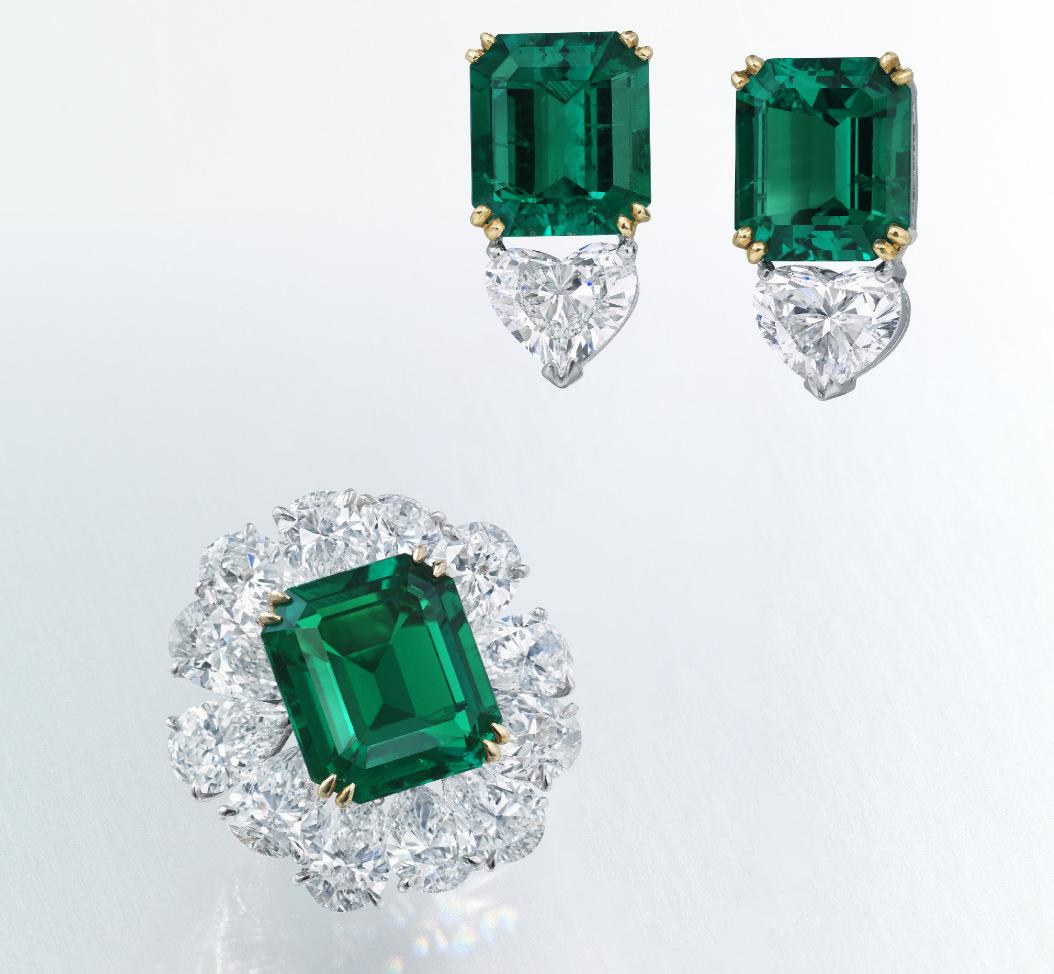
CONTACT
Ronny Hsu VP, Specialist, Head of Sale
RHsu@christies.com
+852 2978 9979


